
PROGRAMME OFFICIEL OFFICIAL PROGRAM 15 €


Organisé par l’Automobile Club de Monaco
Sous le Haut Patronage de Leurs Altesses Sérénissimes
Le Prince et La Princesse de Monaco
Avec le concours du Gouvernement Princier, de la Municipalité et de la Société des Bains de Mer
Organised by Automobile Club de Monaco
Under the High Patronage of Their Serene Highnesses
The Prince and The Princess of Monaco
With the support of the Prince’s Government, of the Municipality and of the Société des Bains de Mer
Ce programme officiel est offert gracieusement par l’Automobile Club de Monaco / This official program is offered by Automobile Club de Monaco
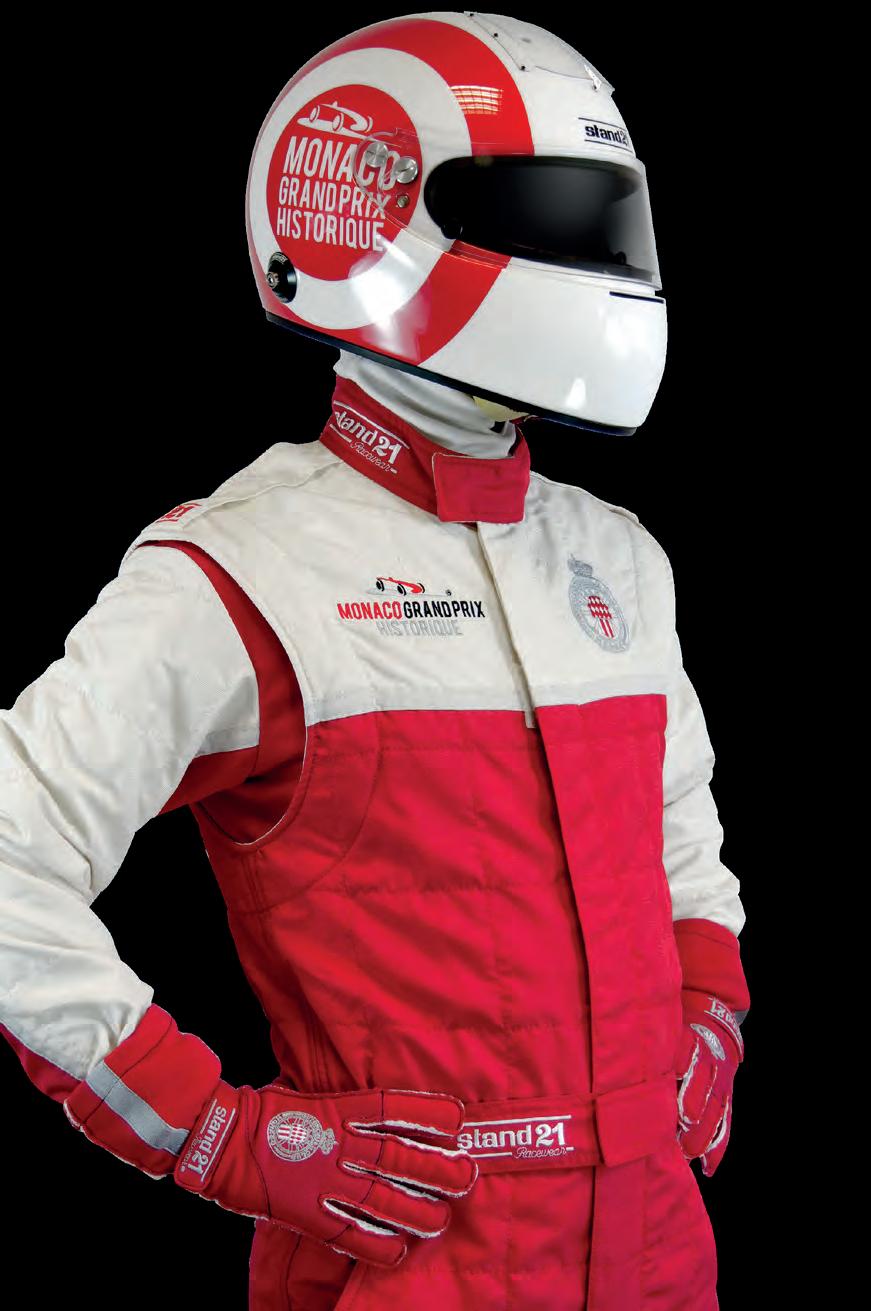

OFFICIAL COLLECTION
Découvrez la collection officielle et exclusive du Grand Prix Historique de Monaco par Stand 21. Un équipement à la pointe de la technologie garantissant un maximum de sécurité et un confort de conduite optimal, tout en arborant les couleurs de l’évènement.
Discover the official and exclusive collection of the Grand Prix Historique de Monaco by Stand 21. State-of-theart equipment guaranteeing maximum safety and optimal driving comfort, while sporting the colors of the event.
Your Name ÉGALEMENT DISPONIBLE EN BLEU/ROUGE ALSO AVAILABLE IN BLUE/RED
DE L’ÉQUIPEMENT SUR MESURE DE LA TÊTE AUX PIEDS DU PILOTE DE COURSE RETROUVEZ STAND 21 RACEWEAR SUR Stand 21 Headquarters - 12, rue des Novalles - 21240 TALANT Té.l : +33 (0) 380 539 221 - Fax : +33 (0) 380 539 230 - - info@stand21.com ÉDITION LIMITÉE - LIMITED EDITION Mathieu MESANGE Phone : +33 (0) 776 024 037 email : vintage@stand21.fr CONTACT :
LEADER MONDIAL

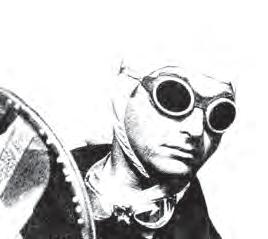
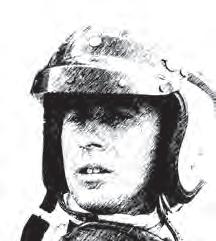
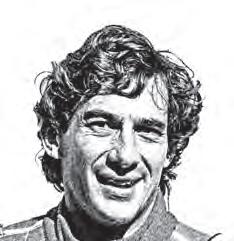
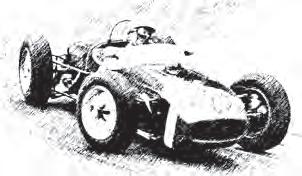
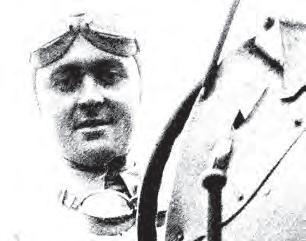
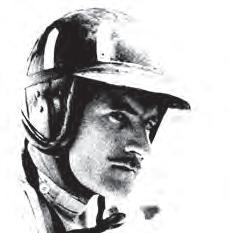
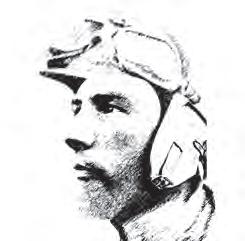
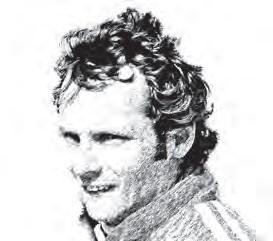

Edition : ACM Communication & Médias
Publicité : ACM Sport & Marketing
Photos : Archives Automobile Club de Monaco, M. Alesi, J-M. Folleté, O. Caenen
Visuel de couverture : Cinquantenaire du Grand Prix de Monaco (1929-1979)
D'après l'affiche originale de 1979 créée par Alain Giampaoli - Monaco
Version anglaise : Daniel Ortelli
Création graphique et mise en page : Federall, Monaco
INDEX COMITÉS
7 SÉRIE C 72 SÉRIE D 88 SÉRIE E 100 SÉRIE F 112 SÉRIE G 126 PALMARÈS / HONOURS 140 PROGRAMME / TIMETABLE 10 senna 1994 12 les MARQUES / brands 16 SÉRIE A1 38 SÉRIE A2 46 SÉRIE B 58
SOMMAIRE
/ COMMITTEE
3 14e GRAND PRIX DE MONACO HISTORIQUE 10-12 MAI 2024
EDITORIAL
100 ANS DE VOYAGE
DANS LE TEMPS AUTOMOBILE...
À la suite du franc succès rencontré lors de la précédente édition, le Comité d’Organisation et de Sélection de l’Automobile Club de Monaco (ACM) a décidé de conserver, sans aucune modification, les 8 séries et classes respectives en vigueur pour 2024. Avec en point d’orgue des hommages et anniversaires attendus lors de véritables courses dans le cadre authentique et majestueux du circuit de la Principauté. Ainsi, plusieurs pages de l’Histoire de la course automobile devraient être tournées durant cette 14e édition du Grand Prix de Monaco Historique. Flash-back idyllique, par décennies depuis 1924, sur les voitures et pilotes à l’honneur en 2024 !
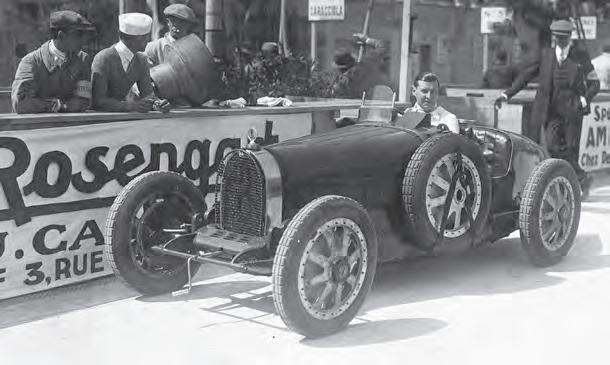
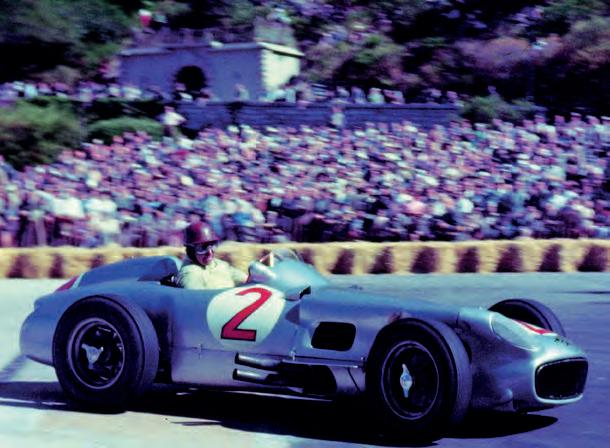
C’est à Lyon que remontent les premiers souvenirs avec, il y a 100 ans (1924), la révélation de l’iconique Bugatti 35, victorieuse en version à compresseur des deux premiers Grand Prix de Monaco en 1929 et 1930. L’Automobile Club de Monaco avait d’ailleurs organisé en 1984 une course de Bugatti afin de célébrer le 60e anniversaire de la 35.
En 1934, apparaissent les monoplaces Mercedes victorieuses des trois derniers Grand Prix de Monaco d’avant-guerre, en 1935, 1936 et 1937. Dévoilée également il y a 90 ans, sur les circuits, la marque ERA (victorieuse en 1936 de la première Coupe du Prince Rainier, en monopolisant le podium. ERA était encore sur la grille de départ en 1950 pour le 1er Grand Prix de Monaco comptant pour le tout nouveau Championnat du Monde de Formule 1.
Plus tard en 1954, soit il y a 70 ans, Mercedes était encore en haut de l’affiche, avec l’apparition de la W196 qui écrasa la scène des Grand Prix en 1954 et 1955, Juan-Manuel Fangio décrochant des titres de Champion du Monde ces deux mêmes années. Toujours en 1954, l’apparition de la Maserati 250F ne laisse personne indifférent. Les voitures italiennes sont présentes à Monaco de 1955 à 1959, remportant deux victoires en Principauté : en 1956 grâce à Juan-Manuel Fangio, encore lui, et en 1957 avec Stirling Moss au volant.
Remontons en 1964 (60 ans), lorsque John Surtees, déjà multiple Champion du Monde de Moto, le devient également en Formule 1 avec Ferrari. L’Anglais a été présent sans interruption au départ du Grand Prix de Monaco de 1960 à 71, soit 12 participations. Plus tard, Surtees deviendra une marque et un constructeur à part entière dans la discipline, ses monoplaces participant au Grand Prix de Monaco entre 1971 et 1978. Certaines sont d’ailleurs présentes cette année parmi les engagés.
Par la suite, en 1974, l’éphémère marque Hesketh s’engage dans la discipline-reine. C’est alors il y 50 ans que le jeune Lord Thomas Alexander Fermor-Hesketh et son pilote James Hunt apportent à la F1 une image glamour en phase avec celle de la Principauté. C’était aussi l’année de la révélation de l’ingénieur Harvey Postlethwaite qui a non seulement conçu la première Hesketh, mais aussi la Wolf WR1 qui a remporté trois Grands Prix lors de sa toute première saison en 1977. Dont le Grand Prix de Monaco avec au volant l’expérimenté Jody Scheckter.
C’est finalement il y a 40 ans, (1984), que le talent déjà avéré d’Ayrton Senna, avec sa modeste Toleman Hart, éclate au grand jour lors de sa 2e position, derrière Alain Prost, lors du 5e Grand Prix de sa carrière, disputé sous des trombes d’eau à Monaco…
Célébrations et passion, voici un 14e Grand Prix Historique qui s’annonce prometteur tant pour les concurrents que les spectateurs. Cap sur un week-end de voitures de collections, d’histoire, et d’accélérations…

1924 1934 1954 1964
1974 1984
Grand Prix de Monaco 1929 : G. Bouriano - Bugatti 35C
4
Grand Prix de Monaco 1955 : J-M. Fangio - Mercedes Benz W196
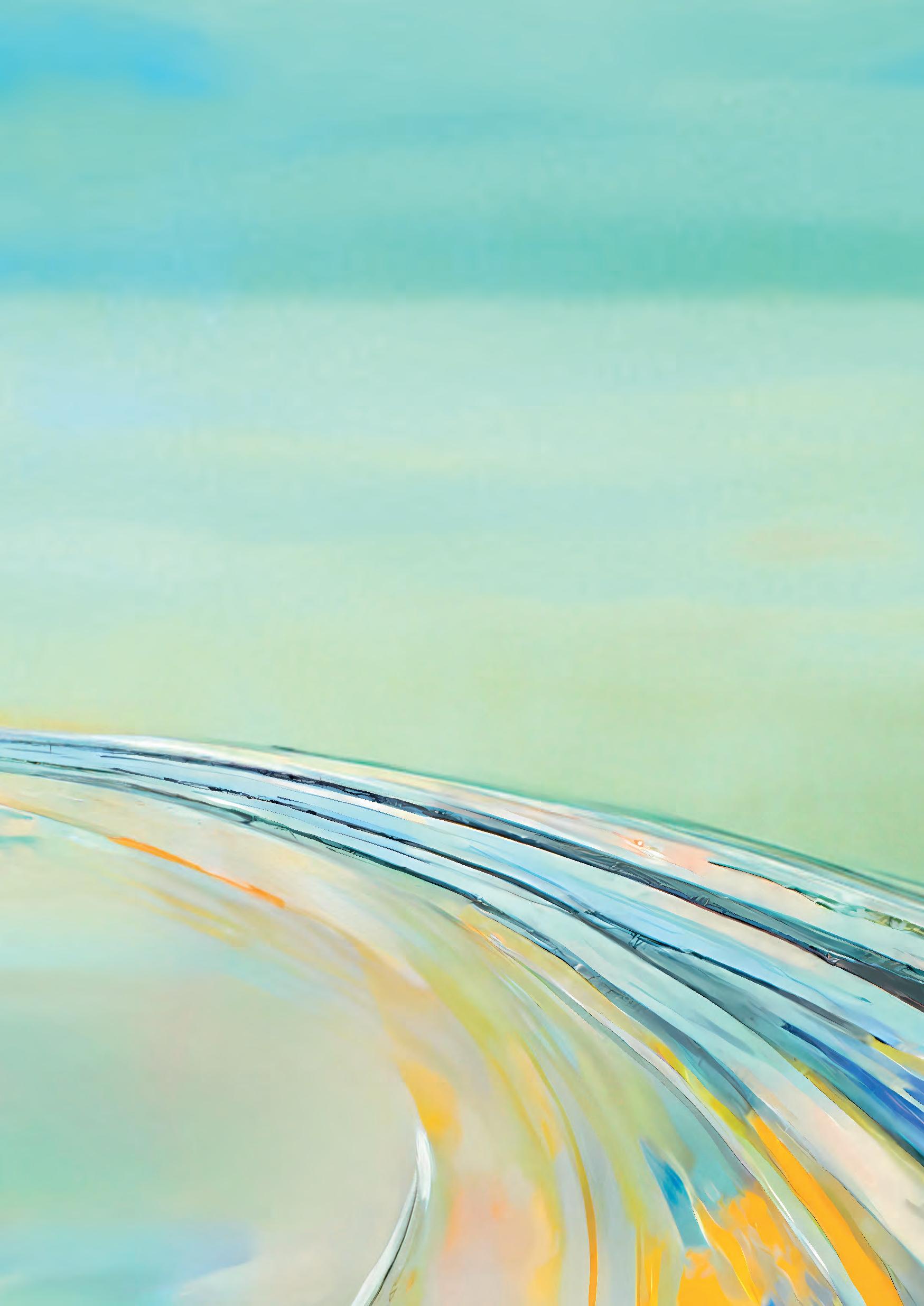
BACK TO A HUNDRED YEARS OF RACING!
Following the resounding success of the previous edition, the Organizing and Selection Committee of the Automobile Club de Monaco (ACM) has decided to retain the same 8 series and classes unchanged for 2024. The event will culminate in tributes and anniversaries in the form of real races in the authentic and majestic setting of the Principality's circuit. This 14th edition of the Grand Prix de Monaco Historique is set to turn several pages in motor racing history. Idyllic flashback, by decade since 1924, on cars and drivers who will be in the spotlight in 2024!
It is in Lyon that the first memories go back to, 100 years ago (1924), with the unveiling of the iconic Bugatti 35, the compressor version of which won the first two Monaco Grand Prix in 1929 and 1930. Besides, in 1984, the Automobile Club de Monaco organized a Bugatti race to celebrate the 35's 60th anniversary.
In 1934, the Mercedes single-seaters that had won the last three pre-war Monaco Grand Prix, in 1935, 1936 and 1937, appeared on the grid. Also appearing on the racetrack 90 years ago was ERA, which won the first Prince Rainier Cup in 1936, monopolizing the podium. ERA was again on the starting grid in 1950 for the 1st Monaco Grand Prix, part of the brand-new Formula 1 World Championship.
Later in 1954, that is to say 70 years ago, Mercedes was still at the top of the bill, with the appearance of the W196, which crushed the Grand Prix scene in 1954 and 1955, Juan-Manuel Fangio winning World Championship titles in the same two years. The unveiling of the Maserati 250F also left no one indifferent. Italian cars were present in Monaco from 1955 to 1959, winning twice: in 1956 thanks to Juan-Manuel Fangio, and in 1957 with Stirling Moss at the wheel.
Let's go back to 1964 (60 years ago), when John Surtees, already a multiple Moto World Champion, also became one in Formula 1 with Ferrari. The Englishman was always present at the start of Monaco Grand Prix from 1960 to 1971, making 12 appearances. Later, Surtees became a fullfledged brand and manufacturer in the discipline, his single-seaters taking part in Monaco Grand Prix between 1971 and 1978. Some of them are among the entries this year!
Then, in 1974, the short-lived Hesketh brand got involved in the major discipline. It was then 50 years ago that the young and flamboyant Lord Thomas Alexander Fermor-Hesketh along with his driver James Hunt, gave F1 a glamorous image in keeping with that of the Principality. It was also the year of the revelation of engineer Harvey Postlethwaite, who not only designed the first Hesketh, but also the Wolf WR1, which won three Grands Prix in its very first season in 1977. Including the Monaco Grand Prix with the experienced Jody Scheckter at the wheel.
It was finally 40 years ago, in 1984, that Ayrton Senna's already proven talent, in his modest Toleman Hart, shone through when he took 2nd place, behind Alain Prost, at the 5th Grand Prix of his career, contested in torrential rain in Monaco...
The 14th Historic Grand Prix promises to be a weekend of celebration and passion for competitors and spectators alike. We look forward to a weekend of classic cars, history, and acceleration.

5 14e GRAND PRIX DE MONACO HISTORIQUE 10-12 MAI 2024
Grand Prix de Monaco 1984 : Ayrton Senna - Toleman-Hart
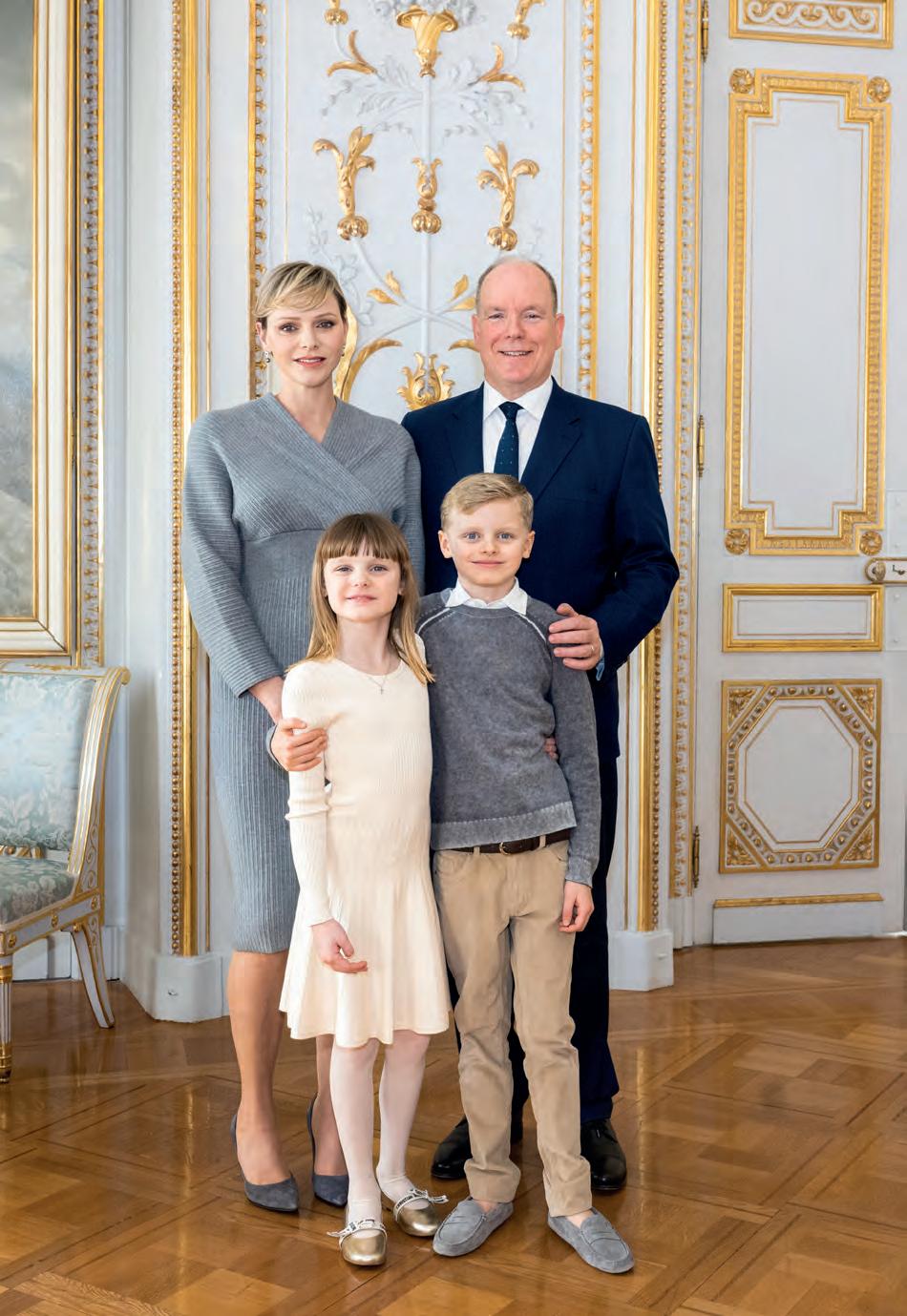 LL.AA.SS. le Prince Albert II, la Princesse Charlène, le Prince Héréditaire Jacques et la Princesse Gabriella
© Eric Mathon
/ Palais
Princier
LL.AA.SS. le Prince Albert II, la Princesse Charlène, le Prince Héréditaire Jacques et la Princesse Gabriella
© Eric Mathon
/ Palais
Princier
Sous le Haut Patronage de Leurs Altesses Sérenissimes
Le Prince et La Princesse de Monaco
Comité d’honneur / Honorary Committee
S.E.M. Pierre DARTOUT
Ministre d’Etat de la Principauté de Monaco
Minister of State of Principality of Monaco
Me Thomas BREZZO
Président du Conseil National / Chairman of the National Council
Me Michel BOERI
Président du Conseil de la Couronne de la Principauté de Monaco / Chairman of the Crown Council
S.E.M me Yvette LAMBIN-BERTI
Secrétaire d’Etat de la Principauté de Monaco
Secretary of State of Principality of Monaco
M. Patrice CELLARIO
Conseiller de Gouvernement - Ministre de l’Intérieur
Government Councilor, Minister for the Home Office
M. Pierre-André CHIAPPORI
Conseiller de Gouvernement - Ministre des Finances et de l’Economie / Government Councilor, Minister for Finance and Economy
M. Christophe ROBINO
Conseiller de Gouvernement - Ministre des Affaires Sociales et de la Santé / Government Councilor, Minister for Social Affairs and Health
M me Céline CARON-DAGIONI
Conseiller de Gouvernement - Ministre de l’Equipement, de l’Environnement et de l’Urbanisme / Government Councilor,
Minister for Equipment, Environment and Urban Development
S.E.M me Isabelle BERRO-AMADEÏ
Conseiller de Gouvernement - Ministre des Relations Extérieures et de la Coopération / Government Councilor, Minister for Foreign Affairs and Cooperation
M. Georges MARSAN
Maire de Monaco / Mayor of Monaco
Colonel Tony VARO
Commandant Supérieur de la Force Publique
Highest Command Officer of the Public Force
M. Stéphane VALERI
P résident Délégué de la Société des Bains de Mer
Chairman Delegate of the Société des Bains de Mer
Automobile Club de Monaco
Président / Chairman : Me Michel BOERI
Assistante / Assistant : M lle Marie BONIFAZIO
Cabinet de la Présidence
Conseillers spéciaux : MM. Emmanuel FALCO et Michel ADREANI
Conseiller Technique / Technical : M Jean-Paul CERESOLA
Vice-Présidents / Vice-Chairman : MM. M ichel FERRY, Bernard RICHELMI et Dr. Robert SCARLOT
Secrétaire Général / General Secretary : Me A lexis MARQUET
Secrétaire Général Honoraire / Honorary General Secretary : M. A ndré FROLLA
Secrétaire Général Adjoint / Deputy General Secretary : M. Jean-Marie CONTERNO
COMITES COMMITTEES

Trésorier Général / General Treasurer : M Roland MELAN
Trésorier Général Adjoint / Deputy General Treasurer : M. A lain FICINI
Relations Publiques et Protocole / Public Relations and protocol : M. Ruchdi HAJJAR
assisté de / Assisted by : M me Nadège RABOISSON et M. Sharif KILANY
Commissaire Général / General Commissioner M. Eric BARRABINO
Commissaires Généraux Adjoints / Deputy General Commissioner :
MM. Christophe ALLGEYER, Jean-Michel MATAS et Romain PUGLIESE
Assistants / Assistants : MM. Jérémy JOFFRE, Romain HAUT-LABOURDETTE
Secrétaires et assistants du responsable des Commissaires / Secretary and head marshall assistant : M me Joanna LUONG et M. Antonio RIVELLO
Comité d’organisation / Organisation Committee
Président / Chairman : Me Michel BOERI
Vice-Président pour le Sport / Deputy President for Sport : M. Michel FERRY
Tribunal d’Appel National / National Appeal Court
Président / President : M. Daniel SERDET
Membres Titulaires : Me Thomas BREZZO et Me A lain FRANCOIS
Commission Sportive / Sportive Commission
Président / President : M. Jean-François CALMES
Commandement du Corps des Commissaires / Board of Marshals Command :
Président / President : M. Jean-Michel MATAS
assisté de / assisted by : MM. Frédéric COTTALORDA, Christophe FABBRI et Guillaume MOREL
Commission des Voitures de Collection / Historic Cars Commission
Président / President : M. Gery MESTRE
chargées de l'accueil des concurrents / competitors welcome:
M mes Patricia MERLINO BEASLEY et Mélissa MATHIEU
Commission Technique / Technical Commission :
Président / President : M. Renato MOSCATI
Commission Femmes dans le Sport Automobile / Women in Motorsport Commission
Présidente / President : Mme Tiffaney PERLINO
Commission du Protocole / Protocol Commission
Président / President : M. Ferxel FOURGON
Accueil des invités / Welcome of Guests : M me Nadège RABOISSON, M. Sharif KILANY
Commission Médicale / Medical Commission
Président / Chairman : Dr. Benoit PAULMIER
Vice-Présidente / Deputy Chairman : Dr. Brigitte PASQUIER
Secrétaire / Secretary : M me Ana Rita MAIA RIBEIRO, Membres / Members: Dr. Olivier TERNO, Dr. Marc Alexis MACCHI
Commission Média / Media Commission
Président / President : M. Michel DOTTA
Commission des Energies Nouvelles et Electriques / Electric & New Energies Commission
Président / President : Dr. Jacques ROSSI
Commission de Discipline et d’Ethique / Diciplinary and Ethics Commission
Président / President : M. Guy DEALEXANDRIS
7 14e GRAND PRIX DE MONACO HISTORIQUE 10-12 MAI 2024
COMITES COMMITTEES

Commission Karting / Karting Commission
Président / President : M. Charles FLAUJAC
Responsable Sécurité et service du Contrôle Général / Safety Delegate and Supervision of the Circuit Security
M. Jean-Luc VIEILLEVILLE
Adjoint/ Deputy : M. Eric PANNIER
Assistants du responsable sécurité / Deputy safety delegates : MM. Patrice AYRAULT, Stéphane LEVAMIS et Philippe MONNIER
Assistantes du Contrôle Général / General Control Assistants :
M mes Murielle LAMONGIE et Caroline GUILLET, M. Nicolas CANNESTRELLI
Responsable du Service Incendie / Head of the Fire Department :
Lieutenant-Colonel Maxime YVRARD, Chef de Corps des SapeursPompiers de Monaco / Commanding officer of the Compagnie des SapeursPompiers de Monaco
Responsables des véhicules de l’organisation / Responsible for organisation vehicles : M. Christophe ALLGEYER
assisté de / assisted by M. Georges CURRENO
L'ensemble des automobiles utilisées par les organisateurs a été fourni par Toyota / All the cars used by the Organisers were supplied by Toyota
Radio Communications
Dr. Robert SCARLOT
assisté de / assisted by M. Grégory CHOSSON
Informatique / Data processing : M. Frédéric GUILLET
Réseaux sociaux et Internet / Internet and social networks :
M. Corentin DEBORT
assisté de / assisted by M mes Cassandra OLMETA et Anaïs OLVERA
Service Inter-Membres : M me Amaury ALLENT
Secrétariat administratif et technique / Administrative and technical secretary : M mes Graciela CALMELL DEL SOLAR, Caline DEALEXANDRIS, Marielle KRAEMER,Minka MARTINO, MM. Monji BOUDABOUS, Mohamed BOUKROUNE et Wisam MOMIKA
Travaux et Structures extérieures / External work and outdoor structures :
Responsable / Responsible : M. Ronan LE GALLOU
assisté de / assisted by : MM. Dany AUFORT
Equipe / Team: Samy ABASSI, Franck BRUGIERE, François BRYSELBOUT, Alessandro CALDERONE, Christiano MARQUES DA SILVA, Sergio MURDACA et Alex WILM
Coordinateur Garage 1 / Garage 1 coordinator: Florian FORASTIERO
Service comptabilité / Accounting department
Responsable : M. Philippe FERRUIT
assisté de / assisted by : Mmes Laure GURY et Margareth ARTHUR VARAS, MM. Joseph MELILLI et Morgan BANAUDO
Billetterie / Ticketing office : M mes Noëlle CHAVAGNAS et Alessandra BRUNNO
Responsable Environnement / Environment Delegate : M me Caline DEALEXANDRIS
ACM Sport et Marketing :
Responsable / Responsible : M. Kévin CHEVAL
M mes Alexandra BOGGETTI, Claudia CARBONI, Stéphanie DE FELICE, Manon MALLO, Manon POYARD, MM. Morgan ESCARRAS, Jean-Julien MICHEO et Thierry VINCENT
ID MONACO : M. Graham BOGLE
Assisté de / Assisted by : Karolin JACOBSON, Vanessa TURCO et Julia BOGLE
Restaurant Le Club : MM. Jean-Luc DUFAYEL et Olivier RIBAUTE
assistés de / Assisted by : MM. Abdelaziz BAIDI, Frédéric CHAUVET, Xavier CONGES, Sacha DARMON, Thomas DESERT, Alain GENTILLEAU, Amaury JOFROIT, Laurent MAILLARD, Romain ROESSEL, Roger ROSSIGNOL
Commentateurs / Speakers
MM. Vincent FRANSSEN (F), Ian TITCHMARCH (GB), Daniele GALBIATI (I)
Officiels / Officials
Directeur de l’Epreuve / Race Director : M. A lain PALLANCA
Secrétaire de l’Epreuve / Secretary of the Event : M. Romain PUGLIESE
Directeur de Courses / Clerk of the Course : M. Marc DUEZ
Directeurs de Courses Adjoints / Deputy Clerks of the Course : MM. François ARDISSON, Olivier BERETTA, Johnny CECOTTO, Christophe FABBRI, Jérémy JOFFRE, Jacques ROSSI, Frédéric SALTI et Cyril VADA
Commissaires sportifs / Stewards
Commission 1 (séries E, B, G)
Président / Chairman : M. Jean-François CALMES (MC)
Membres / Members : MM. Chris GEOFFROY (F), Didier MIGEON (MC), Claude PLASSERAUD (MC)
Commission 2 (séries A2, C)
Président / Chairman : M. Hervé ORSINI (MC)
Membres / Members : Mme Sophie BENSA (MC), M. François DUMONT (B)
Commission 3 (séries A1, D, F)
Président / Chairman : M. A lain VIVALDA (MC)
Membres / Members : MM. Marco CALEGARI (MC), Paolo LONGONI (I)
Commission Médicale / Medical Commission
Président / Chairman : Dr. Benoit PAULMIER
Commission Technique / Technical Commission :
Président / President : M. Renato MOSCATI (MC)
Conseillers Techniques Extérieurs / Foreign Scrutineers : MM. Guiseppe MARTORANA (I), Henry PLUTON (F) et Fabio TITTARELLI (I)
Délégué Technique en charge des relations avec la FIA / Technical Delegate in charge of relations with FIA : M. Raoul TANGANELLI
Chargés des relations avec les concurrents / Competitor's relations officer: M. Alexandre PASTA
Stagiaires / Trainees: MM. Olivier CAVE, Gilles CONVERTINI, Frédéric MICHELIS
Chronométrage et classements / Timekeeping and classification : M. Jean-Louis ORSINI, Fédération Monégasque des Chronométreurs avec la collaboration de la société VOLA
Responsable Communication et Médias / Communications & Media Manager : M. Richard MICOUD
Assisté de / Assisted by : Mlle Zoe LAJOUX et M. Majdi HAJJAR
Chefs de postes
M M. Patrice ALBERGUCCI, Philippe BARNIER, Christophe BERNABO, Julien BERNARD, Yannick BONEL, Laurent BONSIGNORI, Claude BONTEMPS, Olivier BOUCHARD, Christophe BOUNIOL, Jérôme BROEKS, François BUCCIERI, Lillian CAILLIOT, Frédéric CAMATTI, Gilles CANEPA, Laurent CANTONE, Fortunato CARBONE, Stéphane CARRIERE, Nicolas CESARINI, Loïc CHASTAN, Frédéric COTTALORDA, Christian DELLAPIAZZA, Sylvain FRIER, Cyrille GIUGLARIS, Edoardo LAINI, Cyril LANDUCCI, Nunzio LENA, Eric LOZZANO, Eddy MARANGONI, Stéphane MARCHETTI, Thierry MARION, Enric MARTIN, Rémi MATTON, Thomas MEUNIER, Stéphane MORABITO, Guillaume MOREL, Guillaume MOTILLON, Thomas PELLETAN, Pascal PUJOL, Benjamin RAFFAELE, Georges SZULC, Stéphane TRUCHI, Patrick VICHERAT, Franck VILLANOVA
Juges de faits / Judge of facts :
MM. William GUEGUEN, Antoine MALLO, Serge POCHET, William POVERO et Patrick FREMOND
Responsable du Paddock / Paddock Delegate : M. Jérémy JOFFRE
Responsables Pitlane / Pitlane Delegates : MM. Jean-Marc HAIBLE, Antoine DICOLANGELO, Raymond GNUTTI, Giancarlo RAFFERMI et Michel SANDRI
Responsables et mise en place des séries / Delegates and implementation of the series : MM. Eric BONO, Jesse BOUDRET, Jean-Luc POMPA, Christophe PONSET, Nicolas PONSET
N° de Visa attribué par l’Autorité Sportive Nationale / Visa No. issued by the National Sports Authority : A.C.M. 24.05
8


5 SUPERCAR SHOW CLASSIC CARS • HYPERCARS • INNOVATION UNDER THE HIGH PATRONAGE OF HIS SERENE HIGHNESS PRINCE ALBERT II OF MONACO DAYDREAM TARGA BY TEDSON MOTORS www.topmarquesmonaco.com #topmarquesmonaco 5 - 9 JUNE 2024 GRIMALDI FORUM | MONACO 8 JUNE : 100% FERRARI AUCTION
SERIES RACES
A1
A2
B C
D E F
G
Voitures de Grand Prix d’avant-guerre et Voiturettes / Pre-war Grand Prix cars and Voiturettes
Voitures de Grand Prix à moteur avant construites avant 1961 / Front-engine Grand Prix cars built before 1961
Voitures de Grand Prix à moteur arrière, 1500, F1 (1961-1965) et F2 (1956-1960) / Rear-engine, 1500, F1 Grand Prix cars (1961-1965) and F2 (1956-1960)
Voitures de Sport à moteur avant (1952-1957) / Sport Racing cars - front engine (1952-1957)
Voitures de Grand Prix F1 3L (1966-1972) / F1 Grand Prix cars 3L (1966-1972)
Voitures de Grand Prix F1 3L (1973-1976) / F1 Grand Prix cars 3L (1973-1976)
Voitures de Grand Prix F1 3L (1977-1980) / F1 Grand Prix cars 3L (1977-1980)
Voitures de Grand Prix F1 3L (1981-1985) / F1 Grand Prix cars 3L (1981-1985)
PROGRAMME TIMETABLE
Vendredi / Friday 10/05
09:30 - Fermeture du Circuit à la circulation urbaine / Closing of the track to road traffic
ESSAIS LIBRES / FREE PRACTICES (30mn par série / by race)
11:00 - 11:30 Série / Race A2
11:50 - 12:20 Série / Race A1
12:40 - 13:10 Série / Race B
14:30 - 15:00 Série / Race D
15:20 - 15:50 Série / Race E
16:10 - 16:40 Série / Race C
17:00 - 17:30 Série / Race F
17:50 - 18:20 Série / Race G
20:00 - Ouverture du circuit à la circulation urbaine / Opening of the track to road traffic
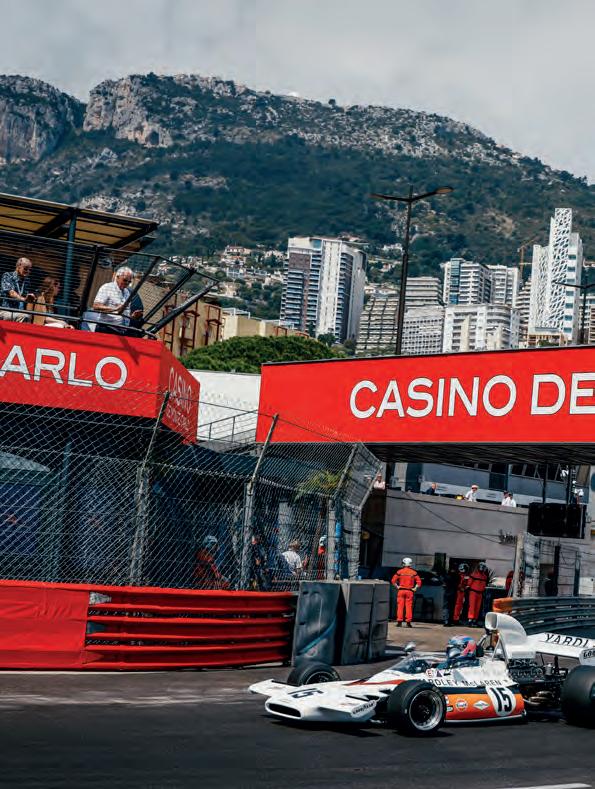
Samedi / Saturday 11/05
06:15 - Fermeture du Circuit à la circulation urbaine / Closing of the track to road traffic
ESSAIS QUALIFICATIFS / QUALIFYING SESSIONS (25mn par série / by race)
08:15 - 08:40 Série / Race A2
09:05 - 09:30 Série / Race A1
09:55 - 10:20 Série / Race B
10:45 - 11:10 Série / Race D
11:35 - 12:00 Série / Race E
12:25 - 12:40 Parade “UBS Classic Car Rally” (3 tours/ laps)
12:50 - 13:20 “Senna 30 Years Celebration Parade” (4 tours/ laps)
14:30 - 14:55 Série / Race C
15:20 - 15:45 Série / Race F
16:10 - 16:35 Série / Race G
18:00 - Ouverture du circuit à la circulation urbaine / Opening of the track to road traffic

10

Dimanche / Sunday 12/05
06:00 - Fermeture du Circuit à la circulation urbaine / Closing of the track to road traffic
COURSES / RACES
08:00 - 08:30 Série / Race A2
10 tours/laps ou/or 30 minutes
09:05 - 09:35 Série / Race A1
10 tours/laps ou/or 30 minutes
10:10 - 10:40 Série / Race B
10 tours/laps ou/or 30 minutes
11:15 - 11:50 Série / Race D
12 tours/laps ou/or 35 minutes
12:25 - 13:10 Série / Race E
18 tours/laps ou/or 45 minutes
14:30 - 15:00 Série / Race C
10 tours/laps ou/or 30 minutes
15:35 - 16:20 Série / Race F
18 tours/laps ou/oru 45 minutes
16:55 - 17:40 Série / Race G
18 tours/laps ou/or 45 minutes
19:30 - Ouverture du circuit à la circulation urbaine / Opening of the track to road traffic
20:30 - Dîner de Gala et Remise des Prix / Prize giving Gala Dinner (Salle des Etoiles, Sporting Monte-Carlo)
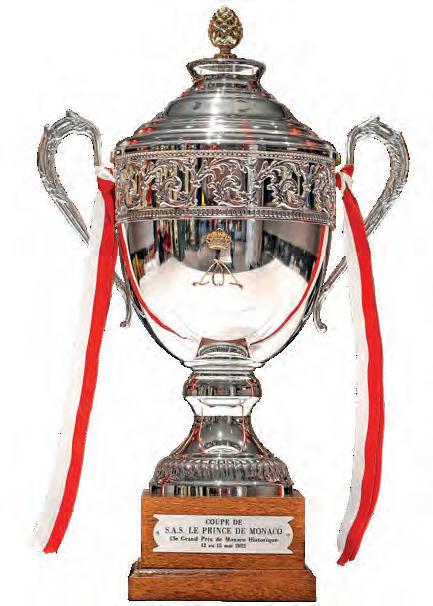
Le vainqueur de chaque série recevra la Coupe de S.A.S. Le Prince de Monaco & le “MGPH Legend Trophy”
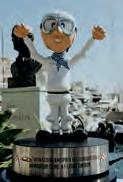

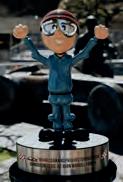
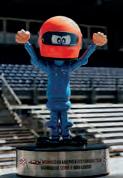


Le deuxième de chaque série recevra la Coupe du Président de l’Automobile Club de Monaco
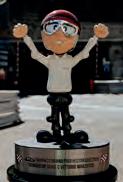


Le troisième de chaque série recevra la Coupe de l’Automobile Club de Monaco
Le premier de chaque classe recevra la Coupe de l’Automobile Club de Monaco
11 14e GRAND PRIX DE MONACO HISTORIQUE 10-12 MAI 2024
COUPES TROPHIES A1 A2 B C D E F G

ANS YEARS SENNA 30
UNE PARADE EXCEPTIONNELLE !
AN EXCEPTIONAL PARADE!
Les nostalgiques de « la F1 d’avant » et tous les fans d’Ayrton Senna présents à Monaco en mai, quel que soit leur âge, vont assister samedi 11 mai, entre 12h50 et 13h20, à une parade exceptionnelle en l’honneur du grand champion brésilien, tragiquement disparu le 1er mai 1994 sur le circuit d’Imola. Car l’Automobile Club de Monaco (ACM), en liaison étroite avec l’Instituto Ayrton Senna, Lotus Héritage et la McLaren Academy, a réuni un plateau de rêve rappelant les grandes étapes du parcours de Senna vers les sommets du sport automobile…
Those nostalgic for the "F1 of yesteryear" and all Ayrton Senna fans present in Monaco in May, whatever their age, will be able to attend an exceptional parade on Saturday 11 May, between 12.50 and 1.20, in the honour of the great Brazilian champion who tragically died on May 1, 1994, on the Imola track. Automobile Club de Monaco (ACM), in close collaboration with Instituto Ayrton Senna, Lotus Heritage and the McLaren Academy, has put together a dream line-up recalling the major stages in Senna's journey to the pinnacle of motor sport...
C’est au volant de ce kart que le jeune Ayrton Senna, 17 ans, est devenu en 1977 Champion d’Amérique du Sud, lors d’une course organisée en Uruguay, dans la ville de San José. Il ne pouvait pas porter le numéro 42, son numéro-fétiche de l’époque, en raison du règlement de l’épreuve, et il a donc arboré le chiffre 7 sur son kart. C’est au volant de ce kart que le jeune Senna a aussi terminé 2e du Championnat du Brésil, sur le circuit d’Interlagos, et brillé dans plusieurs autres courses. L’année suivante, Ayrton Senna da Silva a débarqué en Europe et a effectué un essai très concluant avec la firme italienne DAP, dirigée par les frères Parilla. C’était le début de la saga Senna en Europe…
It was at the wheel of this go-kart that 17-year-old Ayrton Senna became South American Champion in 1977, during a race organised in Uruguay, in the town of San José. He could not carry number 42, his favourite number at the time, because of the rules of the event, and so he had number 7 on his go-kart. It was at the wheel of this go-kart that the young Senna also finished 2nd of the Brazilian Championship, on the Interlagos circuit, and shone in several other races. The following year, Ayrton Senna da Silva arrived in Europe and carried out a very conclusive test with Italian firm DAP, run by the Parilla brothers. It was the beginning of the Senna saga in Europe...
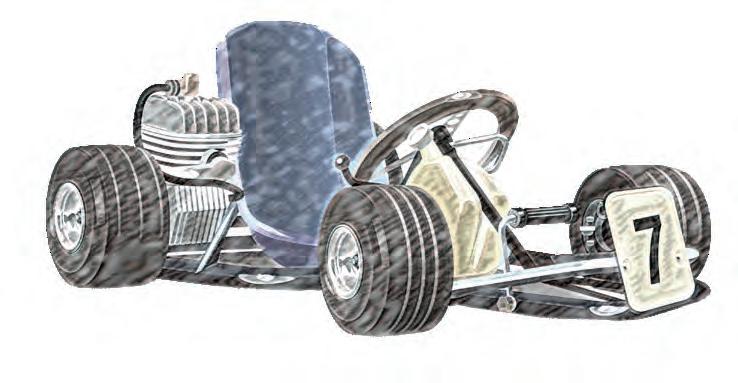
12
LE KART DE SENNA EN 1977 SENNA'S GO-KART IN 1977
Sources: "Eternel Senna" by Daniel Ortelli & Thomas Woloch,photos by Dominique Leroy (Editions Glénat, April 2024)
www.poleposition.ca www.senna.com
FORMULE FORD 2000 : LA VAN DIEMEN RF82 DE SENNA EN 1982
Après une saison 1981 très marquante (12 victoires en 20 courses de Formule Ford 1600, et donc le titre de champion de GrandeBretagne, haut la main), Ayrton Senna continue son apprentissage et découvre la Van Diemen RF82 équipée d’un moteur 2 litres, plus puissante que sa monoplace de l’année précédente. Sur un tour de circuit, il gagne en moyenne quatre secondes par rapport à 1981, dans une voiture plus difficile à piloter car bénéficiant aussi d’un supplément d’adhérence. Alors qu’il avait brièvement envisagé de rentrer au Brésil fin 1981, pour s’occuper de l’entreprise familiale, Senna, 22 ans, va une fois de plus dominer la concurrence et rafler une quantité record de victoires : 22 dans toute l’Europe, qui découvre son talent immense, mais aussi 18 pole positions, 22 meilleurs tours et 516 points marqués en 28 courses. Tout commence par six grand chelems d’affilée (pole position, victoire en menant de bout en bout, meilleur tour en course), dont deux consécutives en deux jours, à Oulton Park et Silverstone. Le titre de Champion d’Europe est assure dès la course de Jyllandsring, au Danemark, le 22 août.
After a very memorable 1981 season (12 wins in 20 Formula Ford 1600 races and the British championship title, hands down), Ayrton Senna continued his apprenticeship and discovered the Van Diemen RF82 equipped with a 2-litre engine, more powerful than his single-seater of the previous year. Over one lap of any track, he gained an average of four seconds on 1981, in a car that was more difficult to drive because it also had more grip. Although he had briefly considered returning to Brazil at the end of 1981 to run the family business, 22-year-old Senna once again dominated the competition and racked up a record number of wins: 22 throughout Europe, as well as 18 pole positions, 22 fastest laps and 516 points scored in 28 races. It all began with six Grand Slams in a row (pole position, victory by leading from start to finish, best lap in race), including two in a row in two days, at Oulton Park and Silverstone. The European Championship title was secured at the Jyllandsring race in Denmark on 22 August.
Cette Van Diemen de 1982, comme le kart de Senna en 1977, sera pilotée à Monaco par un jeune pilote de la McLaren Academy.
This 1982 Van Diemen, like Senna's 1977 go-kart, will be driven in Monaco by a young McLaren Academy driver.
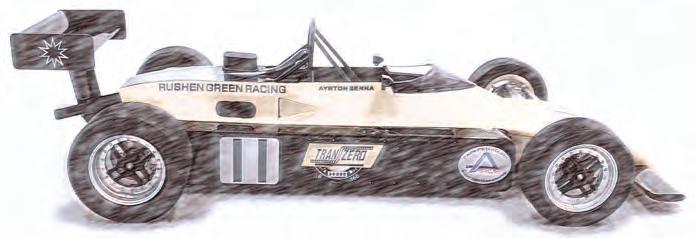
Comme les deux saisons précédentes, en Formule Ford 1600 et 2000, la saison 1983, en Formule 3, est dominée par un Ayrton Senna insatiable, malgré la redoutable concurrence d’un jeune Anglais, Martin Brundle. Le Brésilien se rapproche encore de la F1 en terminant Champion de Grande-Bretagne grâce à 12 victoires, mais Brundle lui a donné beaucoup de fil à retordre et plusieurs courses se sont terminées par des accidents ou des accrochages. Senna vient de s’assurer le titre quand il prend l’avion pour la petite colonie portugaise de Macao et son circuit urbain où la moindre erreur se paie cash, comme dans les casinos les plus proches. Le 20 novembre 1983, Senna va remporter une victoire de prestige au volant de cette Ralt RT3 à moteur Toyota, inscrite par l’écurie West Surrey Racing. Il faudra attendre encore quelques années pour retrouver Senna dans une monoplace rouge et blanche, dès son arrivée chez McLaren…
As in the two previous seasons, in Formula Ford 1600 and 2000, the 1983 Formula 3 season was dominated by an insatiable Ayrton Senna, despite formidable competition from a young Englishman, Martin Brundle. The Brazilian finished as British Champion with 12 wins, but Brundle gave him a hard time and several races ended in accidents or collisions. Senna had just secured the title when he boarded a plane for the small Portuguese colony of Macau and its urban circuit, where the slightest mistake is paid for in cash, as in the nearest casinos. On 20 November 1983, Senna took a prestigious victory at the wheel of this Toyota-powered Ralt RT3, entered by the West Surrey Racing team. We had to wait a few more years to see Senna again in a red and white single-seater, when he joined McLaren...

Le pilote de cette Ralt de F3, au Grand Prix de Monaco Historique, sera l’Irlandais Eddie Irvine ou le Belge Thierry Boutsen, désormais résidents monégasques tous les deux, qui ont couru contre Ayrton Senna.
The driver of this Ralt F3 at Grand Prix de Monaco Historique will be Irishman Eddie Irvine or Belgian Thierry Boutsen, now both Monaco residents, who raced against Ayrton Senna.
13 14e GRAND PRIX DE MONACO HISTORIQUE 10-12 MAI 2024
FORMULE 3 : LA RALT RT3 DU GRAND
PRIX DE MACAO 1983 THE RALT RT3 AT THE 1983 MACAU GRAND PRIX

Cette Toleman sera pilotée à Monaco par le Suédois Stefan Johansson, coéquipier de Senna en 1984.
This Toleman will be driven in Monaco by Sweden’s Stefan Johansson, who was Senna's team-mate in 1984.
C’est la première monoplace de Formule 1 pilotée officiellement par Ayrton Senna en Championnat du Monde. Dessinée par Rory Byrne, elle est très lourde, sans direction assistée, et demande des efforts physiques colossaux à ses pilotes, dont le frêle Brésilien. Elle est propulsée par un moteur turbo anglais, un Hart d’environ 600 chevaux, et chaussée de pneus Michelin, comme les monoplaces alignées par Ligier, Renault, Brabham et McLaren. Des tests aérodynamiques ont été réalisés dans une soufflerie appartenant au Ministère de la défense britannique. À partir du Grand Prix de Monaco, Senna bénéficie d’un nouveau système moteur à injection électronique, contrairement à son coéquipier Johnny Cecotto. Il va décroche trois podiums dans cette voiture, dont cette fameuse 2e place à Monaco, derrière Alain Prost, sous une pluie torrentielle ayant incité Jacky Ickx à agiter le drapeau rouge à un tour de la fin. Ils restent les trois seuls podiums de l’histoire de l’écurie britannique créée par Ted Toleman, un transporteur routier décédé en avril 2024.
This was the first Formula 1 single-seater raced officially by Ayrton Senna in the World Championship. Designed by Rory Byrne, it was very heavy, had no power steering and demanded colossal physical effort from its drivers, including the frail Brazilian. It was powered by a British turbo engine, a Hart with around 600bhp, and fitted with Michelin tyres, like the single-seaters entered by Ligier, Renault, Brabham and McLaren. Aerodynamic tests were carried out in a wind tunnel belonging to the British Ministry of Defence. From the Monaco Grand Prix onwards, Senna benefited from a new electronic injection engine system, unlike his team-mate Johnny Cecotto. He took three podiums in this car, including his famous 2nd place in Monaco, behind Alain Prost, in torrential rain that prompted Jacky Ickx to wave the red flag with one lap to go. They remain the only three podium finishes in the history of the British team founded by Ted Toleman, a road haulier who died in April 2024.
Equipée d’un moteur V6 turbo Renault de 1.5 L qui développe 760 chevaux, la Lotus 97T (avec T pour turbo), est la F1 dans laquelle le futur « Magic Senna » a remporté ses deux premiers Grands Prix, à Estoril puis à Spa-Francorchamps. Dès ses premiers tours à bord, le Brésilien a compris qu’elle était bien-née, le vendredi 8 février 1985. Elle a été conçue par l’ingénieur français Gérard Ducarouge et son adjoint Martin Ogilvie, en même temps que la Lotus 96T qui avait été préparée pour le Championnat Indycar mais qui n’a jamais couru aux Etats-Unis. Grâce à ses déflecteurs latéraux, elle a de très bonnes performances aérodynamiques et bénéficie de plus d’appui, ce qui convient parfaitement à l’équilibriste Ayrton Senna. Elle est équipée, dans le cockpit, de plusieurs afficheurs à cristaux liquides, une nouveauté à l’époque. Il y a la température d’huile, la puissance du turbo, la quantité d’essence embarquée, en temps réel. C’est un régal pour Senna, très gourmand en données. En plus de ses deux premières victoires en F1, au Portugal et en Belgique, cette monoplace désormais mythique a permis au Brésilien de signer ses sept premières pole positions, toutes en 1985.
14
FORMULE 1 : LA TOLEMAN TG184 DE 1984
FORMULE 1 : LA LOTUS 97T DE 1985
In Monaco, this
Equipped with a 1.5 litre Renault V6 turbo engine developing 760 bhp, the Lotus 97T (T for turbo) was the F1 car in which the future "Magic Senna" won his first two Grand Prix races, at Estoril and SpaFrancorchamps. From his very first laps on board, the Brazilian knew that this car was well-born. It was designed by French engineer Gérard Ducarouge and his assistant Martin Ogilvie, at the same time as the Lotus 96T, which had been prepared for the Indycar Championship but never raced in the USA. Thanks to its side deflectors, it had very good aerodynamic performance and benefited from more downforce, which suited the balancing act of Ayrton Senna perfectly. In the cockpit, it was equipped with several liquid crystal displays, a novelty at the time (indicating oil temperature, turbo power and the amount of fuel on board in real time). It was a treat for Senna, who was very data-hungry. As well as his first two F1 wins, in Portugal and Belgium, this now legendary single-seater enabled the Brazilian to take his first seven pole positions, all in 1985.
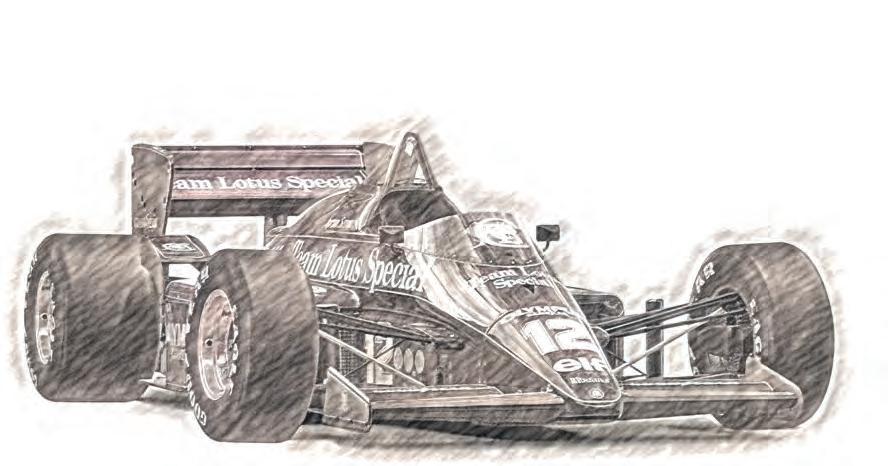
Au Grand Prix de Monaco
Historique, cette McLaren MP4/1 sera pilotée par son propriétaire finlandais, Mika Hakkinen.
At the Historic Monaco GP, this McLaren MP4/1 will be driven by its Finnish owner, Mika Hakkinen.
Cette McLaren MP4/1 n’a pas été pilotée par Ayrton Senna, car elle a disputé la saison 1981 de Formule 1 aux mains de Niki Lauda et John Watson, soit trois ans avant l’arrivée très remarquée du Brésilien, chez Toleman, dans la catégorie-reine du sport automobile. Mais l’ACM ne pouvait pas refuser à son propriétaire finlandais Mika Hakkinen, double Champion du Monde de F1 chez McLaren, le plaisir de participer, sur la piste du Circuit de Monaco, à cette parade historique et inédite baptisée « Senna 30 ans ». Conçue par l’ingénieur anglais John Barnard, c'est la première monoplace de F1 dont le châssis était entièrement constitué de fibre de carbone, pour remplacer l’aluminium utilisé auparavant, avec de nombreux avantages (légèreté, résistance). Baptisée MP4 (pour McLaren Project 4), elle a été la première McLaren d’une longue lignée de monoplaces victorieuses pour la firme de Woking et son patron historique, Ron Dennis.
This McLaren MP4/1 was not driven by Ayrton Senna, because it raced in the 1981 Formula 1 season in the hands of Niki Lauda and John Watson, three years before the Brazilian's much-vaunted arrival in motorsport's premier category with Toleman. But the ACM could not refuse that its Finnish owner Mika Hakkinen, twice F1 world champion with McLaren, enjoy the pleasure of taking part in this historic and unprecedented "Senna 30 years" parade on Circuit de Monaco. Designed by British engineer John Barnard, it was the first F1 single-seater to feature a chassis made entirely of carbon fibre, replacing the aluminium used previously, with numerous advantages (lightness, strength). Named MP4 (for McLaren Project 4), it was the first McLaren in a long line of winning single-seaters for the Woking-based firm and its historic boss, Ron Dennis.

15 14e GRAND PRIX DE MONACO HISTORIQUE 10-12 MAI 2024
BONUS : LA McLAREN MP4/1 DE 1981
A Monaco, cette Lotus 97T sera pilotée par Bruno Senna, le neveu du champion disparu.
Lotus 97T will be driven by Bruno Senna, the late champion's nephew.
MARQUES BRANDS

53 MARQUES BRANDS EN
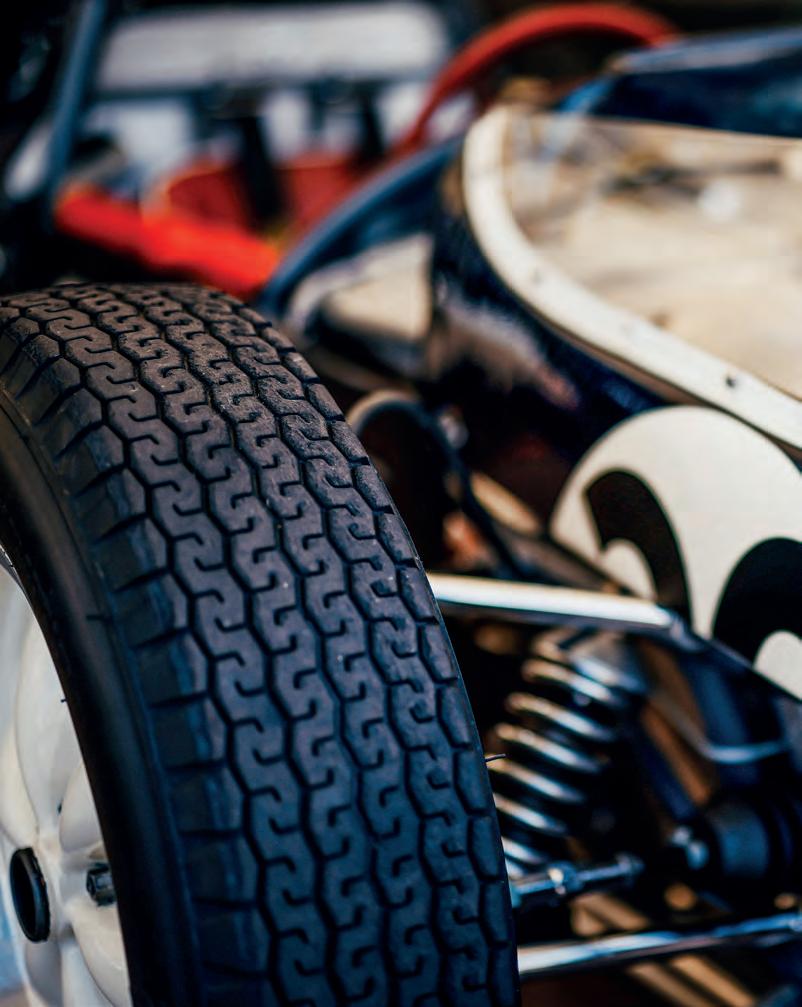

THE
LES
PRESENT
PRÉSENCE
16
1 Voiture victorieuse d’un ou plusieurs Grand Prix de Monaco
Voiture présente en période au Grand Prix de Monaco

ALFA-ROMEO (Séries A1 et G)

Monaco : 1929, 1931, 1932, 1933, 1934, 1935, 1936, 1937, 1950, 1980, 1981, 1982, 1983, 1984, 1985.
A.L.F.A. commence à produire à Portello en 1910 et débute en course dès 1911. La compétition fait partie de l’ADN de la marque dès ses débuts. La firme est intégrée dans les structures de Nicolas Romeo en 1915. Toutes les grandes Alfa de course d’avant-guerre ont participé au Grand Prix de Monaco : de la 6C-1750 à la 12C-36 en passant par les 8C Monza, les P3 et les 8C-35 toutes engagées sous la bannière de la Scuderia Ferrari. Après-guerre, c’est sur des monoplaces Alfa-Romeo 158 et 159 que Nino Farina, en 1950, et Juan Manuel Fangio, en 1951, ont remporté les deux premières éditions du Championnat du Monde. La firme italienne s’est ensuite longuement retirée de la F1 pour y revenir timidement en 1978, comme motoriste chez Brabham, puis de 1979 à 1985 en produisant aussi ses châssis.
A.L.F.A. began production in Portello in 1910 and made its racing debut in 1911. Competition has been part of the brand’s DNA from the outset. The company was integrated into the Nicolas Romeo structures in 1915. All the great pre-war Alfa racing cars took part in the Monaco Grand Prix: from the 6C-1750 to the 12C-36, not forgetting the 8C Monza, the P3 and the 8C-35, all entered under the Scuderia Ferrari banner. After the war, it was in Alfa-Romeo 158 and 159 single-seaters that Nino Farina, in 1950, and Juan Manuel Fangio, in 1951, won the first two editions of the World Championship. The Italian firm then withdrew from F1 for a long time, only to make a timid return in 1978 as an engine manufacturer for Brabham, and then from 1979 to 1985 producing its own chassis as well.


ALLARD J2 (Série C)
Monaco : 1952.


Sydney Allard a disputé des courses de 1936 à 1939 avec des « spéciales » à moteur Ford qu’il a lui-même élaborées. Ses performances l’ont amené à en produire pour d’autres pilotes puis à se lancer dans la production en série, après la guerre, avec les modèles L et M (4e du Rallye Monte Carlo 1949) essentiellement écoulés sur le marché européen. Le modèle J2, présenté fin 1949, va participer aux plus grandes épreuves (Tourist Trophy, Mille Miglia, 24 Heures du Mans en 1951) et, très rapidement, trouver aussi un débouché aux USA. Fer de lance de la marque en course, la J2 connaît une évolution désignée J2X (X pour extended) livrée à partir de 1952. Cette même année, la marque remporte le Rallye Monte-Carlo avec une type P menée par son constructeur.
Sydney Allard raced from 1936 to 1939 in Ford-powered ‘specials’ that he designed himself. His performances led him to produce cars for other drivers and then to launch into series production after the war, with the L and M models (4th at the 1949 Monte Carlo Rally), which were mainly sold on the European market. The J2 model, presented at the end of 1949, was to take part in the biggest events (Tourist Trophy, Mille Miglia, Le Mans 24 Hours in 1951) and, very quickly, also found an outlet in the USA. This model spearheaded the brand’s racing activities and was followed by an evolution known as the J2X (X for extended) delivered from 1952 onwards. This same the year, the brand won the Monte-Carlo Rally with a P-type driven by its manufacturer.
17 14e GRAND PRIX DE MONACO HISTORIQUE 10-12 MAI 2024 3

ARROWS (séries F et G)

Monaco : 1978, 1979, 1980, 1981, 1982, 1983, 1984, 1985, 1986, 1987, 1988, 1989, 1990, 1996, 1997, 1998, 1999, 2000, 2001, 2002. La firme Arrows n’a produit que des F1 ayant disputé de 1978 à 2002 (sauf de 1991 à 1995) toutes les manches du Championnat du Monde sans jamais connaître le succès. Les deuxièmes places de Riccardo Patrese au Grand Prix de Suède 1978, sur une A1, et au Grand Prix de San Marin de 1981, sur une A3, ainsi que la 2e place de Thierry Boutsen à San Marin en 1985, sur une A8, restent ses meilleurs résultats en F1.
Arrows only produced F1 cars, which competed in every round of the World Championship from 1978 to 2002 (except from 1991 to 1995) without ever achieving success. Riccardo Patrese’s 2nd place at the 1978 Swedish Grand Prix, in a A1, and at the 1981 San Marino Grand Prix, in a A3, as well as Thierry Boutsen’s 2nd place at San Marino in 1985, in a A8, remain the firm’s best results in F1.
ASSEGAI

(série B)
Tony Kotze utilisait une Lotus 16 (accidentée par Bruce Halford à Monaco en 1959) dans les courses sud-africaines en 1960 et 1961 (deux abandons consécutifs au Grand Prix d’Afrique du Sud). Il a construit pour la saison 1962 une monoplace à moteur arrière plus moderne. Baptisée Assegaï, elle était dotée d’un moteur 4 cylindres 1500 Alfa dérivé de la série. Il l’a utilisée sans résultat pendant les saisons 1962 et 1963.
Tony Kotze used a Lotus 16 (the one crashed by Bruce Halford in Monaco in 1959) in South African races in 1960 and 1961 (he retired both times from the South African Grand Prix). He then built himself a more modern rear-engined single-seater for the 1962 season. Called Assegaï, it was fitted with a 4-cylinder 1500 Alfa engine derived from the series. He used it without any result during the 1962 and 1963 seasons.

ASTON MARTIN (série C)

Monaco : 1952.
La firme Aston Martin débute en 1913 et, à partir de 1921, participe aux grandes compétitions, puis aux Grands Prix en 1922, aux 24 Heures du Mans en 1928, puis de 1930 à 1939. Après la guerre, Aston reste fidèle aux courses de voitures de Sport et à la classique française qu’elle dispute chaque année. Aux DB1 et DB2 de 1949 à 1951 succèdent la DB3 en 1952 (présente au Grand Prix de Monaco) et la DB3S en 1953. Finalement, c’est en 1959 avec la DBR1 qu’Aston Martin obtient sa première victoire au Mans, et même un doublé, grâce aux équipages Salvadori/Shelby et Trintignant/Frère.
Aston Martin started out in 1913 and, from 1921, took part in major competitions, including Grand Prix racing in 1922, Le Mans 24 Hours in 1928 and from 1930 to 1939. After the war, Aston remained faithful to sportscar racing and to the French classic, which it contested every year. The DB1 and DB2, from 1949 to 1951, were followed by the DB3 in 1952 (present at Grand Prix de Monaco) and the DB3S in 1953. Eventually, in 1959, thanks to the DBR1, Aston Martin recorded its first victory at Le Mans, and a 1-2 by the same token, thanks to a couple of memorable crews, Salvadori/Shelby and Trintignant/Frère.
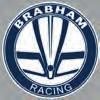
BRABHAM
2
(séries B, D et G)

Monaco: 1963, 1964, 1965, 1966, 1967, 1968, 1969, 1970, 1971, 1972, 1973, 1974, 1975, 1976, 1977, 1978, 1979, 1980, 1981, 1982, 1983, 1984, 1985, 1986, 1987, 1989, 1990, 1991, 1992. Champion du Monde sur Cooper en 1959 et 1960, Jack Brabham devient à son tour constructeur en 1961 et produit les premières monoplaces de marque Brabham en 1962. Le succès ne tarde pas avec quelques victoires dont les deux obtenues par Dan Gurney en 1964 sur une BT7 dans le cadre des Grands Prix de France et du Mexique comptant pour le Championnat du Monde qu’il termine 3e. En 1965, c’est depuis la première ligne que Brabham, sur Brabham, prend le départ du Grand Prix de Monaco. Jack Brabham obtient son 3e titre de Champion du Monde en 1966 (il est le seul à ce jour à être sacré sur une voiture de sa propre marque) et Denny Hulme son coéquipier réitère la performance en 1967. En 1970, le Grand Prix de Monaco Junior est remporté par la BT28 de Tony Trimmer, tandis que Jack Brabham rate la victoire en F1 dans le dernier tour et raccroche son casque en fin d’année. L’entreprise est peu après reprise par Bernie Ecclestone. Mais son rôle de grand patron de la F1 ne lui laissant plus assez de temps, l’homme d’affaires anglais cède Brabham en 1987 et l’écurie revient brièvement sur les circuits de 1989 à 1992.
Jack Brabham won the World Championship in 1959 and 1960 in a Cooper and then became a constructor in 1961, producing the first Brabham single-seaters in 1962. Success came quickly, with Dan Gurney taking two wins in 1964 in a BT7 at the French and Mexican Grand Prix, then finishing 3rd in the World Championship. In 1965, it was from the front row that Brabham, driving a Brabham, started the Monaco Grand Prix. Jack Brabham won his 3rd World Championship title in 1966 (the only man to date able to win it in a car of his own make) and his team-mate Denny Hulme repeated the feat in 1967. In 1970, the Monaco Junior Grand Prix was won by Tony Trimmer’s BT28, while Jack Brabham missed out on the F1 win in the final lap and hung up his helmet at the end of the year. The company was soon taken over by Bernie Ecclestone. But his role as F1 boss no longer left him enough time, so he sold Brabham in 1987 and the team briefly returned to racing from 1989 to 1992.
18

BRM (série B, D et F)

Monaco : 1956, 1957, 1958, 1959, 1960, 1961, 1962, 1963, 1964, 1965, 1966, 1967, 1968, 1969, 1970, 1971, 1972, 1973, 1974, 1975.
La firme BRM, créée juste après la guerre, a été présente en Championnat du Monde de 1951 à 1977. Comme Ferrari, elle a la particularité d’avoir toujours été son propre motoriste. Elle a obtenu sa première victoire en Championnat du Monde avec Joakim Bonnier lors du Grand Prix de Hollande de 1959, sur une P25, puis Graham Hill est devenu Champion du Monde en 1962 sur une P57. La marque anglaise a aussi remporté cinq fois le Grand Prix de Monaco : en 1963, 1964, 1965 avec Graham Hill, en 1966 avec Jackie Stewart et en 1972 enfin avec Jean-Pierre Beltoise.
The BRM company was created just after the Second World War and competed in the World Championship from 1951 to 1977. Like Ferrari, it had the distinction of always being its own engine manufacturer. It scored its first World Championship victory with Joakim Bonnier at the 1959 Dutch Grand Prix in a P25. Then Graham Hill became World Champion in 1962 in a P57. The British brand also won the Monaco Grand Prix five times : in 1963, 1964 and 1965 with Graham Hill, in 1966 with Jackie Stewart and in 1972 with JeanPierre Beltoise.


BRP
Monaco : 1964.

(série B)

L’équipe British Racing Partnership (BRP) a d’abord été mise sur pied en 1959 pour mettre occasionnellement des voitures à la disposition de Stirling Moss. La structure a décidé de construire ses propres autos (3 F1 produites durant les saisons 1963 et 1964) quand la sortie de la Lotus 25, et sa supériorité immédiate, a rendu aussitôt obsolètes les récentes Lotus 24 utilisées par l’équipe.
The British Racing Partnership (BRP) was originally set up in 1959 to provide occasional cars for Stirling Moss. The structure decided to build its own cars (3 F1 cars produced during the 1963 and 1964 seasons) when the release and immediate superiority of the Lotus 25 outdated the recent Lotus 24s used by the team.

BUGATTI (série A1)

Monaco : 1929, 1930, 1931, 1932, 1933, 1934, 1935, 1936.
La firme de Molsheim est la marque emblématique des premiers Grands Prix de Monaco. En effet, pas moins de 60 Bugatti, de 6 types différents, ont été engagées en Principauté entre 1929 et 1936. Des types 35B ont remporté les deux premières éditions en 1929 et 1930, tandis que des types 51 (les dernières voitures de course commercialisées par la marque) leur ont succédé au palmarès en 1931 et 1933.
Production 35 : 96 voitures entre 1924 et 1927 (8 cylindres/2000cc/sans compresseur)
Production 35A : 139 voitures entre 1925 et 1927 (8 cylindres/2000cc/sans compresseur)
Production 35B : 38 voitures entre 1927 et 1930 (8 cylindres/2300cc/à compresseur)
Production 35C : 50 voitures entre 1927 et 1930 (8 cylindres/2000cc/à compresseur)
Production 37A : 78 voitures entre 1927 et 1931 (4 cylindres/1500cc/à compresseur)
Production 51 : 31 voitures entre 1931 et 1934 (8 cylindres double arbre à cames /2300cc/à compresseur)
19 14e GRAND PRIX DE MONACO HISTORIQUE 10-12 MAI 2024 5 4
The Molsheim firm is the emblematic make of the first Monaco GPs. Indeed, no less than 60 Bugatti, of 6 different types, raced in the streets of the Principality between 1929 and 1936. The Type 35B won the first two editions in 1929 and 1930, while the Type 51 (the last racing car marketed by the brand) added to more wins to the tally in 1931 and 1933.
Production 35: 96 cars between 1924 and 1927 (8 cylinders/2000cc/without compressor)
Production 35A: 139 cars between 1925 and 1927 (8 cylinders/2000cc/without compressor)
Production 35B: 38 cars between 1927 and 1930 (8 cylinders/2300cc/compressor)
Production 35C: 50 cars between 1927 and 1930 (8 cylinders/2000cc/compressor)
Production 37A: 78 cars between 1927 and 1931 (4 cylinders/1500cc/compressor)
Production 51: 31 cars between 1931 and 1934 (8 cylinders double overhead camshaft/ 2300cc/compressor)
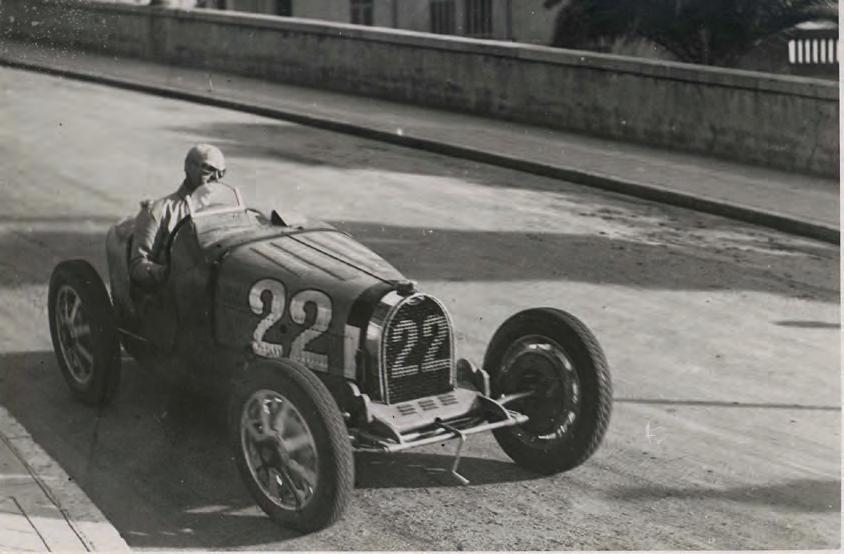

CONNAUGHT (séries A2 et C)

Monaco : 1957 et 1958
Avant de produire les monoplaces type A et B, présentes notamment au Grand Prix de Monaco en 1957 et 1958 (Stuart Lewis-Evans 4e en 1957), la firme anglaise Connaught avait débuté en 1949 en produisant des biplaces. En dix ans d’existence, Connaught a produit 16 biplaces et 18 monoplaces (de la première biplace L2 sortie en 1949 à la F1 type C achevée en 1959 après la faillite de la firme).
Before producing type A and B single-seaters, which were notably present at the Monaco Grand Prix in 1957 and 1958 (Stuart LewisEvans finished 4th in 1957), the English firm Connaught began producing two-seaters in 1949. In ten years of existence, Connaught produced a total of 16 two-seaters and 18 single-seaters (from the first L2 two-seater launched in 1949 to the C type F1 completed in 1959 after the firm's bankruptcy).

COOPER

(séries A2, B et C)

Monaco : 1950, 1957, 1958, 1959, 1960, 1961, 1962, 1963, 1964, 1965, 1966, 1967, 1968, 1969.
Produisant des Racers 500 à partir de 1946, la marque Cooper, monument du sport automobile Anglais, débute en Championnat du Monde en 1950 à l'occasion de la 2e manche du tout premier Championnat, disputée dans les rues de Monaco. Cooper a remporté le Grand Prix de Monaco de F1 en 1958 avec Maurice Trintignant, en 1959 avec Jack Brabham (sacré Champion du Monde en 1959 et 1960), et en 1962 avec Bruce McLaren. Henry Taylor en Formule Junior, en 1960, et Jackie Stewart en F3, en 1964, l’ont aussi emporté en Principauté dans une Cooper.
Producing 500 Racers from 1946 onwards, the Cooper brand, a monument of British motorsport, made its World Championship debut in 1950 in the 2nd round of the very first World Championship, contested in the streets of Monaco. Cooper won the Monaco F1 Grand Prix in 1958 with Maurice Trintignant, in 1959 with Jack Brabham (World Champion in 1959 and 1960) and in 1962 with Bruce McLaren. Henry Taylor in Formula Junior, in 1960, and Jackie Stewart in F3, in 1964, also won in the Principality in a Cooper.
20
3
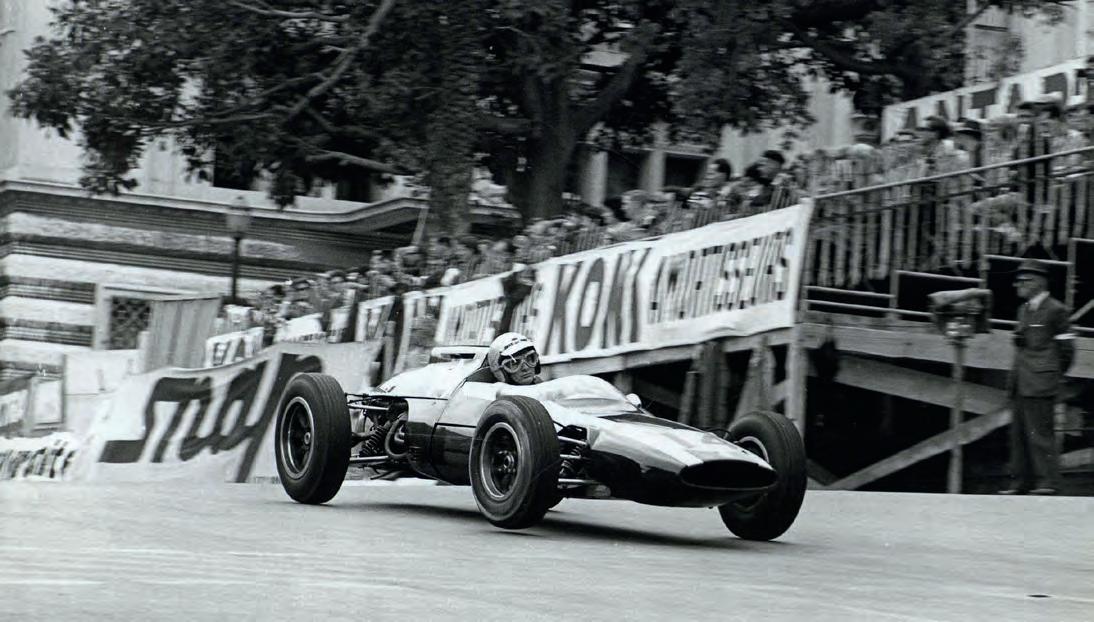

DE TOMASO
Monaco : 1970

(série B)

Avant d’être connu pour la réalisation de ses GT (la Vallelunga, la Mangusta ou la Pantera) l’Argentin Alejandro De Tomaso, installé en Italie, a tout d’abord été pilote régulier en endurance sur Maserati puis Osca. En 1959, il s’engage au Grand Prix des Etats-Unis sur une Cooper dotée d’un moteur Osca. La même année, l’essor de la Formule Junior le conduit à concevoir une première monoplace sur le modèle des Cooper, puis une seconde pour la F2 l’année suivante. L’avènement de la F1 à moteur 1500 lui permet de développer ce projet et de produire des F1 portant son nom, dotées soit de moteurs Alfa Romeo, soit Osca. Les engagements à Monaco de Roberto Bussinello en 1962 et d’Estefano Nasif en 1963 n’ont finalement pas été honorés, contrairement à celui de Clay Regazzoni dans le Grand Prix Junior en 1965, disputé dans des F3. En 1969 et 1970, De Tomaso fait un bref retour à la monoplace avec des voitures dessinées par l’ingénieur Gianpaolo Dallara : une F2 en 1969 et une F1 en 1970.
Before becoming famous for his GT cars (the Vallelunga, the Mangusta and the Pantera), Argentinian Alejandro De Tomaso, who lived in Italy, started out as a regular endurance racer in Maseratis and then Oscas. In 1959, he entered the US Grand Prix in a Cooper with an Osca engine. That same year, the development of Formula Junior led him to design his first single-seater based on the Cooper model, followed by a second for F2 the following year. The advent of the F1 with 1500 engines enabled him to develop this project and to produce F1 cars bearing his name and powered either by an Alfa Romeo or an Osca engine. Roberto Bussinello’s entry for Monaco in 1962 and Estefano Nasif’s in 1963 were not honoured, but Clay Regazzoni’s entry for the F3 Junior Grand Prix in 1965 was. In 1969 and 1970, De Tomaso made a brief return to single-seater racing with cars designed by engineer Gianpaolo Dallara: an F2 in 1969 and an F1 in 1970.

EIFELLAND
Monaco : 1972
(série D)

Gunther Henerici s’intéresse à la course comme vecteur publicitaire pour sa société de caravanes Eifelland. Il débute en 1970 en soutenant deux équipes de F2 et de F3 qui engagent des pilotes allemands dont Rolf Stommelen. Il poursuit en 1971 et, pour 1972, franchit le pas de la F1. Pour cela, il achète une March 721 qui, une fois recarrossée par le styliste Luigi Colani, prend l’appellation Eifelland 21. Après seulement 8 courses, les repreneurs de sa société de caravanes décident de stopper cet investissement.
Gunther Henerici became interested in racing as an advertising tool for his Eifelland caravan company. He began in 1970 by supporting an F2 team and an F3 team entering German drivers including Rolf Stommelen. He continued in 1971 and in 1972 took the step up to F1. To do so, he bought a March 721 which was re-bodied by stylist Luigi Colani and renamed Eifelland 21. After just eight races, the owners of his caravan company decided to stop the investment.
21 14e GRAND PRIX DE MONACO HISTORIQUE 10-12 MAI 2024

ENSIGN (séries E et F)

Monaco : 1974, 1975, 1976, 1977, 1978, 1979, 1980, 1981, 1982, 1983
La firme Ensign de Mo Nunn a débuté en 1971 par la F3 (4e en finale cette année-là à Monaco avec Steve Thomson et 3e l’année suivante avec Colin Vandervell). C’est à la demande de Rikki von Opel (de la famille du constructeur) qu’il va produire sa première F1 en 1973. L’aventure durera jusqu’en 1983, année où son sponsor Theodore en prendra le contrôle. La 4e place de Marc Surer sur une N180 lors du Grand Prix du Brésil 1981 restera la meilleure performance de la petite équipe. C’est aussi le pilote suisse qui obtient, la même année, le meilleur résultat de la marque à Monaco (6e).
Mo Nunn’s Ensign company started out in 1971 with F3 (4th in the final that year in Monaco with Steve Thomson and 3rd the following year with Colin Vandervell). At the request of Rikki von Opel (from the manufacturer’s family), he produced his first F1 car in 1973. The adventure lasted until 1983, when his sponsor Theodore took control. Marc Surer’s 4th place in a N180 at the 1981 Brazilian Grand Prix will go down as the small team’s best performance. That same year, the Swiss driver also achieved the brand’s best finish in Monaco (6th).

ERA
Monaco : 1936, 1948 et 1950

(série A1)

C’est l’avènement des courses de Voiturettes 1500 et la volonté de l’Angleterre de se doter d’un constructeur de voitures de course de niveau international qui donnent lieu à la naissance d’ERA. Les monoplaces portant la marque sont à l’origine dérivées de la « White Riley » de Raymond Mays. Elles vont animer et même dominer un grand nombre de courses de la catégorie. Il y a 90 ans, en 1934, fabriquées en version A, elles vont évoluer en type B, au châssis renforcé en 1935, et en type C à roues avant indépendantes en 1937. Après la guerre, elles resteront parmi les concurrentes jusqu’au début du Championnat du Monde en 1950, où elles figureront encore sur les grilles de départ et parfois même seront classées dans les points.Ainsi, de simples Voiturettes à leur origine, elles ont évolué pour devenir d’abord des voitures de Grand Prix, puis des monoplaces de Formule 1 juste après la guerre, avant de se transformer en voitures de courses de club puis de courses historiques. Cela témoigne du fait qu’elles n’ont jamais réellement quitté les circuits au cours de leurs 90 ans d’existence. La production, qui s’étend principalement de 1934 à 1939, compte à peine 23 monoplaces, y compris la tardive type G de 1952.
The advent of 1500 Voiturettes and England’s desire for an international racing car manufacturer, led to the birth of ERA. The single-seaters bearing that name were originally derived from Raymond Mays’ White Riley. Their participation and domination in numerous races started 90 years ago, in 1934, when the A version was built, evolving into a B-Type with a reinforced chassis, in 1935, and a C-Type with independent front wheels, in 1937. After the war, they remained among the contenders until the start of the World Championship in 1950, when they still featured on the starting grids and sometimes even finished in the points.So, from their origins as simple Voiturettes, they evolved to be among the first Grand Prix cars, then Formula 1 single-seaters just after the war, before becoming club racing cars and historic racing cars. This is testament to the fact that they have never really left the racetrack in their 90 years of existence. Production, which mainly spanned the period from 1934 to 1939, numbered just 23 single-seaters, including the late G-Type of 1952.

FERGUSON
(série A2)
L’entreprise dirigée par l’Irlandais Harry Ferguson, célèbre magnat du tracteur agricole, a développé le système de transmission à quatre roues motrices, initialement expérimenté avant la guerre par Freddy Dixon et Tony Rolt. Pour tester et perfectionner ce système dans des conditions extrêmes, la décision a été prise en 1960 de construire une monoplace de F1, peu de temps avant le décès d’Harry Ferguson. Cette voiture a participé à quelques courses et a même remporté la Gold Cup en 1961 entre les mains de Stirling Moss. Les travaux effectués sur ce véhicule expérimental, appelé P99, ont servi de fondement au système Ferguson utilisé notamment par la Matra MS84 en Formule 1 en 1969.
The company headed by Irishman Harry Ferguson, a famous agricultural tractor magnate, developed the four-wheel drive system first experimented before the war by Freddy Dixon and Tony Rolt. To test and perfect this system under extreme conditions, the decision was taken in 1960 to build a F1 single-seater, shortly before Harry Ferguson’s death. This car took part in several races and even won the Gold Cup in 1961 in the hands of Stirling Moss. The work carried out on this experimental vehicle, known as the P99, formed the basis of the Ferguson system which was used by the Matra MS84 in Formula 1 in 1969.
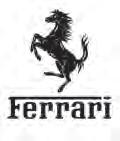
FERRARI
(séries A2, B, C, D, E et F)
Monaco : de 1948 à 2024 sans interruption. 1952, 1955, 1975, 1976, 1979, 1981, 1997, 1999, 2001, 2017

La marque Ferrari a fabriqué sa première voiture en 1947 et a fait ses débuts en Formule 1 dès l’année suivante.
Depuis lors, elle n’a jamais manqué un Grand Prix de Monaco, étant la seule marque à avoir participé à toutes les éditions comptant pour le Championnat du Monde. Parmi les nombreux succès de Ferrari, on compte notamment
22 1 10
dix victoires à Monaco. D’abord lors de la seule épreuve ouverte aux voitures de Sport, le Grand Prix de Monaco en 1952, puis bien sûr en F1, au Grand Prix de Monaco : en 1955 avec Maurice Trintignant, en 1975 et 1976 avec Niki Lauda, en 1979 avec Jody Scheckter, en 1981 avec Gilles Villeneuve, en 1997, 1999 et 2001 avec Michael Schumacher, et enfin en 2017 avec Sebastian Vettel, lors de la dernière victoire en date de la Scuderia en Principauté.
Ferrari built its first car in 1947 and made its Formula 1 debut the following year. Since then, it has never missed a Monaco Grand Prix, being the only marque to have competed in every edition counting for the World Championship. Ferrari’s many successes include ten wins in Monaco. First in the only event open to sportscars, the Grand Prix de Monaco in 1952, then in Formula 1: in 1955 with Maurice Trintignant, in 1975 and 1976 with Niki Lauda, in 1979 with Jody Scheckter, in 1981 with Gilles Villeneuve, in 1997, 1999 and 2001 with Michael Schumacher, in 2017 with Sebastian Vettel. This was the last win to date for the Scuderia in the Principality.
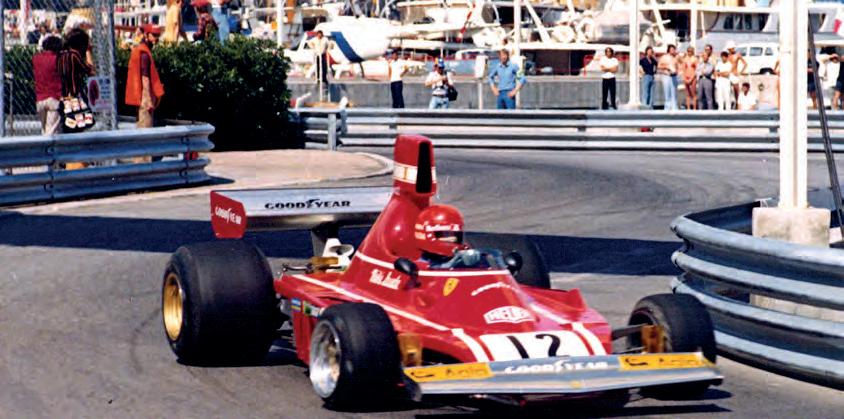

FITTIPALDI (série F)
Monaco : 1975, 1976, 1977, 1978, 1979, 1980, 1981, 1982.


L’écurie Copersucar, financée par une coopérative sucrière brésilienne, fait son entrée en Formule 1 en 1975 avec Wilson Fittipaldi. L’année suivante, son frère cadet, Emerson, le rejoint. Il est alors double Champion du Monde et quitte McLaren, l’un des top teams de l’époque. Peu de temps après, la firme change de nom pour devenir Fittipaldi, avec de nouvelles ambitions, mais elle ne parvient pas à obtenir de succès et cesse son activité en 1982. Le meilleur résultat de la marque reste la deuxième place d’Emerson au Grand Prix du Brésil 1978, dans une F5A, tandis qu’à Monaco son meilleur classement est une 6e place en 1976, dans une FD04.
Copersucar entered the world of Formula 1 racing in 1975 with Wilson Fittipaldi. The following year, his younger brother Emerson joined him. At the time, Emerson was a two-time World Champion and a driver for McLaren, one of the most successful teams of the time. Shortly afterwards, the company changed its name to Fittipaldi, with new ambitions. However, it failed to achieve success and ceased trading in 1982. The team’s best result was Emerson’s second place at the 1978 Brazilian Grand Prix, driving a F5A, while his best finish in Monaco was a 6th place in 1976, in a FD04.

FRAZER NASH
Monaco : 1930 et 1952
(séries A1 et C)

La firme Frazer Nash, active de 1924 à 1958, s’est spécialisée dans la fabrication de biplaces sportives et l’importation de BMW, ne produisant sur demande que six monoplaces : trois avant la guerre et trois après. Après la guerre, l’entreprise a continué dans les mêmes domaines, principalement en se concentrant sur deux châssis distincts. De 1948 à fin 1951, elle a fabriqué 43 unités du modèle Mk1, puis 45 unités du modèle Mk2, plus simple et plus rigide, de début 1952 à 1956. Ces châssis étaient disponibles dans plusieurs versions, permettant à chaque client de choisir celui qui correspondait le mieux à ses besoins, en fonction de l’évolution de la gamme. Lors du Prix de Monte-Carlo 1952, réservé aux voitures de sport et ne comptant pas pour le championnat du monde de F1, l’une des trois Frazer Nash Le Mans Replica est une Mk1, pilotée par David Clarke, qui termine 5e. Les deux autres sont des Mk2. L’une d’elles, pilotée par Stirling Moss, part en pole position mais abandonne, tandis que celle de Tony Crook prend la 3e place.
Production : 43 châssis Mk1 (7 Spéciales, 3 High Speed, 21 Le Mans Replica, 10 Mille Miglia et 2 Coupé) 45 châssis Mk2 (8 Le Mans Replica, 1 Mille Miglia, 14 Targa Florio, 10 coupés, 3 monoplaces 3 Sebring et 6 spéciales).
23 14e GRAND PRIX DE MONACO HISTORIQUE 10-12 MAI 2024
The Frazer Nash firm, which operated from 1924 to 1958, specialized in the manufacture of sports two-seaters and the import of BMWs, producing only six single-seaters on request: three before the war and three afterwards. After the war, the company continued in the same areas, mainly concentrating on two separate chassis. From 1948 to the end of 1951, it produced 43 units of the Mk1 model, followed by 45 units of the simpler, stiffer Mk2 model from early 1952 to 1956. These chassis were available in several versions, allowing each customer to choose the one that best suited his needs as the range evolved. At the 1952 Prix de Monte-Carlo, reserved to sportscars, one of the three Frazer Nash Le Mans Replicas was a Mk1. Driven by David Clarke, it finished 5th. The other two were Mk2s: the one driven by Stirling Moss started on pole but retired, while Tony Crook’s finished in 3rd place.
Production:
43 Mk1 chassis (7 Special, 3 High Speed, 21 Le Mans Replica, 10 Mille Miglia and 2 Coupé)
45 Mk2 chassis (8 Le Mans Replica, 1 Mille Miglia, 14 Targa Florio, 10 Coupés, 3 Sebring single-seaters and 6 specials).

GILBY

(série B)
Avant de se lancer dans la construction automobile en tant que constructeur, l’équipe Gilby Engineering, dirigée par Syd Greene, a tout d’abord fait courir une Maserati A6GCS pour Roy Salvadori à partir de 1953, puis une 250F à partir de 1954 (identifiée comme n°28 en série B). À partir de 1956, Keith Greene, le fils, devient un membre essentiel de l’équipe, jouant un rôle majeur en tant que pilote principal dans les compétitions de voitures de sport et de monoplaces. Ce n’est qu’en 1960 que Gilby est officiellement reconnue comme une marque automobile, initialement avec la construction d’une biplace équipée d’un moteur Climax, puis en 1961 avec la production d’une monoplace de Formule 1 conçue par Len Terry.
Before moving into car building as a manufacturer, the Gilby Engineering team, headed by Syd Greene, first raced a Maserati A6GCS for Roy Salvadori from 1953, then a 250F from 1954 (identified as #28 in the B series). From 1956, Keith Greene, the son, became a key member of the team, playing a major role as lead driver in sportscar and single-seater competitions. It wasn’t until 1960 that Gilby was officially recognized as a car brand, initially with the construction of a two-seater powered by a Climax engine, and then in 1961 with the production of a Formula 1 single-seater designed by Len Terry.

GORDINI
Monaco : 1948, 1950, 1951, 1952, 1955 et 1956.
(série A2)

Installé à Paris dès 1925, Amédée Gordini s’est distingué en préparant et en modifiant des Simca (basées sur des modèles FIAT) de 1935 à 1939. Durant cette période, ses voitures ont participé aux 24 Heures du Mans chaque année et ont même décroché une 5e place à Monaco lors de la 2e Coupe du Prince Rainier. À partir de 1946, Gordini a commencé à produire des voitures sous la marque Simca-Gordini, puis simplement sous le nom Gordini. Cette transition a été marquée par la création d’une série de monoplaces et de biplaces (Robert Manzon, victorieux du Prix de Monte-Carlo et un temps en tête du Grand Prix de Monaco 1952). Ses monoplaces, au nombre de 22 produites entre 1946 et 1956, ont connu un certain succès. Parmi les autres faits marquants figurent la 4e place de Maurice Trintignant en 1948 sur une voiture à 4 cylindres, puis une 5e place d’Hermano da Silva Ramos sur un modèle à 6 cylindres et une 6e place d’Elie Bayol sur une voiture à 8 cylindres en 1956, toujours au Grand Prix de Monaco. L’aventure s’est conclue après les 24 Heures du Mans en 1957. Par la suite, une collaboration avec Renault a débuté, incluant les modèles Dauphine, R8 et R12 Gordini, ainsi que le moteur V8 3L des prototypes A220 et de la F1 A365, qui n’a malheureusement jamais pris part à une course.
Established in Paris in 1925, Amédée Gordini distinguished himself by preparing and modifying Simca cars (based on FIAT models) from 1935 to 1939. During this period, his cars competed in the 24 Hours of Le Mans every year, and even took 5th place in Monaco at the 2nd edition of Prince Rainier Cup. From 1946 onwards, Gordini began producing cars under the Simca-Gordini marque, then simply under the Gordini name. This transition was marked by the creation of a series of single-seaters and two-seaters (Robert Manzon won the Prix de Monte-Carlo and led briefly the Grand Prix de Monaco 1952). There were 22 Gordini single-seaters produced between 1946 and 1956, enjoying a degree of success. Highlights included Maurice Trintignant’s 4th place in 1948 in a 4-cylinder car, Hermano da Silva Ramos’ 5th place in a 6-cylinder model and Elie Bayol’s 6th place in an 8-cylinder car at the 1956 Monaco Grand Prix. The adventure came to an end after Le Mans 24 Hours in 1957. Thereafter, a collaboration with Renault began, including the Dauphine, R8 and R12 Gordini models, as well as the 3L V8 engine for the A220 prototypes and the A365 F1 car, which unfortunately never took part in a race.

HESKETH
Monaco : 1974, 1975, 1976, 1977, 1978.
(séries E et F)

Lord Alexander Hesketh a initialement soutenu la marque Dastle en Formule 3, en 1972, quand Steve Thompson a terminé 12e du Grand Prix de Monaco F3 aux côtés du prometteur James Hunt. Avec ce pilote, Hesketh a ensuite franchi le pas vers la Formule 2 la même année, puis vers la Formule 1 en 1973. Dès 1974, il y a tout juste 50 ans, il produit une première F1 portant son nom. Cette voiture, conçue par Harvey Postlethwaite, a fait une entrée remarquée en Championnat du Monde, toujours pilotée par James Hunt. À la fin de la saison, l’équipe s’est
24 1
classée 6e du Championnat du Monde, puis elle a encore amélioré ses performances en 1975, terminant 4e des constructeurs. Hunt a remporté le Grand Prix de Hollande, seul succès au palmarès de Hesketh en F1. Cependant, l’échec de la nouvelle 308C apparue en cours de saison, ainsi que des problèmes financiers, ont contraint la firme à mettre brutalement fin à ses activités à la fin de l’année. Une reprise en 1977, avec une autre structure, a conduit à la production de la 308E, mais son manque de compétitivité a conduit à la fin définitive de l’entreprise. Durant son existence éphémère, de 1974 à 1978, Hesketh a produit à peine 10 monoplaces de Formule 1.
Lord Alexander Hesketh initially supported the Dastle brand in Formula 3, in 1972, when Steve Thompson finished 12th in the Monaco F3 Grand Prix, alongside the promising James Hunt. With this driver, Lord Hesketh moved on to Formula 2 the same year, and then to Formula 1 in 1973. In 1974, just 50 years ago, he produced the first F1 car to bear his name. This car, designed by Harvey Postlethwaite, made a remarkable debut in the World Championship, still driven by James Hunt. At the end of the season, the team finished 6th in the world standings, and further improved its performance in 1975, finishing 4th in the World Championship. Hunt won the Dutch Grand Prix, the one and only success for Hesketh in F1. However, the failure of the new 308C launched in the middle of the season, as well as financial problems, forced the firm to abruptly cease operations at the end of the year. A revival in 1977, with a different structure, led to the production of the 308E, but its lack of competitiveness led to the definitive end of the company. During its short-lived existence, from 1974 to 1978, Hesketh produced no more than 10 Formula 1 single-seaters.

HILL (série E)
Monaco : 1975


Graham Hill, Champion du Monde en 1962 et 1968, et cinq fois vainqueur du Grand Prix de Monaco, a fondé sa propre écurie de Formule 1 en 1973, en engageant d’abord une Shadow DN1. Pour la saison 1974, il a commandé à Lola une monoplace de Formule 1 désignée T370. Le développement de cette voiture pour la saison 1975, rebaptisée T371 en cours de saison, est finalement devenue la Hill GH1. C'est au volant d'une de ces monoplaces qu'il va prendre part à son dernier Grand Prix. Fin 1975, alors qu’il revenait d’une séance d’essais de la GH2 prévue pour la saison 1976, sur le circuit du Castellet, l’équipe a été décimée dans un tragique accident d’avion.
Graham Hill, a double World Champion (1962, 1968) and a five-time winner of Monaco Grand Prix, founded his own Formula 1 team in 1973, using a Shadow DN1. For the 1974 season, he ordered a Formula 1 single-seater from Lola, designated the T370, which he developed for the 1975 season, renaming it the T371 during the season and eventually calling it the Hill GH1. He contested his very last Grand Prix at the wheel of one of these single-seaters. At the end of 1975, on his way back from testing the GH2 for the 1976 season on Circuit Paul Ricard, in the South of France, the team was decimated in a tragic plane crash.
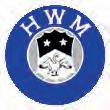
HWM
Monaco : 1955
(série C)

La marque HWM, fondée en 1950, a été très active dans les courses de monoplaces jusqu’à la fin de 1953. Cependant, l’avènement de la Formule 1 limitée à 2,5 litres au début de 1954 a marqué un changement majeur dans son orientation. Elle s’est presque retirée complètement des compétitions de monoplaces pour se concentrer sur la catégorie des voitures de sport. En effet, le moteur de la Jaguar C a suscité l’intérêt de plusieurs constructeurs anglais, dont Cooper et HWM. Dans un premier temps, entre 1953 et 1955, HWM a recyclé d’anciennes monoplaces de 2 litres obsolètes, qu’elle a transformées en biplaces équipées du moteur Jaguar. En 1955, Ted Whiteway a engagé une HWM à titre privé lors du Grand Prix de Monaco, mais il n’a pas réussi à se qualifier pour la course.
Founded in 1950, HWM was very active in single-seater racing until the end of 1953. However, the advent of the 2.5-litre Formula 1 at the beginning of 1954 marked a major change in its direction. It almost completely withdrew from single-seater racing to concentrate on the sportscar category. The Jaguar C’s engine attracted the interest of several British manufacturers, including Cooper and HWM. Between 1953 and 1955, HWM recycled obsolete 2-litre single-seaters and converted them into Jaguar-powered two-seaters. In 1955, Ted Whiteway privately entered an HWM for Monaco Grand Prix, but he failed to qualify for the race.

JAGUAR (série C)

Monaco : 1952, 2000, 2001, 2002, 2003, 2004. La marque SS, qui produisait des modèles à succès en rallye avant la Seconde Guerre mondiale, a dû changer de nom pour des raisons évidentes après le conflit. Elle a alors été rebaptisée Jaguar, en référence à un ancien modèle de la marque. La XK120 et ses dérivées de compétition, telles que les types C (introduites en 1951 et présentes au Grand Prix de Monaco en 1952) et type D (lancées en 1954), ont assuré et prolongé la renommée de la marque dans les courses d’endurance pour de nombreuses années. En l’an 2000, Jaguar a fait son retour en Championnat du Monde pour une période de cinq ans, et a donc participé à nouveau au Grand Prix de Monaco. Eddie Irvine s’est classé 4e en Principauté en 2000, puis 3e en 2001, ce qui constitue le meilleur résultat de la marque en F1, à égalité avec sa 3e place en 2002 au Grand Prix d’Italie, à Monza.
25 14e GRAND PRIX DE MONACO HISTORIQUE 10-12 MAI 2024
The SS brand, which produced successful rally models before the Second World War, had to change its name for obvious reasons after the conflict. It was renamed Jaguar, in reference to an earlier model of the brand. The XK120 and its competition derivatives, such as the C-type (introduced in 1951 and present at Grand Prix de Monaco in 1952) and D-type (launched in 1954), ensured and extended the brand’s reputation in endurance racing for many years. In 2000, Jaguar returned to World Championship racing for a five-year period and took part again in Monaco Grand Prix. Eddie Irvine finished 4th in the Principality in 2000 and 3rd in 2001, the brand’s best result in F1 with another 3rd place in 2002 at the Italian Grand Prix in Monza.
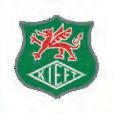
KIEFT

(série C)
Kieft a commencé par produire des Racers 500 à partir de 1950, dont un ayant rencontré un succès notable entre les mains du jeune Stirling Moss en 1951. En 1953, la production de huit voitures de sport a été lancée, basée sur un projet de Formule 2 avorté, ce qui explique la position centrale du pilote.
Production : 8 voitures produites en 1953 (4 à moteur MG 1500 + 4 à moteur 2L Bristol)
Kieft began producing 500 Racers from 1950 onwards, one of which met with notable success in the hands of young Stirling Moss in 1951. In 1953, production of eight sportscars was launched, based on an aborted Formula 2 project, which explains the central position of the driver.
Production: 8 cars produced in 1953 (4 with MG 1500 engine + 4 with 2L Bristol engine).

LEC
(série F)
Sponsor de David Purley depuis longtemps, la société de réfrigérateurs LEC, détenue par son père, a financé la construction d’une monoplace de Formule 1 pour l’année 1977. Après seulement trois départs en Championnat (13e en Belgique, 14e en Suède, abandon en France), la voiture a été complètement détruite lors des essais du Grand Prix de Grande-Bretagne. Une deuxième auto identique a été construite avec laquelle David Purley a pu prendre part en 1979 aux courses en Championnat F1 Anglais soutenu par Aurora.
A long-time sponsor of David Purley, refrigerator company LEC, owned by his father, financed the construction of a Formula 1 single-seater for 1977. After just three starts in the World Championship (13th in Belgium, 14th in Sweden, retirement in France), the car was completely destroyed during practice for the British Grand Prix. A second identical car was built in which David Purley was able to take part in races in the British F1 Championship supported by Aurora in 1979.

LIGIER (série G)

Monaco : 1976, 1977, 1978, 1979, 1980, 1981, 1982, 1983, 1984, 1985, 1986, 1987, 1988, 1989, 1990, 1991, 1992, 1993, 1994, 1995, 1996
Guy Ligier a commencé sa carrière en tant que pilote, atteignant même la Formule 1 (non- qualifié en Formule Junior à Monaco en 1960, non-classé au Grand Prix de F1 en 1966). En 1969, il s’est lancé dans la production d’une GT Française. Certaines de ses voitures, développées et engagées en compétition, notamment aux 24 Heures du Mans, ont obtenu de bons résultats jusqu’en 1975. Lorsque le programme Matra a été arrêté, cela a libéré des ressources financières, notamment le budget Gitanes, ainsi qu’un personnel expérimenté et compétent. Cela a marqué le début d’une saga de 20 ans à partir de 1976, Ligier devenant le porte-drapeau de la F1 Française avec des hauts (de 1976 à 1981) et beaucoup de bas. Juste avant son acquisition par Alain Prost en 1997, l’écurie a connu un dernier succès historique : la victoire d’Olivier Panis au Grand Prix de Monaco 1996, au volant de la JS43.
Guy Ligier began his career as a racing driver, making it as far as Formula 1 (failing to qualify for the Formula Junior race in Monaco in 1960, failing to qualify for the F1 Grand Prix in 1966). In 1969, he embarked on the production of a French GT car. Some of these cars were developed and raced, notably in the Le Mans 24 Hours, with good results until 1975. When the Matra program was discontinued, it freed up financial resources, notably the Gitanes budget, as well as experienced and skilled personnel. This marked the start of a 20-year saga from 1976, Ligier becoming the flag-bearer of French Formula 1, with highs (from 1976 to 1981) and many lows. Just before its acquisition by Alain Prost in 1997, the team enjoyed one last success: Olivier Panis’s memorable win at the 1996 Grand Prix de Monaco, at the wheel of the JS43.

LISTER (série C)
En 1954, Brian Lister a construit sa première voiture. Malgré deux brèves incursions en monoplace, sa marque est demeurée associée à la catégorie des voitures de sport. Après la première Lister biplace, équipée d’un moteur MG, sont venues les Lister Bristol qui ont remporté plusieurs victoires grâce à Archie Scott-Brown. À partir de 1957, les Lister Jaguar ont contribué à la renommée de la marque en Europe et aux États-Unis. Cependant, la mort tragique d’Ivor Bueb lors d’un accident à Charade en juillet 1959 a incité Brian Lister à mettre fin à ses activités en course en 1960.
26
1
In 1954, Brian Lister built his first car. Despite two brief forays into single-seaters, his brand remained associated with the sportscar category. After the first two-seater Lister, powered by an MG engine, came the Bristol Listers, with Archie Scott-Brown taking a number of victories. From 1957 onwards, Jaguar Listers contributed to the brand’s reputation in Europe and the United States. However, the tragic death of Ivor Bueb in an accident at Charade in July 1959 prompted Brian Lister to end his racing activities in 1960.

LOLA
Monaco : 1962, 1963, 1974, 1975, 1986, 1987, 1988, 1989, 1990, 1991, 1993, 1998 à 2004 (F3000)
(séries B et E)

Depuis 1958, Lola s’est distinguée en produisant des voitures de course en série, apparaissant à Monaco dès la sortie de son deuxième modèle, la MK2 de Formule Junior en 1960. La marque a participé régulièrement au Grand Prix Junior jusqu’en 1967 et a même remporté la victoire en 1963 grâce à Richard Attwood. Lola a construit sa première monoplace de Formule 1 en 1962, confiant son engagement à l’équipe de Reg Parnell qui a aligné John Surtees (4e à Monaco) et Roy Salvadori (abandon à Monaco). Par la suite, la marque s’est tournée vers le marché des voitures de sport et des F5000, s’éloignant de la Formule 1 jugée trop exclusive. Après une longue absence dans cette discipline, Lola est revenue sous l’impulsion de Graham Hill. Après avoir rodé son écurie en 1973 avec une Shadow DN1, Hill a commandé à Lola une monoplace désignée T370 pour la saison 1974. À Monaco, les deux voitures engagées ont terminé 7e (Graham Hill) et 8e (Guy Edwards). Lola est revenue en F1, et donc à Monaco, quinze ans plus tard avec des châssis construits pour l’écurie Larrousse à partir de 1989. La F3000 a aussi fait escale à Monaco, entre 1998 et 2004, avec un plateau exclusivement composé de châssis Lola. Ceux-ci ont permis à des pilotes tels que Nick Heidfeld, Gonzalo Rodriguez, Bruno Junqueira, Mark Webber, Sébastien Bourdais et Vitantonio Liuzzi d’inscrire leur nom sur les tablettes monégasques.
Since 1958, Lola has distinguished itself as a manufacturer of production racing cars, appearing with its second model at Monaco, the MK2 Formula Junior in 1960. The brand was a regular participant in the Junior Grand Prix until 1967 and even achieved success in 1963 thanks to Richard Attwood. Lola built its first Formula 1 single-seater in 1962, entrusting its entry to Reg Parnell’s team which fielded John Surtees (4th in Monaco) and Roy Salvadori (retired in Monaco). Subsequently, the brand turned its attention to the sportscar market and the F5000, moving away from F1, considered too exclusive. After a long time away from F1, Lola returned under the impetus of Graham Hill. After starting his team in 1973 with a Shadow DN1, Hill ordered a single-seater from Lola, designated T370, for the 1974 season. At Monaco, both cars finished in the Top 8: Graham Hill 7th and Guy Edwards 8th. The brand made another appearance in F1, and thus in Monaco, with its chassis built for the Larrousse team, from 1989 onwards. It is also worth noting that F3000 made a series of stopovers in Monaco between 1998 and 2004, when its grid was made up exclusively of Lola chassis. This allowed drivers such as Nick Heidfeld, Gonzalo Rodriguez, Bruno Junqueira, Mark Webber, Sébastien Bourdais and Vitantonio Liuzzi to write their names on Monaco’s honor list.

LOTUS

(séries A2, B, C, D, E, F et G)

Monaco : 1958, 1959, 1960, 1961, 1962, 1963, 1964, 1965, 1966, 1967, 1968, 1969, 1970, 1971, 1972, 1973, 1974, 1975, 1976, 1977, 1978, 1979,1980, 1981, 1982, 1983, 1984, 1985, 1986, 1987, 1988, 1989, 1990, 1991, 1992, 1994.
En 1948, la Lotus Mk1 conçue par Colin Chapman voit le jour. La marque, principalement renommée pour ses nombreux succès en monoplaces (7 victoires au Grand Prix de Monaco, 6 titres mondiaux des pilotes, 7 titres des constructeurs), a débuté en produisant des biplaces. En 1952, lors du Prix de Monte-Carlo, Lotus n’en était qu’à la Mk4, une voiture conçue comme les précédentes pour les courses de clubs en Angleterre. En juillet 1952, la Mk6, première biplace prévue pour la course en circuit et la commercialisation, est lancée, avec plus de 100 exemplaires produits jusqu’en 1955. La Lotus 9 est une évolution mécanique et commerciale de la 8, brillante en 1954. En 1955, la demande pressante de Mike Anthony pour une 9 dotée d’un moteur plus puissant que les 1100 et 1500 montés jusqu’alors sur les Lotus 8 et 9 aboutit à la naissance de la Lotus 10, la première à être produite en série avec des freins à disque. La Lotus 11, qui succède à la Lotus 9, est proposée en trois versions à partir de 1956 jusqu’en 1958, et les 270 exemplaires produits assurent à Chapman de quoi développer son secteur des monoplaces. Ce sont d’abord les Lotus 12 (les premières de la marque vues à Monaco en 1958) et 16 à moteur avant. Cependant, c’est avec la Lotus 18, la première à moteur arrière, que Lotus entre dans le cercle restreint des marques victorieuses en Grand Prix, notamment à Monaco en 1960 et 1961 avec Stirling Moss. S’ensuivent une série de monoplaces innovantes qui changent la physionomie des F1, notamment la 25 qui introduit le châssis monocoque, la 49 qui est la première dotée du moteur Cosworth DFV, la 56B à turbine, la 72 avec ses formes en coin, la 78 qui apporte l’effet de sol en F1, et bien d’autres. Présente régulièrement en F1 de 1958 à 1994, la marque Lotus a remporté pas moins de six titres mondiaux : Jim Clark en 1963 et 1965, Graham Hill en 1968, Jochen Rindt en 1970, Emerson Fittipaldi en 1972 et Mario Andretti en 1978. Elle compte également 7 victoires au Grand Prix de Monaco, auxquelles s’ajoutent plusieurs victoires au Grand Prix de Monaco Junior : en 1961 et 1962 avec Peter Arundell, en 1965 avec Peter Revson, en 1971 avec David Walker.
27 14e GRAND PRIX DE MONACO HISTORIQUE 10-12 MAI 2024 7
In 1948, the Lotus Mk1, designed by Colin Chapman, was born. The brand, mainly renowned for its numerous successes in singleseaters (7 wins at Monaco Grand Prix, 6 world titles for drivers, 7 for constructors), began by producing two-seaters. In 1952, at the Prix de Monte-Carlo, Lotus’s current model was only a Mk4, designed like its predecessors for English club events. In July 1952, the Mk6, the first two-seater intended for circuit racing and commercialization, was launched, with over 100 units produced until 1955. The Lotus 9 is the mechanical and commercial development of the 8, shining in 1954. In 1955, the pressing demand from Mike Anthony for a Mk9 with a more powerful engine than the 1100 and 1500 fitted to the Lotus 8 and 9 led to the birth of the Lotus 10, the first to be mass-produced with disc brakes. The Lotus 11, succeeding the Lotus 9, was offered in three versions from 1956 to 1958, and the 270 units produced provided Chapman enough cash to develop his single-seater sector. First came the Lotus 12 (the first from the brand seen at Monaco, in 1958) and the 16 with a front engine. However, it was with the Lotus 18, the first with a rear engine, that Lotus entered the select circle of victorious brands in Grand Prix, notably at Monaco in 1960 and 1961 with Stirling Moss. This was followed by a series of innovative single-seaters that changed the face of F1, including the 25, with its monocoque chassis, the 49, the first F1 car equipped with a Cosworth DFV, the 56B with a turbine, the 72 with wedge shapes, the 78 which brought ground effect to F1, and many more. Regularly present in F1 from 1958 to 1994, the Lotus brand won no fewer than seven world titles for constructors and six world titles for drivers: Jim Clark in 1963 and 1965, Graham Hill in 1968, Jochen Rindt in 1970, Emerson Fittipaldi in 1972, Mario Andretti in 1978. It also boasts 7 wins at Monaco Grand Prix, in addition to several wins at Grand Prix de Monaco Junior: in 1961 and 1962 with Peter Arundell, in 1965 with Peter Revson, and in 1971 with David Walker.


McLAREN
MONACO : 1966 à 2024

(séries D, E, F et G)

1984, 1985, 1986, 1988, 1989, 1990, 1991, 1992, 1993, 1998, 2000, 2002, 2005, 2007, 2008
Bruce McLaren, pilote officiel de Cooper en F1 au début des années 60 (vainqueur des Grands Prix des USA en 1959, d’Argentine en 1960 et de Monaco en 1962), est lui aussi devenu constructeur, suivant ainsi les traces de son ancien coéquipier Jack Brabham. Sa première F1, la M2B, a fait ses débuts à Monaco en 1966 et, en 1968, il a remporté le Grand Prix de Belgique au volant d’une monoplace portant son nom. Après le tragique accident qui lui a coûté la vie en 1970, la marque est restée active et a guidé plusieurs pilotes vers des titres de Champion du Monde : Emerson Fittipaldi (1974), James Hunt (1976), Niki Lauda (1984), Alain Prost (1985, 1986, 1989), Ayrton Senna (1988, 1990, 1991), Mika Hakkinen (1998, 1999) et enfin Lewis Hamilton en 2008. La marque compte 15 victoires au Grand Prix de Monaco.
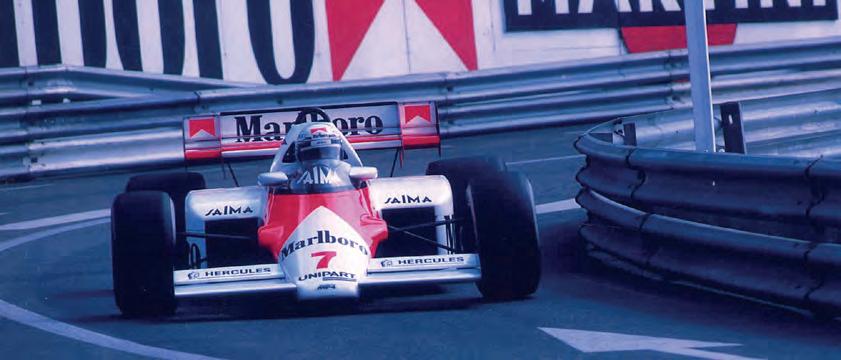
28
15
Bruce McLaren, an official Cooper F1 driver between 1960 and 1965 (winner of the USA Grand Prix in 1959, the Argentine Grand Prix in 1960 and Monaco Grand Prix in 1962), also decided to become a constructor, following in the footsteps of his former teammate Jack Brabham. His first F1 car, the M2B, made its debut at Monaco in 1966. In 1968, he won the Belgian Grand Prix in a car bearing his name. After the tragic accident that cost his life in 1970, the brand remained active and guided several drivers to World Championship titles: Emerson Fittipaldi (1974), James Hunt (1976), Niki Lauda (1984), Alain Prost (1985, 1986, 1989), Ayrton Senna (1988, 1990, 1991), Mika Hakkinen (1998, 1999) and, last but not least, Lewis Hamilton (2008). The brand has 15 victories at the Grand Prix de Monaco.

MARCH

(séries D, F et G)

Monaco : 1970, 1971, 1972, 1973, 1974, 1975, 1976, 1977, 1981,1982, 1983,1988, 1989, 1992. March, fondée en 1969, fait son entrée en Formule 1 dès 1970 en équipant près d’un tiers de la grille, y compris l’équipe phare de Ken Tyrrell, Championne du Monde en 1969 avec Jackie Stewart et Matra. Suivant le modèle de Cooper dans les années 1950 et 1960, les créateurs de la marque visaient à produire en série et à vendre un maximum de monoplaces dans toutes les catégories : F1, F2, F3, F5000, Formule Atlantic et même plus tard en Sport 2L et 3L. Malheureusement, la Formule 1 est restée le parent pauvre, avec seulement trois victoires obtenues par Jackie Stewart (Espagne 1970), Vittorio Brambilla (Autriche 1975) et Ronnie Peterson (Italie 1976). Pendant la même période, des March ont remporté deux fois le Championnat d’Europe de F2, et des F3 de la marque anglaise se sont couvertes de lauriers, notamment au Grand Prix de Monaco Junior remporté par Tom Pryce en 1974 et Bruno Giacomelli en 1976. En 1977, le départ de Max Mosley marque la fin de l’implication de March en F1, un marché jugé pas assez rentable. March y reviendra plus tard, pour trois ans, principalement en prestation de service par l’ingénieur-maison, Robin Herd, auteur de la 811 pour l’écurie Ram. La 821 qui lui a succédé, conçue par Adrian Reynard, n’avait plus que le nom de March. L’échec de qualification des trois voitures engagées au Grand Prix de Monaco 1982 a découragé le sponsor, signant la fin imminente de la deuxième période de March en F1. La marque a continué encore une année avec la 831, mais sans espoir ni résultat : Eliseo Salazar ne s’est pas qualifié à Monaco, dans la seule March engagée.
March, founded in 1969, entered Formula 1 in 1970 by equipping nearly a third of the grid, including the flagship team of Ken Tyrrell, crowned World Champion in 1969 with Jackie Stewart and Matra. Following the business model of Cooper in the 1950s and 1960s, the creators of the brand aimed to mass-produce and sell a maximum number of single-seaters in all categories: F1, F2, F3, F5000, Formula Atlantic, and even later in 2L and 3L Sportscars. Unfortunately, the F1 branch only collected three wins, thanks to Jackie Stewart in Spain in 1970, Vittorio Brambilla in Austria in 1975, and Ronnie Peterson in Italy in 1976. During the same period, March cars won the European F2 Championship twice, and F3 cars earned many laurels, notably at the Junior Monaco Grand Prix won by Tom Pryce in 1974 and Bruno Giacomelli in 1976. In 1977, Max Mosley’s departure marked the end of March’s involvement in F1, a market deemed not profitable enough. March would return later for three years, primarily as a service provided by house engineer Robin Herd who designed the 811 for the Ram Racing team. The 821 that followed, designed by Adrian Reynard, was not a March any more, except for its name. The failure to qualify the three cars entered in the 1982 Monaco Grand Prix discouraged the sponsor, signaling the imminent end of March’s second journey in F1. However, it continued for another year with the 831, without any hope or result: Eliseo Salazar failed to qualify in Monaco with the only March entered.

MASERATI
(séries A1, A2 et C)

Monaco : 1929, 1930, 1931, 1932, 1934, 1935, 1936, 1937, 1948, 1950, 1955, 1956, 1957, 1958, 1959. Maserati a été représentée dans tous les Grand Prix de Monaco d’avant-guerre ainsi que dans la seule épreuve de Voiturettes organisée en Principauté en 1936, où elle était la principale usine engagée. Découragée en Grand Prix par la domination des Auto-Union et des Mercedes, elle avait en effet accentué ses efforts vers la production de monoplaces de petite cylindrée destinées aux courses de Voiturettes. Rachetée par Omer Orsi, elle connaîtra à partir de 1947 une nouvelle période faste en Grand Prix, notamment avec les 4CLT (victoire de Nino Farina à
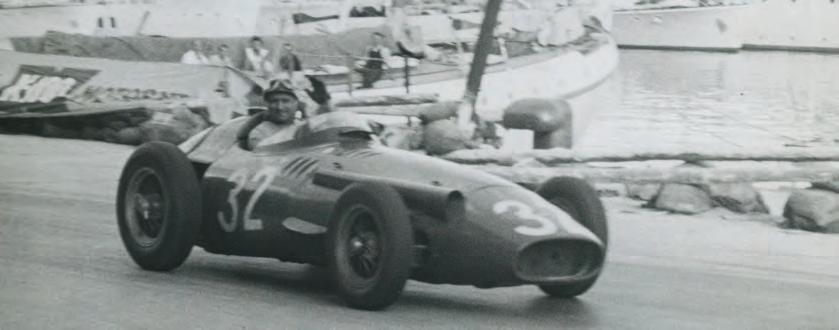
29 14e GRAND PRIX DE MONACO HISTORIQUE 10-12 MAI 2024 3



Monaco en 1948) et l’avènement de la 250F en 1954 (il y a tout juste 70 ans) qui a remporté deux fois de suite le Grand Prix de Monaco : en 1956 avec Stirling Moss et en 1957 avec Juan Manuel Fangio qui sera ensuite sacré Champion du Monde, pour la cinquième et dernière fois de sa carrière.
Maserati was represented in all pre-war Monaco Grand Prix events, as well as in the only Voiturettes race held in the Principality in 1936, where it was the main factory entered. Having been discouraged in Grand Prix racing by the domination of Auto-Union and Mercedes, it had shifted its focus to the production of small single-seaters for Voiturettes racing. Bought out by Omer Orsi, the company enjoyed a new period of Grand Prix success from 1947 onwards, notably with the 4CLT (Nino Farina won at Monaco in 1948) and the advent of the 250F in 1954 (just over 70 years ago), which won the Monaco Grand Prix twice in a row: in 1956 with Stirling Moss and in 1957 with Juan Manuel Fangio, who went on to become World Champion for the fifth and final time in his career.
MATRA (série D)

Monaco : 1965, 1966, 1967, 1968, 1969, 1970, 1971, 1972
Fondée en 1965, la société Matra Automobiles affichait dès ses débuts de grandes ambitions. Après avoir remporté un premier succès à Reims en F3 en 1965, la marque s’est rapidement imposée comme une force majeure. Une MS5 a décroché deux victoires d’affilée au Grand Prix de Monaco F3, avec Jean-Pierre Beltoise en 1966 et Henri Pescarolo en 1967 (ils utilisaient le même chassis). Matra a fait ses débuts en Championnat du Monde lors du Grand Prix de Monaco 1967, avec des MS5 lestées confiées à Jean-Pierre Beltoise et Johnny Servoz-Gavin. Dès 1968, une première F1 à moteur V12, la MS11, a été produite et a fait ses débuts à Monaco, suivie de la MS120 en 1970. Entre-temps, grâce à la MS10 et la MS80 Cosworth confiées à Tyrrell et pilotée par Jackie Stewart, Matra a remporté un titre de Champion du Monde en 1969. La priorité accordée à la victoire au Mans (obtenue en 1972, 1973 et 1974) a marqué la fin du programme F1 à la fin de la saison 1972. La 3e place décrochée par Henri Pescarolo sur sa MS120 en 1972 constitue le meilleur résultat d’une Matra F1 à Monaco.
Founded in 1965, Matra Automobiles had big ambitions from the outset. After a first success at Reims in F3 in 1965, the brand quickly established itself as a major force. An MS5 won the Monaco F3 Grand Prix twice in a row, with Jean-Pierre Beltoise in 1966 and Henri Pescarolo in 1967 (they used the same chassis). Matra made its World Championship debut at the 1967 Grand Prix de Monaco, with ballasted MS5s driven by Jean-Pierre Beltoise and Johnny Servoz-Gavin. In 1968, the first V12-powered F1 car, the MS11, was produced and made its debut at Monaco, followed by the MS120 in 1970. Meanwhile, with the MS10 and the MS80 Cosworth entrusted to Tyrrell and driven by Jackie Stewart, Matra won a World Championship title in 1969. The priority given to winning at Le Mans (in 1972, 1973 and 1974) marked the end of the F1 program at the end of the 1972 season. Henri Pescarolo’s 3rd place in his MS120 in 1972 remains the best result for a Matra F1 car in Monaco.

(série A1)

Monaco : 1936
La marque MG, fondée en 1923, a toujours été spécialisée dans la construction de voitures sportives à deux places, largement utilisées par de nombreux clients dans les compétitions automobiles. En 1936, lors de la Coupe du Prince Rainier, une MG de type C, pilotée par Robert Kohlrausch, a tenté de se qualifier. La K3, modèle emblématique de MG, était conçue initialement comme une petite biplace polyvalente rapidement devenue la marque de fabrique de MG. Ses performances ont démontré sa polyvalence, sur les routes des Mille Miglia, du Tourist Trophy (remporté par Tazio Nuvolari en 1933), des 24 Heures du Mans (4e en 1934), ou encore dans des épreuves réservées
MG
30
aux Voiturettes (victoire de Richard Seaman au Prix de Berne en 1934). Les voitures produites par la marque après la guerre ont suivi la même voie et visé les mêmes objectifs, d’abord les MG TC et TD dans les années 1940 et 1950, puis la MGA et la MGB dans les années 1960.
The MG brand, founded in 1923, has always specialized in the construction of two-seater sportscars, widely used by many customers in various categories and competitions. In 1936, at the Prince Rainier Cup, an MG type C, driven by Robert Kohlrausch, tried to qualify. The K3, the emblematic MG model, was initially designed as a small, versatile two-seater, and soon became the MG trademark. Its level of performance demonstrated its versatility, whether on the roads of the Mille Miglia and the Tourist Trophy (won by Tazio Nuvolari in 1933), at Le Mans 24 Hours (4th in 1934) and at various events reserved for Voiturettes (Richard Seaman’s win at Prix de Berne in 1934). The cars produced by the brand after the war followed the same path and aimed at the same objectives, first the MG TC and TD in the 1940s and 1950s, then the MGA and MGB in the 1960s.
MINARDI (série G)
Monaco : 1985, 1986, 1987, 1988, 1989, 1990, 1991, 1992, 1993, 1994, 1995, 1996, 1997, 1998, 1999, 2000, 2001, 2002, 2003, 2004, 2005.

Giancarlo Minardi, un proche d’Enzo Ferrari, a initialement dirigé l’écurie Everest engagée en Formule 2 à partir de 1976. Il a ensuite évolué pour devenir constructeur dans cette catégorie en 1980, avant de faire le saut en Formule 1 à partir de 1985, une catégorie sur laquelle il s’est exclusivement concentré jusqu’en 2005. Des pilotes tels qu’Angel Guerra, Beppe Gabbiani, Johnny Cecotto, Michele Alboreto (vainqueur à Misano en 1981), Paolo Barilla, Alessandro Nannini, Andrea de Cesaris, Adrian Campos et Oscar Larrauri ont tous contribué à l’aventure de Minardi en F2. En F1, les meilleurs résultats de l’écurie italienne restent les quatrièmes places obtenues par Pier Luigi Martini aux Grands Prix de San Marin et du Portugal en 1991, avec la M191 équipée d’un moteur Ferrari, ainsi que la 4e place de Christian Fittipaldi dans une M193 Ford en Afrique du Sud en 1993.
Giancarlo Minardi, a close associate of Enzo Ferrari, initially ran the Everest team in Formula 2 from 1976. He went on to become a constructor in this category in 1980, before making the leap to Formula 1 from 1985, a category on which he concentrated exclusively until 2005. Drivers such as Angel Guerra, Beppe Gabbiani, Johnny Cecotto, Michele Alboreto (winner at Misano in 1981), Paolo Barilla, Alessandro Nannini, Andrea de Cesaris, Adrian Campos and Oscar Larrauri all contributed to Minardi’s F2 adventure. In F1, the team’s best results remain a couple of 4th places by Pier Luigi Martini at the San Marino and Portuguese Grands Prix in 1991, with the Ferrari-powered M191, and a 4th place for Christian Fittipaldi in a M193 Ford in South Africa in 1993.

OSCA (séries A2 et C)
Monaco : 1952, 1958


Après avoir cédé leur usine à Omer Orsi, les frères Maserati ont été privés du droit d’utiliser leur propre nom dans la fabrication d’automobiles. C’est ainsi qu’ils ont fondé Osca en 1948 et développé le modèle MT4, produit jusqu’en 1956. Les premiers modèles, livrés avec une carrosserie «siluro» entre 1948 et 1950, équipés de gardeboue et de phares démontables, étaient adaptés pour être utilisés en Formule 2. En 1952, lors du Prix de MonteCarlo disputé hors-championnat et réservé aux voitures de sport, l’unique Osca engagée a terminé à la 2e place entre les mains de Franco Bordoni. En 1954, Stirling Moss et Bill Lloyd ont remporté les 12 Heures de Sebring au volant d’une MT4. En 1958, deux Osca F2/S ont tenté en vain de se qualifier pour le Grand Prix de Monaco de F1 et, en 1960, Colin Davis a terminé 12e du Grand Prix de Monaco Junior. La production des MT4 a concerné 80 voitures au total, dont 10 avec une carrosserie «siluro» (en forme de torpille) et un moteur simple arbre, produites de 1948 à 1950. Les autres voitures ont été produites entre 1950 et 1956 avec un moteur double arbre (2AD).
After selling their factory to Omer Orsi, the Maserati brothers were deprived of the right to use their own name in car manufacturing. They founded Osca in 1948 and developed the MT4 model, which was produced until 1956. The first models, delivered with ‘siluro’ bodywork (the Italian name for a torpedo shape) between 1948 and 1950, fitted with removable mudguards and headlights, were adapted for use in Formula 2 racing. In 1952, at the Prix de Monte-Carlo reserved to sportscars, the only Osca entered finished in 2nd place in the hands of Franco Bordoni. In 1954, Stirling Moss and Bill Lloyd won the 12 Hours of Sebring in a MT4. In 1958, two Osca F2/S tried unsuccessfully to qualify for the Monaco Grand Prix and in 1960 Colin Davis finished 12th of the Junior Monaco Grand Prix. Production of the MT4 type comprised 80 cars in total, including 10 with «siluro» bodywork and single-shaft engines, produced between 1948 and 1950. The remaining cars were produced between 1950 and 1956 with a twin-axle engine (2AD).

OSELLA (série G)
Monaco : 1980, 1981, 1982, 1983, 1984, 1985, 1986, 1987, 1988, 1989, 1990.

Enzo Osella avait supervisé l’engagement des biplaces Abarth officielles de 1969 à 1972. Il a ensuite pris en charge tout seul cette catégorie, à partir de 1973, puis a élargi ses activités en se lançant dans la Formule 2 à partir de 1975. En 1976, Giorgio Francia a malheureusement abandonné lors de la première série éliminatoire du Grand Prix de Monaco Junior F3. En 1980, Osella a franchi le pas vers la Formule 1 avec la FA1 confiée à l’Américain Eddie Cheever.
31 14e GRAND PRIX DE MONACO HISTORIQUE 10-12 MAI 2024

Sa présence dans l’élite du sport automobile a continué jusqu’en 1990. Le point culminant en Championnat du Monde reste la 4e place décrochée par Jean Pierre Jarier au Grand Prix de San Marin en 1982 au volant d’une FA1C. En ce qui concerne le Grand Prix de Monaco, la meilleure performance d’une Osella a été la 7e place de Piercarlo Ghinzani, sur une FA1E, en 1984.
Enzo Osella, who was in charge of entries for official Abarth two-seaters from 1969 to 1972, then took sole charge of this category from 1973. He expanded his activities by entering Formula 2 from 1975. In 1976, Giorgio Francia unfortunately retired in the first qualifying round of Grand Prix de Monaco Junior F3. In 1980, Osella made the step up to Formula 1 with a FA1 model entrusted to American driver Eddie Cheever. Its presence in the elite category of motorsport continued until 1990. The highlight in the World Championship was Jean Pierre Jarier’s 4th place at the 1982 San Marino Grand Prix, in a FA1C. As far as the Grand Prix de Monaco is concerned, the best result by an Osella was a 7th place for Piercarlo Ghinzani, in a FA1E, in 1984.

PEGASO (série C)

Monaco : 1952
L'ambitieuse mais éphémère firme espagnole Pegaso qui fait suite à Hispano Suiza a été dévoilée pour la première fois au public lors du Salon de l’Auto à Paris, fin 1951. En mai 1952, lors du Prix de Monte-Carlo, elle n’avait donc pas une année d’existence. Sa production n’avait pas encore dépassé 10 voitures à cette époque, pourtant trois d’entre elles étaient présentes dans les stands, dont deux engagées pour la course. Cependant, en raison de problèmes de mise au point et de leur encombrement, les voitures confiées à Juan Palacio et Juan Jover ont été accablées de soucis lors des essais, se qualifiant en dernière ligne mais étant retirées avant la course. La production totale de Pegaso est estimée à 83 voitures, dont 11 berlinettes avec carrosserie d’usine, également appelées Enasa, du nom du groupe industriel espagnol propriétaire de la marque Pegaso.
The ambitious but short-lived Spanish brand Pegaso, successor to Hispano Suiza, was first unveiled to the public at the Paris Motor Show at the end of 1951. In May 1952, at the Prix de Monte-Carlo, it had not yet been in existence for a year. Fewer than 10 cars had been produced at the time, yet three of them were present in the pits, with two entered for the race. However, due to set-up problems and their big size, the cars entrusted to Juan Palacio and Juan Jover were plagued by problems during testing, qualifying on the last row but being withdrawn before the race. Pegaso’s total production is estimated at 83 cars, including 11 factory-bodied berlinettes, also known as Enasa, the name of the Spanish industrial group owning the Pegaso brand.

PENSKE (série E)

Monaco : 1975, 1976, 1977.
Roger Penske, pilote américain réputé dans les années 1960, a fondé une équipe solide qui a remporté les 500 Miles d’Indianapolis en 1972 (grâce à Mark Donohue sur une McLaren) et la série Can-Am en 1972 et 1973 (avec George Follmer, puis Mark Donohue). À partir de sa base anglaise, il a abordé la F1 fin 1974. Sa présence n’a duré que deux saisons complètes marquées par une victoire en Championnat du Monde obtenue au Grand Prix d’Autriche en 1976 par John Watson. La présence de Penske en F1 a débuté fin 1974 avec les PC1 et s’est achevée fin 1976 avec les PC4 rachetées par Gunther Schmidt, qui les utilisa en début de saison 1977. L’expérience acquise en Europe sera en partie transposée dans les courses de Formule Indy où Penske va devenir une écurie de référence (victoires aux 500 Miles d’Indianapolis en 1979, 1981, 1988, 1989, 1991 et 1994).
American driver Roger Penske had a good reputation in the 60s and then founded a solid team winning at Indianapolis in 1972 (Mark Donohue in a McLaren) and the Can-Am series in 1972 and 1973 (with George Follmer and then Mark Donohue). He approached F1 in late 1974 and only stayed during two complete seasons, marked by a victory in the World Championship at the Austrian Grand Prix in 1976 with John Watson. Penske presence in F1 began at the end of 1974 with PC1s, and ended, at the end of 1976 with the PC4s bought by Gunther Schmidt, who used thme at the start of the 1977 season. The experience he gained was then brought to Indycar races where Roger Penske became a benchmark of the category, winning the Indy 500 in 1979, 1981, 1988, 1989, 1991 et 1994.

RILEY (série A1)
La première automobile Riley a été assemblée par Percy Riley en 1898 et la dernière a été produite en 1938, quarante ans plus tard. Aucune Riley n’a participé aux épreuves organisées sur le circuit de Monaco. Cependant, des modèles sportifs (une spécialité de la marque) tels que les modèles Brooklands souvent personnalisés par leurs propriétaires ou des voitures spécialement produites à l’unité, ont animé des courses anglaises à participation internationale. C’est notamment le cas de la White Riley de Raymond Mays, considérée comme le prototype des premières ERA, ainsi que des voitures développées par Freddie Dixon et Hector Dobbs.
The first Riley car was assembled by Percy Riley in 1898 and the marque’s last car was produced in 1938, exactly forty years later. No Riley ever competed on the Monaco circuit. However, the brand’s (specialty sports models) such as Brooklands model, which were often personalized by their owners, or cars specially produced to order, did take part in British races with international participation. These included Raymond Mays’ White Riley, considered to be the prototype for the first ERAs, as well as cars developed by Freddie Dixon and Hector Dobbs.
32
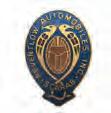
SCARAB
Monaco : 1960

(série A2)

L’Américain Lance Reventlow, qui a débuté sa carrière de pilote en 1955, est venu disputer quelques courses de Formule 2 en Europe en 1957. L’année suivante, il a lancé la production d’une voiture de sport sous la marque Scarab, équipée d’un moteur Chevrolet. Entre ses mains, ainsi que celles de Chuck Daigh, cette voiture a connu un certain succès dans les courses américaines en 1958 et 1959. En 1959, la marque a également conçu une voiture de Formule 1 dans le but de défier les Européens sur leur propre terrain. Malheureusement, avant même leur premier Grand Prix, les F1 conçues par Scarab étaient déjà dépassées car elles étaient dotées d’un moteur avant, alors que les Cooper avaient déjà imposé le moteur arrière. Avec un an de retard, elles ont finalement débuté aux essais du Grand Prix de Monaco 1960. Cependant, après une double non-qualification enregistrée ce jour-là, elles ont été retirées avant le départ du Grand Prix de Hollande, puis ont enregistré un double abandon en Belgique et échoué aux essais du Grand Prix de France. Cette série de performances décevantes a mis un terme à l’expérience de Scarab en F1 européenne. Forte de cette expérience, Scarab a produit en 1962 une nouvelle monoplace pour la Formule Intercontinentale, ainsi qu’une dernière voiture de sport, toutes les deux équipées d’un moteur arrière. À la fin de son activité, Scarab n’avait construit que sept voitures de course, dont quatre biplaces et trois monoplaces.
American Lance Reventlow, who began his racing career in 1955, came to Europe in 1957 to compete in several Formula 2 races. The following year, he launched production of a sportscar under the Scarab name, powered by a Chevrolet engine. In his hands, and those of Chuck Daigh, this car enjoyed some success in American races in 1958 and 1959. In 1959, the marque also designed a Formula 1 car with the aim of challenging Europeans on their home turf. Unfortunately, even before their first Grand Prix, Scarab’s Formula 1 cars were already out of date because they were designed with a front engine, while Cooper had already imposed the rear engine. A year later, they finally made their debut at the 1960 Monaco Grand Prix, but after failing to qualify both cars that day, they were withdrawn before the start of the Dutch Grand Prix, both cars retired in Belgium and failed to qualify for the French Grand Prix. This series of disappointing performances put an end to Scarab’s F1 experience in Europe. Building on this experience, Scarab produced a new single-seater for the Intercontinental Formula in 1962, as well as one final sportscar, both with a rear-engine. At the end of its activity, Scarab had only built seven racing cars, including four two-seaters and three single-seaters.
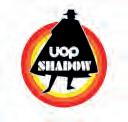
SHADOW
Monaco : 1973, 1974, 1975, 1976, 1977, 1978, 1979, 1980.
(séries E et F)

L’écurie Shadow, présente dans les courses de la série Can-Am depuis 1970, a fait son entrée en Formule 1 en 1973. C’était le retour des Américains dans le grand bain après le retrait des Eagle de Dan Gurney, présentes au plus haut niveau entre 1966 et 1968. Les premières monoplaces produites, arborant la couleur noire frappée du drapeau américain sur leur haute prise d’air, constituaient un symbole important du début de la mondialisation de la F1. Shadow est restée active en F1 jusqu’en 1980, avec comme meilleurs résultats la victoire d’Alan Jones, dans une DN8, au Grand Prix d’Autriche 1977 (le seul succès de la marque en F1) et la 3e place de Jean Pierre Jarier à Monaco en 1974, dans une DN3.
Shadow, which had been racing in the Can-Am series since 1970, entered Formula 1 in 1973. It was America’s return to big time motorsport after the withdrawal of Dan Gurney’s Eagle team, present at the highest level between 1966 and 1968. The first singleseaters produced, sporting a black livery and an American flag on their very high airbox, were an important symbol of the beginning of F1 globalization. Shadow remained active in F1 until 1980, with Alan Jones winning the 1977 Austrian Grand Prix in a DN8 (the only success of the team in F1) and Jean Pierre Jarier finishing 3rd in Monaco in 1974, in a DN3.

SURTEES
Monaco : 1971, 1972, 1973, 1974, 1975, 1976, 1977, 1978.
(séries D et E)

À l’instar de Jack Brabham et Bruce McLaren avant lui, John Surtees (multiple Champion du Monde de moto et Champion du Monde de F1 en 1964 avec Ferrari) a également fait le pas pour devenir constructeur en 1969 avec la TS5 destinée au Championnat Anglais F5000. L’histoire de la marque en Championnat du Monde de F1, commencée avec la TS7 dévoilée au Grand Prix de Grande-Bretagne en 1970, a pris fin avec la TS20 en 1978. Entre ces deux dates, la firme a produit une série de monoplaces «honnêtes» qui n’ont jamais été en mesure de remporter un Grand Prix. La 2e place obtenue au Grand Prix d’Italie en 1972 par la TS9B de Mike Hailwood (également multiple Champion du Monde de moto et Champion d’Europe de F2 sur une TS10 en 1972) constitue le meilleur résultat obtenu par une Surtees en Championnat du Monde. À Monaco, la 6e place de Rolf Stommelen en 1971, sur une TS9, reste le meilleur résultat de la marque en Principauté.
Like Jack Brabham and Bruce McLaren before him, John Surtees (multiple motorbike World Champion and F1 World Champion in 1964 with Ferrari) also took the step of becoming a manufacturer in 1969 with the TS5 destined to the British F5000 Championship. The brand’s history in the F1 World Championship, which began with the TS7 unveiled at the 1970 British Grand Prix, ended with the TS20 in 1978. Between these two dates, the firm produced a series of ‘honest’ single-seaters that were never able to win a Grand Prix. A 2nd place at the Italian Grand Prix in 1972 for the TS9B of Mike Hailwood (also a multiple World Motorcycle Champion and a European F2 Champion in 1972 in a TS10) was the best result ever achieved by a Surtees in the World Championship. In Monaco, Rolf Stommelen’s 6th place in 1971, in a TS9, was the best ever result for the brand in the Principality.
33 14e GRAND PRIX DE MONACO HISTORIQUE 10-12 MAI 2024

TALBOT-LAGO (série A2)

Monaco : 1948, 1950 et 1952.
Anthony Lago a repris la marque Talbot, basée à Suresnes, en 1933, puis a placé la compétition au cœur de ses priorités. À partir de 1938, les voitures de la marque étaient présentes au départ des Grands Prix de la Formule internationale. La monoplace à moteur central qui a fait ses débuts à Reims en 1939 a permis à Louis Chiron de terminer 2e du Grand Prix de Monaco en 1948. Juste avant cela, elle a servi de base de développement à la T26C. L’emblématique voiture de Grand Prix française de l’après-guerre a elle-même été déclinée en version biplace, remportant la victoire aux 24 Heures du Mans en 1950, et l’un de ses exemplaires a réalisé le meilleur temps des essais du Grand Prix de Monaco en 1952 aux mains de Pierre “Levegh”. Les évolutions des règlements, ainsi que des problèmes financiers récurrents, ont rapidement conduit à la disparition de la marque des circuits et à son rachat par Simca en 1959. Les troisièmes places de Louis Rosier aux Grands Prix de Suisse et de Belgique en 1950 restent les meilleurs résultats de la marque en Championnat du Monde de Formule 1.
Anthony Lago took over the Talbot brand, based in Suresnes, in 1933, and soon placed competition at the heart of his priorities. From 1938, the brand’s cars were present at the start of races counting for the International Formula. The central engine singleseater which made its debut at Reims in 1939 then enabled Chiron to finish second at Grand Prix de Monaco in 1948. Just before that, it served as the development basis for the T26C. The emblematic post-war French Grand Prix car was also produced in a two-seater version, winning Le Mans 24 Hours in 1950, and one of them also set the fastest time in practice for Grand Prix de Monaco in 1952 with Pierre “Levegh”. Changes to the regulations, together with recurring financial problems, soon led to the brand’s disappearance from the racetracks and its takeover by Simca in 1959. Louis Rosier’s 3rd places at the 1950 Swiss and Belgian Grands Prix remain the brand’s best results in the Formula 1 World Championship.

TEC MEC

(série A2)
Valerio Colotti, ingénieur spécialisé dans les châssis et les transmissions chez Maserati, a fondé sa propre société, le Studio Tecnica Meccanica, pendant l’hiver 1957-1958. Après avoir réalisé plusieurs projets, dont la transmission de la Cooper-BRM de Rob Walker prévue pour Stirling Moss, il a conçu deux voitures. Tout d’abord, une monoplace équipée d’un moteur et d’une boîte Porsche commandée par Jean Behra, que Maria Teresa de Filippis n’a pas réussi à qualifier pour le Grand Prix de Monaco 1959. Ensuite, pour le compte de Giorgio Scarlatti, il a conçu une monoplace considérée comme l’évolution ultime de la Maserati 250F, en empruntant sa mécanique. Avant que cette voiture ne soit achevée, il a vendu sa société pour se lancer dans une nouvelle aventure, spécialisée dans l’étude et la réalisation de boîtes de vitesses destinées essentiellement aux monoplaces à moteur arrière.
Valerio Colotti, an engineer specialized in chassis and transmissions at Maserati, founded his own company, Studio Tecnica Meccanica, in the winter of 1957-1958. After completing a number of projects, including the transmission of Rob Walker’s CooperBRM destined to Stirling Moss, he designed two cars. Firstly, a single-seater equipped with a Porsche engine and a gearbox commissioned by Jean Behra, which Maria Teresa de Filippis failed to qualify for the 1959 Monaco Grand Prix. Then, on behalf of Giorgio Scarlatti, he designed a single-seater considered to be the ultimate evolution of the Maserati 250F, borrowing its powertrain. Before this car was completed, he sold his company to embark on a new adventure, specializing in the design and production of gearboxes intended mainly for rear-engine single-seaters.

THEODORE (séries F et G)

Monaco : 1978, 1981, 1982.
Teddy Yip a d’abord fait son entrée dans le monde de la course en tant que sponsor et directeur d’écurie à partir de 1974, principalement dans la catégorie F5000 : en 1974 avec Brian Redman, en 1975 avec Vern Schuppan, en 1976 avec Tony Brise et en 1977 avec Alan Jones. La même année, il a également soutenu l’équipe Ensign de Patrick Tambay en F1. C’est lorsqu’il a repris le projet F1 de Ralt, rebaptisé Theodore, qu’il est devenu constructeur en 1978. Cependant, l’échec de la voiture (un seul départ et 6 non-qualifications) l’a poussé à racheter les anciennes monoplaces de Walter Wolf pour poursuivre l’aventure avec Keke Rosberg. Après un bref séjour dans l’éphémère Championnat Aurora de F1, en Grande-Bretagne, il a racheté l’équipe Shadow et, avec les restes de cette structure, a fait construire une nouvelle Theodore F1 en 1981, désignée TY01. Celle-ci a été suivie de son évolution, la TY02, pour la saison 1982. En trois saisons de course, le meilleur résultat d’une Theodore en Championnat du Monde (une 6e place) a été obtenu à Long Beach en 1981 par la TY01 de Tambay. La même année, le pilote français a également réussi le meilleur résultat de la marque à Monaco, avec une 7e place.
Teddy Yip first entered the racing world as a sponsor and team manager from 1974, mainly in the F5000: in 1974 with Brian Redman, in 1975 with Vern Schuppan, in 1976 with Tony Brise and in 1977 with Alan Jones. In the same year, he also supported Patrick Tambay’s Ensign team in Formula 1. It was when he took over Ralt’s F1 project, renamed Theodore, that he became a manufacturer in 1978. However, the car’s total failure (just one start and 6 non-qualifications) prompted him to buy former Wolf cars to continue the adventure with Keke Rosberg. After a brief journey in the Aurora F1 Championship, based in the UK, he bought the Shadow team and, with the remains of this structure, he built a new Theodore F1 in 1981, designated the TY01. It was followed by its evolution, the TY02, for the 1982 season. In three seasons of F1 racing, the best performance by a Theodore car in the World Championship (a 6th place) was achieved at Long Beach in 1981 by Patrick Tambay’s TY01. The same year, Tambay also achieved the brand’s best result at a Monaco Grand Prix, with a 7th place.
34

TROJAN (série E)
Monaco : 1974.


McLaren sous-traitait à la firme Trojan la fabrication de modèles destinés à des clients en F5000, F2 et Can-Am. Fin 1972, elle décide de se concentrer sur la F1 et met fin à sa collaboration avec Trojan qui produit alors ses propres monoplaces destinées à la F5000 : la T101 de 1973, dérivée de la McLaren M21 de F2 avec laquelle courait Jody Scheckter en 1972, suivie de la T102 en 1974. Cette année-là est marquée par la fabrication, à titre exceptionnel, d’une F1 à un seul exemplaire, autour d’un moteur Cosworth-DFV et d’une boîte de vitesses Hewland. Trojan rejoint ainsi Amon, Maki, Lyncar et Token dans le club des marques éphémères, sans espoir ni lendemain, n’ayant disputé que quelques manches européennes du Championnat du Monde 1974. La Trojan T103 était en fait une adaptation du Cosworth-DFV sur une coque de T102. McLaren subcontracted Trojan to manufacture models for its customers in F5000, F2 and Can-Am. At the end of 1972, McLaren decided to focus exclusively on F1, thus ending its collaboration with Trojan which then produced its own single-seaters for F5000: the T101 in 1973, derived from the McLaren M21 with which Jody Scheckter raced in F2 in 1972, followed by the T102 in 1974. That year saw the exceptional production of an F1 car built around a Cosworth-DFV engine and a Hewland gearbox. This allowed Trojan to join Amon, Maki, Lyncar and Token in the club of no-hope, no-future brands that competed in some of the European rounds of the 1974 World Championship. The Trojan T103 was simply an adaptation of the Cosworth-DFV on a T102 hull.

TYRRELL
(séries E, F et G)

Monaco : 1971, 1972, 1973, 1974, 1975, 1976, 1977, 1978, 1979, 1980, 1981, 1982, 1983, 1984, 1985, 1986, 1987, 1988, 1989, 1990, 1991, 1992, 1993, 1994, 1995, 1996, 1997, 1998. Ken Tyrrell, qui a lui-même piloté en F2 de 1956 à 1958, a fondé l’une des meilleures écuries de Formule Junior dès 1960. Cette année-là, c’est au sein de son équipe que John Surtees a débuté sur quatre roues et que Henry Taylor a remporté le Grand Prix de Monaco Junior. La Formule Junior est devenue la Formule 3 en 1964, année d’une nouvelle victoire de l’équipe à Monaco, cette fois grâce à Jackie Stewart. En 1965, Tyrrell et Stewart sont passés à la F2. Les résultats ont été si bons que la firme française Matra leur a confié une équipe de F2 et de F3 en 1966 et 1967, puis une partie de sa représentation en F1 en 1968. Tyrrell, qui a débuté en F1 avec les Matra MS10, a conduit Stewart au titre en 1969 sur la MS80. À la fin de 1970, il est devenu constructeur à part entière et, en 1971 et 1973, Stewart a de nouveau conquis le titre mondial en gagnant à chaque fois à Monaco. Aboutissement de la filière Elf en F1, l’équipe anglaise a ensuite vu débuter au plus haut niveau de grands pilotes français : François Cevert, Patrick Depailler (victorieux à Monaco en 1978 sur une 008), Didier Pironi puis Jean Alesi, entre autres. La marque a disparu des circuits à la fin de la saison 1998, après avoir exclusivement produit des monoplaces de F1.
Ken Tyrrell, who himself raced in F2 from 1956 to 1958, founded one of the best Junior Formula teams in 1960. That year, John Surtees made his debut on four wheels, with the Tyrrell team, and Henry Taylor won the Monaco Junior Grand Prix. Formula Junior became Formula 3 in 1964, when the team again won in Monaco, this time with Jackie Stewart. In 1965, Tyrrell and Stewart switched to F2. The results were so good that the French firm Matra entrusted them with an F2 and F3 team in 1966 and 1967, and then part of its F1 representation in 1968. Tyrrell, who started out in F1 with Matra MS10s, drove Stewart to the title in 1969 in the MS80. At the end of 1970, it became a fully-fledged manufacturer, and in 1971 and 1973, Stewart was again crowned F1 World Champion, after winning again in Monaco. As a culmination of Elf’s involvement in F1, the English team allowed a series of great French drivers to make their debut at the highest level: François Cevert, Patrick Depailler (winner in Monaco in 1978 in a 008), Didier Pironi and Jean Alesi, among others. The Tyrrell brand disappeared from the racetracks at the end of the 1998 season, having only produced F1 cars.
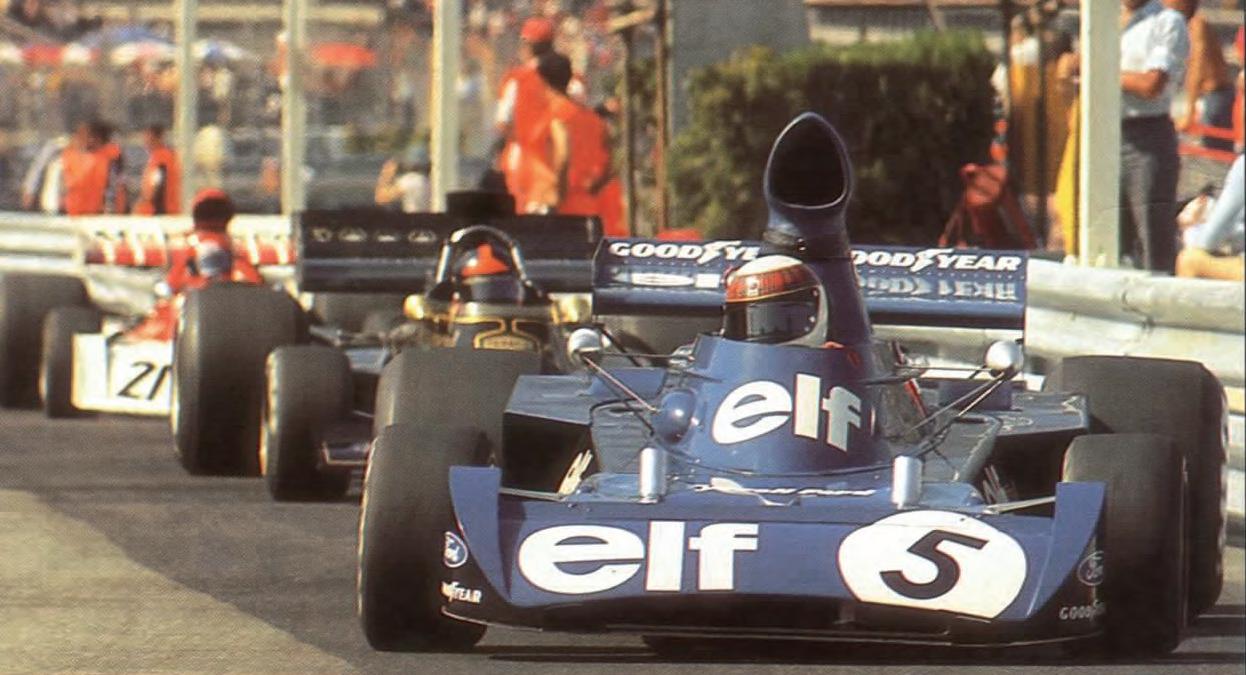
35 14e GRAND PRIX DE MONACO HISTORIQUE 10-12 MAI 2024 3

VERITAS (série C)

Monaco : 1952.
Les Veritas, tout comme les AFM, font partie des premières voitures de course allemandes d’après-guerre. Lors de leurs débuts en 1947, les modèles RS (pour Renn-Sport), souvent des BMW 328 recarrossées, n’étaient pas autorisées à participer aux épreuves internationales en raison de l’interdiction imposée aux Allemands. En 1949, quelques monoplaces de F2, baptisées Meteor, ont également été introduites. Malgré une tentative de produire des voitures de série, la société a cessé ses activités en 1953. Entre 1947 et 1953, moins de 60 voitures ont été produites, tous modèles confondus. En 1952, Jean Heurtaux a mené sa RS à la 15e place du Prix de Monte-Carlo.
Veritas, just like AFMs, were among the first post-war German racing cars. At the time of their debut in 1947, RS models (for RennSport), often re-bodied BMW 328s, were not allowed to take part in international events due to the ban imposed on Germans. In 1949, a few F2 single-seaters called Meteor were also introduced. Despite an attempt to build production cars, the company ceased operations in 1953. Between 1947 and 1953, fewer than 60 cars were produced, all models combined. In 1952, Jean Heurtaux drove his RS to 15th place in the Prix de Monte-Carlo.
WILLIAMS

(séries E, F et G)

Monaco : 1973, 1974, 1975, 1976, 1978, 1979, 1980, 1981, 1982, 1983, 1984, 1985, 1986, 1987, 1988, 1989, 1990, 1991, 1992, 1994, 1995, 1996, 1997, 1998, 1999, 2000, 2001, 2002, 2003, 2004, 2005, 2006, 2007, 2008, 20909.
Présent en F1 depuis 1969 en tant que concurrent, Frank Williams a dû beaucoup composer et, pour assurer la survie de sa petite structure, la mettre souvent au service de constructeurs occasionnels en F1. Les Politoys de 1972 et Iso de 1973 sont les premiers modèles qui, une fois rebaptisés, ont porté la marque Williams. C’est avec la FW06, sortie en 1978 grâce à l’apport de Saudia Airlines, qu’il devient véritablement constructeur à part entière. À partir de l’année suivante, marquée par la sortie de la FW07, Williams va connaître enfin le succès et devenir l’une des équipes majeures du Championnat du Monde de F1 dans lequel elle est encore présente aujourd’hui. Sept pilotes ont obtenu le titre suprême sur une Williams : Alan Jones en 1980, Keke Rosberg en 1982, Nelson Piquet en 1987, Nigel Mansell en 1992, Alain Prost en 1993, Damon Hill en 1996 et Jacques Villeneuve en 1997. Les Williams se sont imposées trois fois dans les rues de la Principauté abvec en 1980 Carlos Reutmann sur FW07, en 1983 Keke Rosberg sur FW08 (photo) et en 2003 Juan Pablo Montoya sur FW25.
Present in F1 since 1969 as a competitor, Frank Williams had to deal with a lot of problems and, to ensure its survival, he often put its structure at the service of occasional F1 constructors. The Politoys of 1972 and the Iso of 1973 were the first models which, once renamed, carried the Williams name. It was with the FW06, released in 1978 thanks to the contribution of Saudia Airlines, that he truly became a manufacturer in his own right. From the following year, marked by the release of the FW07, Williams finally enjoyed success and became one of the top teams in the F1 World Championship, in which it is still present today. Seven drivers have won a world crown in a Williams: Alan Jones in 1980, Keke Rosberg in 1982, Nelson Piquet in 1987, Nigel Mansell in 1992, Alain Prost in 1993, Damon Hill in 1996, Jacques Villeneuve in 1997. Williams have won three times on the streets of the Principality, with Carlos Reutemann on the FW07 in 1980, Keke Rosberg on the FW08 in 1983 (photo) and Juan Pablo Montoya on the FW25 in 2003.
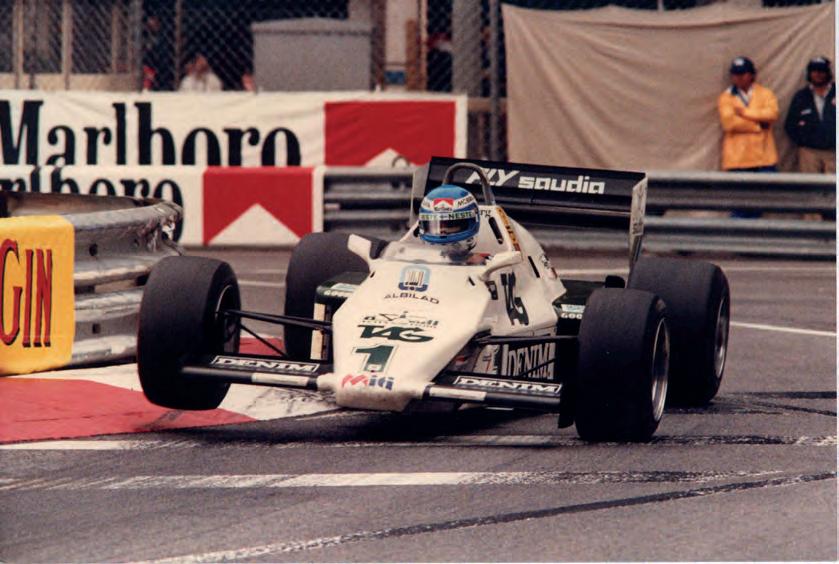
36 3


WOLF (série F)

Monaco : 1977, 1978, 1979.
D’abord sponsor de Frank Williams en 1976 avec les anciennes Hesketh 308C rebaptisées Williams FW05, le Canadien Walter Wolf lance en 1977 sa propre écurie. Confiée à Jody Scheckter, la voiture remporte son tout premier Grand Prix en Argentine, puis le Grand Prix de Monaco et celui du Canada. Après cette saison de rêve, l’écurie Wolf se convertit comme les autres à l’effet de sol mais n’arrive pas à produire une bonne F1 et disparaît fin 1979, en vendant ses monoplaces à la nouvelle écurie des frères Fittipaldi.
Starting in F1 as a sponsor for Frank Williams in 1976, with the former Hesketh 308C renamed Williams FW05, Canadian Walter Wolf then launched his own team in 1977. Entrusted to Jody Scheckter, the car won its very first Grand Prix in Argentina, before succeeding again in Monaco and at the Canadian Grand Prix. After this dream start, the team logically converted to the ground effect but was not able to produce a good car again and disappeared at the end of 1979, selling its single-seaters to a new team created by the Fittipaldi brothers.
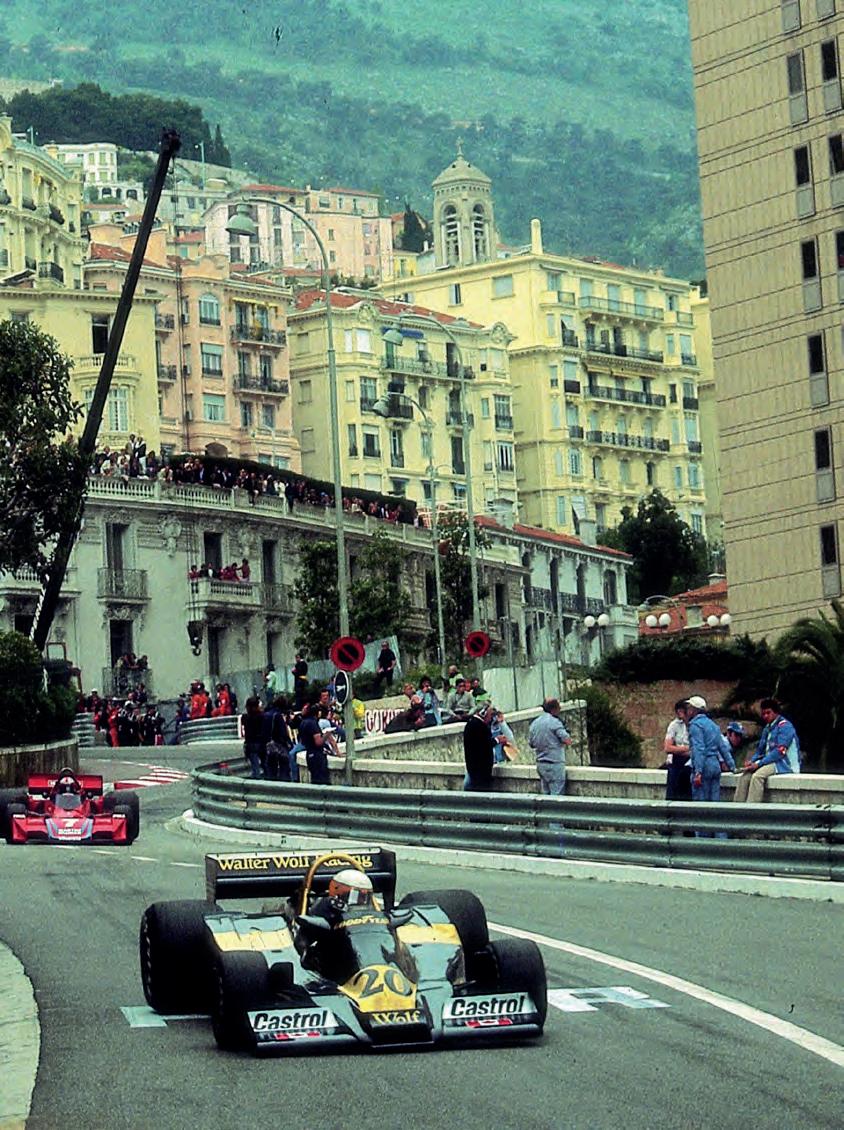
37 14e GRAND PRIX DE MONACO HISTORIQUE 10-12 MAI 2024 1
Louis CHIRON

VOITURES DE GRAND PRIX D’AVANT-GUERRE ET VOITURETTES
PRE-WAR GRAND PRIX CARS AND VOITURETTES
REGLEMENT (Extrait, Article 4) / RULE BOOK (Extract, Article 4)
Le 14 e Grand Prix de Monaco Historique est ouvert aux voitures définies par l’annexe K du Code Sportif International de la F.I.A. / The 14th Grand Prix de Monaco Historique is open to cars defined by Appendix K of the FIA International Sporting Code.
Les voitures sont admises en 2 classes / The cars are admitted in 2 classes:
Classe 1 : Voiture de Grand Prix (cylindrée supérieure à 1500 cm3) / Grand Prix Cars (over 1500cc)
Classe 2 : Voiturettes (cylindrée inférieure à 1500 cm3) / Voiturettes (below 1500cc)
Après l’ère de la Formule Internationale des années 19261927, limitée à 1,5 litre de cylindrée, les courses de vitesse sont le plus souvent disputées sous la formule libre permettant à un plus grand nombre de voitures de participer. C’est notamment le cas des premiers Grands Prix de Monaco, disputés entre 1929 et 1933.
A partir de 1934, la Fédération Internationale fixe un nouveau cadre pour les voitures de Grand Prix. Un conflit international étant attendu au plus haut niveau, le Reich allemand décide de se servir des Grands Prix pour sa propagande. Les autres firmes dominatrices jusque-là, comme Bugatti et Alfa Romeo, sont rapidement privées de victoires par Auto Union et Mercedes.
Pour survivre dans le monde des courses de vitesse, il ne reste alors plus que les courses de petites cylindrées, baptisées Voiturettes, qui vont se développer en parallèle et offrir souvent le spectacle de courses ouvertes qui manque aux Grand Prix. La naissance des ERA, le développement de Maserati et la naissance de l’Alfa Romeo 158 (future Championne du Monde en 1950 et 1951) résultent du dynamisme de la catégorie.
Cette Série A1 sert d’évocation aux Grand Prix de Monaco de l’avant-guerre (Classe 1) ainsi que de la Coupe du Prince Rainier, ouverte en 1936 aux seules Voiturettes (Classe 2).
After the Formula Internationale era of 1926-1927, which was limited to 1.5L engines, speed races were more often run under the Free Formula, allowing a greater number of cars to take part. This was particularly true of the first editions of Monaco Grand Prix, held between 1929 and 1933.
From 1934 onwards, the Fédération Internationale set a new framework for Grand Prix racing. With an expected international conflict at the highest level, the Reich decided to use it as a propaganda tool. Other firms, dominant until then, such as Bugatti and Alfa Romeo, were soon deprived of victories by Auto Union and Mercedes. To survive in the world of speed racing, there was nothing left but small-capacity racecars, known as Voiturettes, which developed in parallel and often offered the open-air spectacle that Grand Prix racing lacked. The birth of the ERAs, the development of Maserati and the birth of the Alfa Romeo 158 (future World Champion in 1950 and 1951) were the result of the category’s dynamism.
This A1 Series serves as a reminder of pre-war Monaco Grand Prix (Class 1) and of the 1936 Prince Rainier Cup, open only to Voiturettes (Class 2).
38
SÉRIE RACE 1931
A1
LISTE DES ENGAGÉS I ENTRY LIST
VAINQUEURS DU GRAND PRIX DE MONACO I
1929 : William Grover-Williams / Bugatti 35B
1930 : René Dreyfus / Bugatti 35B
1931 : Louis Chiron / Bugatti 51
1932 : Tazio Nuvolari / Alfa Roméo 8C 2300
1933 : Achille Varzi / Bugatti 51
1934 : Guy Moll / Alfa Roméo P3
1935 : Luigi Fagioli / Mercedes W25
1936 : Rudolf Carracciola / Mercedes W25
1937 : Manfred Von Brauchitsch / Mercedes W125
1936 1 re Coupe du Prince Rainier : Prince Bira / ERA type B

victorieuse d’un ou plusieurs Grand Prix du Championnat du Monde
présente en période au Grand Prix de Monaco
39 14e GRAND PRIX DE MONACO HISTORIQUE 10-12 MAI 2024 N° PILOTE / DRIVER NAT CONCURRENT VOITURE / CAR MODÈLE ANNÉE CL. 2 EMMERLING Ralf FRA EMMERLING Ralf RILEY BROOKLANDS 1928 2 4 GILLETT John AUS GILLETT John MG K3 MAGNETTE 1934 2 6 FOUQUET-HATEVILAIN Francois FRA FOUQUET-HATEVILAIN Francois BUGATTI 35 1925 1 8 DE BALDANZA Julia GBR DE BALDANZA Julia BUGATTI 35B 1928 1 10 HALUSA Martin AUT HALUSA Martin BUGATTI 35B 1927 1 12 BAILEY Jonathan GBR BAILEY Jonathan BUGATTI 35C 1927 1 14 PIANTELLI Maurizio ITA PIANTELLI Maurizio BUGATTI 37A 1927 2 16 ROSINA Stefano ITA ROSINA Stefano BUGATTI 37/44 1927 1 18 STAPTS Thierry FRA STAPTS Thierry BUGATTI 35 1926 1 28 BURKARD Fritz CHE BURKARD Fritz ALFA-ROMEO 8C MONZA 1933 1 52 BLAKENEY-EDWARDS Patrick GBR BLAKENEY-EDWARDS Patrick FRAZER-NASHMONOPLACE 1935 2 54 DOWLING Paddins IRL DOWLING Paddins ERA R5B 1936 1 56 BAKER Brad CAN BAKER Brad ERA R10B 1936 2 58 CHANOINE Thierry FRA CHANOINE Thierry RILEY DOBBS 1935 1 70 BIRCH Michael GBR BIRCH Michael MASERATI 4CM 1935 2 72 WINTER "Mark" DEU WINTER "Mark" MASERATI 6CM 1936 2
1 Voiture
Voiture
MONACO
GRAND PRIX WINNERS
ALFA-ROMEO
L’Alfa 8C dans ses diverses configurations a tout gagné : les Mille Miglia (en 1932 et 1933 avec Nuvolari ; en 1934 avec Varzi), la Targa Florio (1931 et 1932, Nuvolari ; 1933, Brivio), Les 24 Heures du Mans (1931, Lord Howe/Birkin ; 1932, Sommer/Chinetti ; 1933, Sommer/ Nuvolari ; 1934 Etancelin/Chinetti), les 24 Heures de Spa (1932 Brivio/Siena ; 1933 Chiron/Chinetti) et enfin des Grand Prix de Vitesse. A Monaco, les 8C Monza ont été présentes de 1932 à 1933 avec un doublé Nuvolari/Caracciola en 1932, et une 2e place de Borzacchini en 1933 après l’abandon dans le dernier tour de Nuvolari alors en tête.
Production : près de 190 exemplaires, dont un peu plus de 40 Monza (la version spécialisée Grand Prix)
The Alfa 8C in its various configurations won everything: the Mille Miglia (in 1932 and 1933 with Nuvolari; in 1934 with Varzi), the Targa Florio (1931 and 1932, Nuvolari; 1933, Brivio), the 24 Hours of Le Mans (1931, Lord Howe/Birkin; 1932, Sommer/Chinetti; 1933, Sommer/Nuvolari; 1934 Etancelin/Chinetti). The 24 Hours of Spa (1932, Brivio/Siena; 1933, Chiron/Chinetti) and various Grands Prix de Vitesse. The 8C Monza was present at Monaco from 1932 to 1933, with a Nuvolari/Caracciola one-two in 1932 and 2nd place for Borzacchini in 1933, after Nuvolari, who was leading, retired on the last lap.
Production: almost 190 cars, including just over 40 Monza cars (the specialised Grand Prix version).

BUGATTI
François FOUQUET-HATEVILAIN
Cette Bugatti 35 est du même type que celle qui a fini 6e du tout premier Grand Prix de Monaco aux mains de Philippe Etancelin. Elle a débuté en Espagne, pilotée par Ferdinand de Vizcaya.
This Bugatti 35 is of the same type as the one that finished 6th of the very first Grand Prix de Monaco in the hands of Philippe Etancelin. It made its debut in Spain with Ferdinand de Vizcaya.
Fritz BURKHARD
Cette Alfa Romeo 8C a été produite début 1933 pour la Scuderia Ferrari, directement dotée d’un moteur 2,6L, et a participé au Grand Prix de Monaco la même année : Tazio Nuvolari était en tête jusqu’au dernier tour, quand il a dû abandonner. Après les Mille Miglia en 1934, elle est passée aux mains de Vittorio Belmondo puis a poursuivi sa carrière en Afrique du Sud à partir de 1936.
This car, produced at the beginning of 1933 for Scuderia Ferrari and powered directly by a 2.6-litre engine, took part in the Monaco Grand Prix that same year: Tazio Nuvolari lead until the last lap, when he had to retire. After the 1934 edition of Mille Miglia, it passed into the hands of Vittorio Belmondo and then continued its career in South Africa from 1936 onwards.
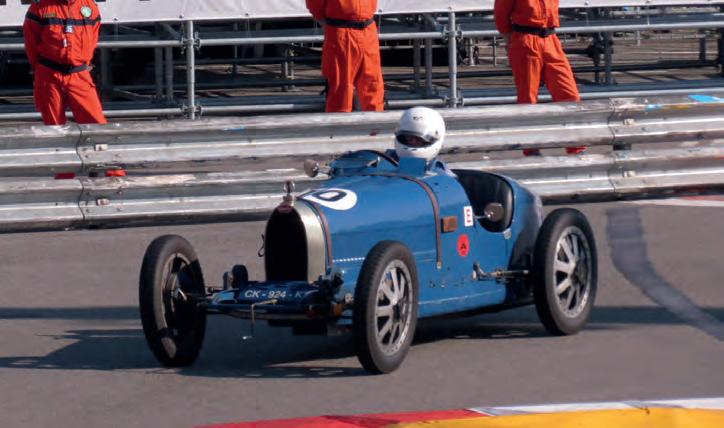
A1 28 6
40
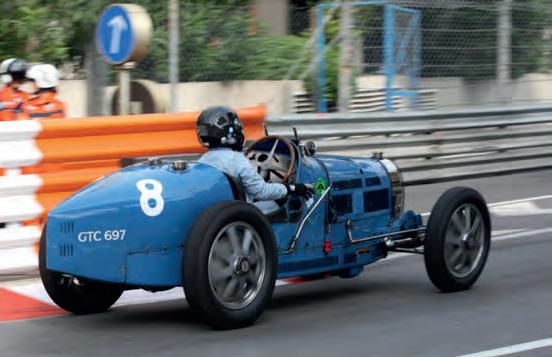
Martin HALUSA
Cette Bugatti 35C (moteur porté 2,3L type 35B) est du même type que celle qui s’est classée 4e à Monaco en 1929 avec Philippe de Rotschild, puis 2e et 3e en 1930 aux mains de Louis Chiron et Guy Bouriat. Dans le cadre de l’écurie officielle, elle a remporté le Grand Prix de San Sebastian en 1927, aux mains d’Emilio Materassi.
This Bugatti 35C (2,3L engine type 35B) is of the type that ranked 4th in Monaco in 1929 with Philippe de Rotschild, then 2nd and 3rd in 1930 in the hands of Louis Chiron and Guy Bouriat. As part of the works team, it won the San Sebastian GP in 1927, in the hands of Emilio Materassi.
Julia DE BALDANZA
Cette Bugatti 35B est le modèle qui a ouvert le palmarès du Grand Prix de Monaco avec « Williams » en 1929, puis René Dreyfus en 1930. Sortie en 1929, elle est restée la propriété de l’usine jusqu’en 1938. Puis, comme beaucoup d’autres, elle a rejoint l’Angleterre où elle a connu une très longue carrière.
This Bugatti 35B is the model that opened the Monaco Grand Prix record books with «Williams» at the wheel in 1929, and René Dreyfus in 1930. Released in 1929, the year of the first Monaco Grand Prix, it remained the property of the factory until 1938. Then, like many others, it moved to England, where it enjoyed a very long career.

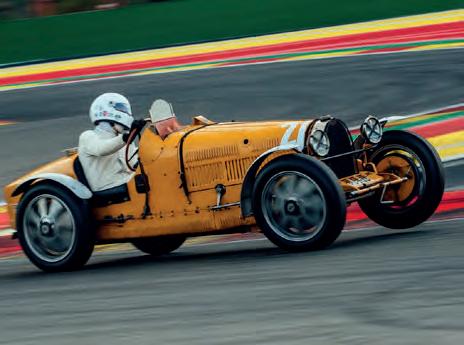
Maurizio PIANTELLI
Ce modèle 37A est du type de celle qui a terminé 5e à Monaco en 1929 pilotée par René Dreyfus. Livrée neuve en Angleterre en 1927, elle a été successivement la propriété de Malcolm Campbell (un temps recordman de vitesse sur terre), qui l’a conduite à la victoire dans le Grand Prix de Boulogne, puis de Dudley Benjafield et Brian Lewis, notamment.
This car is of the same type that finished 5th in Monaco in 1929, driven by René Dreyfus. Delivered new in England in 1927, it successively belonged to Malcom Campbell (once a land speed record holder) who drove it to victory at Grand Prix de Boulogne, and then, most notably, Dudley Benjafield, and Brian Lewis.
MAI 2024 10 14 12
Jonathan BAILEY
Livrée neuve en 1927 à Elisabeth Junek, cette Bugatti se présente en configuration 35C, c’est un modèle 2 litres présent au départ des trois premiers Grands Prix de Monaco (2e en 1929-Bouriano et 1930-Chironpuis 6e en 1931-Studer). Avec Ottakar Bitman, son propriétaire suivant, elle participa au Grand Prix d’Allemagne 1929 et à la Targa Florio en 1930, dotée d’un moteur 35B de 2,3L.
Delivered new in 1927 to Elisabeth Junek, this Bugatti is presented in a 35C configuration. It is a 2-liter model present at the start of the first three Monaco Grands Prix (2nd in 1929-Bouriano and 1930-Chiron; then 6th in 1931-Studer). With Ottakar Bitman, its next owner, it took part in the 1929 German Grand Prix and the 1930 Targa Florio with a 2.3-liter 35B engine.
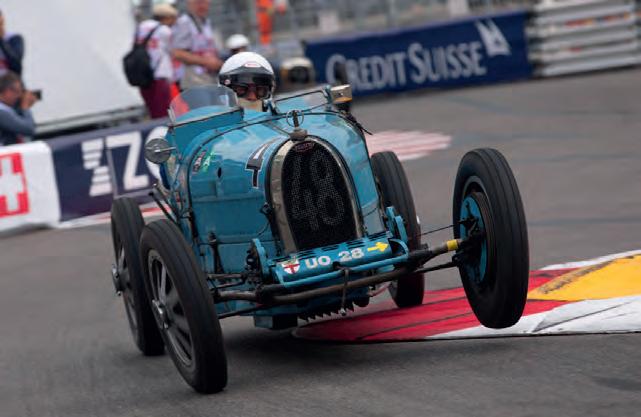
41 14e GRAND PRIX DE MONACO HISTORIQUE
10-12
8
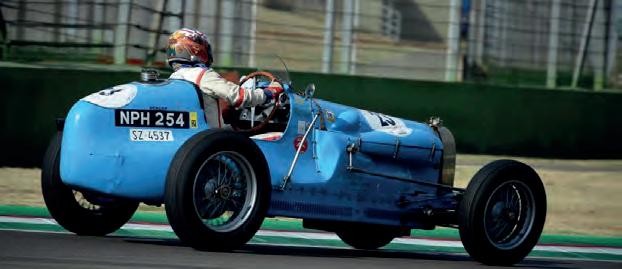 Stefano ROSINA
Stefano ROSINA
Après la casse irréversible de son moteur 4 cylindres 1500 en 1934, cette Bugatti 37 de 1927 a subi en 1935 une transformation radicale consistant, entre autres, à l’équiper d’un moteur 8 cylindres 3L de type 44 de Tourisme et à le déplacer au centre de son poste de pilotage, en adoptant une nouvelle carrosserie monoplace. Initialement destinée aux courses de vitesse à Brooklands, elle reprit du service après-guerre dans les courses de côte anglaises, avant de participer régulièrement aux courses du VSCC au début des années 60.
After the irreversible failure of its 4-cylinder 1500 engine in 1934, this 1927 Bugatti 37 underwent a radical transformation in 1935, including the fitting of an 8-cylinder 3L Type 44 Touring engine and a shift to the center of its cockpit, necessitating a new single-seater body. Initially intended for speed racing at Brooklands, it returned to action in post-war British hill-climb racing, before taking part regularly in VSCC races in the early 1960s. 16
Eric STAPS
Cette Bugatti 35 a été active en course de 1928 à 1930 (aux mains de Robert Gauthier) et jusqu’à 1947 (pilotée par Landrin lors des Coupes de l’AGACI à Montlhéry).
This Bugatti 35 was active in racing from 1928 to 1930 (in the hands of Robert Gauthier) and until 1947 (driven by Landrin in the AGACI Cups at Montlhéry).
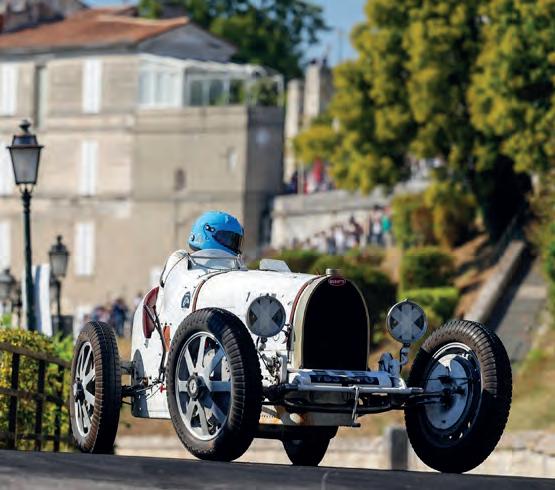
Paddins DOWLING
Le Prince Bira avait reçu l’ERA R2B pour son anniversaire en 1935. Il a aussi reçu en complément cette voiture, présentée au début de l’année suivante. Pendant la saison 1936, il a utilisé tantôt l’une (1er de la Coupe du Prince Rainier en avril), tantôt l’autre (1er à Albi en juillet). En 1938 et 1939, c’est aux mains de Tony Rolt (futur vainqueur des 24 Heures du Mans en 1953) qu’elle a poursuivi sa carrière.
Prince Bira had received the ERA R2B for his birthday in 1935. He also received this car, launched at the start of the following year. During the 1936 season, he sometimes used one (winning the Prince Rainier Cup in April) and sometimes the other (winning at Albi in July). In 1938 and 1939, it continued its career in the hands of Tony Rolt (future winner of Le Mans 24 Hours in 1953).
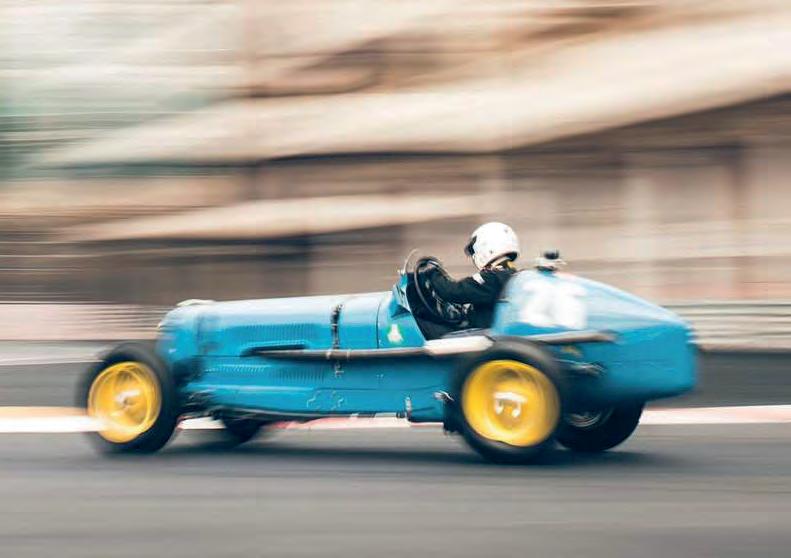
 Brad BAKER
Brad BAKER
Cette voiture a été livrée à Peter Whitehead en 1936 (engagé à Monaco en 1950 sur Ferrari). Il la partagea avec Peter Walker et son demi-frère Graham jusqu’en 1952. Elle est partie un temps aux Etats-Unis où elle a été achetée en 1980 par Nick Mason, le batteur des Pink Floyd, qui l’a gardée près de 25 ans.
The car on display was delivered in 1936 to Peter Whitehead (who raced a Ferrari in Monaco in 1950). He shared it with Peter Walker and his halfbrother Graham until 1952. It spent some time in the United States where, in 1980, it was bought by Nick Mason, Pink Floyd’s drummer, who then kept it for almost 25 years.
ERA A1 56 54 42
18
FRAZER NASH MONOPLACE
La firme Frazer Nash, qui a été active de 1924 à 1958, s’était fait une spécialité des biplaces de course. Elle a aussi produit, sur demande, six monoplaces, trois avant la guerre et trois après. Pour les trois premières, l’idée était venue à des clients poussés par le développement des Voiturettes 1500.
Production : 3 monoplaces produites entre 1934 et 1936.
The Frazer Nash firm, which was active from 1924 to 1958, was specialized in making two-seater race cars. The firm also produced, on demand, six single-seaters only: three pre-war, three post-war. For the first three, the idea came to customers enticed by the development of Voiturettes 1500.
Production: 3 single-seaters produced between 1934 and 1936.
Patrick BLAKENEY-EDWARDS
Cette voiture, achevée pour Adrian Thorpe en 1935, a été pilotée le plus souvent à partir de 1936, et jusqu’à 1939, par Alfred Fane pour le compte du constructeur dans les grandes épreuves de Brooklands entre autres.
This car, built for Adrian Thorpe in 1935, was driven most often, from 1936 until 1939, by Alfred Fane on behalf of the manufacturer in major events at Brooklands among others.

MASERATI
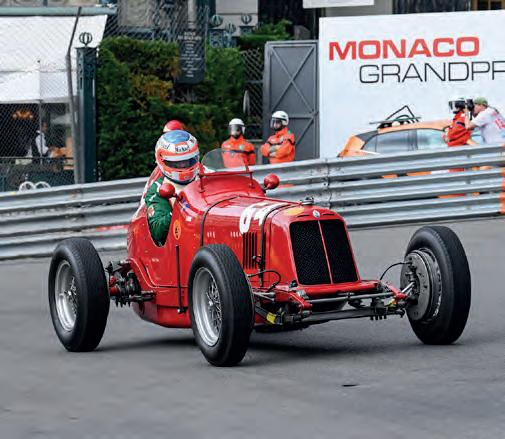
Michael BIRCH
Cette monoplace à moteur 4-cylindres aurait été utilisée par l’usine Maserati en 1936, notamment lors de la Coupe du Prince Rainier. Elle a ensuite été pilotée par une série de pilotes italiens, au moins jusqu’en 1940, dans nombre de courses ouvertes aux Voiturettes.
This 4-cylinder single seater was apparently used by the Maserati factory in 1936, notably at the Prince Rainier Cup. It was then used by a series of Italian drivers, at least until 1940, in many races open to Voiturettes.

Cette Maserati 6CM, exposée en 1936 au Salon de Milan, a été pilotée en 1937 et 1938 par Peter Aitken, puis par Louis Gérard au début de l’année 1939. En 1945, elle a remporté la Coupe de la Libération lors du premier meeting d’après-guerre organisé au Bois de Boulogne. Toujours aux mains d’Henri Louveau, elle a participé en 1946 aux Grands Prix de Nice et de Marseille.
This Maserati 6CM, exhibited in 1936 at the Milan Motor Show, was driven in 1937 and 1938 by Peter Aitken, and then by Louis Gerard in early 1939. In 1945, it won the Coupe de la Libération at the first post-war meeting organized in Bois de Boulogne. Still in the hands of Henri Louveau, it took part in the Nice and Marseille Grands Prix in 1946.
Mark WINTER
43 14e GRAND PRIX DE MONACO HISTORIQUE 10-12 MAI 2024
70 72 52
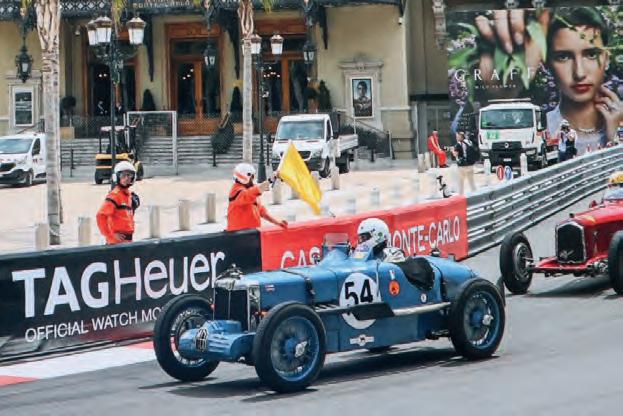
4
RILEY
Ralph EMMERLING
Cette Riley Brooklands de 1929, l’une des premières produites, était engagée pour Peter Antill lors du Grand Prix d’Australie 1930, dominé par la Bugatti 37A de Bill Thompson qui termina avec 19 minutes d’avance sur la 37 de Harold DrakeRichmond, après plus de 3 heures de course.
This 1929 Riley Brooklands, one of the first produced, was entered for Peter Antill in the 1930 Australian Grand Prix, dominated by Bill Thompson’s Bugatti 37A who finished 19 minutes ahead of Harold Drake-Richmond’s 37 after over 3 hours of racing.
John GILLETT
Cette MG K3, l’avant-dernière produite, a été utilisée neuve en 1935 par « Prince Bira » juste avant qu’il ne prenne possession de l’ERA R2B. La MG K3 de ses débuts ira finir sa carrière en Australie. En 1953, elle terminera 3e du Grand Prix d’Australie qu’elle disputera encore en 1955.
This MG K3, the one but last ever produced, was used new in 1935 by «Prince Bira» just before he took possession of the ERA R2B. The MG K3 of his debut then finished its career in Australia. In 1953, it took 3rd place in the Australian Grand Prix and contested it again in 1955.
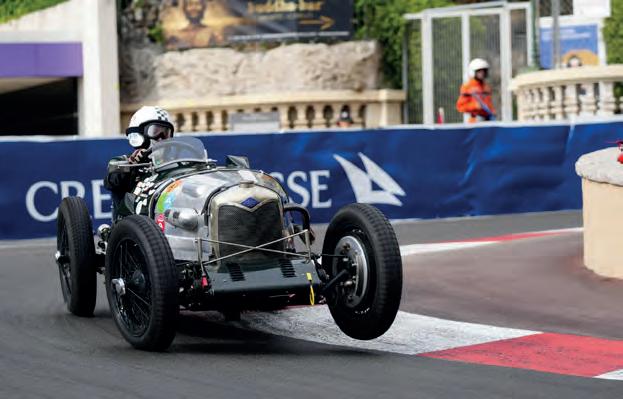
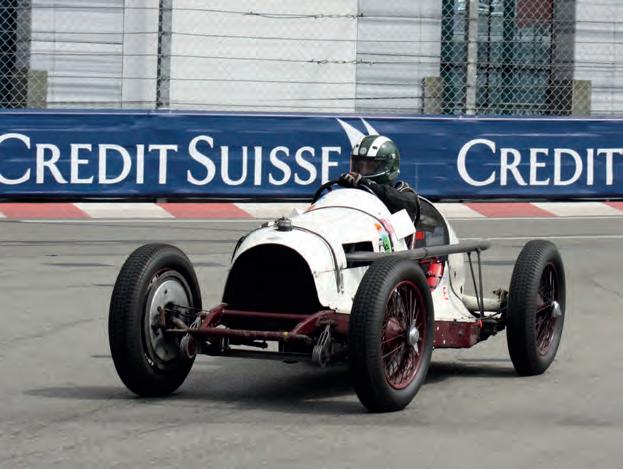
Thierry CHANOINE
Ce deuxième modèle spécial a été réalisé par Hector Dobbs, un fidèle de la marque dont il faisait commerce. A son volant, Dobbs a rencontré un certain succès à Brooklands et Donington. En 1946, Roy Salvadori (qui deviendra plus tard résident monégasque), l’a utilisée lors de quelques courses, préparée par la célèbre firme Monaco Motors basée à Watford !
This is a second special model designed by Hector Dobbs, a Riley faithful who was also dealing cars of the British brand. Behind the wheel, Dobbs had some success in Brooklands and Donington. In 1946, Roy Salvadori (who later became a Monaco resident) used it in several races, prepared by a famous Watford-based firm, Monaco Motors!
MG A1 44
58
2
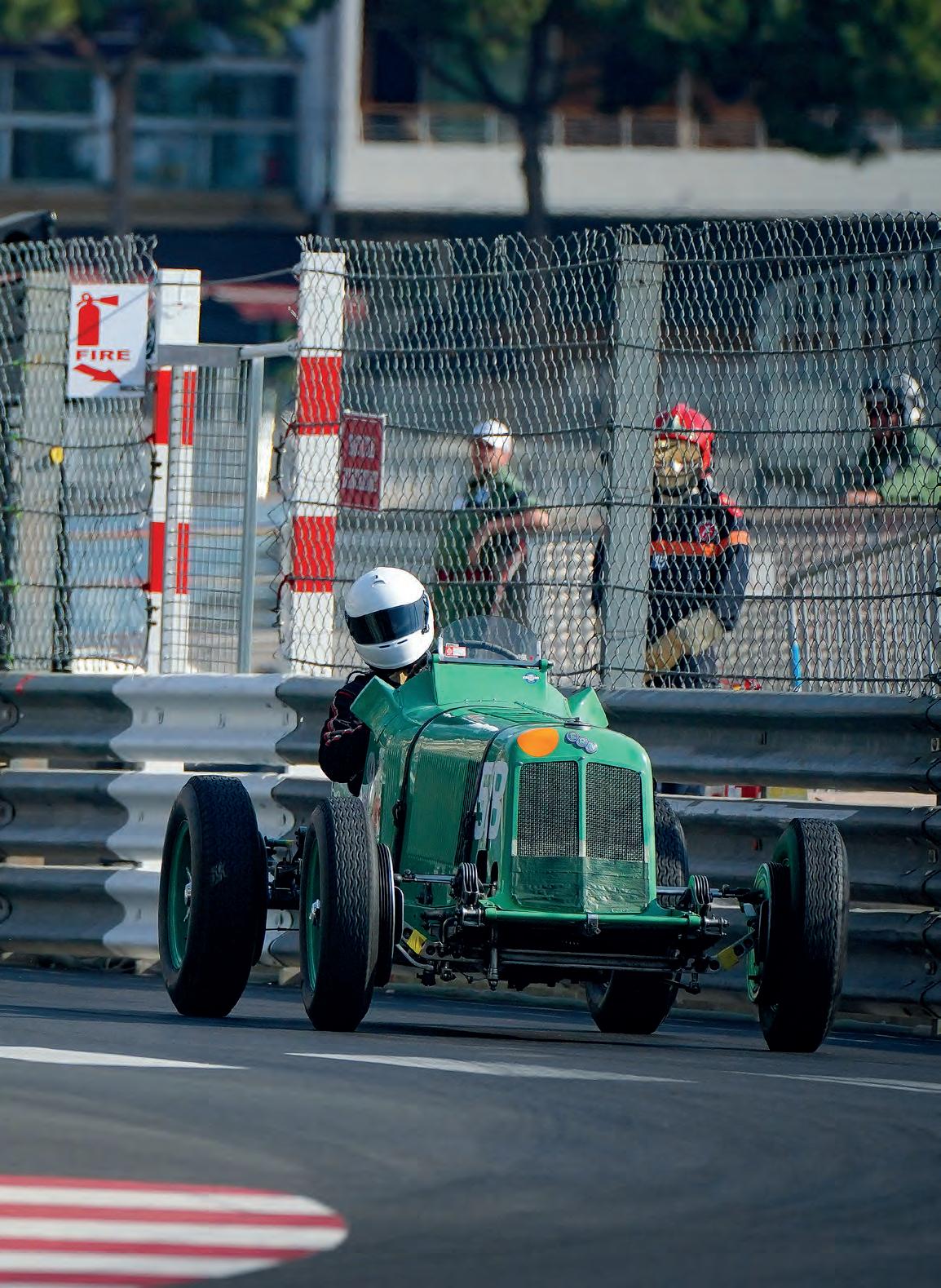
45 14e GRAND PRIX DE MONACO HISTORIQUE 10-12 MAI 2024 A1
JUAN MANUEL FANGIO

1950 - 1957
VOITURES DE GRAND PRIX À MOTEUR AVANT ET
CONSTRUITES AVANT 1961 / GRAND PRIX CARS WITH FRONT ENGINE AND BUILT BEFORE 1961 REGLEMENT (Extrait, Article 4) / RULE BOOK (Extract, Article 4)
Le 14 e Grand Prix de Monaco Historique est ouvert aux voitures définies par l’annexe K du Code Sportif International de la F.I.A. / The 14th Grand Prix de Monaco Historique is open to cars defined by Appendix K of the FIA International Sporting Code.
Les voitures sont admises en 4 classes / The cars are admitted in 4 classes:
Classe 1 : Voitures construites entre le 1er janvier 1946 et le 31 décembre 1953 équipées d’un moteur à compresseur de 1500cc maximum ou d’un moteur sans compresseur de 4500cc maximum / Cars built between January 1, 1946 and December 31, 1953 fitted with a supercharged engine of maximum capacity 1500cc or with non-supercharged engine of maximum capacity 4500cc.
Classe 2 : Voitures de Formule 2 construites avant le 31 décembre 1953, dont la cylindrée n’excède pas 2000 cm3 sans compresseur / Formula 2 cars built before December 31st 1953, with non-supercharged engine and a maximum engine capacity of 2000cc.
Classe 3 : Voitures de Formule 1 construites entre le 1er janvier 1954 et le 31 décembre 1960, dont la cylindrée n’excède pas 2500 cm3 sans compresseur 750 cm3 avec compresseur / Formula 1 cars built between January 1, 1954 and December 31, 1960 with non-supercharged engines of a maximum capacity 2500cc, or supercharged engines of maximum capacity 750cc.
Classe 4 : Voitures hors classe 1-2-3 construites entre 1950 et 1955 et ayant un rapport historique avec celles engagées en Championnat du Monde F1 entre 1950 et 1960 / Out-of-class 1-2-3 cars built between 1950 et 1960 and having a historical connection with those entered in the World Driver’s Championship.
Cette série est l’évocation des Grand Prix de Monaco disputés par les monoplaces entre 1948 et 1960. Cette période est marquée d’abord par la domination des monoplaces à moteur avant, en situation de quasi-monopole, puis par l’arrivée en 1957 des premières voitures à moteur arrière. Celles-ci allaient s’imposer à partir de 1958, avec les retentissantes victoires de Stirling Moss en Argentine et de Maurice Trintignant à Monaco.
Les F1 de cette période ont connu deux réglementations de cylindrée. De 1947 à 1953, la limite de cylindrée était de 4500cc pour les voitures sans compresseur et de 1500cc pour celles qui en étaient dotées (classe 3 du Grand Prix Historique) puis de 1954 à 1960 la règlementation limitait les moteurs aspirés à 2500cc, et les moteurs suralimentés à 750cc (classe 5 du Grand Prix Historique).
Durant la même période les F2 ont connu aussi deux réglementations :
- 2L sans compresseur p our les années 1952-1953, où les autos disputaient le Championnat du Monde des conducteurs (classe 4 du Grand Prix Historique).
- 1,5L sans compresseur pour celles produites entre 1957 et 1960.
This series is the evocation of the Monaco Grand Prix contested by single-seaters between 1948 and 1960.
This period is distinguished first by the domination of front engine single-seaters, then by the arrival, in 1957, of the first rear engine cars. These would take over starting 1958, with the momentous victories of Stirling Moss in Argentina and Maurice Trintignant in Monaco.
The F1 cars of this period were subjected to two engine size regulations.From 1947 to 1953, the engine size limit was of 4500cc for cars without compressors, and 1500cc for those with (class 3 of Grand Prix Historique); then from 1954 to 1960, regulations limited aspirated engines to 2500cc, and super-charged engines to 750cc (class 5 of Grand Prix Historique);
During the same period, F2 was also subjected to two sets of engine size regulations:
- 2L without compressor for 1952-1953 when the cars competed in the World Championship of drivers (class 4 of the Grand Prix Historique).
- 1.5L without compressor for cars driven between 1957 and 1960.
46
SÉRIE RACE
A2
LISTE DES ENGAGÉS I ENTRY LIST

Voiture victorieuse d’un ou plusieurs Grand Prix du Championnat du Monde
Voiture présente en période au Grand Prix de Monaco
VAINQUEURS DU GRAND PRIX DE MONACO I MONACO GRAND PRIX WINNERS
1948 : Giuseppe Farina / Maserati 4CLT
1950 : Juan-Manuel Fangio / Alfa Roméo 158
1955 : Maurice Trintignant / Ferrari 625A
1956 : Stirling Moss / Maserati 250F
1957 : Juan Manuel Fangio / Maserati 250F
1958 : Maurice Trintignant / Cooper 45
1959 : Jack Brabham / Cooper 51
1960 : Stirling Moss / Lotus 18
47 14e GRAND PRIX DE MONACO HISTORIQUE 10-12 MAI 2024 N° PILOTE / DRIVER NAT CONCURRENT VOITURE / CAR MODÈLE ANNÉE CL. 2 DI RISIO Massimo ITA DI RISIO Massimo OSCA MT4 1949 2 4 WOOD Niamh GBR WOOD Niamh COOPER-BRISTOL T20 (MK1) 1952 2 6 PLANTE Guy GBR PLANTE Guy COOPER-BRISTOL T23 (MK2) 1953 2 8 GRANT Paul BEL GRANT Paul COOPER-BRISTOL T23 (MK2) 1953 2 12 BIRCH Michael GBR BIRCH Michael CONNAUGHT B2 1955 3 14 DE BALDANZA Julia GBR DE BALDANZA Julia MASERATI A6GCM 1952 2 16 LEROY Eric FRA LEROY Eric GORDINI T11/15 1946 2 18 BALLY Jean-Jacques FRA BALLY Jean-Jacques GORDINI T11/15 1947 2 20 HUERTGEN Claudia DEU METHUSALEM RACING FERRARI 246 (DINO) 1960 3 24 BERGEL SAINZ DE BARANBA Jaime ESP DRIVEX MASERATI 4CLT/48 1949 1 26 BIGIONI Denis CAN BIGIONI Denis TALBOT-LAGO T26C 1948 1 28 DUMOLIN Christian BEL DUMOLIN Christian MASERATI 250F 1954 3 30 FIERRO-ELETA Guillermo ESP FIERRO-ELETA Guillermo MASERATI 250F 1954 3 32 FRANCHITTI Marino GBR FRANCHITTI Marino MASERATI 250F 1957 3 34 SPIERS John GBR SPIERS John MASERATI 250 F 1955 3 36 ENGELHORN Kurt GBR ENGELHORN Kurt MASERATI 250F 1955 3 40 FOLCH-RUSIÑOL CORACHÁN JoaquinESP CLASSIC TEAM LOTUS LTD LOTUS 16 1958 3 42 BAILEY Marshall GBR BAILEY Marshall LOTUS 16 1959 3 44 SMITH-HILLIARD Max GBR SMITH-HILLIARD Max LOTUS 16 1958 3 46 SERGISON Ewen GBR SERGISON Ewen LOTUS 16 1959 3 48 SHAW Mark GBR SHAW Mark SCARAB F1 1960 3 50 O'NEILL Jeffrey USA O'NEILL Jeffrey MASERATI 250F 1957 3 56BAKER Brad CAN BAKER Brad MASERATI 250F 1954 3 58 DE GROODT Stéphane FRA METHUSALEM RACING MASERATI 250F 1958 3 60 WOOD Anthony GBR WOOD Anthony TEC-MEC F415 1959 3 62 SCHLERETH Thomas AUS SCHLERETH Thomas FERGUSON P99 1960 4
1
CONNAUGHT B
Deux Connaught B étaient à Monaco en 1957 ; celle de Stuart Lewis-Evans a terminé 4e tandis qu’Ivor Bueb abandonnait. En 1958, moins rapides, Paul Emery et Bruce Kessler ne se sont pas qualifiés pour la course.
Production : 7 exemplaires produits (une en 1954, trois en 1955 et trois en 1956).
Two Connaught B were in Monaco in 1957; Stuart Lewis-Evans finished 4th while Ivor Bueb retired. In 1958, Paul Emery and Bruce Kessler were not as fast and did not qualify for the race.
Production: 7 cars produced (one in 1954, three in 1955 and three in 1956).
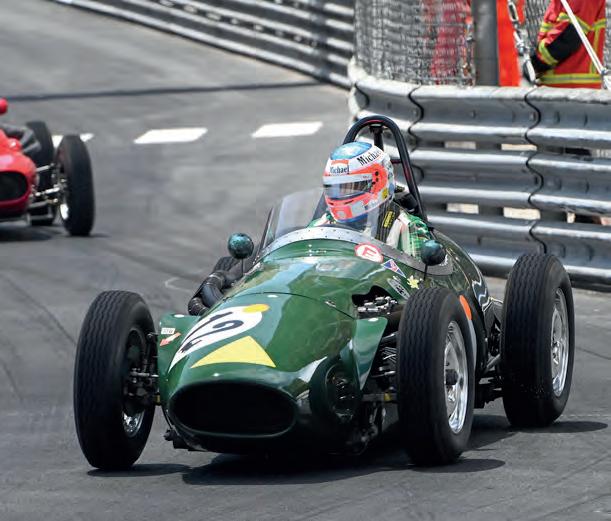
COOPER T20
Michael BIRCH
Cette Connaught B a fait partie de l’équipe officielle de 1955 à 1957, d’abord avec une carrosserie enveloppante, puis à partir de 1956 avec une carrosserie similaire à celle de la voiture de Tony Brooks lors de sa retentissante victoire à Syracuse. Durant ces trois saisons, cette Connaught B a notamment terminé 2e de l’International Trophy avec Archie Scott-Brown au volant, en 1956, puis elle a abandonné à Monaco en 1957 aux mains d’Ivor Bueb, le double vainqueur (1955, 1957) des 24 Heures du Mans sur Jaguar D.
The car presented was part of the official team from 1955 to 1957, first with a wrap-around body and then from 1956 with a similar body to Tony Brooks’s car during his resounding victory at Syracuse. During these three seasons, this Connaught B finished 2nd in the International Trophy with Archie Scott-Brown in 1956 and abandoned in Monaco in 1957 at the hands of Ivor Bueb, the winner in 1955 and 1957of Le Mans 24 Hours in a Jaguar D.
C’est avec ce type de Cooper que Mike Hawthorn, Champion du Monde en 1958, a révélé son talent au niveau international.
Production : 7 exemplaires produits en 1952, plus une auto équipée d’un moteur ERA.
It is with this type of Cooper that Mike Hawthorn, crowned World Champion in 1958, revealed his talent on the international stage.
Production: 7 models made in 1952, plus one equipped with an ERA engine.
Niamh WOOD
Cette Cooper T20 a été livrée neuve à l’Ecurie Ecosse de David Murray qui l’a conduite lors du Grand Prix d’Angleterre 1952 avant de la confier à Ken Wharton lors du Grand Prix d’Italie 1952, à Jimmy Stewart, le frère de Jackie (notamment au Grand Prix d’Angleterre 1953) et à Ninian Sanderson.
Delivered new to Ecurie Ecosse, team owner David Murray drove it at the 1952 British Grand Prix, before entrusting it to Ken Wharton at the 1952 Italian Grand Prix, to Jimmy Stewart, Jackie’ s brother (notably at the 1953 British Grand Prix) and to Ninian Sanderson.
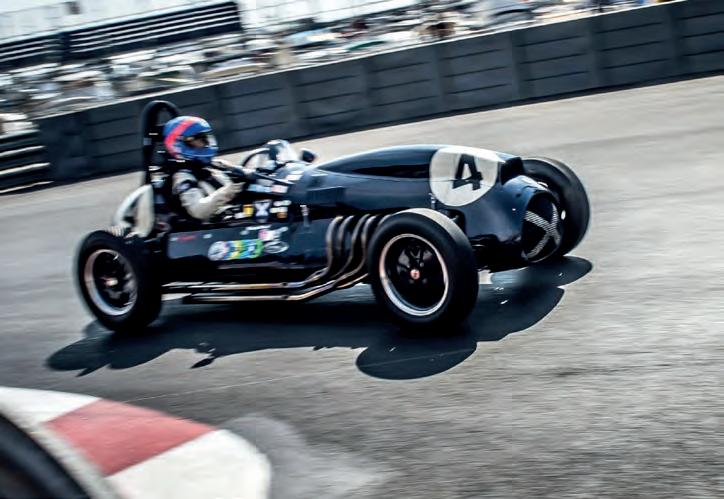
A2 12 4 48
COOPER T23
Evolution de la T20 de 1952, la T23 de 1953 dispose du même 6 cylindres Bristol 2L, sur un châssis multitubulaire très différent, plus léger et plus rigide. Production : 11 exemplaires produits en 1953.
As an evolution of the T20 from 1952, the T23 of 1953 was equipped with the same 6-cylinder 2L Bristol, but with a very different multi-tubular body, lighter and more rigid. Production: 11 models produced in 1953.
Guy PLANTE
Cette Cooper T23 a été livrée à l’Américain
Tom Cole pour remplacer celle détruite lors de sa première course à Syracuse en mars 1953. Elle a notamment été pilotée par Jacques Swaters et Graham Whitehead.
This car was delivered to American driver Tom Cole to replace the one that was destroyed during his first race in Syracuse in March 1953. It was also driven by Jacques Swaters and Graham Whitehead.

FERGUSON P99

Cette Cooper T23 a d’abord été pilotée par Rodney Nuckey, son premier propriétaire en 1953 et 1954. Il a remporté à son volant une course mineure à Snetterton et a participé aussi au Grand Prix d’Allemagne 1953, comptant pour le Championnat du Monde. Rodney Nuckey was the first owner of this. He drove it in 1953 and 1954. He won a minor race in Snetterton, and he also participated at the German Grand Prix in 1953, which counted for the World Championship.
La Harry Ferguson Research Company a développé en 1960 une monoplace expérimentale baptisée P99, pour démontrer le bien fondé et les qualités de son système à 4 roues motrices. Production : modèle unique.
In 1960, the Harry Ferguson Research Company developed an experimental single-seater called the P99 to demonstrate the merits and qualities of its 4-wheel drive system. Production: single model.
Thomas SCHLERETH
Dernière monoplace de Grand Prix 2,5L à moteur avant, la P99 n’est apparue qu’en 1961 alors que la F1 était limitée à 1,5L. Heureusement, l’éphémère Formule Intercontinentale avait été mise en place pour offrir un débouché aux F1 périmées. Mise ensuite en conformité avec la F1 en cours, elle a disputé le Grand Prix d’Angleterre 1961, pilotée par Jack Fairman et surtout Stirling Moss qui a remporté plus tard, dans cette voiture, la Gold Cup (ainsi que le Grand Prix de Monaco Historique 2006). En 1963, Graham Hill et Innes Ireland se sont succédé à son volant dans les courses de la série tasmane.
As the last of the front-engine 2.5-litre Grand Prix single-seaters, the P99 did not appear until 1961, when F1 was limited to 1.5 litre engines. Fortunately, the short-lived Intercontinental Formula had been set up to provide an outlet for out-of-date F1 cars. Later brought into line with current F1, it raced in the 1961 British Grand Prix, driven by Jack Fairman and Stirling Moss, who later won the Gold Cup (as well as the Grand Prix de Monaco Historique 2006) with this car. In 1963, Graham Hill and Innes Ireland drove it in succession in several Tasman races.
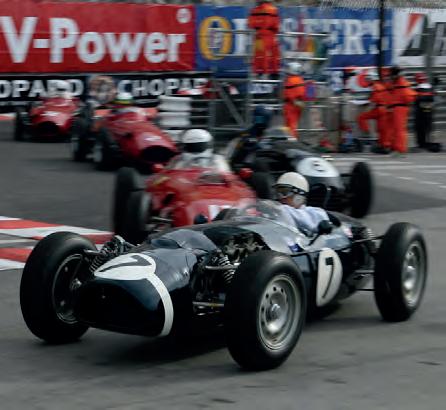 Paul GRANT
Paul GRANT
49 14e GRAND PRIX DE MONACO HISTORIQUE 10-12 MAI 2024
62
6
8
FERRARI 246
Le type 246 est la dernière Ferrari de Grand Prix à moteur avant. En 1960, la Scuderia Ferrari en a confié le volant à Phil Hill (3e à Monaco), ainsi qu’à Richie Ginther, Willy Mairesse, Cliff Allison (accidenté aux essais à Monaco) et Wolfgang Von Trips.
Production : 5 exemplaires en 1960.
The type 256 is the last Grand Prix Ferrari with a front engine. In 1960, Scuderia Ferrari entrusted Phil Hill with this car (3rd in Monaco), as well as Richie Ginther, Willy Mairesse, Cliff Allison (who wrecked it during practice in Monaco) and Wolfgang Von Trips. Production: 5 models in 1960

GORDINI T11/15
Claudia HUERTGEN
Cette Ferrari 246 a été produite trois semaines après le Grand Prix de Monaco 1960 et confiée à Phil Hill, qui resta son seul pilote cette année-là. Pour son 4e et dernier Grand Prix, qui clôtura les sept ans de la F1 limitée à 2,5L, elle connut un succès… facilité par le boycott des écuries anglaises. Un succès historique car le tout dernier en Championnat du Monde d’une voiture à moteur avant.
Released three weeks after the 1960 Monaco Grand Prix, it was entrusted to Phil Hill who was its exclusive driver that year. For its 4th and last Grand Prix, which put an end to the seven-year era of 2.5L capacity engines, it was successful, but this win was made easier since British teams had boycotted the event. It remains an historical success, since it was the last win in the World Championship for a car with a front engine.
Les monoplaces 4 cylindres Gordini ont participé aux Grand Prix de Monaco 1948 (Trintignant 4e, abandons de Wimille, « Bira » et Sommer) et 1950 (abandons de Trintignant et Manzon dans le carambolage général du début de course).
Production : entre 1946 et 1956, Gordini a produit 22 monoplaces, dont quinze 4-cylindres Type 11 et 15 (2 en 1946, 4 en 1947, 4 en 1948, 3 en 1949 et 2 en 1950), cinq 6-cylindres Type 16 et deux 8-cylindres Type 32.
The 4-cylinder Gordini single-seaters took part in the Monaco Grand Prix in 1948 (Trintignant 4th, retirements for Wimille, «Bira» and Sommer) and 1950 (retirements for Trintignant and Manzon after the massive pile-up at the start).
Production: Between 1946 and 1956, Gordini produced 22 single-seaters, including 15 Type-11 and Type-15 with 4 cylinders (2 in 1946, 4 in 1947, 4 in 1948, 3 in 1949, 2 in 1950), 5 Type-16 with 6 cylinders and 2 Type-32 with 8 cylinders.

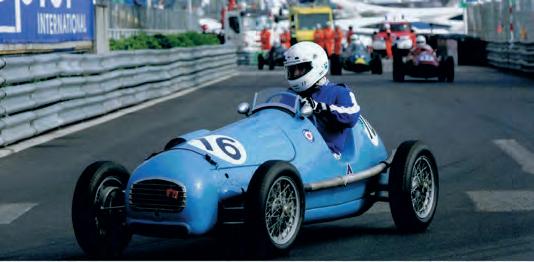
Cette première monoplace Gordini a débuté en 1946 comme Type 11 et s’est battue avec son moteur 1100 cc contre les Cisitalia D46. En 1948, le passage en 1500 cc lui a valu de devenir Type 15 et la pénurie de machines de Grand Prix lui a permis de participer aussi à certaines épreuves de F1 (4e à Monaco en 1948 avec Maurice Trintignant).
This very first Gordini single-seater started its career in 1946 as a Type11 fighting with its 1100 cc engine against the Cisitalia D46. In 1948, the passage to 1500 cc changed its label to Type-15 and the shortage of Grand Prix machines allowed it to also take part in several F1 events (4th in Monaco in 1948 with Maurice Trintignant).
This Gordini was first used in 1947 by Princes « Bira » and « Igor » (Troubetzkoy) in the factory team. Sold in Switzerland in 1949, it continued its career, mostly in hillclimbs, before taking part in the whole 1959 season of the Junior Formula, disguised as a Stanguellini. 16 18
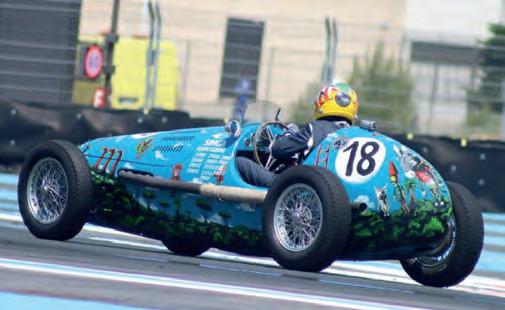
Jean-Jacques BALLY
Cette Gordini a d’abord été utilisée en 1947 par les Princes « Bira » et « Igor » (Troubetzkoy) dans le cadre de l’équipe officielle. Vendue en Suisse en 1949, elle y a poursuivi sa carrière le plus souvent dans des courses de côte avant de participer à toute la saison 1959 de Formule Junior déguisée en Stanguellini.
A2 20 50
Eric LEROY
LOTUS 16
La Lotus 16 est la dernière monoplace de la marque anglaise à moteur avant. Elle a été confiée par le Team Lotus en 1959 à Graham Hill (abandon à Monaco), Alan Stacey et Innes Ireland, et exceptionnellement à Pete Lovely. Deux voitures privées ont aussi été engagées par Bruce Halford (abandon à Monaco) et David Piper. Production : 7 exemplaires produits (2 en 1958, 5 en 1959).
The Lotus 16 is the last single-seater of the make to have a front engine. Team Lotus entrusted Graham Hill (retirement in Monaco) in 1959, as well as Alan Stacey, Innes Ireland and exceptionally Pete Lovely. Two private cars were also entered by Bruce Halford (retirement in Monaco) and David Piper. Production: 7 models produced (2 in 1958, 5 in 1959).
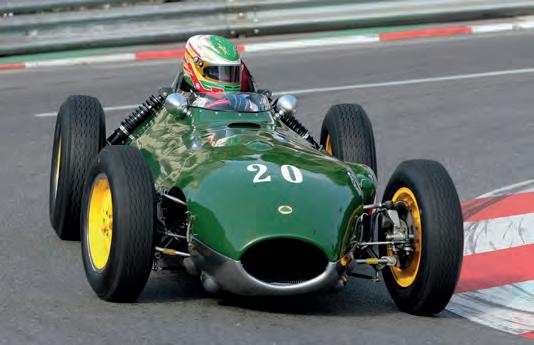

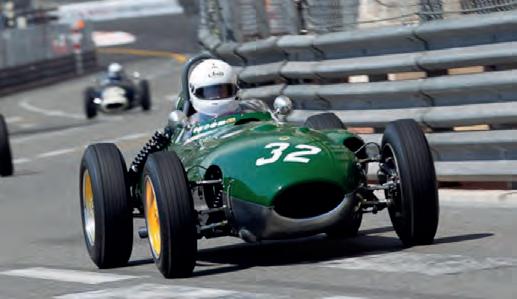
Marshall BAILEY
Sortie en 1959, cette Type 16 n’a été engagée cette année -là que par le Team Lotus, le plus souvent dans des manches du Championnat du Monde de F1: Graham Hill, Alan Stacey, Innes Ireland (4e en Hollande) l’ont pilotée, tout comme Pete Lovely qui a manqué sa qualification à Monaco.
Released in 1959, this Type 16 raced exclusively that year for Team Lotus, most often in World Championship events: Graham Hill, Alan Stacey, Innes Ireland (4th in Holland) shared it, as well as Pete Lovely who did not manage to qualify for the race in Monaco.
Ewen SERGISON
Cette Lotus 16 était la voiture habituelle de Graham Hill en 1958, avec laquelle il a participé à six manches du Championnat du Monde dont le Grand Prix d’Italie terminé à la 5e place. En 1959, elle a été vendue à David Piper qui l’a surtout pilotée en F2 et, épisodiquement, en F1 (abandon au Grand Prix de GrandeBretagne).
The car on display was Graham Hill’s usual car in 1958, in which he took part in six rounds of the World Championship, including the Italian Grand Prix where he finished 5th. In 1959, it was sold to David Piper, who often used it in F2 and, occasionally, in F1 (retirement at the British Grand Prix).
Joaquin FOLCH-RUSINOL CORACHAN
Sortie en 1959, cette Type 16 a été utilisée exclusivement en F1 par le Team Lotus. Elle a abandonné aux mains d’Innes Ireland pour sa 1ère sortie au Grand Prix de l’ACF ; Graham Hill l’a ensuite pilotée aux Grands Prix de Grande-Bretagne, d’Allemagne et du Portugal. Enfin, Ireland a achevé la saison à son volant par une 5e place au Grand Prix des Etats-Unis. Toujours dans le Team Lotus début 1960, elle a permis à l’Argentin Alberto Rodriguez Larreta de débuter en Grand Prix.
Released in 1959, this Type 16 was used exclusively in F1 by Team Lotus. It retired in the hands of Innes Ireland for its first outing at ACF Grand Prix; Graham Hill then drove it at the British, German and Portuguese Grand Prix. Ireland ended the season with a 5th place at the US Grand Prix. Still with Team Lotus at the start of 1960, it enabled Argentina’s Alberto Rodriguez Larreta to make his Grand Prix debut.


Max SMITH HILLIARD
Cette Lotus 16 a été pilotée par Bruce Halford en 1959 notamment au Grand Prix de Monaco où il a été accidenté au 1er tour.
The car on show was driven by Bruce Halford in 1959, notably at the Grand Prix de Monaco, where he crashed on the 1st lap.

51 14e GRAND PRIX DE MONACO HISTORIQUE 10-12 MAI 2024
42 46 44
40
MASERATI 4CLT/48
La Maserati 4CLT/48 est l’ultime développement de la série des Voiturettes de la marque au Trident produites avant-guerre. Evolution de la 4CL sortie en 1939, elle dispose entre autres d’un châssis tubulaire (le T de sa désignation) et d’une carrosserie abaissée tandis que l’évolution des règlements font de cette 4 cylindres de 1500 cc, à compresseur, une voiture de Grand Prix. Au volant de l’une d’elles, Louis Chiron a terminé 3e du Grand Prix de Monaco 1950, la 2e manche du tout premier Championnat du Monde. Quant à Farina et Fangio, les deux premiers Champions du Monde de l’histoire, ils l’ont souvent pilotée entre 1949 et 1951 dans des courses de F1 hors championnat. Production : 21 exemplaires produits (9 en 1948, 10 en 1949, 2 en 1950).
The Maserati 4CLT/48 is the ultimate development of the pre-war series of Maserati cars. An evolution of the 4CL released in 1939, it has a tubular chassis (the T of its designation) and a lowered body while the evolution of the regulations made this 4-cylinder 1500cc with compressor a Grand Prix car. Louis Chiron drove one of these cars to a 3rd place finish in the 1950 Monaco Grand Prix, then the 2nd round of the very first World Championship; Farina and Fangio, the first two World Champions of F1 history, they often drove it in non-Championship F1 races between 1949 and 1951. Production: 20 examples produced (9 in 1948, 10 in 1949, 2 in 1950).
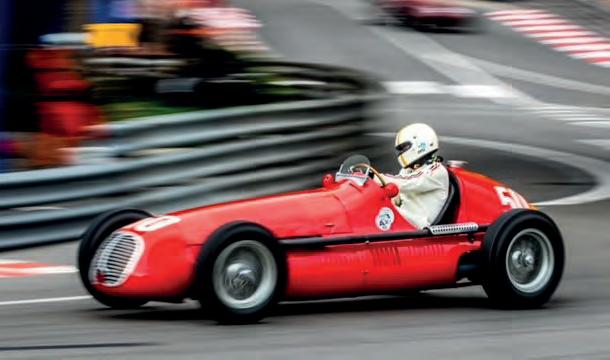
MASERATI A6GCM
Jaime BERGEL SAINZ DE BARANBA
Cette 4CLT/48 a été développée par la Scuderia Milan entre fin 1949 et fin 1951 avant d’aller poursuivre et terminer sa carrière en Amérique du Sud. Elle a notamment participé au Grand Prix de l’ACF 1951 aux mains d’Onofre Marimon.
This 4CLT/48 was developed by Scuderia Milan between the end of 1949 and the end of 1951 before continuing and finishing its career in South America. It participated in the 1951 ACF Grand Prix in the hands of Onofre Marimon.
Construites en 1952 en tant que Formule 2, les A6GCM n’ont pas été admises au Grand Prix de Monaco ouvert exclusivement, cette annéelà, aux voitures de Sport. Elles ont pourtant été autorisées à participer au Championnat du Monde des conducteurs, un privilège qui n’a duré que deux saisons, en 1952 et 1953. Production : 7 voitures produites en 1952.
Built in 1952 as Formula 2 cars, the A6GCMs were not allowed to take part in the Grand Prix de Monaco, which was only open to sportscars that year. They did, however, take part in the World Drivers’ Championship, a rare privilege which only lasted two years, in 1952 and 1953. Production: 7 cars produced in 1952.
Julia DE BALDANZA
L’A6GCM présentée ici est l’une des trois premières voitures ayant été livrées à une équipe brésilienne. Régulièrement engagées en Championnat du Monde, pour Chico Landi, Eitel Cantoni et Gino Bianco, elles ont aussi été louées occasionnellement à Philippe Etancelin, Gianfranco Comotti, Jan Flinterman et Alberto Crespo.
The A6GCM on display was one of the first three cars to be delivered directly to a Brazilian team. Regularly entered in the World Championship for Chico Landi, Eitel Cantoni and Gino Bianco, they were also occasionally leased to Philippe Etancelin, Gianfranco Comotti, Jan Flinterman and Alberto Crespo.
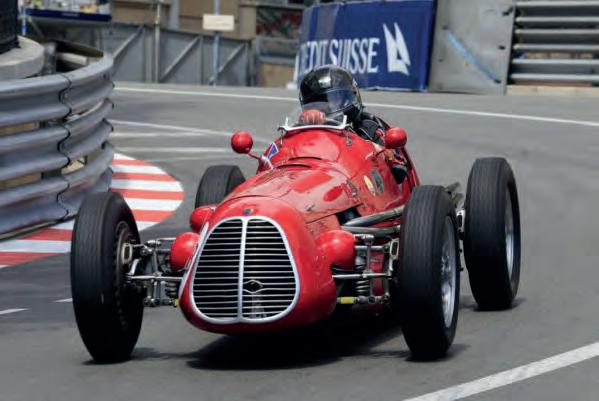
A2 24 14 52
MASERATI 250F
La Maserati 250F, voiture emblématique de la période, a remporté le premier Grand Prix de la réglementation des F1 2,5L en 1954. Elle a aussi permis à Juan-Manuel Fangio de devenir Champion du Monde en 1954 et 1957 (le dernier de ses 5 titres) et a participé à de nombreux Grands Prix de Monaco de 1955 à 1959, remportant l’édition 1956 avec Stirling Moss et celle de 1957 avec Juan-Manuel Fangio.
Production : 28 voitures entre 1954 et 1958 dont 2 dites « Piccolo » construites en 1958.
The Maserati 250F, an emblematic car of the period, won the first Grand Prix ever limited to 2.5L cars and engines in 1954. It allowed Juan-Manuel Fangio to become World Champion in 1954 and 1957 (the last of his five titles). The car also participated in several Monaco Grands Prix from 1954 to 1959, winning the 1956 edition, thanks to Stirling Moss, and in 1957 thanks to Juan-Manuel Fangio.
Production: 28 cars between 1954 and 1958 including 2 said «Piccolo» built in 1958.
Christian DUMOLIN
Cette Maserati 250F a été livrée neuve en Angleterre en 1954 à Gilby Engineering pour Roy Salvadori, puis elle est revenue à l’usine pour la saison 1956 (mulet de Moss à Monaco, elle a pris la 5e place du Grand Prix de l’ACF avec Perdisa). Achetée par la Scuderia Centro Sud en 1957, elle a été utilisée dans cette structure par nombre de pilotes notamment Taruffi, Gregory (3e à Monaco en 1957), Bueb, Herrmann, Seidel, Gould (non-qualifié à Monaco en 1958), Duncan, d’Orey et Da Silva-Ramos.
Delivered new in England in 1954 to Gilby Engineering for Roy Salvadori, this car returned to the factory for the 1956 season (Moss’ mule in Monaco, it finished 5th in the ACF Grand Prix with Perdisa). Purchased by Scuderia Centro Sud in 1957, it was used in this structure by several drivers, notably Taruffi, Gregory (3rd in Monaco in 1957), Bueb, Herrmann, Seidel, Gould (not qualified in Monaco in 1958), Duncan, d’Orey and Da Silva-Ramos.



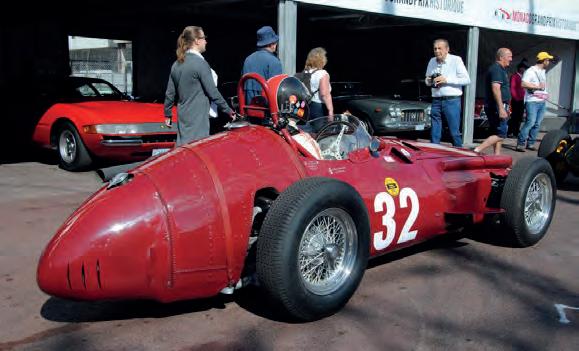
Marino FRANCHITTI
Cette 250F a été équipée, en 1957, d’un moteur V12 dans un châssis ultra-léger. En 1958, elle est mise en configuration 6 cylindres avant d’être expédiée l’année suivante en Amérique du Sud sans jamais avoir pris un départ en Europe. Elle a été engagée pour Munaron par la Scuderia Cento Sud lors du Grand Prix d’Argentine qu’il a terminé à la 13e place.
This 250F was equipped in 1957 with a V12 engine in a lightweight chassis. In 1958, it was put in a 6-cylinder configuration before being shipped the following year to South America without ever having made a single start in Europe. Engaged for Munaron at the Argentinian Grand Prix, by Scuderia Cento Sud, it finished the event in 13th place.
Guillermo FIERRO-ELETA
Voiture d’usine de 1954 à fin 1957, avant d’être vendue à Maria-Teresa de Filippis, la première femme engagée en Championnat du Monde de F1. Précisément à Monaco en 1958 sur cette Maserati qui a été inscrite sans discontinuer au Grand Prix de Monaco entre 1955 et 1959, soit le record pour une F1 en Principauté.
A works car from 1954 to late 1957, before being sold to Maria-Teresa de Filippis, the very first woman to enter a World Championship event: precisely in Monaco in 1958 in this Maserati, which was continuously entered at Monaco Grand Prix from 1955 to 1959, the record for an F1 car in the Principality.
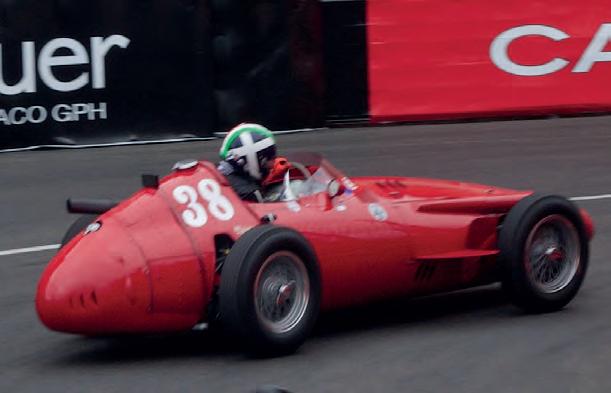
53 14e GRAND PRIX DE MONACO HISTORIQUE 10-12 MAI 2024
28 32 30

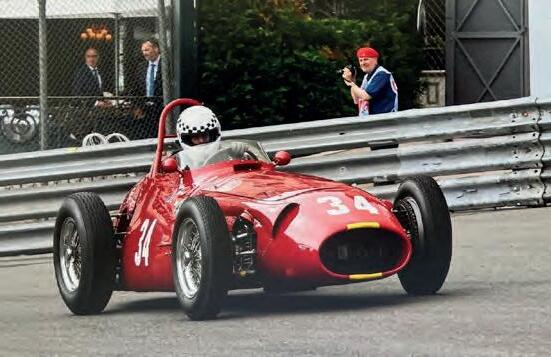
Kurt ENGELHORN
Voiture d’usine en 1955, elle a été utilisée le plus souvent cette année-là par Roberto Mieres (abandon à Monaco) mais aussi occasionnellement par Mantovani, Musso, Perdisa, Behra, Schell, Moss (1er de la Gold Cup), Collins et Carroll Shelby (celui des Cobra !).
A factory car in 1955, it was used most often that year by Roberto Mieres (now retired in Monaco) and also occasionally by Mantovani, Musso, Perdisa, Behra, Schell, Moss (1st at the Gold Cup), Collins and Carroll Shelby (the Cobra driver!).

John SPIERS
Cette 250F, sortie en 1955, a été utilisée cette année-là, dans le cadre de l’équipe officielle essentiellement par Jean Behra, victorieux à son volant des Grand Prix de Pau et de Bordeaux, et 3e à Monaco avec Cesare Perdisa. Elle a ensuite poursuivi sa carrière en Australie aux mains des meilleurs pilotes des antipodes.
This 250F, released in 1955, was essentially used that year, within the framework of the official team, by Jean Behra who won with it the Pau and Bordeaux Grands Prix, as well as taking 3rd place in Monaco with Cesare Perdisa. It continued its career in Australia, in the hands of the best Australian drivers.



Brad BAKER
Voiture d’usine en 1956, cette 250F a été pilotée cette année-là par Jean Behra et Jean Lucas, co-fondateur de la revue Sport-Auto en 1962. Elle a eu un accident lors du Grand Prix du Maroc de 1957. Recarrossée, elle est ensuite passée aux mains d’André Testut, élève de Louis Chiron, qui l’a engagée sans succès sous ses couleurs monégasques lors des Grands Prix de Monaco 1958 et 1959.
A works car in 1956, this 250F was driven that year by Jean Behra and Jean Lucas, co-founder of Sport-Auto magazine in 1962. It had an accident at the 1957 Moroccan Grand Prix. After being re-bodied, it passed into the hands of André Testut, a pupil of Louis Chiron, who raced it unsuccessfully in Monegasque colors at Monaco Grand Prix in 1958 and 1959.
Jeffrey O’NEIL
Cette voiture a été construite en tubes plus fins, début 1957, pour le compte de l’équipe officielle. Elle a débuté en Argentine en 1957, aux mains de Stirling Moss, puis a été accidentée par Carlos Menditeguy à Monaco, avant de terminer la saison pilotée le plus souvent par Harry Schell. Derek Kavannagh, qui en avait fait l’acquisition pour la saison 1958, ne s’est pas qualifié à Monaco. Très active ensuite, en courses historiques depuis le milieu des années 1960, il a subi deux accidents majeurs nécessitant un remplacement de châssis.
This car was built in thinner tubes, early 1957, for the works team. It made its debut in Argentina in 1957, in the hands of Stirling Moss, then it was wrecked by Carlos Menditeguy in Monaco, before finishing the season driven most often by Harry Schell. Derek Kavannagh, who acquired it for the 1958 season, did not qualify in Monaco. Very active in historic races since the mid-60s, it went through two major wrecks, each of which needing a replacement of the body.

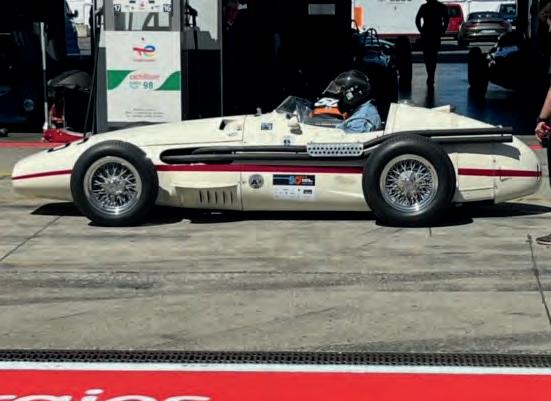
36 56 50
34 A2 54
Stéphane DE GROODT
Utilisée généralement par l’Espagnol GodiaSales en 1956 et 1957, cette voiture est ensuite devenue la propriété du Suédois Joakim Bonnier en 1958 (abandon à Monaco mais 2e à Syracuse et Caen) qui l’a occasionnellement louée à Phil Hill et Hans Herrmann.
Generally used by Spaniard Godia-Sales in 1956 and 1957, the car then became the property of Sweden’s Joakim Bonnier in 1958 (retirement in Monaco but 2nd in Syracuse and Caen) who occasionally hired it out to Phil Hill and Hans Herrmann.

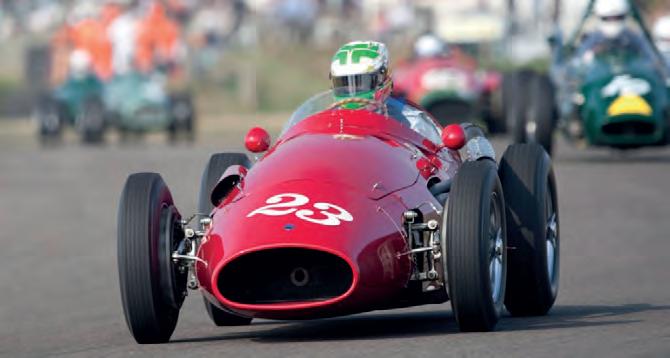
OSCA SCARAB
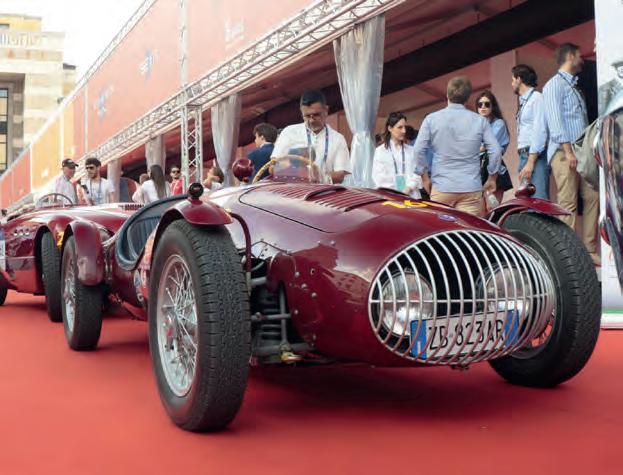
Massimo di RISIO
Cette voiture, livrée à Francesco Nissoti, a été utilisée occasionnellement en F2, notamment lors du Grand Prix du Lac de Garde 1950 où elle a terminé 8e d’une course dominée par les monoplaces Ferrari 166 F2 d’Ascari et Serafini. A partir de 1952, elle a poursuivi sa carrière aux Etats-Unis.
This car, delivered to Francesco Nissoti, was occasionally used in F2, notably at the 1950 Lake Garda Grand Prix, where it finished 8th in a race dominated by the Ferrari 166 F2 single-seaters of Ascari and Serafini. From 1952, it continued its career in the United States.
Présente inachevée dans le box Scarab du Grand Prix de Belgique 1960, cette auto n’a jamais couru à son époque.
Present, though unfinished, in the Scarab garage at the 1960 Belgian Grand Prix box, this car never raced in its time.

55 14e GRAND PRIX DE MONACO HISTORIQUE 10-12 MAI 2024
58
Mark SHAW
2 48
TALBOT T26C
La Talbot T26C, voiture française emblématique des Grands Prix d’après-guerre, a fait deux apparitions à Monaco : Louis Rosier a abandonné en 1948 et 1950, Philippe Etancelin a fait de même en 1950, tandis que le Belge John Claes a atteint l’arrivée en 7e position. Production : 16 voitures, sur 14 châssis (12 en 1948, 4 en 1950).
The Talbot T26C, the emblematic French car of post-war Grand Prix racing, made two appearances in Monaco: Louis Rosier retired in 1948 and 1950, Philippe Etancelin did the same in 1950, while Belgian John Claes managed to take 7th place. Production: 16 cars on 14 bodies (12 in 1948, 4 in 1950).
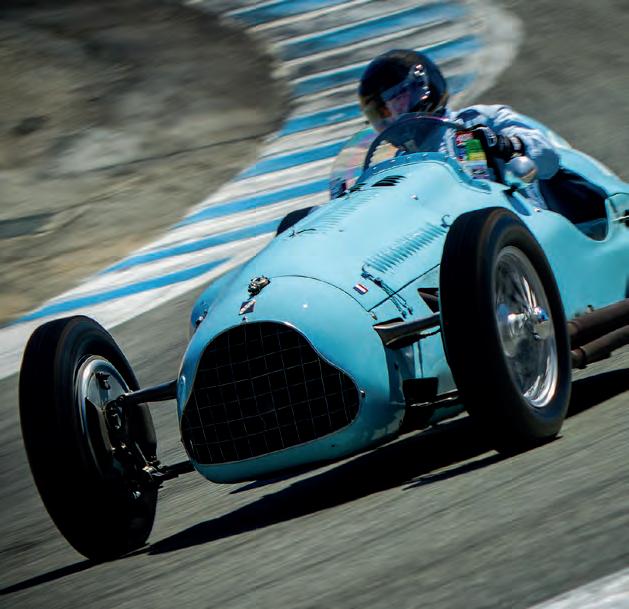
TEC MEC
Cette Tec Mec, terminée en septembre 1959, est souvent considérée comme l’ultime évolution de la Maserati 250F. Malgré son châssis plus évolué, elle est déjà dépassée dès sa conception, car encore conçue avec un moteur avant. Forfait pour le Grand Prix d’Italie, elle est confiée à Fritz d’Orey pour le Grand Prix des Etats-Unis où elle abandonne.
This Tec Mec was finished in 1959, as an ultimate evolution of the Maserati 250F. Even though it had a highly evolved chassis, it was obsolete since its conception, because it was designed with a front-engine. It withdrew before the Italian Grand Prix and was then entrusted to Fritz d’Orey at the United States Grand Prix where he had to retire.
Denis BIGNONI
Cette T26C est la propriété de Pierre Levegh de 1948 à fin 1951. A son volant, il participe à de nombreuses courses, dont sept Grands Prix comptant pour le Championnat du Monde. Elle sert de paiement partiel lors de l’achat de la biplace T26GS avec laquelle Levegh signe la pole position au Prix de Monte-Carlo, en 1952, puis dispute la même année les 24 Heures du Mans, en échouant lors de la dernière heure alors qu’il mène la course. Sa T26C va faire l’objet de développements à l’usine et être une dernière fois utilisée par Etancelin lors du Grand Prix de Rouen 1953.
This T26C was owned by Pierre Levegh from 1948 to the end of 1951. At its wheel, he took part in numerous races, including seven Grand Prix events counting for the World Championship. It was also used as part payment for the purchase of the two-seater T26GS with which he took pole position at the 1952 Prix de Monte-Carlo, and with which he contested Le Mans 24 Hours that same year, failing to finish in the final hour while leading the race. His T26C underwent further development at the factory and was used one last time by Etancelin at the Rouen Grand Prix in 1953.
 Tony WOOD
Tony WOOD
A2 26 60 56


GRAHAM HILL B
VOITURES DE GRAND PRIX DE F1 DE 1961 À 1965 À MOTEUR ARRIÈRE DE 1500CC, F2 DE 1956 À 1960 / F1 GRAND PRIX CARS FROM 1961 TO 1965 WITH REAR-ENGINE 1500CC, F2 FROM 1956 TO 1960
REGLEMENT (Extrait, Article 4) / RULE BOOK (Extract, Article 4)
Le 14 e Grand Prix de Monaco Historique est ouvert aux voitures définies par l’annexe K du Code Sportif International de la F.I.A. / The 14th Grand Prix de Monaco
Historique is open to cars defined by Appendix K of the FIA International Sporting Code.
Les voitures sont admises en 3 classes / The cars are admitted in 2 classes:
Classe 1 : F 2 produites entre le 1er janvier 1956 et le 31 décembre 1960 / F2 cars built between January 1, 1956 and December 31, 1960
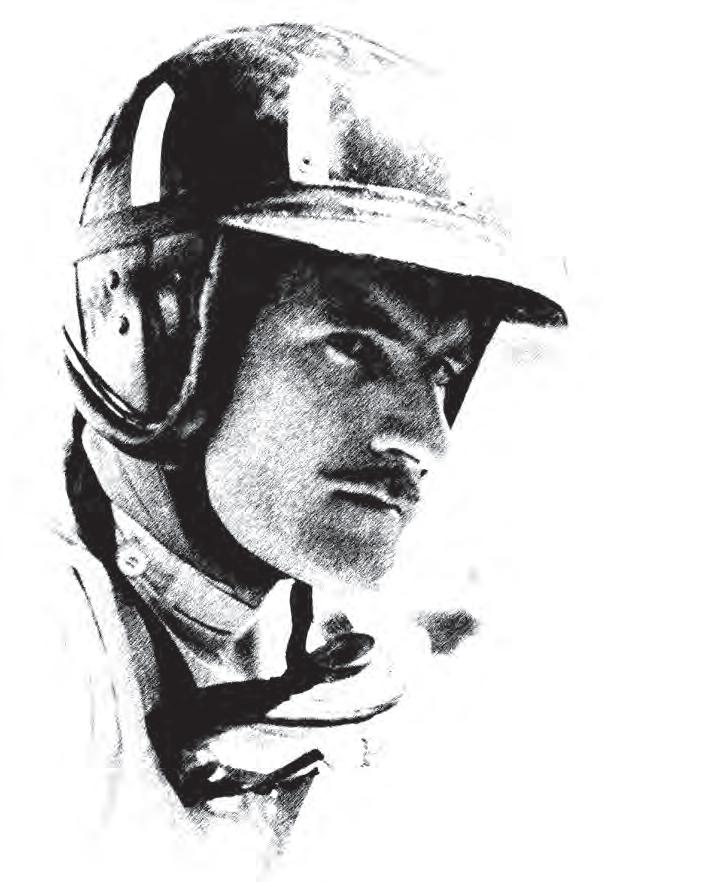
oitures de F1 équipées d’un moteur de 4 ou 6 cylindres / F1 cars equipped with a 4 or 6 cylinders engine
oitures de F1 équipées d’un moteur de 8 ou 12 cylindres / F1 cars equipped with an 8 or 12 cylinders engine
1963 - 1964 1965 - 1968 - 1969
A partir de 1961, et jusqu’à 1965 inclus, le règlement de la Formule 1 bannissait le compresseur et limitait la cylindrée des voitures à 1500cc. Cette évolution indispensable tenait compte du danger que représentait l’accroissement des performances des Formule 1, due à la combinaison de plusieurs facteurs : tenue de route, moteur arrière, évolution des suspensions et des pneus. Cela explique la présence à l’époque, dans les rues de Monaco, de ce type de monoplaces et justifie l’organisation aujourd’hui de cette série B, qui les voit à nouveau se confronter ici.
From 1961 to 1965, Formula 1 regulations banned compressors and limited engine capacity to 1500cc. This evolution took into account the growing danger that came with the level of performance Formula 1 was achieving. These incredible performances were due to a number of factors: better roadholding, rear engines, evolution of suspensions and tyres. This explains the presence of this type of singleseaters in the streets of Monaco at the time. It also justifies the organising of this B series, for these cars to compete once again.
1961 : Stirling Moss / Lotus 18
1962 : Bruce McLaren / Cooper T60
1963 : Graham Hill / BRM P57
1964 : Graham Hill / BRM P261
1965 : Graham Hill / BRM P261
58
VAINQUEURS DU GRAND PRIX DE MONACO MONACO GRAND PRIX WINNERS
SÉRIE RACE
LISTE DES ENGAGÉS I ENTRY LIST

59 14e GRAND PRIX DE MONACO HISTORIQUE 10-12 MAI 2024 N° PILOTE / DRIVER NAT CONCURRENT VOITURE / CAR MODÈLE ANNÉE CL. 1 ROMANO John USA ROMANO John BRABHAM BT11 (CLIMAX) 1964 3 2 BURATTI Federico ITA BURATTI Federico LOTUS 24 (BRM) 1962 3 3 GENDRE Michel FRA GENDRE Michel LOTUS 24 (CLIMAX) 1962 3 4 COLASACCO Joseph USA AURIANA Lawrence FERRARI 1512 1964 3 5 MCCABE Charles USA MCCABE Charles BRM P578 1962 3 6 MIDDLEHURST Andy GBR CLASSIC TEAM LOTUS LTD LOTUS 25 (CLIMAX) 1962 3 7 SHAW Mark GBR SHAW Mark LOTUS 21 (CLIMAX) 1961 2 8 TAYLOR Nick GBR TAYLOR Nick LOTUS 18 (CLIMAX) 1960 2 9 MICHAEL Costas GBR MICHAEL Costas COOPER T73 (CLIMAX) 1964 3 12 TIZZARD Stuart GBR TIZZARD Stuart COOPER T43 (CLIMAX) 1957 1 14 WILSON Richard GBR WILSON Richard COOPER T60 (CLIMAX) 1962 3 15 COLLINS Dan GBR COLLINS Dan LOTUS 21 (CLIMAX) 1961 2 16 MCCARTHY Clinton GBR MCCARTHY Clinton LOTUS 18 (CLIMAX) 1960 2 18 HANN Elliott GBR HANN Elliott COOPER T41 (CLIMAX) 1957 1 19 HOOLE Sidney GBR HOOLE Sidney COOPER T66 (CLIMAX) 1963 3 20 SALISBURY Teifion GBR SALISBURY Teifion LOTUS 18 (CLIMAX) 1961 2 21 STAES Erik BEL STAES Erik LOTUS 18/21 (CLIMAX) 1961 2 22 HALUSA Lukas AUT HALUSA Martin BRABHAM BT7 (CLIMAX) 1963 3 23 JOEBSTL Stephan AUS JOEBSTL Stephan LOTUS 24 (CLIMAX) 1962 3 24 BUHOFER Philipp CHE BUHOFER Philipp LOTUS 24 (CLIMAX) 1962 2 25 DRAKE Christopher GBR DRAKE Christopher COOPER T71/T73 (FORD) 1964 2 28 MISTER JOHN OF B FRA MISTER JOHN OF B LOLA MK4 (CLIMAX) 1962 3 32 KUBOTA Katsuaki JPN KUBOTA Katsuaki LOTUS 24 (CLIMAX) 1962 3 34STORTONI Andrea ITA STORTONI Andrea LOTUS 18 (CLIMAX) 1961 2 35 ELLISON Julian GBR ELLISON Julian ASSEGAI F1 (ALFA-ROMEO) 1961 2 44 TIMMS Jason GBR TIMMS Jason COOPER T53 (CLIMAX) 1961 2 46 DELBENE Kurt USA DELBENE Kurt BRP 64 (BRM) 1964 3 48 PULLEYN Robert GBR PULLEYN Robert LOTUS 18 (CLIMAX) 1960 2 50 HAGAN James GBR HAGAN James LOTUS 18 (CLIMAX) 1960 1 52 PUCCINELLI Flavio AUS PUCCINELLI Flavio COOPER T53 (CLIMAX) 1960 1 54 CAJANI Marco ITA CAJANI Marco DE TOMASOF1 (ALFA CONRERO) 1961 2 56 CLARK John GBR CLARK John COOPER T56 (CLIMAX) 1961 2 58 DE GRES Tom BEL DE GRES Tom BRABHAMBT14 (FORD) 1965 2 80 BONNY Philippe FRA BONNY Philippe BRABHAMBT2 (FORD) 1963 2 1 Voiture victorieuse d’un ou plusieurs Grand Prix du Championnat du Monde Voiture présente en période au Grand Prix de Monaco
BRABHAM B
ASSEGAI

Julian ELLISON
Cette Assegaï a couru dans le championnat sud-africain en 1963 et a fait partie des monoplaces locales engagées lors du Rand Grand Prix disputé en décembre en présence des équipes Lotus, BRM et Lola.
This Assegaï raced in the South African championship in 1963 and was one of the local cars entered in the Rand Grand Prix held in December in the presence of the Lotus, BRM and Lola teams.
John ROMANO BT11
Construite en 1964, cette BT11 a été utilisée par deux Champions du Monde : Jack Brabham d’abord, en 1964 et 1965 (abandon à Monaco), puis Denny Hulme en 1966 (abandon à Monaco).
Built in 1964, this BT11 was used by a couple of World Champions in a row; Jack Brabham first, in 1964 and 1965 (retirement in Monaco), then Denny Hulme in 1966 (retirement in Monaco).

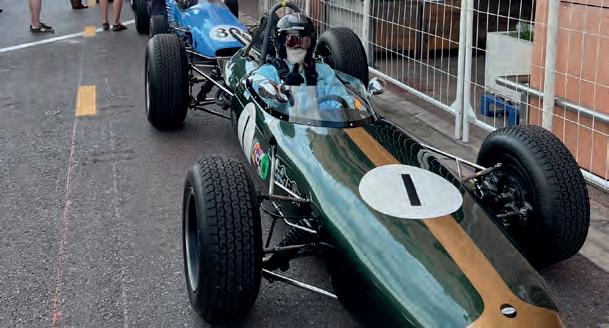


Tom de GREES
BT14
Deux BT14 ont été occasionnellement utilisées en F1, et plus précisément celle-ci avec laquelle John Cardwell a participé à la course de F1 disputée à Goodwood en avril 1965.
Two BT14s raced occasionally in F1, and this is the one that John Cardwell drove in the F1 race held at Goodwood in April 1965.
Lukas HALUSA
BT7
Cette BT7 était la voiture habituelle de Dan Gurney en 1963 et 1964. A son volant, l’Américain a abandonné deux années de suite à Monaco mais a remporté par ailleurs deux victoires en Championnat du Monde : aux Grands Prix de l’ACF et du Mexique, les deux en 1964.
The BT7 on show was Dan Gurney’s regular car in 1963 and 1964. At its wheel, the American driver retired twice in a row at Monaco, but he also scored two wins in the World Championship: at the ACF Grand Prix and at the Mexican Grand Prix, both in 1964.
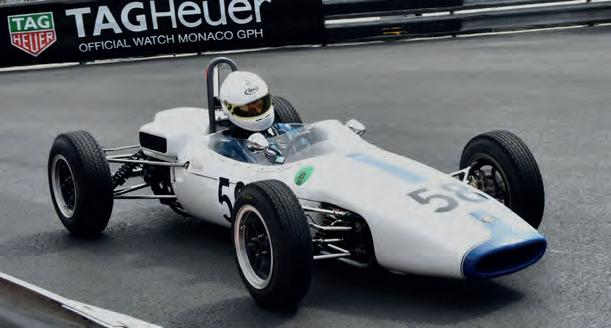
35 60 58 1 22 2
Philippe BONNY
BT2
Née pour la Formule Junior en 1962, cette BT2 a été confiée à Jo Schlesser qui a remporté plusieurs victoires dans la catégorie. A son volant, il a aussi terminé 7e en 1962, puis 3e en 1963, du Grand Prix de Monaco Junior. Au début de la saison 1963, il l’avait modifiée pour participer aussi à des courses de F1 hors-Championnat, à Pau, Imola (4e) et Enna-Pergusa, en Italie.
Born for the Junior Formula in 1962, this BT2 was entrusted to Jo Schlesser, who won several races in the category. With that car, he finished 7th in 1962, and 3rd in 1963, at the Monaco Junior Grand Prix. At the start of 1963, he modified this car to also take part in non-championship F1 races, such as those in Pau, Imola (4th) and Enna-Pergusa, in Italy.
BRM P57

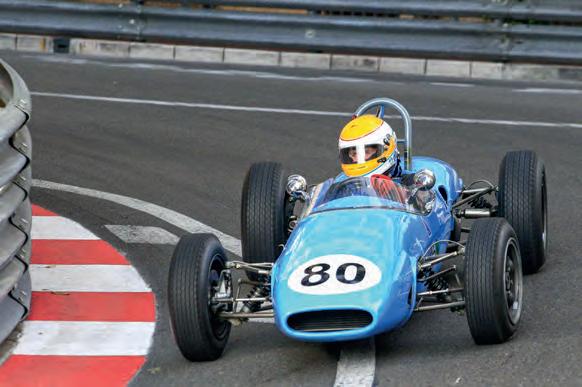
Owen Racing a engagé des BRM P57 en 1961, dotées de moteurs Climax 4-cylindres (les seules BRM monoplaces équipées d’un moteur d’une autre marque), pour Graham Hill et Tony Brooks (tous deux ont abandonné à Monaco). Les quatre P57 construites en 1962, autour d’un moteur V8 maison, ont permis à Graham Hill et à la marque BRM d’être sacrés Champions du Monde cette année-là, puis de remporter le Grand Prix de Monaco 1963. Production : 3 voitures construites en 1961.
Owen Racing entered BRMs P57 in 1961, equipped with Climax 4-cylinder engines (the only BRMs single-seaters with an engine from another make), for Graham Hill and Tony Brooks (both retired in Monaco). The four P57s built in 1962, with BRM V8 engines, enabled Graham Hill and BRM to be crowned World Champions that year, before winning the 1963 Monaco Grand Prix. Production: 3 cars built in 1961.
Charles McCABE
P57
Cette P57 a été pilotée régulièrement en 1962 et 1963 par Richie Ginther, 3e du Grand Prix de l’ACF en 1962. Il a fait encore mieux à Monaco en 1963 avec une 2e place, puis il a réédité cette performance la même année aux Grands Prix d’Italie et des Etats Unis.
The P57 on show was driven on a regular basis in 1962 and 1963 by Richie Ginther. He finished 3rd in the ACF Grand Prix in 1962, and went one better in Monaco in 1963 with a 2nd place, before duplicating this result the same year at the Italian and American Grand Prix.

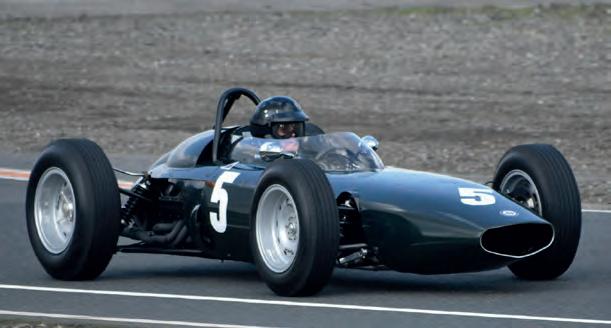
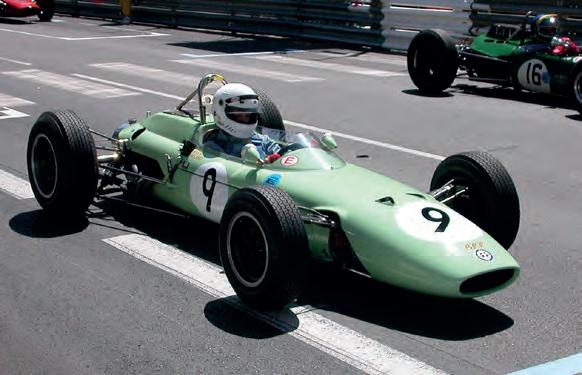
Kurt DELBENE
Cette BRP de 1964 a été exclusivement utilisée en course par Innes Ireland. De ses quatre départs en Championnat du Monde, cette année-là, dans cette monoplace à moteur V8 BRM, la 5e place au Grand Prix d’Italie reste le meilleur résultat.
This 1964 car, equipped with a BRM V8 engine, was exclusively raced by Innes Ireland. He took four starts that year in the World Championship, with this car, and his 5th place in the Italian Grand Prix was his best result.
61 14e GRAND PRIX DE MONACO HISTORIQUE 10-12 MAI 2024 80 5
BRP
46
COOPER
Costas MICHAEL T73
Cette Cooper T73 était la voiture habituelle de Bruce McLaren en 1964. Il a pris neuf départs à son volant, enregistrant une 2e place au Grand Prix d’Italie comme meilleur résultat. A Monaco, victime d’un accident aux essais, il a dû prendre le départ sur une T66.
This Cooper T73 was the usual car for Bruce McLaren in 1964. He took nine starts at its wheel, recording a 2nd place in the Italian Grand Prix as a best result. In Monaco, following an accident in practice, he had to start the race in a T66.

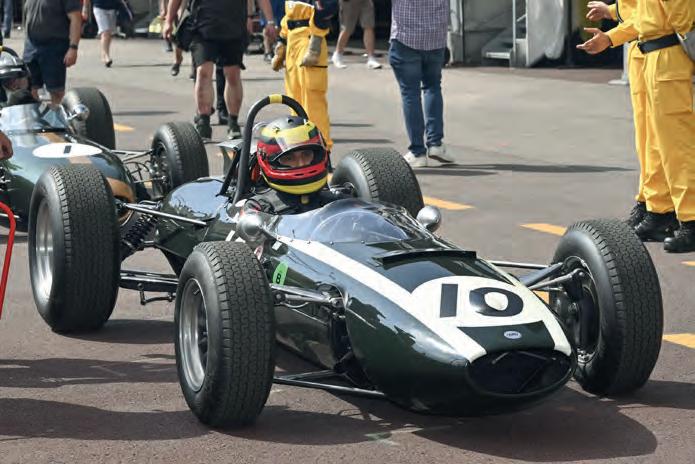


Richard WILSON T60
Cette T60 a été utilisée régulièrement dans le Championnat du Monde 1962 par Bruce McLaren, victorieux cette annéelà du Grand Prix de Monaco, puis 3e des Grands Prix de Grande-Bretagne et du Mexique, et 2e du Grand Prix d’Afrique du Sud.
This T60 was used on a regular basis in the 1962 World Championship by Bruce McLaren, who won the Monaco Grand Prix that year, before finishing 3rd at the British and Mexican Grand Prix, and 2nd at the South African Grand Prix.

Stuart TIZZARD T43
Cette Cooper T43 a été livrée neuve en septembre 1957 à Jo Lubin, distributeur Cooper aux Etats-Unis où s’est déroulée sa carrière.
This Cooper T43 was delivered new in September 1957 to Jo Lubin, a Cooper dealer in the United States where his career took place.
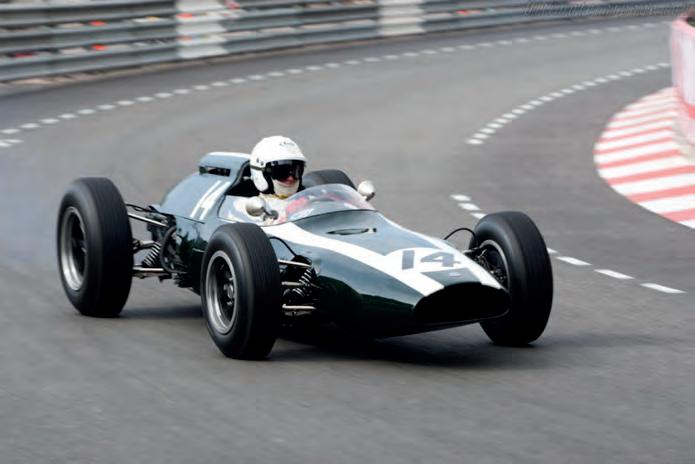
B 62 14 9 12 1
Elliot HANN T41
Cette T41, du type de celles engagées au Grand Prix de Monaco 1957, a été livrée neuve à l’école de pilotage de Brands Hatch, dotée alors d’un moteur Climax FWE. Plus tard, elle a été équipée d’un FWB comme l’étaient les T41 de F2 en 1956.
This T41, of the type raced at the 1957 Monaco Grand Prix, was delivered new to Brands Hatch Driving School, equipped at the time with a Climax FEW engine. It was later fitted with an FWB engine, just like the 1956 T41s for F2.
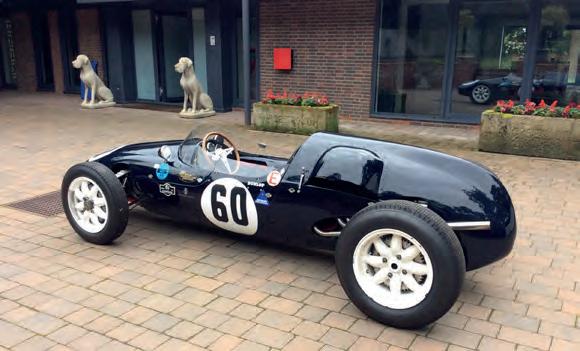

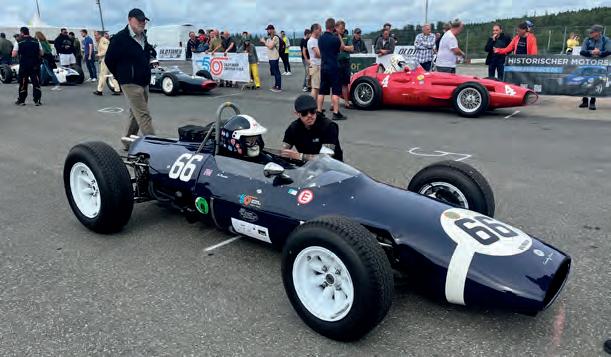
Christopher DRAKE
T71/73
Cette T71/73 a été construite pour disputer les courses de F1 britanniques. Son premier pilote, John Taylor, a disputé en 1964 l’International Trophy, la Gold Cup mais aussi le Grand Prix de Grande-Bretagne comptant pour le Championnat du Monde. A son volant, Alan Rollinson na pas réussi à se qualifier pour l’édition suivante du British Grand Prix. Une mésaventure connue aussi par Piers Courage, le mois suivant, au Grand Prix de la Méditerranée.
This T71/73 was built in order to take part in British F1 races. Its first driver, John Taylor, raced at the International Trophy in 1964, the Gold Cup, but also the British Grand Prix. Behind its wheel, Alan Rollinson failed to qualify for the next edition. This was also the case for Piers Courage, the next month, at the Mediterranean Grand Prix.
Sidney HOOLE
T66
Achetée neuve en 1963 par Rob Walker, cette T66 a été habituellement pilotée par Jo Bonnier. A son volant, il a terminé 5e à Monaco en 1964.
Bought new in 1963 by Rob Walker, this T66 was usually driven by Jo Bonnier. At its wheel, he finished 5th in Monaco in 1964.
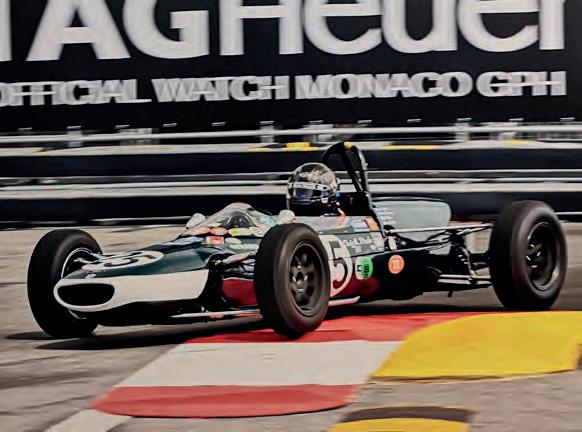

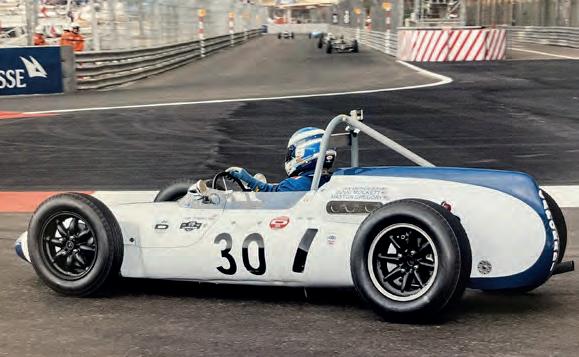
James TIMMS T53
Cette T53 a été vendue neuve en 1961 à l’écurie américaine Camoradi International et engagée pour Masten Gregory dans six Grands Prix du Championnat du Monde, dont celui de Monaco (non-qualifié).
This car was sold new in 1961 to American team Camoradi International and entered for Masten Gregory in six Grand Prix counting for the World Championship, including Monaco Grand Prix (not-qualified).
63 14e GRAND PRIX DE MONACO HISTORIQUE 10-12 MAI 2024 18 25 19
44
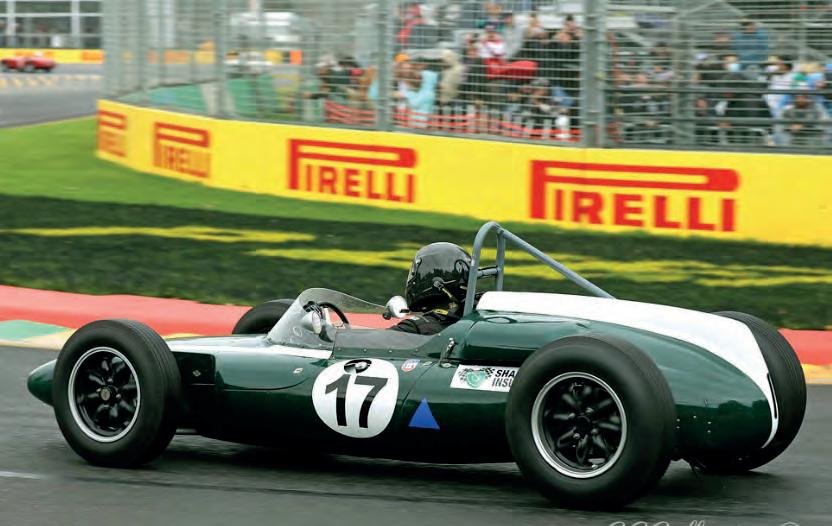
John CLARK T56
Modèle unique assemblé en août 1961 à partir d’un châssis de Formule Junior. Elle a été utilisée en F1 en septembre 1961 par John Surtees lors des essais du Grand Prix d’Italie, puis à Zeltweg (Autriche) et lors de la Gold Cup.
Unique model assembled in August 1961 from a Formula Junior chassis. It was used in F1 in September 1961 by John Surtees during practice for the Italian Grand Prix, then in Zeltweg (Austria) and at the Gold Cup.
Flavio PUCCINELLI T53
Jack Brabham, par ailleurs pilote officiel de Cooper entre 1956 et 1961 (vainqueur à Monaco en 1959, Champion du Monde en 1959 et 1960), a utilisé à titre indépendant, dans des courses de F1 mineures, cette T53 qui a ensuite poursuivi sa carrière en Australie aux mains de Lex Davison.
Jack Brabham, who was also a Cooper works driver from 1956 to 1961 (winner in Monaco in 1959, World Champion in 1959 and 1960), also used this T53 on a private basis, in minor F1 races. It then continued its career in Australia, in the hands of Lex Davison.
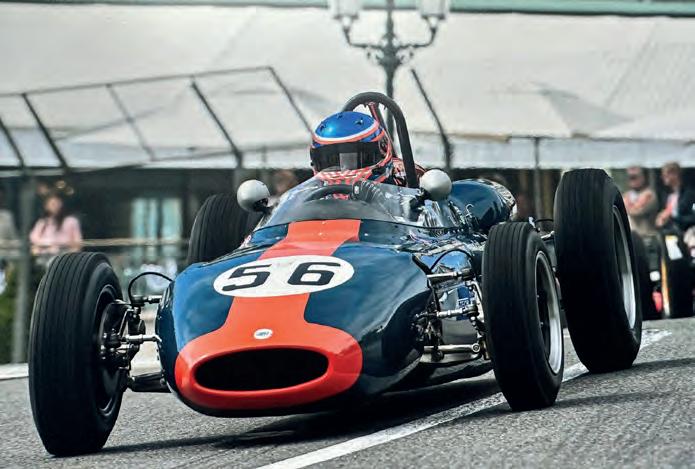
DE TOMASO
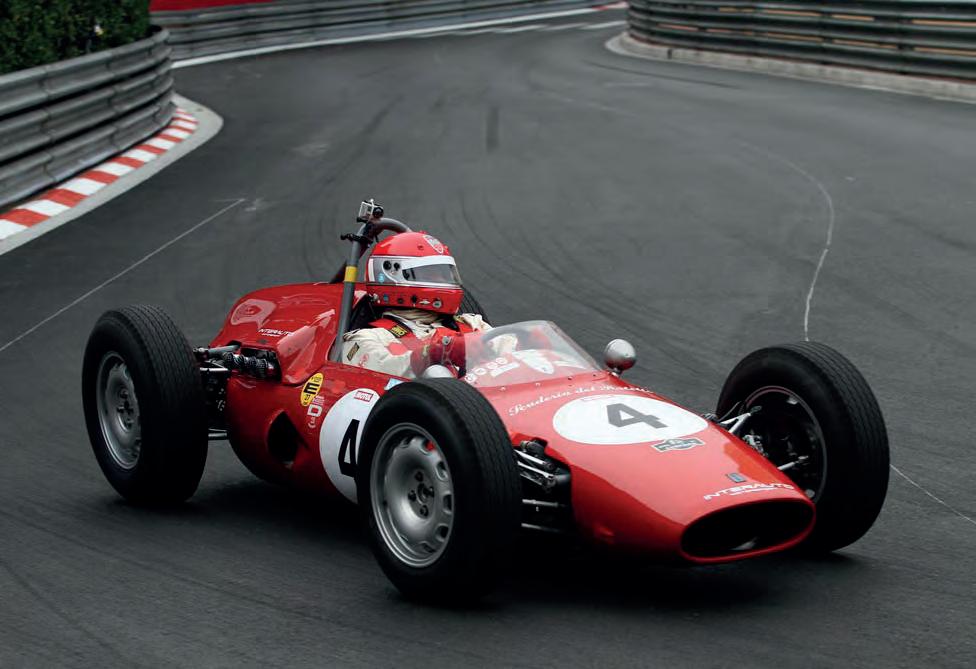
Marco CAJANI
La voiture présentée a été engagée par la Scuderia Settecolli pour Roberto Bussinello en 1961. Terminée en juillet, elle n’a pas participé au Grand Prix de Monaco, mais au Grand Prix d’Italie comptant pour le Championnat du Monde.
This car was entered by Scuderia Settecolli for Roberto Bussinello in 1961. It was finished in July, so it did not take part in the Monaco Grand Prix, but in the Italian Grand Prix counting for the World Championship.
B 64 56 52 54
FERRARI 1512
Sacrée Championne du Monde en 1964 avec John Surtees et la 158, la Scuderia Ferrari sort en 1965 son évolution, dotée d’un moteur flat 12 et désignée 1512. Ce même Surtees (3e en Angleterre), Lorenzo Bandini (2e à Monaco, 4e en Italie) et Pedro Rodriguez (5e aux Etats-Unis) l’ont pilotée. Production: 3 voitures construites en 1965.
Crowned World Champion with John Surtees and the 158 in 1964, Scuderia Ferrari released its evolution in 1965, powered by a flat 12 engine, so they called it the 1512. Title holder Surtees (3rd in England), as well as Lorenzo Bandini (2nd in Monaco, 4th in Italy) and Pedro Rodriguez (5th in the United States), drove this car in the World Championship. Production: 3 cars built in 1965.
Joseph COLASACCO
Cette 1512 n’a participé qu’à deux courses : le Grand Prix de Belgique, avec John Surtees (abandon), et celui d’Italie où Lorenzo Bandini a pris la 4e place.
This car only took part in two races: the Belgian Grand Prix, where John Surtees had to retire, and the Italian Grand Prix, where Lorenzo Bandini took 4th place.
GILBY
FORFAIT

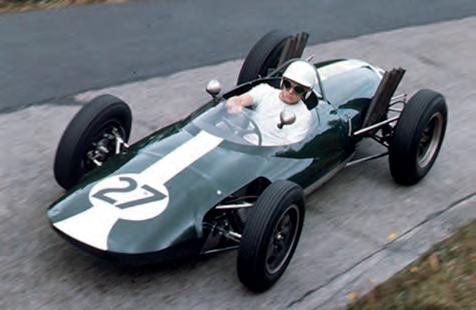
LOLA Mk4
Kyle TILLEY
Cette Gilby a été utilisée en 1961 et 1962 par Keith Greene (principalement dans des courses de F1 mineures). Elle a aussi été engagée trois fois en Championnat du Monde : au Grand Prix de Grande-Bretagne en 1961 avec un moteur Climax (15e), aux Grands Prix d’Allemagne (abandon) et d’Italie (non-qualifiée) en 1962, avec un moteur V8 BRM.
This Gilby was used in 1961 and 1962 (mainly in minor F1 races) by Keith Greene. It was also entered three times in the World Championship: at the 1961 British Grand Prix with a Climax engine (15th), in Germany (retirement) and Italy (non-qualified) in 1962, with a BRM V8 engine.
Producteur de voitures de course en série, Lola construit sa première F1 en 1962 et en confie l’engagement à l’équipe de Reg Parnell qui fait courir John Surtees (4e à Monaco) et Roy Salvadori (abandon à Monaco). Production : 4 voitures construites en 1962.
As a race car manufacturer, Lola builds its first F1 in 1962 and entrusts Reg Parnell’s team to enter it for John Surtees (4th in Monaco) and Roy Salvadori (retirement in Monaco). Production: 4 cars built in 1962.
« Mister John of B »
Voiture de John Surtees pendant presque toute la saison 1962. Entre ses mains, elle a terminé 4e à Monaco. Elle est revenue l’année suivante en Principauté pour servir de mulet à Maurice Trintignant.
This was John Surtees’s car during most of the 1962 season. In his hands, it took 4th place in Monaco. It came back the next year to serve as Maurice Trintignant’s mule.


6 5 14e GRAND PRIX DE MONACO HISTORIQUE 10-12 MAI 2024
4
27
28
LOTUS 18
La Lotus 18 est la première monoplace à moteur arrière de la marque anglaise, et la première Lotus à avoir remporté un Grand Prix du Championnat du Monde. Voiture de l’usine en 1960, elle a été remplacée par la 21 à partir du Grand Prix de Monaco 1961, laissant aux écuries privées le soin d’enrichir son palmarès. Cette année-là, Cliff Allison à Monaco, mais aussi Henry Taylor, Masten Gregory, Lucien Bianchi, Stirling Moss, dans l’écurie UDT Laystall, ou encore Wolfgang Seidel, Ernesto Prinoth et Gerry Ashmore, dans des structures plus modestes, ont compté parmi ses utilisateurs.
Production : 25 voitures construites par Lotus (18 en 1960, 7 en 1961), et deux copies faites chez Parnell.
The Lotus 18 remains the first Lotus single-seater equipped with a rear engine, and the first Lotus to win a World Championship Grand Prix. It was the factory’s car in 1960, but was replaced by the 21 in 1961, from Monaco Grand Prix onwards, allowing private teams to complete its prize list. In 1961, UDT Laystall entered it for Cliff Allison, Henry Taylor, Masten Gregory, Lucien Bianchi and Stirling Moss, in addition to more modest structures for Wolfgang Seidel, Ernesto Prinoth and Gerry Ashmore.
Production: 25 cars built by Lotus (18 in 1960, 7 in 1961) plus 2 copies made by Parnell.

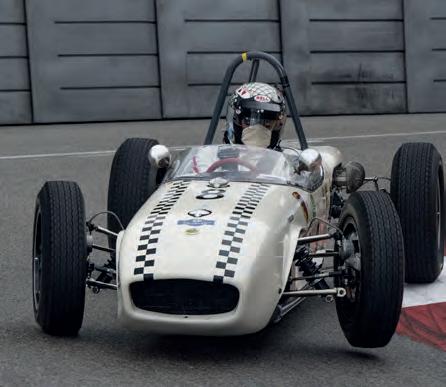
Nick
TAYLOR
Achetée neuve en 1961 par Wolfgang Seidel, qui en confiait le plus souvent le volant à Michael May (abandon à Monaco).
Bought new in 1961 by Wolfgang Seidel, who entrusted it most often to Michael May (retirement in Monaco).
Clinton MCCARTHY
D’abord engagée en F2 par Team Lotus en 1960, cette Lotus 18 a été utilisée par Jim Clark, Innes Ireland et Trevor Taylor. Transformée ensuite en F1 par l’adoption d’un moteur 2.5L, elle a remporté le Lombank Trophy en 1962 à Snetterton, avec Clark au volant, et terminé 2e du Grand Prix des Etats Unis aux mains d’Ireland. Toujours dans le cadre du Team Lotus en 1961, elle a participé aux premières courses de l’ère F1-1500, pilotée trois fois par Jim Clark et par Peter Ryan qui a pris la 9e place du Grand Prix des Etats Unis comptant pour le Championnat du Monde.
Entered in F2 by Team Lotus in 1960, this Lotus 18 was used by Jim Clark, Innes Ireland and Trevor Taylor. Transformed into an F1 car by the adoption of a 2.5L engine, it won the Lombank Trophy in Snetterton, in 1962, with Clark at the wheel, and finished 2nd in the USA Grand Prix, in the hands of Ireland. Still with Team Lotus in 1961, it took part in the first races of the F1-1500 era, driven three times by Jim Clark and Peter Ryan who finished 9th at the US Grand Prix. counting for the World Championship.

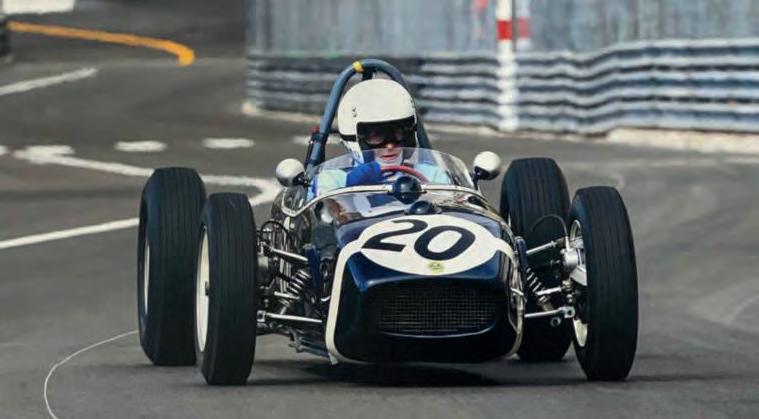
Teifion SALISBURY
Cette glorieuse Lotus 18 a été livrée à Rob Walker en 1960 avec un moteur 2,5L Coventry Climax. Convertie en 1500cc en 1961 pour répondre à l’évolution de la réglementation F1, c’est à son volant que Stirling Moss a remporté les Grands Prix de Monaco et d’Allemagne. Vendue en Italie, elle est revenue à Monaco en 1962 avec Nino Vaccarella (non qualifié).
This glorious Lotus 18 was delivered to Rob Walker in 1960 with a 2.5L Coventry Climax engine. Converted into a 1500cc in 1961 because of the change in F1 regulations, Stirling Moss won in Monaco and Germany at its wheel. Sold in Italy, it returned to Monaco in 1962 with Nino Vaccarella (not qualified).
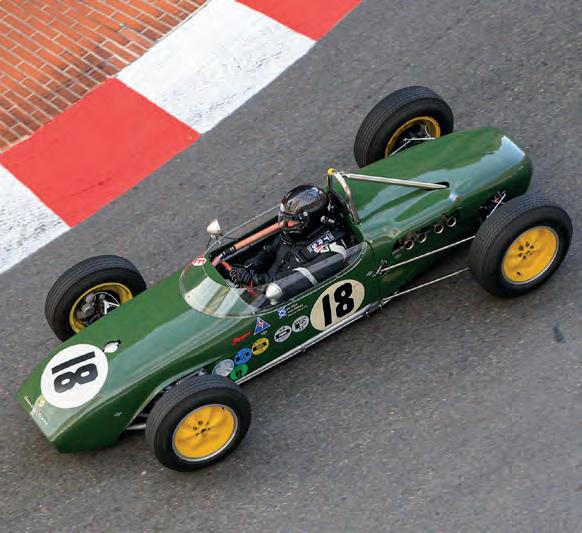
B 8 20 16 66 2

Andrea STORTONI
Cette Lotus 18 a été livrée en 1961 avec un moteur 1500cc correspondant à la nouvelle réglementation de la F1. C’est l’un des quatre exemplaires achetés par l’équipe UDT Laystall. Achevée avec une carrosserie de 21, elle a été le plus souvent utilisée par Masten Gregory.qui a abandonné lors du Grand Prix de Hollande. En 1963, André Pilette a manqué sa qualification lors des Grands Prix d’Allemagne et d’Italie comptant pour le Championnat du Monde.
This car was delivered in 1961 with a 1500cc engine corresponding to the new technical regulations of F1. It is one of the four cars bought by the UDT Laystall team. Finished with a body of 21, it was most often used by Masten Gregory, who retired at the Dutch Grand Prix. In 1963 André Pilette failed to qualify in Germany and Italy.

James HAGAN
Cette Lotus 18 a été livrée en 1960, en tant que F2, et confiée à Dan Gurney. En 1961, elle a été utilisée lors des Grands Prix de Grande-Bretagne et d’Allemagne de F1 par Tony Maggs.
This Lotus 18 was delivered in 1960 as a F2 car and entrusted to Dan Gurney. In 1961, it was driven by Tony Maggs at the British and German Formula 1 Grand Prix.
Erik STAES
Cette Lotus 18/21 a été pilotée en 1962 par Tim Parnell, fils de Reg Parnell qui a participé en 1948 et 1952 au Grand Prix de Monaco et créé sa propre écurie. A son volant, Tim Parnell a disputé quatre Grands Prix de F1 hors-championnat avant de la vendre en Afrique du Sud où Clive Puzey l’a utilisée de 1963 à 1966 dans le championnat local de F1.
This Lotus 18/21 was driven in 1962 by Tim Parnell, a son of Reg Parnell who participated in 1948 and 1952 in the Grand Prix de Monaco and created his own team. At its wheel, Tim Parnell took part in four offchampionship F1 races before selling it in South Africa where Clive Puzey used it from 1963 to 1966 in the local F1 series.

Robert PULLEYN
Livrée neuve à Tony Marsh avec un moteur Climax 1500cc, cette Lotus 18 a d’abord couru en F2 en 1960, avant que l ‘évolution des règlements, un an plus tard, lui permette de devenir une F1. La notoriété insuffisante de son pilote l’a empêchée d’être sélectionnée pour Monaco, mais elle a pris trois départs en Championnat du Monde : louée à Willy Mairesse en Belgique, elle a participé, avec son propriétaire au volant, aux Grands Prix de Grande-Bretagne et d’Allemagne.
Delivered new to Tony Marsh with a Climax 1500cc engine, this Lotus 18 started its career as a F2 car in 1960, before the evolution of the technical regulations, one year later, allowed it to become a F1 car. His insufficient notoriety made it impossible for Marsh to be selected for Monaco but his car still took three starts in the World Championship: rented to Willy Mairesse in Belgium, it took part in the British and German Grand Prix with his owner at the wheel.
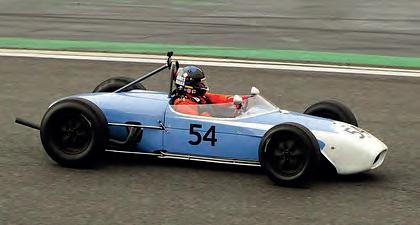
67 14e GRAND PRIX DE MONACO HISTORIQUE 10-12 MAI 2024 34 50 48
21
LOTUS 21
La Lotus 21 apparaît pour la première fois à Monaco en 1961, aux mains de Jim Clark et Innes Ireland, les pilotes de l’usine. C’est une voiture aux lignes affinées, par rapport à celles de la 18, et destinée à assurer l’intérim en attendant le moteur V8.
Production : 10 voitures construites par Lotus (6 en 1961, 4 en 1962).
The Lotus 21 appeared for the first time in Monaco in 1961, in the hands of Jim Clark and Innes Ireland, the works drivers of Colin Chapman’s company. This car had a thinner design compared to the 18 and was destined to wait for the planned V8 engine.
Production: 10 cars built by Lotus (6 in 1961, 4 in 1962).
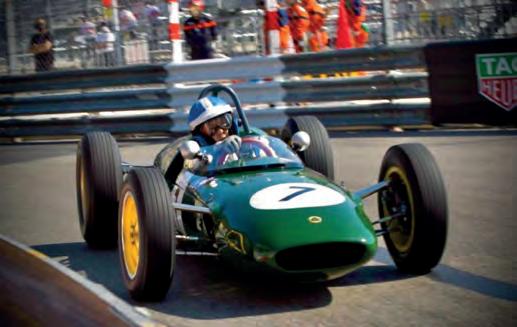
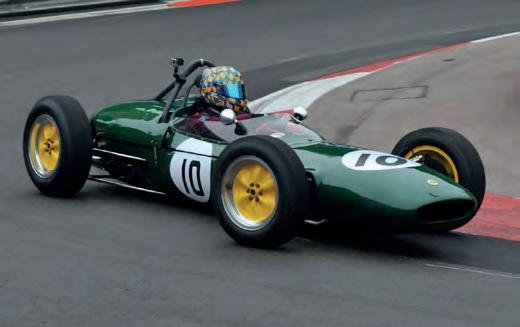
Cette Lotus 21 a débuté fin 1961 aux mains de Jim Clark par une tournée triomphale en Afrique du Sud. Elle est ensuite restée là-bas, aux mains d’Ernie Pieterse qui a participé à trois Grands Prix d’Afrique du Sud comptant pour le Championnat du Monde.
This Lotus 21 started its career at the end of 1961 in the hands of Clark, on the occasion of a triumphant tour of South Africa. It remained there in the hands of Ernie Pieterse who drove it in three editions of the South African Grand Prix counting for the World Championship.
LOTUS 24
Cette Lotus 21 a généralement été pilotée par Innes Ireland, qui a remporté le Grand Prix des USA 1961 à son volant. Stirling Moss l’avait utilisée au Grand Prix d’Italie et Jim Clark à Modène.
This Lotus 21 was most often driven by Innes Ireland, who won the USA Grand Prix in 1961 with it. Stirling Moss used it at the Italian Grand Prix and Jim Clark in Modena.
C’était la voiture du Team Lotus en 1962 pour Jim Clark et Trevor Taylor, mais seulement en début d’année, en attendant l’arrivée de la révolutionnaire 25. Les écuries privées ont dû s’en contenter, en attendant mieux : UDT Laystall pour Masten Gregory et Innes Ireland (occasionnellement Roger Penske), Rob Walker pour Maurice Trintignant, Jack Brabham et Wolfgang Seidel à titre privé.
Production : 12 voitures construites par Lotus (11 en 1962, 1 en 1963), et 4 copies construites par Reg Parnell.
This was the official Team Lotus car in 1962 for Jim Clark and Trevor Taylor, but only in the beginning of the year, while waiting for the arrival of the revolutionary 25. Private teams had no choice but to use it in the meantime: UDT Laystall for Masten Gregory and Innes Ireland (occasionally Roger Penske), Rob Walker for Maurice Trintignant, Jack Brabham and Wolfgang Seidel privately.
Production: 12 cars built by Lotus (11 in 1962, 1 in 1963), and 4 models built by Reg Parnell

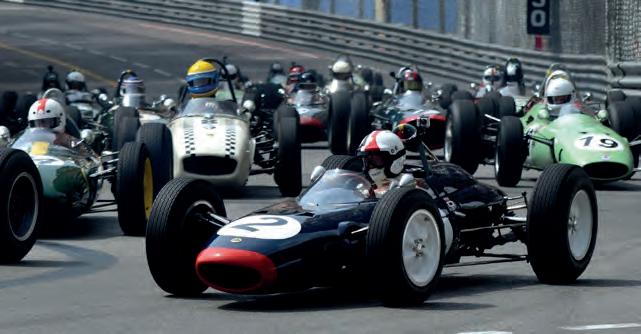
Féderico BURATTI
Cette Lotus 24 est la première copie faite par Reg Parnell en 1964. Elle a été utilisée par son équipe cette année-là, avant d’être vendue avec une carrosserie de Lola à Peter Revson pour la saison 1965 (non qualifié à Monaco).
This Lotus 24 is the first copy made by Reg Parnell in 1964. It was used by his team that year, before being sold with a Lola body to Peter Revson for the 1965 season (not qualified in Monaco).
Mark SHAW
Dan COLLINS
B 7 15 2 68 1

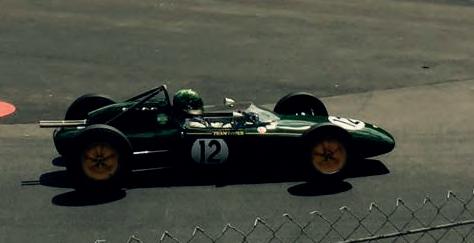
Stephan JOEBSTL
Cette Lotus 24 a été livrée neuve en 1962 à Jack Brabham. Accidentée en Hollande et à Monaco par l’Australien, il l’a amenée dans les points en Belgique et en Grande-Bretagne avant de l’abandonner à partir du Grand Prix d’Allemagne au profit de la première F1 de marque Brabham.
This Lotus 24 was delivered new in 1962 to Jack Brabham. Wrecked in Holland and in Monaco by the Australian driver, it took points in Belgium and Great-Britain before Jack switched to his very first F1 carrying the Brabham name, at the German Grand Prix.

Michel GENDRE
Cette monoplace type 24 est la dernière produite par Lotus. D’abord utilisée officiellement par Trevor Taylor en 1962, elle est passée en 1963 chez Bernard Collomb qui, à son volant, a manqué la qualification à Monaco en 1963 et 1964.
This is the last Type-24 produced by Lotus. It was used in the works team by Trevor Taylor in 1962, and in 1963 it went to Bernard Collomb who failed to qualify in Monaco in 1963 and 1964.


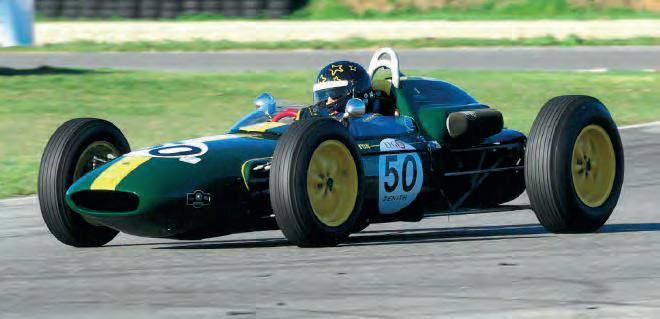
Katsuaki KUBOTA
Cette Lotus 24 est arrivée neuve au Grand Prix de Monaco 1962 pour Masten Gregory, qui a manqué la qualification, puis il l’a pilotée durant tout le reste de la saison. Innes Ireland a pris le relais l’année suivante, (abandon à Monaco), puis Jim Hall en fin de saison. Dotée d’une nouvelle carrosserie, elle a terminé sa carrière active aux mains d’Innes Ireland lors des essais de Monaco en 1964.
This car arrived new at the 1962 Monaco Grand Prix for Masten Gregory, who failed to qualify. He then drove it until the end of the season. Innes Ireland took over the next year (retirement in Monaco), then Jim Hall at the end of the season. It ended its career with a new body, in the hands of Innes Ireland, during practice for Monaco in 1964.

Philipp BUHOFER
La voiture présentée a débuté en 1961 dans le cadre du Team Lotus. Achetée par Jo Siffert en 1962, il l’a utilisée régulièrement en Championnat du Monde, et notamment à Monaco.
The car presented made its official debut in 1961 with Team Lotus. It was then bought by Jo Siffert in 1962 and the Swiss driver drove it often in the World Championship, notably in Monaco.
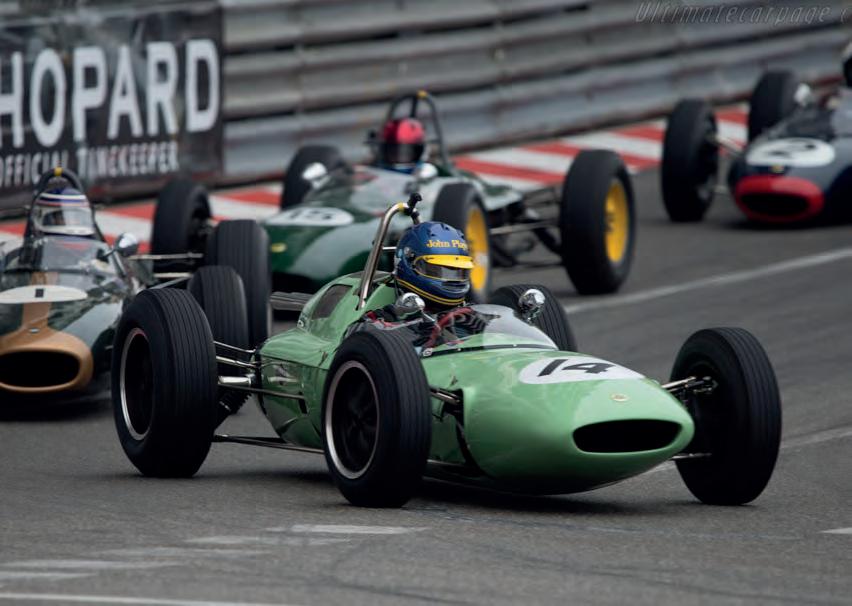
69 14e GRAND PRIX DE MONACO HISTORIQUE 10-12 MAI 2024 23 32 24
3
LOTUS 25
C’est avec ce modèle que Colin Chapman a introduit la construction monocoque qui a rapidement révolutionné la F1. Elle a été engagée par Team Lotus en 1962 et 1963 pour Jim Clark et Trevor Taylor (occasionnellement Peter Arundell).
Production : 7 voitures construites (5 en 1962, 2 en 1963).
With this model, Colin Chapman introduced the monocoque construction that was soon to revolutionize F1. It was exclusively entered by Team Lotus in 1962 and 1963 for Jim Clark and Trevor Taylor (occasionally Peter Arundell).
Production: 7 cars built (5 in 1962, 2 in 1963).


Andy MIDDLEHURST
Cette Lotus 25 est celle avec laquelle Jim Clark a terminé 8e à Monaco en 1963, avant de remporter à son volant sept Grands Prix du Championnat du Monde en 1962 et 1963, l’année de son premier titre mondial. Avec Peter Arundell au volant, cette voiture a encore terminé 3e à Monaco en 1964.
Jim Clark drove this Lotus 25 to an 8th place in Monaco in 1963, before winning seven World Championship Grand Prix at its wheel in 1962 and 1963, the year of his first F1 crown. With Peter Arundell at the wheel, this car finished 3rd in Monaco in 1964.

B 6 70 1
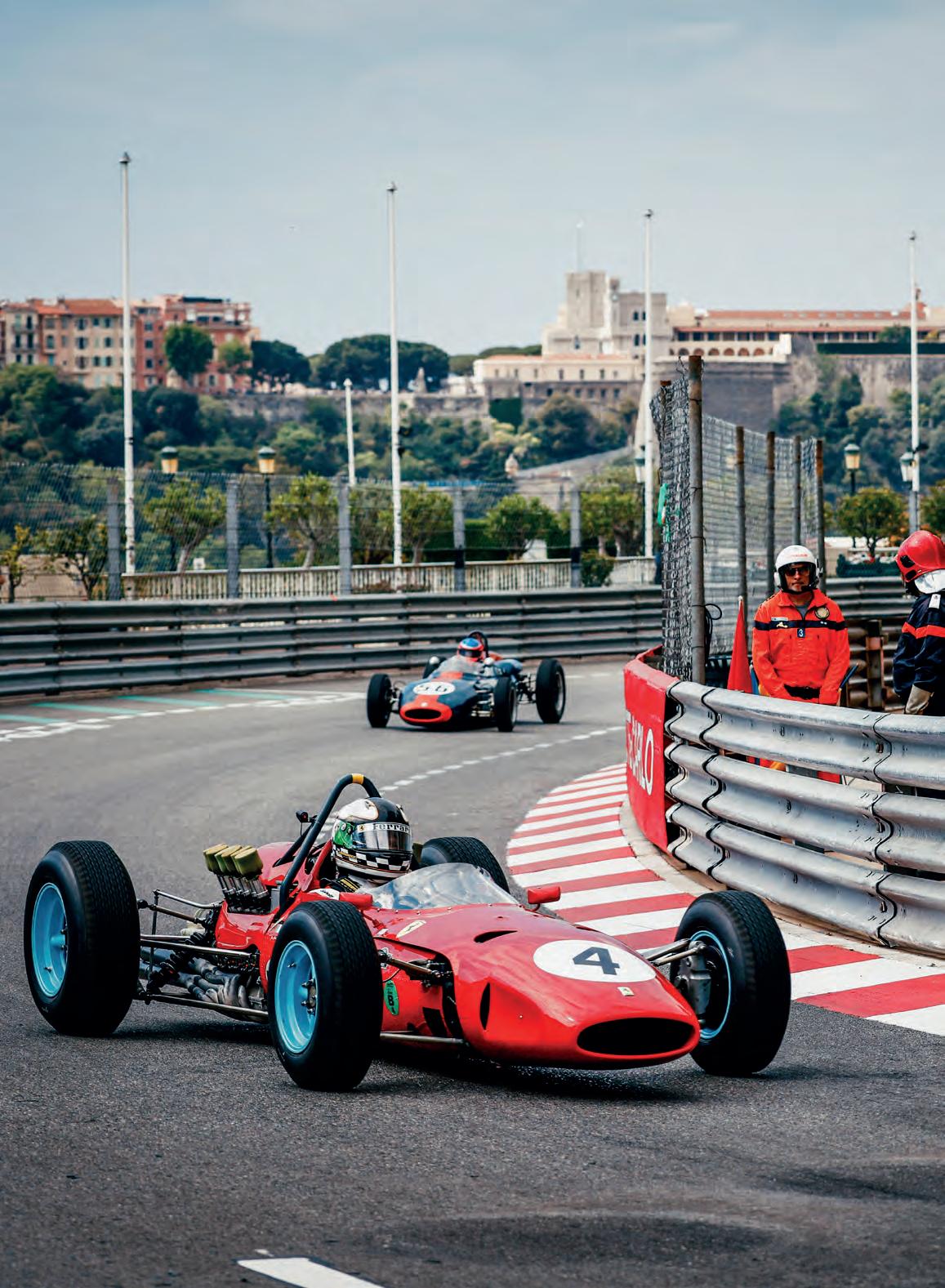
71 14e GRAND PRIX DE MONACO HISTORIQUE 10-12 MAI 2024 B
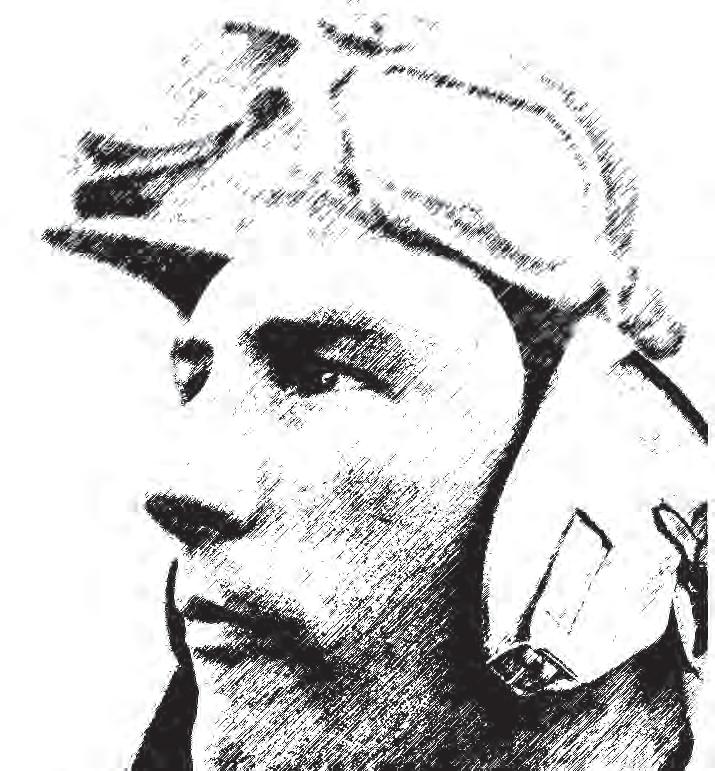
VITTORIO MARZOTTO
VOITURES DE SPORT
À MOTEUR AVANT DE 1952 À 1957
FRONT-ENGINE SPORTS CARS FROM 1952 TO 1957.
REGLEMENT (Extrait, Article 4) / RULE BOOK (Extract, Article 4)
Le 14 e Grand Prix de Monaco Historique est ouvert aux voitures définies par l’annexe K du Code Sportif International de la F.I.A. / The 14th Grand Prix de Monaco Historique is open to cars defined by Appendix K of the FIA International Sporting Code.
Les voitures sont admises en 3 classes / The cars are admitted in 3 classes:
Classe 1 : Voitures dotées d’un moteur de moins de 2L / Cars with an engine capacity of less than 2L
Classe 2 : Voitures de plus de 2L équipées de freins à tambour / Cars with an engine capacity of more than 2L and drum brakes
Classe 3 : Voitures de plus de 2L équipées de freins à disques / Cars with an engine capacity of more than 2L and disk brakes
Les courses Sport ont connu un fort développement au début des années 50. Comme dans les Grands Prix de vitesse, elles étaient souvent, sauf dans les épreuves d’endurance, scindées en deux catégories : moins de deux litres et plus de deux litres. Comme les voitures de Grand Prix, elles ont eu droit à leur Championnat du Monde, à partir de 1953.
La saison 1952 a marqué la volonté de la FIA de voir disparaître les voitures polyvalentes « à garde-boue » aptes à disputer autant les Grands Prix que les courses Sport. Pour ce faire, le règlement des courses Sport internationales a imposé que les ailes fassent désormais corps avec la partie principale de la carrosserie. Cette même année 1952, et pour cette unique occasion, les organisateurs de l’épreuve de Monaco ont abandonné les monoplaces. Les voitures de Sport de plus de 2L ont disputé le dimanche le Grand Prix de Monaco, tandis que la veille, le samedi, les moins de 2L avaient pris part à la Coupe du Prince Rainier.
La Série C du Grand Prix Historique célèbre ces deux évènements et la naissance du Championnat du Monde des voitures de Sport.
Sport races were the subject of strong development in the early 50s. Similarly to the speed Grand Prix series, the Sport races, except for endurance events, were separated in two categories: under 2L and over 2L. And just like Grand Prix cars, a World Championship started in 1953 for sportscars.
Season 1952 is marked by the FIA’s will to get rid of the versatile cars « with mudguards », able and allowed to compete in both Grand Prix racing and Sportscar racing. To achieve this, the new rules for international Sport races imposed that the wings be part of the frame of the car. That same year, in 1952, on a unique occasion, the Monaco organisers abandoned single-seaters. The over-2L sportscars competed on the Sunday for the Monaco Grand Prix, while the under2L sportscars competed the previous day, on Saturday, for the Prince Rainier Cup.
The C-Series of Grand Prix Historique celebrates these two events and the birth of the Sportscar World Championship, the next year
72
1952 : Grand Prix de Monaco (Spor t plus de 2L) : Vittorio Marzotto / Ferrari 225S 1952 : Prix de Monte Carlo (Spor t moins de 2L) : Robert Manzon / Gordini 15S VAINQUEURS DU GRAND PRIX DE MONACO MONACO GRAND PRIX WINNERS 1952
C SÉRIE RACE
LISTE DES ENGAGÉS I ENTRY LIST

73 14e GRAND PRIX DE MONACO HISTORIQUE 10-12 MAI 2024 N° PILOTE / DRIVER NAT CONCURRENT VOITURE / CAR MODÈLE ANNÉE CL. 2 RAWLINGS Thomas GBR SERGISON Ewen CONNAUGHT L2 1948 2 4 FINCKENSTEIN, VON Joackim DEU OTTEN Albert KIEFT SPORT 1954 2 6 LANGEWIESCHE Bernd DEU LANGEWIESCHE Bernd LOTUS MK IX 1955 1 8 BOURNE Richard GBR PAUL Malcolm LOTUS MK X 1955 1 10 SMITH-HILLIARD Max GBR SMITH-HILLIARD Max LOTUS MK X 1955 1 12 STAES Erik BEL STAES Erik LOTUS MK XI 1956 1 16 INCERTI Carlo ITA INCERTI Carlo OSCA MT4-AD 1955 1 18 SUCARI Adrian ARG SUCARI Adrian MASERATI A6GCS 1954 1 20 BALLY Jean-Jacques FRA BALLY Jean-Jacques MASERATI A6GCS 1953 1 22 SIELECKI Carlos ARG SIELECKI Carlos MASERATI A6GCS 1954 1 24 RATHENOW Lutz DEU RATHENOW Lutz VERITAS RS2OOO 1948 1 26 WARD Steve GBR WARD Steve FRAZER NASH Le Mans Replica (MK1) 1950 1 28 CHILD Tim GBR CHILD Tim FRAZER-NASH Le Mans Replica (MK2) 1952 1 30 BRESLOW John USA MARCAIS Oliver FRAZER-NASH Le Mans Replica (MK2) 1952 1 32 MACCHI Pierre FRA MACCHI Pierre FRAZER-NASH Le Mans Coupé 1953 1 34 GRIFFIN Paul GBR GRIFFIN Paul CONNAUGHT ALSR 1954 1 36 WOOD Anthony GBR WOOD Anthony LISTER BRISTOL 1955 1 38 BOND Stephen GBR BOND Stephen LISTER FLAT IRON 1955 1 50 BERGEL SAINZ DE BARANBA Jaime ESP DRIVEX PEGASO Z102 1952 2 52 FRANKLIN David GBR FRANKLIN David FERRARI 250 MM 1953 2 54 OTTIS Tazio USA OTTIS Tazio FERRARI 750 MONZA 1955 2 56 WEBB Nigel GBR WEBB Nigel JAGUAR C TYPE 1952 3 58 BERT Nicolas BEL BERT Nicolas JAGUAR C TYPE 1952 2 60 HALUSA Niklas AUT HALUSA Martin JAGUAR D TYPE 1954 3 62 HUNT Martin GBR HUNT Martin HWM-JAGUARSPORT 1954 2 64 FISKEN Gregor GBR FISKEN Gregor HWM Jaguar 1953 2 66 KYVALOVA Katarina DEU KYVALOVA Katarina COOPER-JAGUART33 1954 3 68 ELICABE Manuel ARG ELICABE Manuel COOPER-JAGUAR T38 (MK2) 1955 3 70 WAKEMAN Frederic GBR WAKEMAN Frederic COOPER-JAGUART38 1955 3 72 FRIEDRICHS Wolfgang DEU FRIEDRICHS Wolfgang ASTON-MARTIN DB3S 1954 3 74 CASTELEIN Maxime BEL CASTELEIN Maxime ASTON MARTIN DB3S 1953 3 76 SIELECKI Mathias ARG SIELECKI Mathias ASTON-MARTIN DB3S 1955 3 78 HAMELMANN Stefan DEU METHUSALEM RACING MASERATI A6GCS 1954 1 80 WILSON Richard GBR WILSON Richard MASERATI 250S 1957 2 82 FIERRO-ELETA Guillermo ESP FIERRO-ELETA Guillermo MASERATI 300S 1957 2 84 HUERTGEN Claudia DEU METHUSALEM RACING MASERATI 300S 1955 2 86 BAKER Brad CAN BAKER Brad MASERATI 300S 1955 2 88 O'NEILL Jeffrey USA O'NEILL Jeffrey MASERATI 350S 1956 2 90 MARTY Didier FRA MARTY Didier ALLARD J2 1950 2 1 Voiture victorieuse d’un ou plusieurs Grand Prix du Championnat du Monde Voiture présente en période au Grand Prix de Monaco
ALLARD J2
A Monaco, en 1952, deux Allard J2 étaient au départ : celle à moteur Cadillac d’Anthony Hume et celle à moteur Chrysler de Fernando de Mascarenhas. Elles ont abandonné toutes les deux.
Production : 90 exemplaires produits en 1950 et 1951
At Monaco in 1952, two Allard J2s were on the starting grid: Anthony Hume's Cadillac-powered car and Fernando de Mascarenhas' Chrysler-powered car. Both cars had to retire.
Production: 90 cars produced in 1950 and 1951.

ASTON MARTIN DB3S
Didier MARTY
Cette Allard J2 a été livrée neuve avec un moteur Cadillac en juin 1950 à Fred Wacker, alors président du Sports Car Club of America (SCCA), qui l’a utilisée avec succès jusqu’à fin 1952 (3e du Grand Prix de Watkins Glen et vainqueur des 6 Heures de Sebring).
This car was delivered new with a Cadillac engine in June 1950 to Fred Wacker, who chaired the Sports Car Club of America (SCCA) at that time. He used it successfully until the end of 1952 (3rd of the Watkins Glen Grand Prix and winner of the 6 Hours of Sebring).
L’Aston DB3S a été produite à partir de 1953 pour disputer le Championnat du Monde des Sports, nouvellement créé. Modèle victorieux aux 9 Heures de Goodwood en 1953 et 1955, ainsi qu’au Tourist Trophy en 1953, elle a succédé à la DB3.
Production : 30 voitures produites entre 1953 et 1957 (10 « usine », 20 « client »).
The Aston DB3S was produced from 1953 to compete in the newly created World Sports Championship. As a successor to the DB3, it won the Goodwood 9 Hours in 1953 and 1955, as well as the Tourist Trophy in 1953.
Production: 30 cars produced between 1953 and 1957 (10 “factory” cars, 20 “customer” cars)
Wolfgang FRIEDRICHS
Cette DB3S « client » a été livrée à Graham Whitehead, qui a participé notamment aux 12 Heures de Hyères en 1955 avec son demifrère Peter.
This car was delivered to Graham Whitehead, Peter’s half-brother, with whom he took part in the 12 Hours of Hyères in 1955, in the South of France.
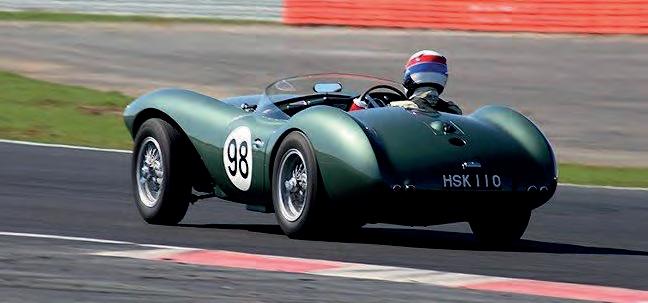
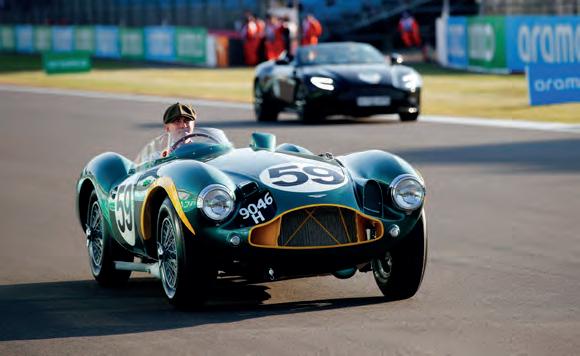
Maxime CASTELEIN
Cette DB3S était à l’origine une voiture d’usine pilotée par Reg Parnell, Roy Salvadori, Peter Collins (abandon aux Mille Miglia en 1955), Stirling Moss, Tony Brooks : autant de grands pilotes qui ont fait les beaux jours du Grand Prix de Monaco.
This car was initially a factory car driven by Reg Parnell, Roy Salvadori, Peter Collins (retirement at the 1955 Mille Miglia), Stirling Moss and Tony Brooks: a bunch of great drivers who graced the Monaco Grand Prix with their presence over the years.
C 90 74
72 74
Mathias SIELECKI
Cette DB3S dont la carrière fut tourmentée, a été vendue neuve à Graham Whitehead qui l’a utilisée en 1957 et 1958. Il a terminé 2e des 24 Heures du Mans, en équipe avec son demi-frère Peter qui avait participé au Grand Prix de Monaco 1950 sur Ferrari.
This DB3S had a tormented career after being sold new to Graham Whitehead who used it in 1957 and 1958. He took the 2nd place at Le Mans 24 Hours with his half-brother Peter who had participated in the 1950 Monaco Grand Prix in a Ferrari.
CONNAUGHT L2
C’est en 1948 avec la L, devenue rapidement L2, que débute l’histoire de Connaught. Il s’agit alors de produire une biplace pour courir. Le modèle est composé de pièces venant d’un autre constructeur britannique, Lea-Francis. Le moteur 4 cylindres 1767cc a fait l’objet d’un développement chez Monaco Engineering et le tout est habillé d’une carrosserie spyder biplace originale en alu. Son prix et ses performances en limiteront la diffusion.
Production : 6 unités produites en 1948 et 1949.
The history of Connaught Engineering started in 1948 with the L, which quickly became L2. The aim was to produce a two-seater for racing. The first model was made of spare parts coming from another British constructor of the time, Lea-Francis. The 4-cylinder 1767cc engine was developed at Monaco Engineering and the car was dressed up with an original two-seater spyder body in aluminum. Its price and performances limited its sales.
Production: 6 units produced in 1948 and 1949.

Thomas RAWLINGS
Immatriculée fin 1949, cette Connaught a été active en Angleterre. Arthur Goldthorpe, son troisième propriétaire, l’a équipée en 1953 d’un moteur 2,5L pour la rendre plus performante, notamment à Goodwood.
Registered at the end of 1949, this Connaught was active in England. Arthur Goldthorpe, its third owner, equipped it in 1953 with a 2.5L engine to make it more efficient, especially at Goodwood.

CONNAUGHT ALSR
Cette Connaught ALSR est basée sur un châssis tubulaire très proche de la F2 type A dont elle utilise un maximum de composants. Une des deux seules autos produites a participé sans résultat à l’édition tragique des 24 Heures du Mans en 1955.
Production: 2 unités produites en 1954.
This car is based on a tubular body very similar to the F2 type A (see text for B-Series) of which it shares a maximum of parts. One of the two cars produced took part, with no significant result, in the tragic 1955 edition of Le Mans 24 Hours.
Production: 2 units produced in 1954.

Paul GRIFFIN
Cette ALSR est la première produite, livrée à John Coombs (qui s’est retiré à Monaco, jusqu’à son décès en 2013). Elle a été pilotée par John Coombs, Les Leston et Stirling Moss (Coupes du Salon 1954 à Montlhéry, Oulton Park en 1955).
This is the first ALSR produced, delivered to John Coombs (who lived in Monaco until his death in 2013). It was driven by John Coombs, Les Leston and Stirling Moss (Coupes du Salon 1954 in Montlhéry, Oulton Park in 1955).
75 14e GRAND PRIX DE MONACO HISTORIQUE 10-12 MAI 2024
76 2 34
COOPER-JAGUAR T33
Suivant l’exemple d’HWM en 1953, Cooper, jusque-là plutôt spécialisé dans les voitures à moteur 2L Bristol, a été l’un des premiers constructeurs britanniques à construire des biplaces utilisant le 6 cylindres Jaguar XK des types C et D, un exemple suivi plus tard par Tojeiro en 1956 et Lister en 1957.
Production: 3 exemplaires en 1954.
Following the example of HWM in 1953, Cooper, until then a specialist in 2L Bristol engines, was one of the first to build two-seaters using the 6-cylinder Jaguar XK of types C and D, an example followed later by Tojeiro in 1956 and Lister in 1957.
Production: 3 cars produced in 1954.
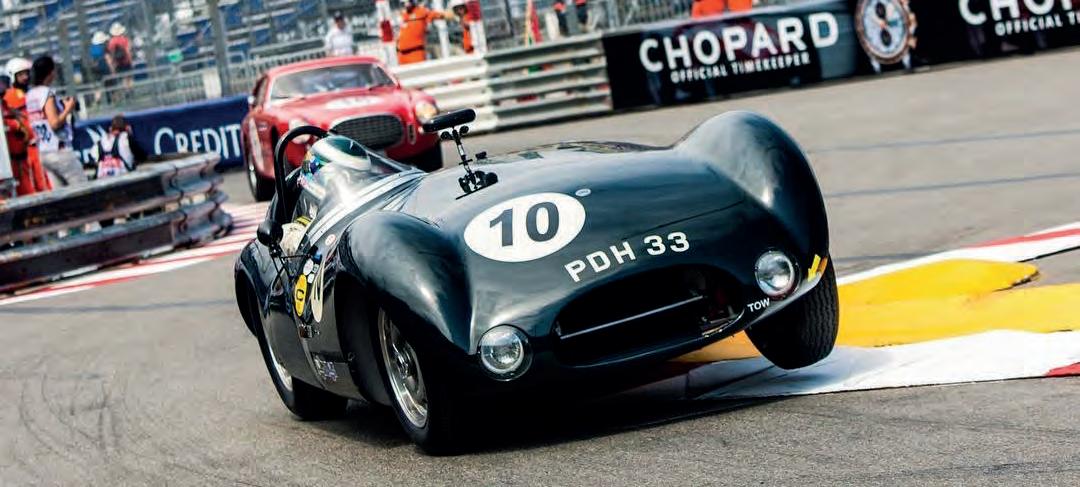
COOPER-JAGUAR T38
Katarina KYVALOVA
Livrée à Bertie Bradnack, cette Cooper T33 a participé aux 12 Heures d’Hyères et aux 9 Heures de Goodwood en 1955.
Delivered to Bertie Bradnack, this car raced at the 12 Hours of Hyères and the 9 Hours of Goodwood in 1955.
La Cooper T38 est une simple évolution de la T33 de la saison 1954. La première produite a participé aux 24 Heures du Mans aux mains de Peter Whitehead, son propriétaire et ancien vainqueur de l’épreuve sur Jaguar C en 1951.
Production: 3 voitures produites en 1955.
The Cooper T38 is a simple evolution of the T33 of the 1954 season. The first car raced at Le Mans 24 Hours in the hands of Peter Whitehead, who had won there in 1951 (in a Jaguar C).
Production: 3 cars produced in 1955.
Manuel ELICABE
Cette Cooper T38 a été livrée neuve à Michael Head qui l’a utilisée avec succès dans nombre de meetings anglais. Il était le père de Patrick Head, le célèbre ingénieur de Williams F1.
This car was delivered new to Michael Head who used it with success in many English meetings. He was the father of Patrick Head, the Williams F1 engineer.


Fréderic WAKEMAN
Cette Cooper T38 a été utilisée par Tommy Sopwith en 1955 sur les circuits britanniques.
This car was used by Tommy Sopwith in 1955 on British circuits.
C 66 76
68 70
FERRARI 250 MM
Adaptation à la série du prototype 250 S V12-3L (victoire aux Mille Miglia et aux 12 Heures de Pescara en 1952 pour Giovanni Bracco et Paolo Marzotto), la 250 MM est la biplace compétition-client qui a succédé aux 225 S ayant pris les trois premières places du Grand Prix de Monaco 1952. La plupart des 250 MM étaient carrossées par Pininfarina en Berlinettes (17) ou par Vignale en Spyders. Au départ des Mille Miglia 1953, elles étaient 9 dont les berlinettes Pininfarina de Paolo Marzotto, frère du vainqueur du Grand Prix de Monaco 1952, et la voiture d’usine de Bracco.
Production : 33 voitures construites entre 1953 et 1956.
The 250 MM was a road version of the 250 S V12-3L prototype (winner of the Mille Miglia and 12 Hours of Pescara in 1952 with Giovanni Bracco and Paolo Marzotto), as a two-seater customer car following in the footsteps of the 225 S taking the first three spots at Monaco Grand Prix 1952. Most of the 250 MMs were bodied by Pininfarina as Berlinettes (17), or by Vignale as Spyders. At the start of the 1953 Mille Miglia, there were 9 of them, including the Pininfarina berlinettes of Bracco, a factory car, and Paolo Marzotto, brother of Vittorio, the winner of the 1952 Monaco Grand Prix.
Production: 33 cars built between 1953 and 1956.
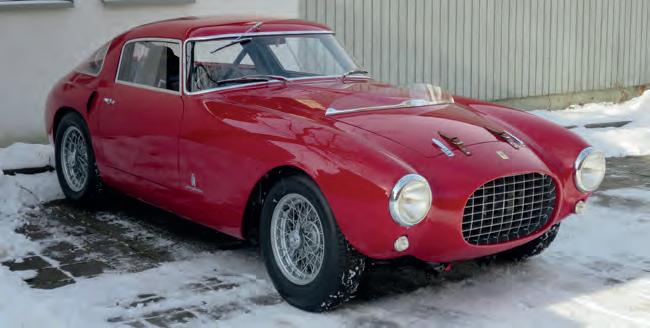
FERRARI 750 MONZA
David FRANKLIN
Cette 250 MM fait partie de la série des 17 berlinettes carrossées par Pininfarina. Elle a disputé le Tour de Sicile et les Mille Miglia en 1953, pilotée par Paolo Marzotto (abandon). Paolo était le frère de Vittorio, vainqueur du Grand Prix de Monaco 1952.
This 250 MM is part of the series of 17 Pininfarina saloon cars. It competed in the Tour of Sicily and the 1953 Mille Miglia, driven by Paolo Marzotto (retirement, brother of Vittorio, the winner of the 1952 Monaco Grand Prix.
La 3L 4 cylindres 750 Monza tient son appellation du doublé réalisé à Monza lors du Grand Prix Supercortemaggiore en 1954, quand Hawthorn/Maglioli ont terminé devant Trintignant/Gonzales. La même année, l’Argentin a remporté le Grand Prix du Portugal et Hawthorn/Trintignant le Tourist Trophy, qui comptait pour le Championnat du Monde. Excepté un seul exemplaire carrossé en spyder par Pininfarina, toutes les autres ont été habillées en spyder par Scaglietti.
Production: 31 voitures construites en 1954-1955.
The 3L 4-cylinder 750 Monza holds its name after the 1-2 achieved in Monza at the Grand Prix Supercortemaggiore in 1954, when Hawthorn/Maglioli finished in front of Trintignant/Gonzales. Then, the Argentinian driver won the Portuguese Grand Prix and Hawthorn/Trintignant won the Tourist Trophy counting that year for the World Championship. With the exception of one car bodied as a spyder by Pininfarina, all the other cars were dressed as spyders by Scaglietti. Production: 31 cars built in 1954-1955.
Tazio OTTIS
Cette 750 Monza a fait toute sa carrière aux Etats Unis, pilotée notamment par Phil Hill et Carroll Shelby. Ils se sont partagé son volant aux 12 Heures de Sebring, terminant 2e de cette manche du Championnat du Monde derrière la Jaguar D de Hawthorn/Walters.
This 750 Monza made its entire career in the United States, notably driven by Phil Hill and Carroll Shelby. They shared the wheel at the 12 Hours of Sebring, finishing 2nd in this round of the World Championship behind the Jaguar D of Hawthorn/Walters.

77 14e GRAND PRIX DE MONACO HISTORIQUE 10-12 MAI 2024 52 54
FRAZER NASH
Steve WARD
Cette Frazer Nash, pilotée en 1951 et 1952 par Roy Salvadori (engagé à Monaco en 1957, 1958 et 1959), lui a permis entre autres de terminer 4e du British Empire Trophy en 1952.
This car, driven in 1951 and 1952 by Roy Salvadori (who competed in Monaco in 1957, 1958 and 1959), enabled him to finish 4th in the 1952 British Empire Trophy.


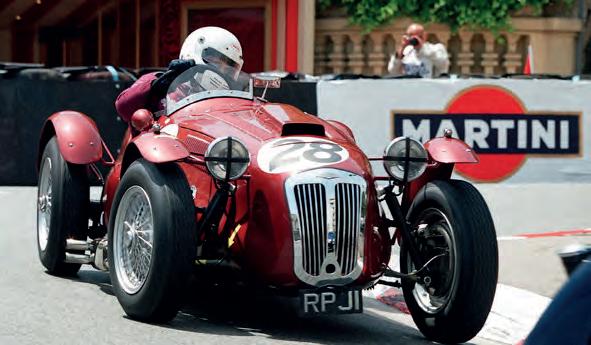
John BRESLOW
Cette Frazer Nash est née monoplace avec châssis et mécanique identiques à ceux du modèle Le Mans Replica Mk2. Sous sa forme initiale, elle a participé avec Ken Wharton aux Grands Prix de Suisse, de Belgique et de Hollande 1952, comptant pour le Championnat du Monde, avant d’être transformée en biplace pour la saison 1953.
Born as a single-seater with a chassis and mechanics identical to the Le Mans Replica Mk2. Under its initial form, it participated, with Ken Wharton, to the Swiss, the Belgian and the Dutch Grand Prix in 1952, before being transformed to a two-seater for the 1953 season.
30 26 28
Tim CHILD
Cette Frazer Nash a terminé 3e du Grand Prix de Monaco avec Tony Crook en 1952. Elle a aussi été utilisée la même année dans des épreuves internationales réservées aux monoplaces, comme l’International Trophy et le Grand Prix de Grande-Bretagne (comptant pour le Championnat du Monde).
This car finished 3rd of the Monaco Grand Prix with Tony Crook in 1952. It was also used, the same year, in international events reserved for single-seaters such as the International Trophy and the British Grand Prix (counting for the World Championship).

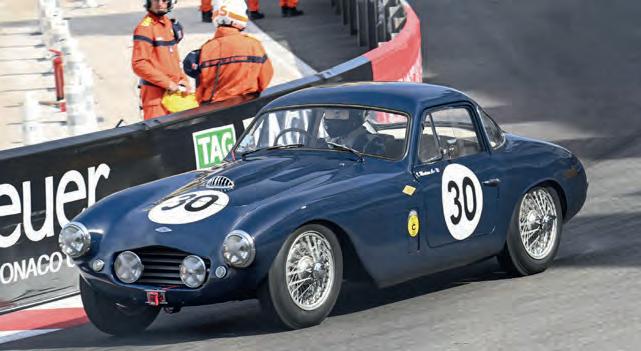
Pierre MACCHI
Doté d’un châssis Mk2, ce coupé, le quatrième produit, a participé deux fois aux 24 Heures du Mans : en 1953 avec Wharton/Mitchell (13e du classement général, 1ere en 2L) et encore en 1954 (11e aux mains de Gatsonides/Beckart).
Equipped with a Mk2 chassis, this coupé, the 4th produced, took part in two successive editions of Le Mans 24 Hours: in 1953 with Wharton/Mitchell (13th and 1st in the 2L class), and again in 1954 (11th in the hands of Gatsonides/Beckart).
C 78
32

Martin HUNT
Cette HWM a disputé les saisons 1951 et 1952 sous sa forme initiale de monoplace de F2, pilotée le plus souvent en 1951 par Stirling Moss et en 1952 par Tony Gaze. Sous sa forme biplace actuelle, elle a débuté par une 7e place aux 12 Heures de Reims en 1954 avec l’équipage Tony Gaze/GrahamWhitehead.
This HWM took part in the 1951 and 1952 seasons in its initial F2 single-seater condition, driven most often by Stirling Moss in 1951 and Tony Gaze in 1952. In its current two-seater form, its debut was a 7th place at the 12 Hours of Reims in 1954 with Tony Gaze/Graham Whitehead.
JAGUAR C
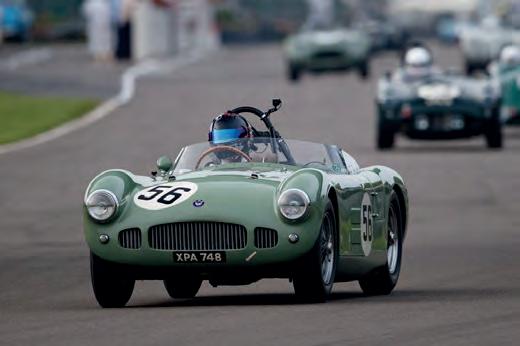
Gregor FISKEN
Cette biplace HWM de 1955 a été complétée en prenant comme base l’une des monoplaces de 1951 utilisées occasionnellement en Championnat du Monde de F1, comme les deux biplaces qui l’avaient précédée en 1953 et 1954.
This 1955 HWM two-seater was completed on the basis of one of the 1951 single-seaters used occasionally in the F1 World Championship, as were both two-seaters that preceded it in 1953 and 1954.
C’est le modèle victorieux des 24 Heures du Mans en 1951 et 1953. Deux Jaguar C se trouvaient aussi au départ du Grand Prix de Monaco en 1952 : celle qui était pilotée par Stirling Moss a mené puis abandonné sur accident, et celle de Tom Wisdom a terminé 6e
Production: 54 unités produites.
This was the winning model of Le Mans 24 Hours in 1951 and 1953. Two Jaguar C were also on the starting grid for Monaco Grand Prix in 1952 : the one driven by Stirling Moss lead the race before having to retire because of a wreck, whereas the other car, driven by Tom Wisdom, took 6th place.
Production: 54 units produced

Nigel WEBB
Cette Jaguar C, la 4e produite mais la toute première de l’année 1952, a été la première livrée à un pilote privé, en l’occurrence Duncan Hamilton vainqueur avec Tony Rolt des 24 Heures du Mans 1953 sur une Jaguar C officielle.
This was the 4th Jaguar C produced but the first one in 1952. It was also the first delivered to a private driver, Duncan Hamilton, the future winner (with Tony Rolt) of Le Mans 24 Hours in 1953 aboard a works Jaguar C.
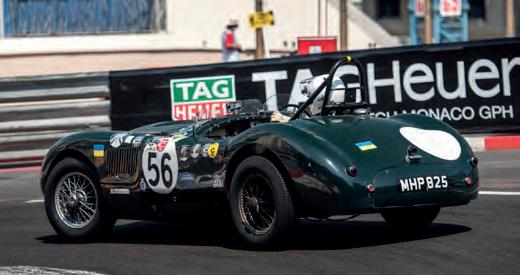
Nicolas BERT
Cette Jaguar C a été livrée neuve à Leslie Johnson, qui ne la pilota en course que lors des Mille Miglia 1953. Il était depuis 1948 actionnaire majoritaire de la firme ERA et avait inscrit sa type E au Grand Prix de Monaco 1948.
This Jaguar C was delivered new to Leslie Johnson who only drove it in a race during the Mille Miglia in 1953. He was, since 1948, the majority shareholder of the ERA company and had registered his E-type at the 1948 Monaco Grand Prix.
79
14e GRAND PRIX DE MONACO HISTORIQUE 10-12 MAI 2024 62 56 64 58
HWM (Jaguar)
JAGUAR D
Ce modèle a remporté les 24 Heures du Mans en 1955, 1956 et 1957, les 12 Heures de Reims en 1954, 1956, les 12 Heures de Sebring en 1955.
Production : 87 produites entre 1954 et 1955 (dont 16 XKSS).
Winner of Le Mans 24 Hours in 1955, 1956 and 1957, of the 12 Hours of Reims in 1954 and 1956, of the 12 Hours of Sebring in 1955.
Production: 87 produced between 1954 and 1955 (including 16 XKSS).

Niklas HALUSA
Cette Jaguar D, complétée en 1954 pour l’écurie officielle, a notamment terminé 2e des 24 Heures du Mans et des 12 Heures de Reims, aux mains de Duncan Hamilton et Tony Rolt. En fin d’année, elle a été exposée au Salon de l’Automobile à Paris.
This Jaguar D, completed in 1954 for the official team, finished 2nd in Le Mans 24 Hours and at the 12 Hours of Reims, in the hands of Duncan Hamilton and Tony Rolt. At the end of the year, it was exhibited at the Paris Motor Show.
FINCKENSTEIN, Von Joackin
Cette Kieft, dotée à l’origine d’un moteur 1500cc MG, a participé aux 24 Heures du Mans 1954 avant de terminer sa carrière en France en 1955 sur le circuit de Montlhéry, disputant notamment les 24 Heures de Paris qui remplaçaient le Bol d’Or.
This Kieft, originally equipped with a 1500cc MG engine, took part in Le Mans 24 Hours 1954 before ending its career in France in 1955 on the Montlhéry track, where it participated in the 24 Hours of Paris replacing the Bol d'Or.
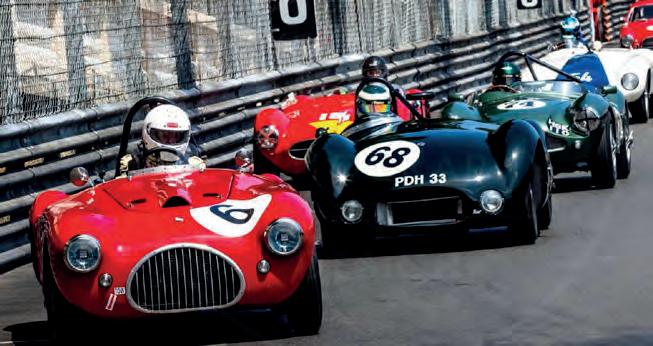

Bernd LANGUEWIESCHE MK IX
Cette Lotus 10 a été exposée pour la première fois sur le stand Lotus au Motor Show de Londres, à Earl’s Court, en octobre 1955. Elle avait la particularité d’être dotée de freins à disque, ce qui était à l’époque exceptionnel et une première pour la marque du grand innovateur Colin Chapman. Elle a ensuite fait carrière en Amérique du Nord, avec un certain succès.
This car was exhibited on the Lotus stand at the London Motor Show at Earl’s Court in October 1955, with disc brakes, which was exceptional at the time and a premiere for Colin Chapman's innovative brand. It then became successful in North America.
C 60 80
4 6
KIEFT LOTUS
Ricard BOURNE
MK X
Cette Lotus 10 est le premier des 6 exemplaires produits. Neuve en 1955, elle a été pilotée par Mike Anthony lors des principaux meetings britanniques.
This Lotus 10 was the first of 6 cars produced. New in 1955, it was driven by Mike Anthony at the main British meetings.


Cette Lotus 11, type Le Mans, est l’une des trois premières de la série. Expédiée neuve aux Etats Unis en 1956, elle y est restée active jusqu’en 1961.
This Le Mans-type car was one of the first three in the Lotus 11 series. It was shipped new to the United States in 1956, where it remained active until 1961.
LISTER BRISTOL
Max SMITH-HILLIARD
MK X
Cette Lotus 10 a été livrée neuve à Cliff Davis qui a obtenu en 1955 et 1956 de très bons résultats sur les circuits britanniques : 3e de sa classe dans l’épreuve disputée en ouverture du Grand Prix de Grande-Bretagne à Aintree , 2e de sa classe aux 9 Heures de Goodwood.
This car was delivered new to Cliff Davis who claimed very good results, in 1955 and 1956, on British circuits: 3rd of its class in the opening event of the British Grand Prix at Aintree, 2nd of its class at the 9 Hours of Goodwood.
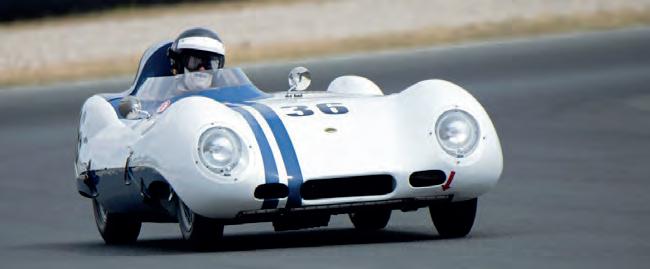
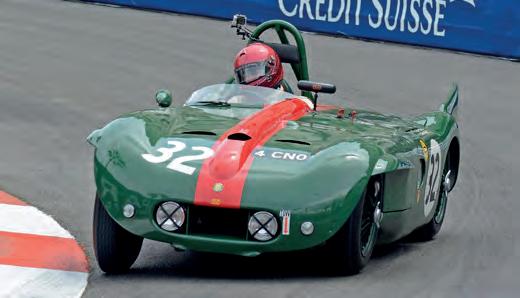
Anthony WOOD
Cette Lister Bristol, la deuxième produite en 1955, a été livrée à William Black carrossée par Lucas. Il en a confié le volant à Jack Sears, qui l’a notamment pilotée au British Empire Trophy.
This car was the second produced in 1955. It was delivered to William Black with bodywork by Lucas. He entrusted it to Jack Sears, who drove it notably at the British Empire Trophy.

Stephen BOND
Cette Lister est d’abord sortie en 1955 avec un moteur Riley pour John Horridge, qui l’a pilotée ainsi aux 24 Heures de Paris, avant de la doter d’un moteur Bristol pour 1956. Il en a partagé le volant cette année-là avec David Piper aux 12 Heures de Reims.
This Lister was first produced in 1955 with a Riley engine for John Horridge, who used it in the Paris 24 Hours, before fitting it with a Bristol engine for 1956. He shared the wheel that year with David Piper at the 12 Hours of Reims.
Erik STAES MK XI
81 14e GRAND PRIX DE MONACO HISTORIQUE 10-12 MAI 2024 8 10 12
36 38
MASERATI A6GCS Série 2
Développement de l’A6GCS à garde-boue née en 1947, cette 2e série d’A6GCS sortie à partir de 1953 comptait parmi les deux litres les plus performantes du moment. Juan-Manuel Fangio (Targa Florio 1953), Luigi Musso (3e des Mille Miglia 1954) et Roy Salvadori comptent parmi ses pilotes de renom, plus ou moins régulièrement, au plus haut niveau. Production : 53 exemplaires produits entre 1953 et 1955 (dont 5 berlinettes).
As a development of the A6GCS with mudguard born in 1947, this second series, which started in 1953, was amongst the best performing 2L of its time. JuanManuel Fangio (Targa Florio 1953), Luigi Musso (3rd at Mille Miglia 1954) and Roy Salvadori were some of the top drivers of this car at the highest level. Production: 53 models produced between 1953 and 1955 (including 5 berlinettes).
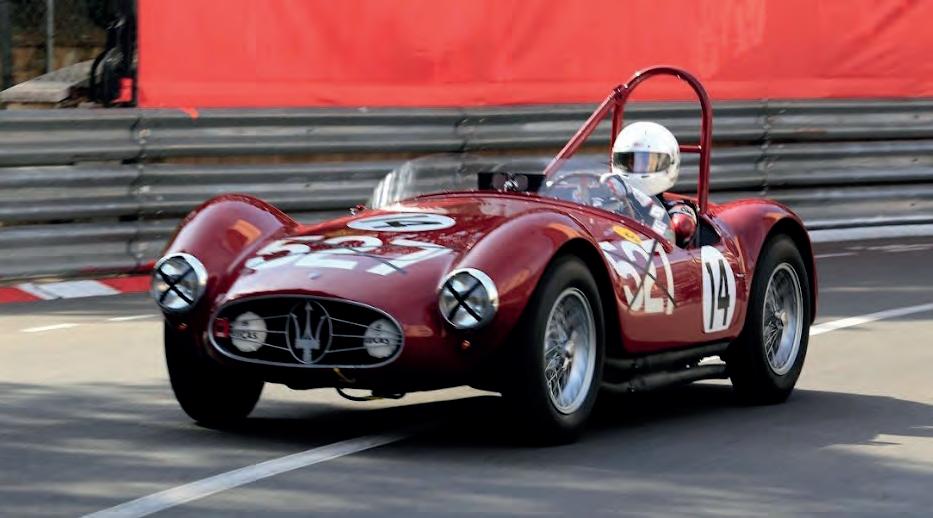
Jean-Jacques BALLY
Cette A6GCS a été livrée en 1955 à Maria Teresa de Filippis. A son volant, elle a pris le départ des Mille Miglia. En 1958, sur Maserati 250F, elle a tenté sa qualification au Grand Prix de Monaco F1, devenant à cette occasion la première femme engagée en Championnat du Monde de F1.
This A6GCS was delivered to Maria Teresa de Filippis in 1955. At its wheel, she took part in the Mille Miglia race. In 1958, driving a Maserati 250F, she attempted to qualify for the Monaco F1 Grand Prix, becoming the first woman ever to compete in the F1 World Championship.
Adrian SUCARI
Cette A6GCS a été livrée neuve en 1954 à Alberico Cacciari qui l’a pilotée pendant trois saisons, notamment lors des Mille Miglia 1954 et 1955, à la Targa Florio 1955 et au Grand Prix Supercortemaggiore de Monza en 1954, 1955 et 1956.
This car was delivered new in 1954 to Alberico Cacciari who drove it for three seasons including at the Mille Miglia 1954 and 1955, at the Targa Florio 1955 and at the Supercortemaggiore Grand Prix at Monza in 1954, 1955 and 1956.
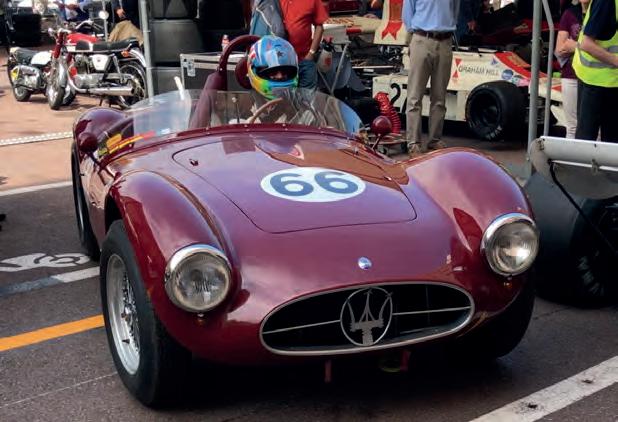
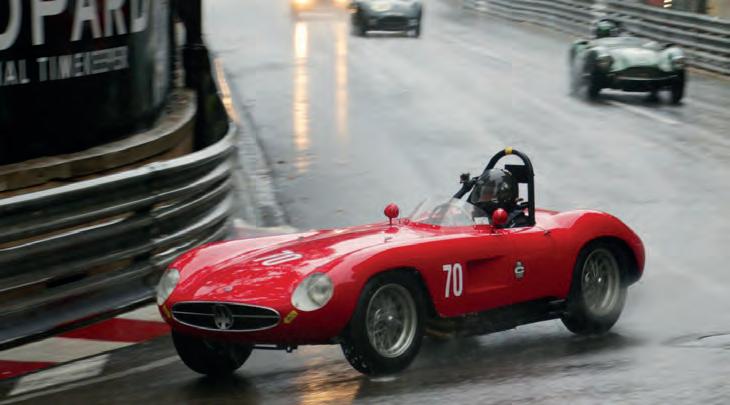
Carlos SIELECKI
Cette A6GCS, dernière de la série, a été livrée neuve avec la carrosserie prototype de la 300S. Luigi Belluci en 1955, et Sergio Aguzzoli en 1956, l’ont pilotée lors des Mille Miglia.
This car was delivered new with the prototype coachwork of the 300S. Luigi Belluci in 1955 and Sergio Aguzzoli in 1956 drove it at the Mille Miglia.
C 18 82
20 22
Stefan HAMELMANN
Cette A6GCS, a été livrée neuve en Argentine à Carlos Tomasi qui a notamment participé à son volant aux 12 heures de Reims 54 (avec Lopez) et aux 1000 kms de Paris 56 (avec Maria Theresa de Filippis)
This A6GCS was delivered new in Argentina to Carlos Tomasi, who drove it in the '54 Reims 12 Hours (with Lopez) and the '56 Paris 1000 kms (with Maria Theresa de Filippis).

MASERATI 200S
La Maserati 200S 4 cylindres est la remplaçante de la A6GCS 6 cylindres et la réponse de la firme au Trident à la Ferrari 500 Mondial. Elle débute à Imola en juin 1955 mais son développement va souffrir de la dispersion des efforts de la marque présente en F1, avec la 250F, et en Sport 3L avec la 300S. Le principal titre de gloire de ce modèle est d’avoir remporté le Championnat d’Europe de la Montagne aux mains du Suisse Willy Daetwyler au redémarrage de cette compétition en 1957. Production : 28 exemplaires de 200S produits entre 1955 et 1958, dont quatre 250S.
The 4-cylinder Maserati 200S is the replacement for the 6-cylinder A6GCS and the response of the firm with the Trident to the Ferrari 500 Mondial. Its debut took place at Imola in June 1955 but its development suffered from the dispersion of the brand's efforts in F1 with the 250F and in 3L Sport with the 300S. The main feat of glory for this model was winning the European Hillclimb Championship in the hands of Swiss Willy Daetwyler when this competition restarted in 1957. Production: 28 units of the 200S produced between 1955 and 1958, including four 250S.
Richard WILSON
Cette voiture est la quatrième et dernière de la série à avoir été produite avec un moteur 250S. Au cours de sa carrière, elle a notamment été pilotée occasionnellement par Carroll Shelby, Jim Hall et Hap Sharp.
This is the fourth and last car of the series equipped with a 250S engine. In the course of its career, it was driven by Carroll Shelby, Jim Hall and Hap Sharp.

83 14e GRAND PRIX DE MONACO HISTORIQUE 10-12 MAI 2024 78 80
MASERATI 300S
Ce modèle a débuté aux 12 Heures de Sebring en 1955. Juan-Manuel Fangio, Stirling Moss, Piero Taruffi, Harry Schell, Jean Behra, Louis Rosier et Luigi Musso, entre autres, l’ont amené à la victoire dans des épreuves internationales.
Production : 30 exemplaires produits entre 1955 et 1957.
This model made its debut at the 12 Hours of Sebring in 1955. Juan-Manuel Fangio, Stirling Moss, Piero Taruffi, Harry Schell, Jean Behra, Louis Rosier and Luigi Musso, among others, drove it to victory at international events.
Production: 30 models produced between 1955 and 1957.

Claudia HUERTGEN
Cette 300S soutenue par l’usine Maserati a fait ses débuts dans le cadre des 12 Heures de Sebring en 1955, alors première manche du Championnat du Monde. Son équipage Perdisa/Munaron a pris la 4e place. En 1956, le Sicilien Pietro Pottino en a fait l’acquisition, terminant 5e de la Targa Florio et 4e du Tour de Calabre.
This car, supported by the Maserati factory, made its debut at the 1955 Sebring 12 Hours, first round of the World Championship. Its Perdisa/ Munaron crew finished 4th and in 1956 Sicilian driver Pietro Pottino bought it. He finished 5th of the Targa Florio and 4th of the Tour of Calabria.
Guillermo FIERRO-ELETA
Cette 300S a été livrée neuve fin 1957 à Antonio Mendes de Barros qui a débuté à son volant en équipe avec Luis Milan aux 1000 Km de Buenos Aires en 1958. Dans la période récente, elle a longtemps été la propriété de Mark Knopfler, le guitariste du groupe Dire Straits.
This 300S was delivered new in late 1957 to Antonio Mendes de Barros who made his debut with it when associated to Luis Milan at the Buenos Aires 1000 Km in 1958. In more recent years, it belonged to Mark Knopfler, Dire Straits’s lead guitarist.
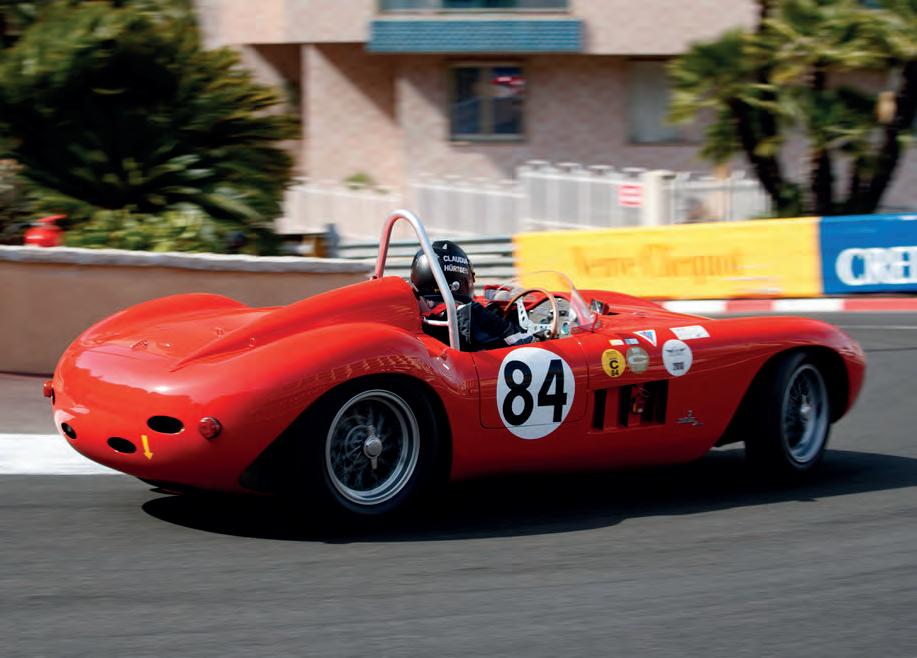

Livrée comme « neuve » à l’Automobile Club d’Angola en 1959, cette 300S était probablement un modèle de 1957 reconditionné.
Delivered as “new” to Automobile Club d’Angola in 1959, this 300S was most likely a reconditioned car from 1957.
C 82 84
Brad BAKER
84 86
MASERATI 350S
La 350S était juste un modèle destiné à assurer l’intérim entre la 300S fiable et compétitive, mais qui avait atteint ses limites en 1955, et la 450S à moteur V12 développée en 1956, en adoptant son châssis, mais opérationnelle en 1957 seulement.
Production : deux 6 cylindres en 1956 et une 8 cylindres en 1957.
The 350S was just an interim model between the reliable and competitive 300S, which reached its limits in 1955, and the 450S with a V12 engine, developed in 1956 when adopting its chassis, but not fully operational until 1957.
Production: two 6-cylinder models in 1956 and one 8-cylinder model in 1957.

OSCA MT4-AD
Carlo INCERTI
Cette Osca a été livrée à Giuseppe Rossi qui l’a utilisée en compétition sur la plupart des circuits italiens en 1955 et 1956. Ses résultats en 1955 lui ont permis d’être sacré Champion d’Italie des Sport 1100. A partir de 1957, cette MT4 a aussi été utilisée dans les grandes épreuves routières telles que la Targa Florio, les Mille Miglia et le Tour de Sicile.
This car was delivered to Giuseppe Rossi, who used it in competition on most of the Italian circuits in 1955 and 1956. His results in 1955 led to him being crowned Italian Sport 1100 Champion. From 1957, this MT4 was also used in major road races such as the Targa Florio, the Mille Miglia and the Tour of Sicily.
Jeffrey O’NEILL
Cette 350S, construite pour que Piero Taruffi participe aux Mille Miglia de 1956, n’a pas été utilisée pour cette course. Luigi Piotti l’a pilotée lors de sa première apparition, avec Umberto Maglioli, lors des 12 Heures de Reims. Piotti a aussi vainement tenté de se qualifier à Monaco en 1957 sur une 250F, et encore en 1958 sur une Osca F2/S1500.
This 350S, built for Piero Taruffi to take part in the 1956 Mille Miglia, was not used in that race. Luigi Piotti used it for its first appearance, with Umberto Maglioli, at the 12 Hours of Reims. Piotti also tried in vain to qualify for Monaco in 1957 with a 250F, and again in 1958 with an Osca F2/S1500.
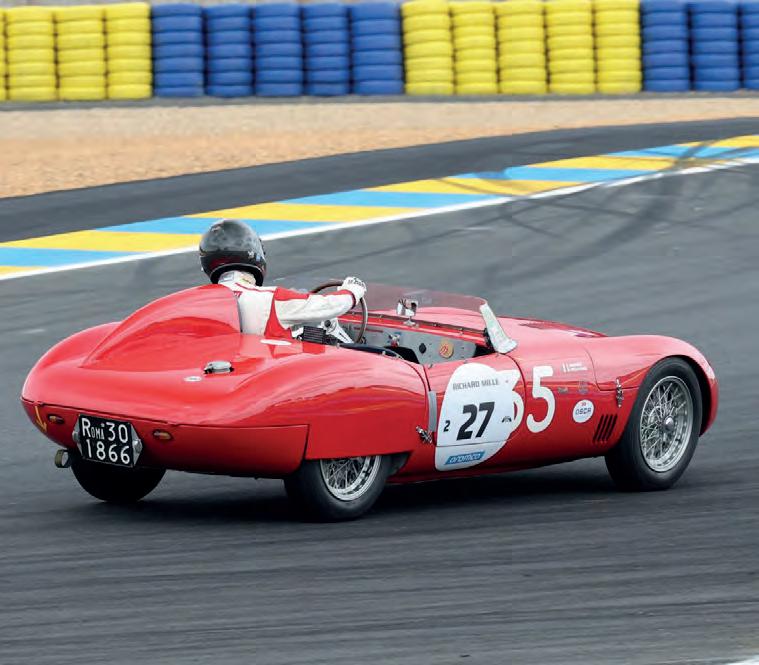
85 14e GRAND PRIX DE MONACO HISTORIQUE 10-12 MAI 2024 88 16
PEGAZO Z102
La Z102 se présentait comme une GT mais avec des solutions propres aux voitures de course les plus avancées (moteur V8 –2x2ACT-carter sec). Le choix de tout produire en interne, sans faire appel à la sous-traitance, a ralenti le programme de mise au point et rendu la production dispendieuse, ce qui a condamné à l’échec cet intéressant projet.
The Z102 looked like a GT car, but with solutions typical of the most advanced racing cars (V8 -2x 2ACT-dry sump engine). The decision to produce everything in-house, without subcontracting spare parts, slowed down the development program and made production expensive, condemning this interesting project to failure.
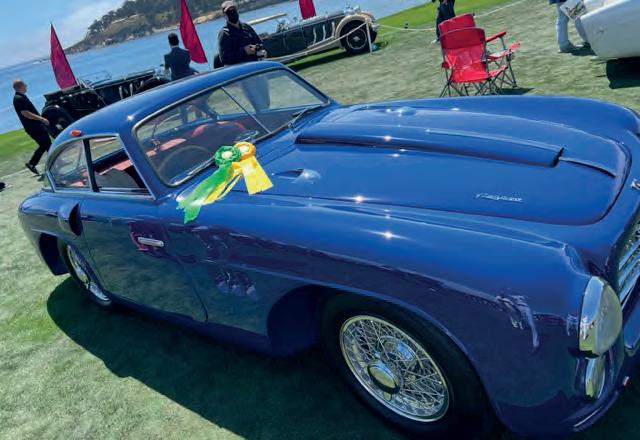
VERITAS RS
Jaime BERGEL SAINZ de BARANBA
Cette Z102 qui appartient à un fier amateur espagnol n’a certes pas de participation en course connue, mais sa présence ici est cependant légitime car elle est du type des trois voitures présentes en 1952 lors du Grand Prix de Monaco.
Although this Z102, owned by a proud Spaniard, has no known racing history, its presence here is nonetheless legitimate, as it is of the type of the three cars present in 1952 at the Monaco Grand Prix.
La veille du Grand Prix de Monaco 1952, la Veritas RS de Jean Heurtaux s’est classée 15e et dernière du Prix de Monte-Carlo réservée aux biplaces de moins de 2L.
Production : 30 à 40 biplaces RS produites entre 1947 et 1950.
The day before the Monaco Grand Prix in 1952, Jean Heurtaux’s Veritas RS claimed the 15th and last place of Prix de Monte-Carlo reserved for under 2L twoseaters.
Production: 30 to 40 RS two-seaters produced between 1947 and 1950.

Lutz RATHENOW
Construite à partir d’une BMW 328 née en 1938, cette voiture a fait toute sa carrière en Allemagne comme la plupart des Veritas.
Based on a BMW 328 born in 1938, this car spent all of its career in Germany, like most cars produced by Veritas.
C 50 24 86

You’re at the wheel of your investments.We‘ll help you steer them towards greater returns.
Managing wealth is our craft. This document and the information contained herein are provided solely for information purposes and are not intended to constitute a public offering or a comparable solicitation under the Principality of Monaco law. Although all pieces of information and opinions expressed in this document were obtained from sources believed to be reliable and in good faith, neither representation nor warranty, expressed or implied, is made as to its accuracy or completeness. UBS (Monaco) S.A. (“UBS”) an affiliate of UBS AG, does not provide legal or tax advice. Approved and issued by UBS, this document may not be reproduced or copies circulated without prior authority of UBS. © UBS 2024. The
All rights reserved. Learn more
key symbol and UBS are among the registered and unregistered trademarks of UBS.
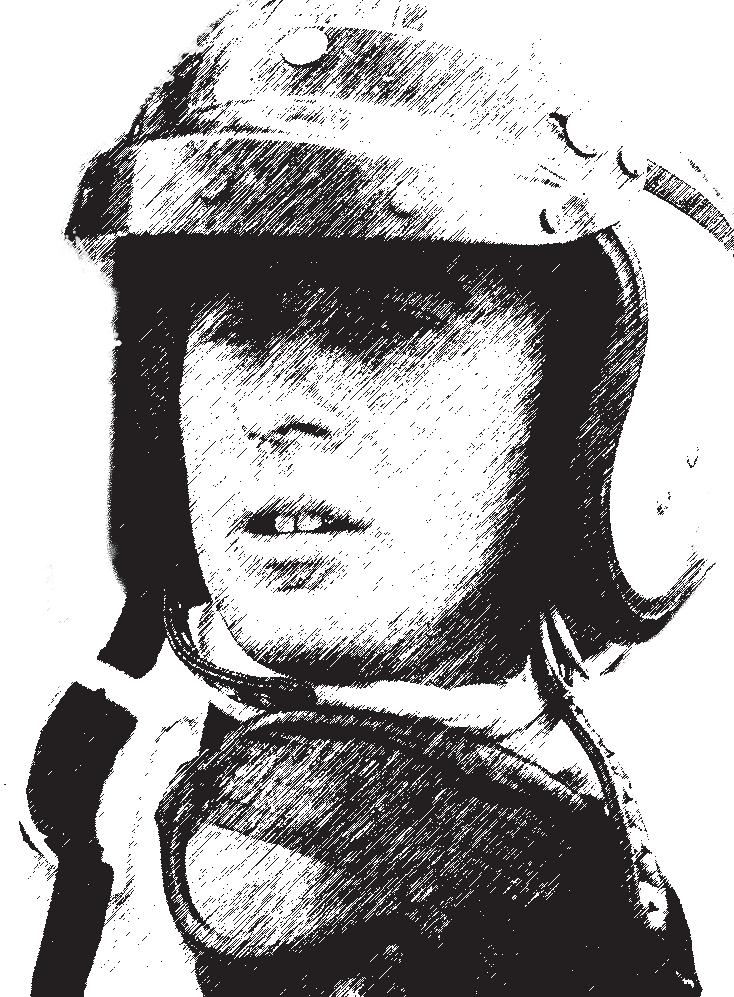
SÉRIE RACE
JACKIE STEWART
VOITURES DE GRAND PRIX À MOTEUR 3L DE 1966 À 1972
GRAND PRIX CARS WITH A 3L ENGINE FROM 1966 TO 1972
REGLEMENT (Extrait, Article 4) / RULE BOOK (Extract, Article 4)
Le 14 e Grand Prix de Monaco Historique est ouvert aux voitures définies par l’annexe K du Code Sportif International de la F.I.A. / The 14th Grand Prix de Monaco Historique is open to cars defined by Appendix K of the FIA International Sporting Code.
Les voitures sont admises en 3 classes / The cars are admitted in 3 classes:
Classe 1 : Voitures ayant participé à des Grand Prix de F1 entre le 1er janvier 1966 et le 31 décembre 1969 / Cars having raced in a F1 Grand Prix in between January 1, 1966 and December 31, 1969.
Classe 2 : Voitures de F1 construites entre le 1er janvier 1970 et le 31 décembre 1972, équipées d’un moteur Ford-Cosworth DFV / F1 cars built between January 1, 1970 and December 31, 1972, equipped with a Ford-Cosworth DFV engine.
Classe 3 : Voitures construites entre le 1er janvier 1970 et le 31 décembre 1972, équipées d’un autre moteur / F1 cars built between January 1, 1970 and December 31, 1972, equipped with other engines.
La série D sert de cadre à la célébration des sept premières saisons de la Formule 1 de 3 Litres de cylindrée, née en 1966, et donc des Grands Prix de Monaco de la période correspondante. Cette réglementation donna lieu à la généralisation des châssis monocoque ainsi qu’à l’apparition, et aux multiples victoires, du mythique V8 Cosworth DFV (Classes 1 et 2), mais aussi à l’avènement de magnifiques moteurs V12 imaginés par les ingénieurs de chez Ferrari, Matra et BRM (Classes 1 et 3).
The D-Series serves as a celebration of the first seven seasons of 3-liter Formula 1, starting in 1966, and therefore it is also a celebration of Monaco Grand Prix at that time. This regulation allowed the generalisation of the “monocoque” (single shell) body, as well as the appearance, and many wins, of the mythical V8 Cosworth DFV (Classes 1 and 2), but also to the advent of beautiful V12 engines designed by the engineers at Ferrari, Matra, and BRM (Classes 1 and 3).
1966 - 1971

D
88
LISTE DES ENGAGÉS I ENTRY LIST

VAINQUEURS DU GRAND PRIX DE MONACO
1966 : Jackie Stewart / BRM P261
1967 : Denis Hulme / Brabham BT20
1968 : Graham Hill / Lotus 49B
1969 : Graham Hill / Lotus 49B
1970 : Jochen Rindt / Lotus 49C
1971 : Jackie Stewart / Tyrrell 003
1972 : Jean-Pierre Beltoise / BRM P160
14e GRAND PRIX DE MONACO HISTORIQUE 10-12 MAI 2024 N° PILOTE / DRIVER NAT CONCURRENT VOITURE / CAR MODÈLE ANNÉE CL. 1 HARTLEY JNR Tom GBR HARTLEY JNR Tom MARCH 701 1970 2 2 KUBOTA Katsuaki JPN KUBOTA Katsuaki LOTUS 72 1971 2 3 NEWEY Adrian GBR NEWEY Adrian LOTUS 49B 1968 1 5 WRIGLEY Matthew GBR WRIGLEY Matthew MARCH 721G 1972 2 7 SERGISON Ewen GBR SERGISON Ewen SURTEES TS9B 1971 2 9 LYNN Shaun GBR CONSTABLE Jamie BRABHAM BT37 1972 2 11 TBA METHUSALEM RACING FERRARI 312 1969 1 12 MEINERS Franco MCO MEINERS Franco FERRARI 312B3 1972 3 15 GOETHE Roald MCO GOETHE Roald McLAREN M19A 1971 2 16 MISTER JOHN OF B FRA MISTER JOHN OF B MATRA MS120C 1972 3 19 FERNANDEZ Adrian MEX FERNANDEZ Adrian BRM P153 1970 3 21 MATILE Nicolas MCO MATILE Nicolas MATRA MS120B 1971 3 22 LYONS Michael GBR LYONS Judith SURTEES TS9 1971 2 23 FERRARI Bruno ITA FERRARI Bruno MARCH 701 1970 2 27 SHAW David GBR SHAW David EIFELLAND 21 1972 2 28 BECKER Harald DEU BECKER Harald MARCH 701 1970 2
1 Voiture victorieuse d’un ou plusieurs Grand Prix du Championnat du Monde Voiture présente en période au Grand Prix de Monaco
MONACO GRAND PRIX WINNERS
89
BRABHAM BT37
Cette voiture correspond à l’arrivée de Bernie Ecclestone à la tête de l’équipe créée par Jack Brabham. Elle présente peu de différences par rapport à ses devancières BT33 et surtout BT34 avec lesquelles elle partageait les stands de l’écurie en 1972.
Production : 2 exemplaires produits en 1972 pour les pilotes de Brabham Racing, Graham Hill et Carlos Reutemann.
This car came out when Bernie Ecclestone took over the team created by Jack Brabham. The car is very similar to its predecessors, the BT33 and especially the BT34 with which it shared the Brabham pits in 1972.
Production: 2 models produced in 1972 for Brabham Racing drivers, Graham Hill and Carlos Reutemann.

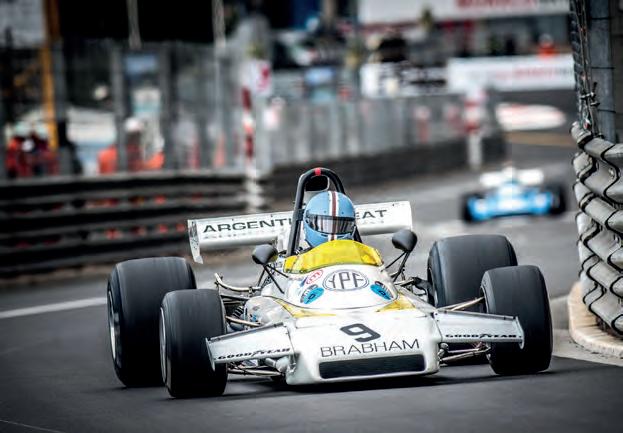
BRM P153
Jamie CONSTABLE
Cette BT37 a été pilotée en 1972 par Carlos Reutemann lors de neuf Grands Prix avec pour meilleur résultat une 4e place au Canada. En 1973, l’Argentin a débuté la saison à son volant puis Andrea de Adamich en est devenu le pilote titulaire (7e à Monaco). C’est aussi à son volant, au Grand Prix de Grande-Bretagne, que John Watson a débuté sa carrière en Championnat du Monde.
This BT37 was driven by Carlos Reutemann in 1972 at nine World Championship events, with a 4th place in Canada as a best result. In 1973, the Argentine started the season behind its wheel before Andrea de Adamich took over (7th in Monaco). It is also in this car that John Watson began his career in the F1 World Championship at the British Grand Prix.
Fondée juste après la guerre, BRM a été présente en Championnat du Monde de 1951 à 1977. Elle avait la particularité, comme Ferrari, d’être son propre motoriste. Sacrée Championne du Monde des constructeurs et des pilotes en 1962 avec Graham Hill, la marque anglaise a aussi triomphé cinq fois à Monaco : en 1963, 1964 et 1965 avec Graham Hill, en 1966 avec Jackie Stewart et enfin en 1972 avec Jean-Pierre Beltoise. Alors que toutes les BRM produites jusque-là étaient aux couleurs du British Racing Green, la P153 a ensuite arboré une superbe livrée blanche barrée du Y de Yardley, son principal sponsor. Ce modèle a remporté la victoire au Grand Prix de Belgique 1970, grâce à Pedro Rodriguez, un mois tout juste après sa 6e place à Monaco, soit le meilleur résultat obtenu par ce modèle P153 en Principauté. George Eaton, Jackie Oliver, Howden Ganley et Helmut Marko ont essayé de qualifier une P153 dans les rues de Monaco. Production : 7 exemplaires produits (6 en 1970, 1 en 1971).
Founded after World War II, BRM, was active in the World Championship from 1951 to 1977, with one very special feature: just like Ferrari, it also designed and built its engines. After a double world crown in 1962 (Constructors and Drivers) thanks to Graham Hill, the English team also triumphed 5 times at Monaco Grand Prix: 1963, 1964 and 1965 with the same Graham Hill, 1966 with Jackie Stewart, and 1972 with Jean-Pierre Beltoise. Whereas all BRMs produced before the P153 were carrying a British Racing Green livery, this model inaugurated a superb white livery barred by a Y stripe, since Yardley was its primary sponsor. This model won the Belgian Grand Prix in 1970, with Pedro Rodriguez at the wheel, one month only after finishing 6th in Monaco, the best result for a P153 in the Principality. George Eaton, Jackie Oliver, Howden Ganley and Helmut Marko tried to qualify a P153 in the streets of Monaco. Production: 7 models produced (6 in 1970, 1 in 1971).
Adrian FERNANDEZ
Cette BRM P153 a été pilotée par Pedro Rodriguez lors de huit Grands Prix de la deuxième partie de la saison 1970. A son volant, il est entré quatre fois dans les points avec comme meilleur résultat sa 2e place au Grand Prix des Etats-Unis.
This BRM P153 was driven by Pedro Rodriguez at eight events during the second part of the World Championship in 1970. He claimed points four times that year, with a 2nd place at the United States Grand Prix as his best result.
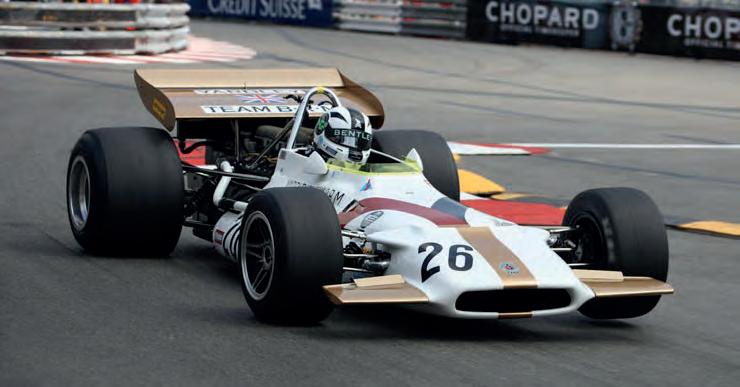
D 9 19 90
EIFELLAND 21


FERRARI 312
David SHAW
Rolf Stommelen a piloté la March 721, rebaptisée Eiffelland, jusqu’au Grand Prix d’Autriche en 1972 (10e à Monaco). Désignée Eifelland 21, elle avait une carrosserie très spéciale imaginée par le designer Allemand Luigi Colani. Après Stommelen, John Watson, engagé par l’écurie Hexagon, la pilota en fin de saison pour continuer son apprentissage en F1.
Rolf Stommelen drove this March 721, labelled Eifelland, until the Austrian Grand Prix in 1972 (10th in Monaco).
Called the Eifelland 21, it had a very special body designed by the German Luigi Colani. After Stommelen, John Watson, hired by Hexagon, drove it at the end of the season, in order to continue his apprenticeship in F1.
Ferrari a produit sa première voiture en 1947 et est entré en F1 dès l’année suivante. Depuis, la Scuderia n’a manqué aucun Grand Prix de Monaco. L’avènement de la réglementation de la F1 à moteur 3 litres, en 1966, et le moteur V12 qui fait partie de son ADN ont donné lieu à une succession de déclinaisons du thème 312 (pour 3L V12), et ce jusqu’à l’adoption du turbo en 1980 avec la 126CK. Le podium obtenu par Chris Amon en 1967 a constitué la première performance d’une 312 en Principauté mais les tifosi ont dû attendre 1976 et Niki Lauda pour fêter une victoire en bonne et due forme.
Production :
- 312 : 12 exemplaires (3 en 1966, 4 en 1967, 3 en 1968, 2 en 1969), 3 victoires en Championnat du Monde (Scarfiotti, Surtees, Ickx).
- 312 B : 5 exemplaires en 1970, 5 victoires en Championnat du Monde (Ickx 3. Regazzoni 1, Andretti 1).
- 312 B2 : 4 exemplaires (3 en 1971, 1 en 1973) utilisés par les pilotes de la Scuderia Ferrari de 1971 à 1973 : Ickx (2 victoires), Regazzoni, Andretti, Galli, Merzario.
- 312 B3 : 8 exemplaires (1 en 1972, 3 en 1973, 3 en 1974, 1 en 1975), 3 victoires en Championnat du monde (Lauda 2, Regazzoni 1). La Ferrari 312 B3 a permis à Niki Lauda de se révéler en remportant ses deux premiers Grands Prix de F1 (Espagne et Hollande 1974).
Ferrari produced its first car in 1947 and entered F1 the next year. Since then, the Scuderia never missed a single Monaco Grand Prix. The advent of the 3-liter regulation in F1 in 1966 and the V12 engine that is part of its DNA gave rise to a succession of variations of the 312 theme (3 for 3-liter, 12 for V12) until the first turbo engine appeared in 1980, in the 126CK. The podium for Chris Amon in 1967 was the first significant achievement for a 312 in the Principality, but the tifosi had to wait for Niki Lauda in 1976 to celebrate a win.
Production:
- 312 : 12 cars (3 in 1966, 4 in 1967, 3 in 1968, 2 in 1969), 3 wins in the World Championship (Scarfiotti, Surtees, Ickx).
- 312 B: 5 cars in 1970, 5 wins in the World Championship (Ickx 3. Regazzoni 1, Andretti 1)
- 312 B2: 4 cars (3 in 1971, 1 in 1973) used by Scuderia Ferrari drivers in 1971, 1972 and 1973: Ickx (2 wins), Regazzoni, Andretti, Galli, Merzario.
- 312 B3: 8 cars (1 in 1972, 3 in 1973, 3 in 1974, 1 in 1975), 3 wins in the World Championship (Lauda 2, Regazzoni 1).
The Ferrari 312B3 is the car that revealed Niki Lauda, victorious of his first two F1 races at the 1974 Spanish and Dutch Grand Prix.
TBA
C’est l’une des deux Ferrari engagées en 1969. Elle a pris 8 départs en F1 (dont 7 en Championnat du Monde), avec Chris Amon d’abord puis Ricardo Rodriguez en fin de saison (5e au Grand Prix des USA). Elle a servi deux fois de voiture de réserve, notamment au Grand Prix de Monaco.
This is one of the two cars entered in 1969. It took 8 starts in F1 (including 7 in the World Championship), first with Chris Amon at the wheel, then Ricardo Rodriguez at the end of the season (5th at the USA Grand Prix). It was also a reserve car twice, notably at the Monaco Grand Prix.

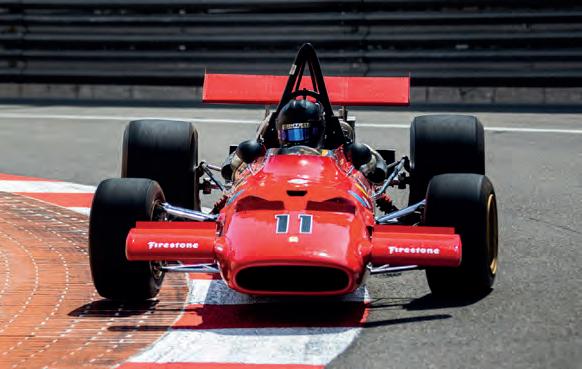
91 14e GRAND PRIX DE MONACO HISTORIQUE 10-12 MAI 2024
27 11
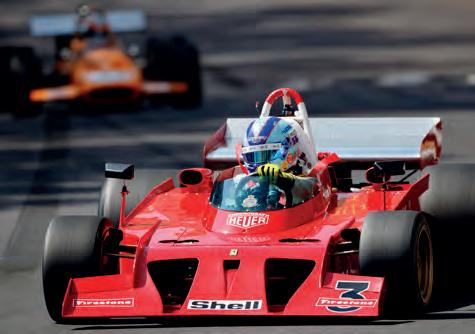
LOTUS 49
Franco MEINERS
Ce prototype B3 a été baptisé « chasse-neige » à cause des formes avantageuses de son bouclier avant. Elle devait participer au Grand Prix d’Italie 1972, mais les problèmes rencontrés lors des premiers essais ont provoqué le report de son engagement, et finalement la refonte totale du modèle en vue de la saison 1973.
This is the B3 prototype, nick-named “snow plough” because of the shape of its nose. It was meant to take part in the Italian Grand Prix in 1972, but problems encountered during the first testing sessions delayed its registration, and eventually Ferrari decided to rethink this model completely for the 1973 season.
Cette voiture a été conçue pour les débuts du moteur Cosworth DFV en 1967, elle a permis à Graham Hill de remporter en 1968 son deuxième titre mondial et à Emerson Fittipaldi de débuter en F1 en 1970. Elle a remporté 13 victoires en Championnat du Monde, dont trois consécutives à Monaco : en 1968 et 1969 avec Graham Hill au volant, et en 1970 avec Jochen Rindt. Production : 12 voitures en quatre déclinaisons, entre 1967 et 1969.
This car was designed for the debut of the Cosworth DFV engine in 1967, it allowed Graham Hill to conquer his second world crown in 1968 and Emerson Fittipaldi to start his F1 career in 1970. It took 13 World Championship wins, including three in a row at the Monaco Grand Prix: in 1968 with and 1969 with Graham Hill at the wheel, in 1970 with Jochen Rindt. Production: 12 cars in four variants produced between 1967 and 1969.
Adrian NEWEY
Cette Lotus 49 a été pilotée par Graham Hill au début de la saison 1969 en Nouvelle-Zélande et en Australie. De retour en Europe, elle a pris la 4e place du Grand Prix de Monaco aux mains de Richard Attwood, puis la 7e place au Grand Prix de Grande-Bretagne avec Graham Hill.
This Lotus 49 was driven by Graham Hill at the start of 1969 in New Zealand and Australia. On its return to Europe, it finished 4th at the Monaco Grand Prix with Richard Attwood at the wheel, then 7th at the British Grand Prix with Graham Hill.
LOTUS 72

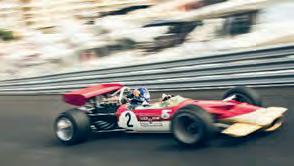
La Lotus 72 fait partie des mythes de la F1 : elle a en effet permis à Jochen Rindt de remporter ses derniers Grands Prix et le titre de Champion du Monde à titre posthume en 1970. Emerson Fittipaldi a ensuite remporté le titre en 1972 avec une autre 72. Ce modèle ne compte pas moins de 20 victoires en Championnat du Monde aux mains de Jochen Rindt (4), Emerson Fittipaldi (9) et Ronnie Peterson (7 dont le Grand Prix de Monaco en 1974). Production : 9 voitures (5 en 1970, 1 en 1971, 1 en 1973, 1 en 1974, 1 en 1975).
The Lotus 72 is one of F1’s mythical cars: it enabled Jochen Rindt to win his last races and the world crown posthumously in 1970; two years later, Emerson Fittipaldi won the 1972 World Championship with another 72. This car took no less than 20 wins in the World Championship, thanks to the talent of Jochen Rindt (4), Emerson Fittipaldi (9) and Ronnie Peterson (7, including Monaco in 1974). Production: 9 cars (5 in 1970, 1 in 1971, 1 in 1973, 1 in 1974, 1 in 1975).
Katsuaki KUBOTA
Produite en 1971, cette Lotus 72 a été pilotée par Reine Wisell, Dave Walker et Ronnie Peterson (3e à Monaco en 1973). Elle a poursuivi sa carrière en Afrique du Sud aux mains d’Ian Scheckter, le frère de Jody, Champion du Monde de F1 en 1979 sur Ferrari.
Built in 1971, this Lotus 72 was successively driven by Reine Wisell, Dave Walker and Ronnie Peterson (3rd in Monaco in 1973). It continued its career in South Africa in the hands of Ian Scheckter, brother of Jody, F1 World Champion in 1979 in a Ferrari. 12 3 3


D 92
McLAREN M19
La M19 sortie en 1971 se distingue par ses suspensions à flexibilité variable et sa coque ventrue comparée à l’époque à une bouteille de Coca-Cola. Elle compte une seule victoire en Championnat du Monde obtenue par Denny Hulme au Grand Prix d’Afrique du Sud 1972. A Monaco, elle a pris la 4e place en 1971 avec Hulme, puis la 5e place avec Brian Redman en 1972. Production : 2 exemplaires en 1971, utilisés par McLaren Racing (Hulme, Gethin, Oliver, Redman, Revson), puis par Penske (Donohue, Hobbs).
The M19 released in 1971 is characterized by its variable flexibility suspensions and its belly-shaped hull which was compared at the time with a Coca-Cola bottle. It counts only one win in the World Championship, thanks to Denny Hulme at the South African Grand Prix in 1972. In Monaco, it took 4th place in 1971 with Hulme and 5th place with Brian Redman in 1972. Production: 2 cars produced in 1971, used by McLaren Racing (Hulme, Gethin, Oliver, Redman, Revson) and Penske (Donohue, Hobbs).
Roald GOETHE
Cette M19 a le plus souvent été pilotée par Denny Hulme en 1971 et au début de la saison 1972 (victoire au Grand Prix d’Afrique du Sud) puis par Peter Revson et Brian Redman (5e à Monaco en 1972).
This car was most often driven by Denny Hulme in 1971 and at the beginning of 1972 (winning the South African Grand Prix), then by Peter Revson and Brian Redman (5th in Monaco in 1972).

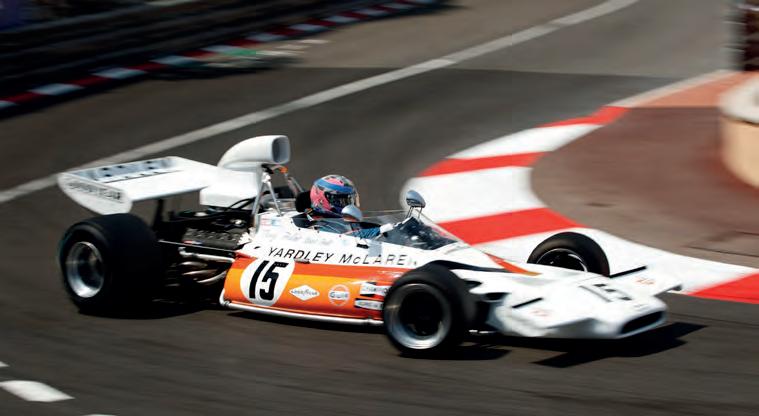
MARCH 701
Première F1 de la marque, la 701 a été présente en grand nombre dans les Grands Prix de 1970. Pas moins de six équipes ont fait confiance à la jeune marque anglaise qui n’avait encore rien prouvé. En plus des deux voitures officielles de March Engineering pour Jo Siffert et Chris Amon, Tyrrell Racing a choisi ce modèle pour Jackie Stewart et Johnny Servoz Gavin, puis François Cevert ; la STP Corporation pour Mario Andretti ; Antiques Automobiles pour Ronnie Peterson ; Team Gustom pour John Love ; Hubert Hahne à titre privé. En 1970, à Monaco, pas moins de six pilotes ont tenté de se qualifier au volant d’une March 701. Production : 11 exemplaires (10 en 1970, 1 en 1971).
This was the first F1 of the British make, and it took part in numerous F1 races in 1970. No less than six teams trusted this young company that still had everything to prove. Two official cars were entered by March Engineering for Jo Siffert and Chris Amon ; Tyrrell Racing entered two as well for Jackie Stewart and Johnny Servoz Gavin, then François Cevert ; STP Corporation one for Mario Andretti ; Antiques Automobiles one for Ronnie Peterson ; Team Gustom one for John Love ; Hubert Hahne privately. In 1970 in Monaco, no less than six drivers tried to qualify behind the wheel of a March 701. Production: 11 models (10 in 1970, 1 in 1971).

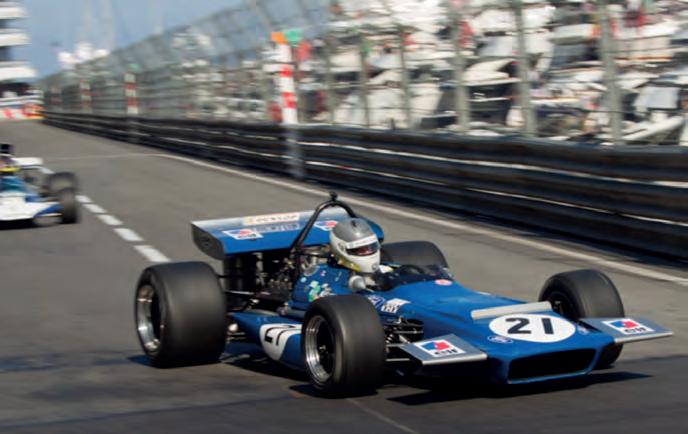
Tom HARTLEY Jr
Cette March 701 engagée par Ken Tyrrell a été confiée à Jackie Stewart. Il a débuté la saison 1970 par un podium en Afrique du Sud puis a remporté le Grand Prix d’Espagne comptant pour le Championnat du Monde (la seule victoire en F1 obtenue par ce modèle). L’Ecossais a eu moins de chance à Monaco (abandon).
This 701 was entered by Ken Tyrrell and entrusted to Jackie Stewart. He started the season in style with a podium finish in South Africa and then won the Spanish Grand Prix counting for the World Championship (the one and only authentic F1 win achieved by this model). The Scotsman was less fortunate in Monaco (retirement).
93 14e GRAND PRIX DE MONACO HISTORIQUE 10-12 MAI 2024
15 1 1 1



Harald BECKER
Premier châssis de F1 produit par March, cette 701 a été pilotée par Chris Amon et Jo Siffert dans l’écurie d’usine. Victorieux à son volant lors du Daily Express Trophy, le Néo-Zélandais a été victime 15 jours plus tard à Monaco d’un accident qui a provoqué le remplacement de sa coque.
This was the first F1 chassis produced by March, driven by Chris Amon and Jo Siffert in the factory team. Victorious at the Daily Express Trophy, Amon crashed the car 15 days later in Monaco, which led March to replace its shell.
MARCH 721G
Bruno FERRARI
Ronnie Peterson a débuté sa carrière en F1 au volant de cette 701 par une 7e place au Grand Prix de Monaco, dans le premier de huit Grands Prix du Championnat du Monde au programme du débutant suédois en 1970.
Ronnie Peterson started his F1 career at the wheel of this 701 with a 7th place at the Monaco Grand Prix, the first of eight World Championship races for the Swedish rookie in 1970.
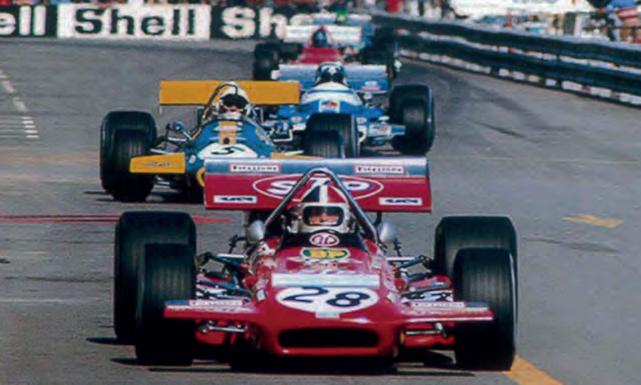
Sortie sur initiative privée dans le courant de la saison 1972 pour pallier la défaillance de la 721, la 721G, basée sur une coque de F2, a ensuite été adoptée et reproduite par l’usine.
Production : 5 exemplaires produits en 1972, pilotés par Ronnie Peterson et Niki Lauda (March Engineering), Mike Beuttler et Daniel Rouveyran (Clarke Mordaunt Guthrie Racing).
Released privately during the 1972 season to remedy the failure of the 721, the 721G, based off of an F2 shell, was then adopted and replicated by the factory.
Production: 5 models produced in 1972, driven by Ronnie Peterson and Niki Lauda (March Engineering), Mike Beuttler and Daniel Rouveyran (Clarke Mordaunt Guthrie Racing).

Matthew WRIGLEY
Engagée à titre privé pour Mike Beuttler, cette 721G a participé à 12 Grands Prix de F1 en 1972, dont celui de Monaco (13e), et encore à trois Grands Prix en 1973.
Registered privately for Mike Beuttler, this 721G took part in 12 Grands Prix in 1972, including Monaco (13th) and three more F1 races in 1973.

23 28 5
D 94
MATRA MS120
Créée en 1965, Matra Automobiles a affiché d’emblée de grandes ambitions. Après un premier succès à Reims en F3 en 1965, la marque française est devenue dès l’année suivante une force de premier plan. En 1966 et 1967, une MS5 a remporté deux années de suite le Grand Prix de Monaco F3 grâce à Jean-Pierre Beltoise et Henri Pescarolo. La firme de Vélizy a aussi fait sa première apparition en Championnat du Monde de F1, lors du Grand Prix de Monaco 1967, avec deux MS5 lestées, confiées à Jean-Pierre Beltoise et Johnny Servoz-Gavin. Une première F1 à moteur V12 est sortie en 1968 (la MS11) à laquelle a succédé la MS120 en 1970. Après trois voitures produites en 1970 (Henri Pescarolo 3e à Monaco), trois autres sont sorties en 1971, désignées MS120B. Deux ont été modifiées en type MS120C pour 1972, année de construction de l’unique MS120D qui a failli remporter le Grand Prix de France à Charade. Production : Sept voitures entre 1970 et 1972 (3 MS120 en 1970, 3 MS120B en 1971, 1 MS120D en 1972).
Founded in 1965, Matra Automobiles showed its ambitions right from the start. After a first win in Reims in F3, in 1965, the French firm became a force to be reckoned with as soon as the next year. In 1966 and 1967, a MS5 won the Monaco F3 Grand Prix twice in a row, thanks to Jean-Pierre Beltoise and Henri Pescarolo. Based in Vélizy, near Paris, the French firm made its first appearance in the F1 World Championship at the 1967 Monaco Grand Prix with a couple of weighted MS5s entrusted to Jean-Pierre Beltoise and Johnny Servoz-Gavin. A first F1 with a V12 engine was released in 1968 (the MS11) followed by the MS120 in 1970. Three MS120 cars were produced in 1970 (Pescarolo 3rd in Monaco), then three others in 1971 (MS120B). Two of them were modified to become the MS120C of 1972, the year in which a unique MS120D was built. It almost won the French Grand Prix in Charade. Production: Seven cars between 1970 and 1972 (3 MS120 in 70, 3 MS120B in 1971, 1 MS120D in 1972).
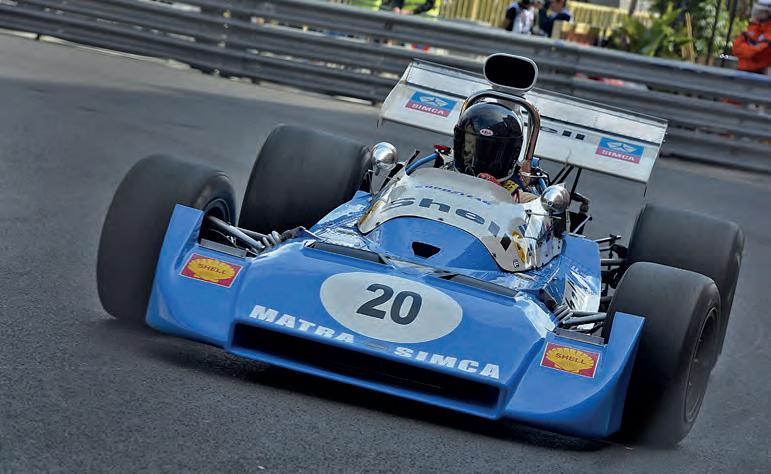

Cette MS120B a été pilotée au début de l’année 1971 par Jean-Pierre Beltoise (vainqueur à Monaco sur BRM en 1972), avant un gros accident aux 1000 Kms de Buenos Aires. A cause de cet accident, le Français n’a disputé que 7 Grands Prix du Championnat du Monde, prenant la 6e place au Grand Prix d’Espagne, lors de sa première course de l’année, puis il a abandonné à Monaco.
This MS120B was driven at the start of 1971 by Jean-Pierre Beltoise (winner in Monaco for BRM in 1972), until a big crash at the 1000 Kms of Buenos Aires. Because of this crash, the French driver only took part in seven World Championship races that year. He finished 6th at the Spanish Grand Prix, in the first race of the season, and then retired in Monaco.

« MISTER JOHN OF B »
Cette MS120B est l’une des trois F1 née en 1971 en version B avant d'être modifiée en version C pour la saison 1972. Elle a été exclusivement pilotée par Chris Amon, notamment lors de deux Grands Prix de Monaco (abandon en 1971, 6e en 1972).
This MS120B was born in 1971 as a B version before being modified into a C version for the 1972 season. It was exclusively driven by Chris Amon, who took part in two editions of the Monaco Grand Prix with it (retirement in 1971, 6th in 1972).
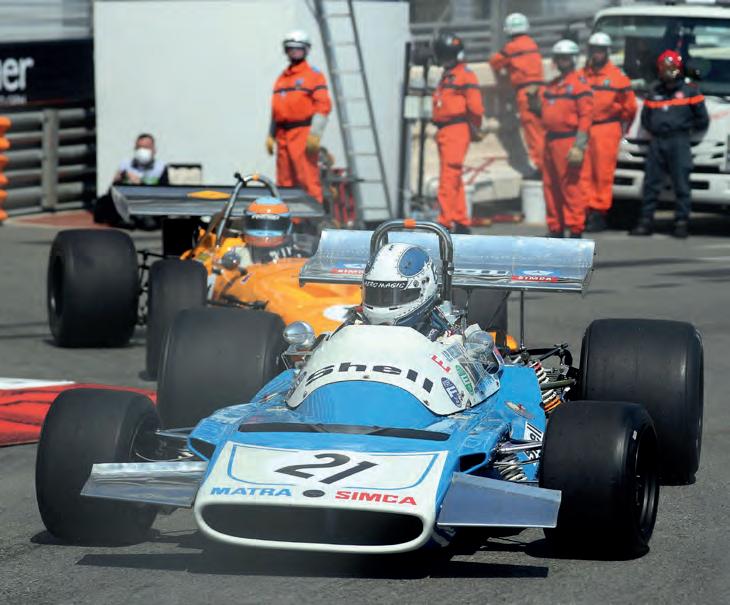
95 14e GRAND PRIX DE MONACO HISTORIQUE 10-12 MAI 2024
Nicolas MATILE
16 21
SURTEES TS9
La TS9 est la monoplace du Team Surtees en 1971, pour John Surtees et Rolf Stommelen (respectivement 7e et 6e à Monaco), et occasionnellement Derek Bell, Mike Hailwood et Sam Posey, tandis qu’une autre voiture a été livrée neuve au Team Gunston pour John Love. Fin 1971, puis en 1972, la TS9 a évolué, sa version B se distinguant par le déplacement de ses radiateurs dans les flancs (Andrea De Adamich 7e à Monaco, abandons de Mike Hailwood et Tim Schenken).
Production : 6 voitures (5 in 1971, 1 in 1972).
The TS9 was the flagship of the Surtees Team in 1971, driven by John Surtees and Rolf Stommelen (7th and 6th in Monaco), and occasionally by Derek Bell, Mike Hailwood and Sam Posey. Another car was delivered brand new to Team Gunston for John Love. At the end of 1971 and in 1972, the TS9 evolved to a B version where radiators had been moved to the sidewalls (Andrea de Adamich 7th in Monaco, Mike Hailwood and Tim Schenken retired).
Production: 6 cars (5 in 1971, 1 in 1972).


Cette TS9 est la seule à être restée en version A, c’est à dire pour l’essentiel avec un radiateur d'eau unique et frontal. Elle a été livrée neuve en Afrique du Sud au Team Gunston pour John Love, qui a participé au championnat local de F1 et à son Grand Prix national comptant pour le Championnat du Monde.
This TS9 is the only one remaining in its A version, i.e. essentially with a single front and water radiator. Delivered new in South Africa to Team Gunston for John Love, he drove it in the local F1 series and in his national Grand Prix which counted for the World Championship.
Ewen SERGISON
Cette TS9, devenue TS9B, a débuté avec Derek Bell au volant lors du Grand Prix de Grande-Bretagne 1971, puis elle a permis à Mike Hailwood de faire ses débuts dans l’équipe, au Grand Prix d’Italie deux mois plus tard. En 1972, elle était confiée à Andrea de Adamich (4e en Espagne, 7e à Monaco).
This TS9, now TS9B, made its debut with Derek Bell at the 1971 British Grand Prix. It was then driven by Mike Hailwood for his debut race with the team at the Italian Grand Prix two months later. In 1972, it was entrusted to Andrea de Adamich (4th in Spain, 7th in Monaco).
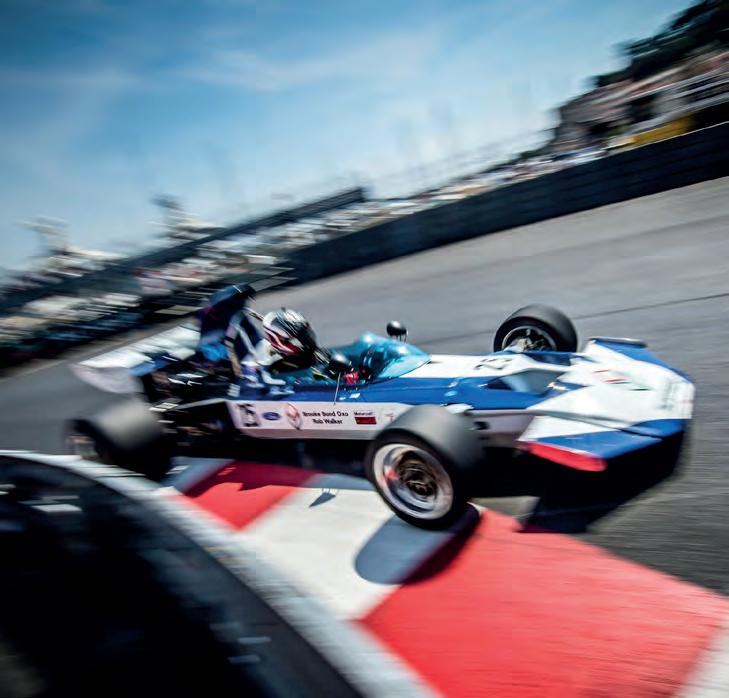 Michael LYONS
Michael LYONS
D 7 22 96

59 14e GRAND PRIX DE MONACO HISTORIQUE 10-12 MAI 2024 D

TAG Heuer et l’Automobile Club de Monaco reviennent ensemble en 2024
TAG Heuer et l’Automobile Club de Monaco font leur retour en force en 2024 pour célébrer le très attendu Grand Prix Historique de Monaco. Une fois de plus, TAG Heuer est fier d'être le partenaire et chronométreur officiel de cet événement légendaire.
Dans le cadre de ce partenariat renouvelé, TAG Heuer revient avec la TAG Heuer Monaco Chronographe - « Original Blue », une montre qui dévoile le mécanisme de la Monaco présentée à l’occasion du 80ème Grand Prix de Monaco. Cette montre sera disponible dans la nouvelle boutique TAG Heuer de Monaco, qui ouvrira ses portes lors du Grand Prix
Historique de Monaco.
LA TAG HEUER MONACO CHRONOGRAPHE INSPIRÉE DE L'HÉRITAGE DE 1969
La montre au cadran squelette dévoile une pièce ouverte devenue emblématique depuis son lancement. Ce garde-temps est conçu pour offrir une interprétation avant-gardiste de l’univers de la course automobile, avec un style contemporain destiné à trouver écho auprès de la nouvelle génération.
La TAG Heuer Monaco Chronographe« Original Blue », s’inspire du tout premier cadran bleu de la Heuer Monaco. Les couleurs bleues et rouges sont présentes sur le cadran, le bleu sur la roue à colonnes et le rouge sur les gravures de la masse oscillante - un design qui rend hommage à la Heuer Monaco 1969 et à son succès initial.
Le mouvement Heuer 02 crée un contraste harmonieux avec le mouvement des versions originales de la Heuer Monaco des années 1970. Ce mouvement utilise une roue à colonnes conventionnelle pour activer le chronographe et affiche une réserve de marche de 80 heures, l’une des plus importantes pour un chronographe dans l’industrie horlogère. De plus, la finition exquise du calibre Heuer 02
est accentuée par une masse oscillante gravée que l’on peut admirer à travers le fond saphir.
Les éléments luminescents et le traitement
Super-LumiNova® sur les index et les aiguilles sculptés de la montre ajoutent une touche avant-gardiste et futuriste à cette collection. Le guichet de la date est également une première pour la TAG Heuer Monaco. Il facilite sa lecture dans des conditions de faible luminosité.
Les aiguilles sont traitées avec du SuperLumiNova®, qui garantit une lisibilité optimale dans toutes les conditions, de jour comme de nuit, détail auquel Jack Heuer prêtait une attention particulière.
La TAG Heuer Monaco Chronographe -
« Original Blue », incarne l'esprit de compétition et de précision qui anime TAG Heuer, repoussant les limites du temps avec une précision remarquable au 1/10e, 1/100e, 1/1,000e et 2/10,000e de seconde près.
La TAG Heuer Monaco Chronographe« Original Blue », rend hommage à l'histoire légendaire de Monaco, notamment avec des ambassadeurs comme Niki Lauda, Alain Prost, Mika Häkkinen, David Coulthard, Kimi Räikkönen, Fernando Alonso, Lewis Hamilton, et Daniel Ricciardo, qui ont tous franchi la ligne d'arrivée victorieux à Monaco. Plus récemment, Sergio Pérez en 2022 et Max Verstappen en 2023 ont ajouté leur nom à cette liste prestigieuse.
Cette année marque également les 30 ans depuis la disparition d'Ayrton Senna, surnommé “le roi de Monaco”, un ami de longue date et ambassadeur de TAG Heuer. Son héritage continue d'inspirer et de guider notre engagement dans le monde de la course automobile.
98

“ TAG Heuer est la maison horlogère ayant sponsorisé le plus grand nombre de pilotes professionnels victorieux à Monaco ”
99 14e GRAND PRIX DE MONACO HISTORIQUE 10-12 MAI 2024
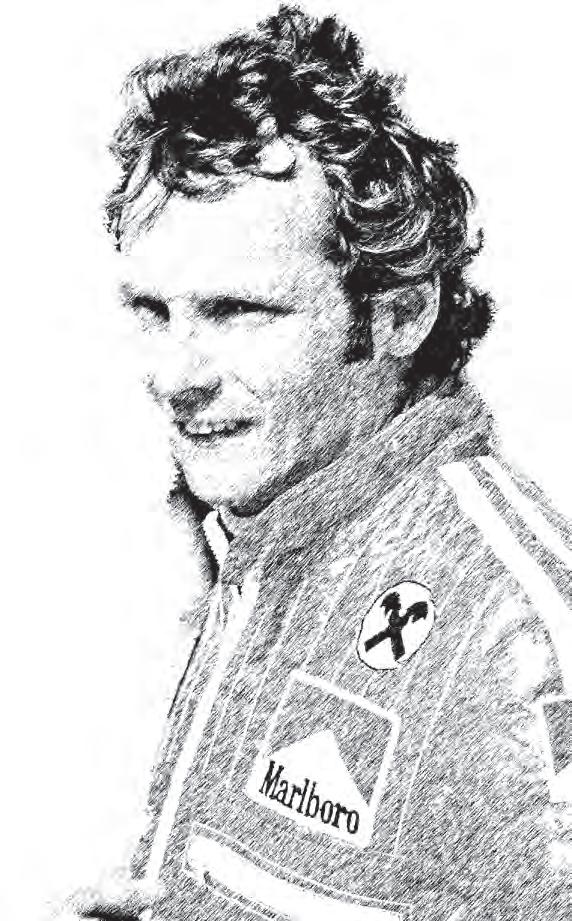
SÉRIE RACE
VOITURES DE GRAND PRIX À MOTEUR 3 LITRES, DE 1973 À 1976
F1 GRAND PRIX CARS WITH A 3-LITER ENGINE FROM 1973 TO 1976
REGLEMENT (Extrait, Article 4) / RULE BOOK (Extract, Article 4)
Le 14 e Grand Prix de Monaco Historique est ouvert aux voitures définies par l’annexe K du Code Sportif International de la F.I.A. / The 14th Grand Prix de Monaco Historique is open to cars defined by Appendix K of the FIA International Sporting Code.
Les voitures sont admises en 2 classes / The cars are admitted in 2 classes:
Classe 1 : Voitures de F1 équipées d’un moteur Ford-Cosworth DFV / F1 cars equipped with a Ford-Cosworth DFV engine.
Classe 2 : Voitures de F1 équipées d’un autre moteur / F1 cars equipped with other engines.
La série E, comme la série D, sert de cadre à la célébration des Grand Prix de Monaco de la Formule 1 de 3 Litres de cylindrée née en 1966. Les voitures admises ont couru lors des saisons 1973 à 1976.
En 1973, l’obligation faite aux constructeurs d’adopter des structures déformables, pour améliorer la sécurité, allait avoir une influence sur la physionomie des voitures, avec la généralisation des radiateurs latéraux et des formes anguleuses.
Cette génération a rapidement disparu des circuits à partir de la saison 1977, marquée par l’apparition des Renault à moteur turbo et surtout de la Lotus 78, exploitant l’effet de sol généralisé, qui a provoqué une transformation rapide et complète de la distribution des masses et donc de la structure même des monoplaces.
The E-Series, just like the D-series, is a celebration of the Monaco Grand Prix in the 3-liter era starting in 1966. Admitted cars raced from 1973 to 1976.
In 1973, a major change of the technical regulations forced manufacturers to adopt deformable structures for safety reasons. This had the consequence of changing the shape of the cars by generalising angular lateral radiators. That generation of cars quickly disappeared from the tracks, starting in 1977, when the Renault turbo engine appeared, as well as the Lotus 78.
This revolutionary car designed by Lotus engineers exploited ground effect to the maximum, which brought about a rapid transformation of the distribution of mass on all F1 cars, and of the structure of singleseaters in general.
1973 : Jackie Stewart / Tyrrell 006
1974 : Ronnie Peterson / Lotus 72E
1975 : Niki Lauda / Ferrari 312T
1976 : Niki Lauda / Ferrari 312T2
1952 NIKI LAUDA E
VAINQUEURS DU GRAND PRIX DE MONACO MONACO GRAND PRIX WINNERS
10 0

14e GRAND PRIX DE MONACO HISTORIQUE 10-12 MAI 2024 N° PILOTE / DRIVER NAT CONCURRENT VOITURE / CAR MODÈLE ANNÉE CL. 1 LYONS Michael GBR LYONS Franck McLAREN M26 1976 1 2 HALUSA Lukas AUT HALUSA Martin McLAREN M23 1976 1 3 WERNER Marco DEU CHROMECARS RACING LOTUS 76 1974 1 4 GOETHE Roald MCO GOETHE Roald TYRRELL OO7 1974 1 5 LOCKE Chris USA LOCKE Chris LOTUS 77 1976 1 6 PADMORE Nick GBR CHROMECARS RACING LOTUS 77 1976 1 12 BURANI Andrea MCO METHUSALEM RACING FERRARI 312B3 1974 2 14 NOTARI Fabrice MCO NOTARI Fabrice SHADOW DN1 1973 1 15 SEILER Toni CHE CHEETAH RACING SHADOW DN1 1973 1 16 DELETRAZ Jean-Denis CHE DRIVE VINTAGE SHADOW DN3 1974 1 17 BIANCHINI Marco ITA BIANCHINI Marco SHADOW DN5 1975 1 18 DEVIS Marc BEL DEVIS Marc SURTEES TS16 1974 1 19 LAJOUX Frédéric MCO LAJOUX Frédéric SURTEES TS19 1976 1 20 TORIBA Yutaka JPN TORIBA Yutaka WILLIAMS FW05 1976 1 22 DAVISON James AUS DAVISON James HILL GH1 1975 1 23 BONNY Philippe FRA BONNY Philippe TROJAN T103 1974 1 24 HAGAN James GBR HAGAN James HESKETH 308 1974 1 27 BROOKS Steven GBR CONSTABLE Jamie LOLA T370 1974 1 28 FULTON Stanley USA FULTON Stanley PENSKE PC3 1975 1 29 WRIGLEY Matthew GBR WRIGLEY Matthew PENSKE PC3 1975 1 31 FUMAGALLI Marco ITA FUMAGALLI Marco ENSIGN N174 1975 1 33HALL Stuart GBR GOETHE Roald McLAREN M23 1973 1 34 MOCKETT Douglas USA MOCKETT Douglas PENSKE PC4 1976 1 37 ROMAN Guillaume FRA ROMAN Guillaume ENSIGN N175 1975 1 1 Voiture victorieuse d’un ou plusieurs Grand Prix du Championnat du Monde Voiture présente en période au Grand Prix de Monaco
101
LISTE DES ENGAGÉS I ENTRY LIST


Marco FUMAGALLI
N174
La N174 est la deuxième F1 construite par la petite équipe Ensign, d’abord spécialiste de F3 puis financée par le milliardaire Rikki von Opel, de la célèbre famille allemande, pour monter en F1. Ce modèle a disputé la saison 1974 aux mains de Rikki von Opel, Vern Schuppan (abandon à Monaco) et Mike Wild, ainsi que la saison 1975 aux couleurs de son sponsor hollandais qui la confia à Roelof Wunderink (non qualifié à Monaco) et Gijs van Lennep, le vainqueur des 24 Heures du Mans 1971 avec Helmut Marko, sur Porsche.
The N174 was the second F1 car built by the small Ensign team, first specialized in F1 and then financed by German billionaire Rikki von Opel to move up to F1. This car competed in 1974 in the hands of von Opel, Vern Schuppan (retirement in Monaco) and Mike Wild. Then, in 1975, it carried the colors of a Dutch sponsor who entrusted it to Roelof Wunderink (not qualified in Monaco) and Gijs van Lennep, the winner of Le Mans 24 Hours in 1971 with Helmut Marko, in a Porsche.
FERRARI 312 B3

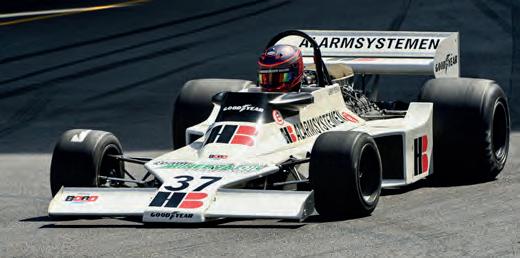
Guillaume ROMAN
N175
La N175 est la troisième F1 construite par Ensign. Ce modèle a fait son apparition au Grand Prix de France aux mains de Gijs Van Lennep, qui a ensuite terminé 6e du Grand Prix d’Allemagne 1975, avant d’en laisser le volant à Chris Amon déçu par son Amon AF1. Pour 1976, la voiture récupérée par le sponsor de l’équipe fut rebaptisée Boro et confiée à Larry Perkins, engagé lors de six Grands Prix (non-qualifié à Monaco).
The N175 is the third F1 car built by the small Ensign team. This car appeared for the first time at the French Grand Prix in the hands of Gijs Van Lennep, who then finished 6th at the German Grand Prix, before leaving the car to Chris Amon who was disappointed by his Amon AF1. For 1976, this car was bought out by the team sponsor and renamed Boro. It was entrusted to Larry Perkins, entered for six World Championship races (not qualified in Monaco).
La 312 B3, dans sa troisième version, est la voiture du renouveau de Ferrari et de la révélation de Niki Lauda. Deux modèles ont été engagés par la Scuderia Ferrari en 1974 et début 1975, la n°11 pour Niki Lauda (2 victoires) et la n°12 pour Clay Regazzoni (vainqueur du Grand Prix d’Allemagne).
Production : 6 voitures en 1974, 1 début 1975.
The 312 B3, in its 3rd version, marked the revival of Ferrari and the revelation of Niki Lauda. Scuderia Ferrari entered two cars in 1974 and at the beginning of 1975: n°11 for Niki Lauda (2 wins) and n°12 for Clay Regazzoni (winner of the German Grand Prix). Production: 6 cars in 1974, 1 at the beginning of 1975.
Andrea BURANI
Cette 312 B3 a disputé cinq Grands Prix en 1974 aux mains de Niki Lauda qui, à son volant, a terminé 3 fois 2e (Argentine, Belgique, Grand Prix de France à Dijon).
This 312 B3 took part in five Grand Prix in 1974 in the hands of Niki Lauda who finished 2nd 3 times (in Argentina, Belgium and at the French Grand Prix in Dijon).
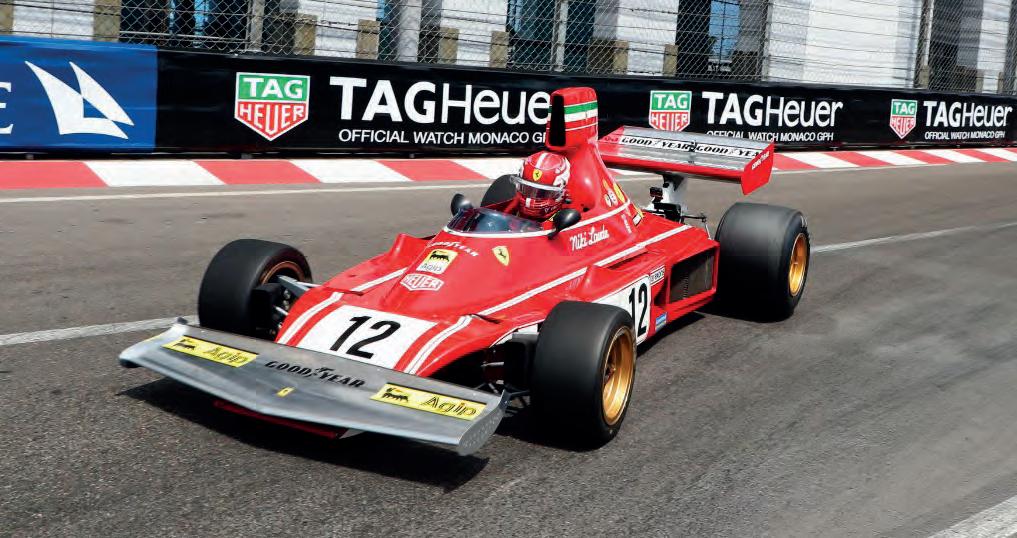
31 37 12
ENSIGN E 102
HESKETH 308
Production : 4 exemplaires en 1974 et 1975. / Production: 4 models built in 1974 and 1975.
James HAGAN
Cette 308 est la toute première F1 construite par Hesketh. Elle a disputé les trois premières courses de 1974 avec James Hunt (victoire à l’International Trophy) et elle a ensuite été pilotée par Ian Scheckter, Alan Jones (abandon à Monaco en 1976), Harald Ertl et Guy Edwards en 1977.
This 308 is the very first F1 car built by Hesketh. It competed in the first three races of 1974 with James Hunt (victory in the International Trophy) and was then used by Ian Scheckter, Alan Jones (retirement in Monaco in 1976), Harald Ertl and Guy Edwards in 1977.

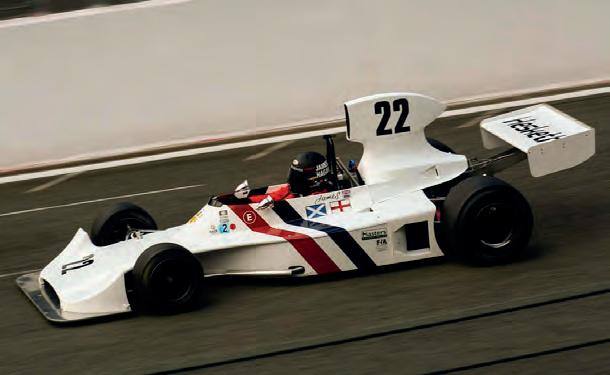
HILL
Production : 4 exemplaires en 1974 (basée sur la Lola T371) / Production: 4 cars in 1974 (based on the Lola T371.

24 22
LOLA
James DAVISON
Achevée après le Grand Prix de Monaco, cette GH1 a participé à 10 Grands Prix en 1974 pilotée par François Migault, Vern Schuppan, Alan Jones (5e au Grand Prix d’Allemagne), Rolf Stommelen et Tony Brise.
This GH1 was finished after the Monaco Grand Prix and took part in 10 races in 1974 driven by François Migault, Vern Schuppan, Alan Jones (5th at the German Grand Prix), Rolf Stommelen and Tony Brise.
Production : 4 voitures construites (1 prototype en 1973, 3 en 1974) / Production: 4 cars built (1 prototype in 1973, 3 in 1974).
Jamie CONSTABLE
Cette Lola a disputé 12 Grands Prix en 1974 avec Graham Hill, Guy Edwards (8e à Monaco) et Rolf Stommelen.
This car took part in 12 World Championship F1 races in 1974 with Graham Hill, Guy Edwards (8th in Monaco) and Rolf Stommelen.

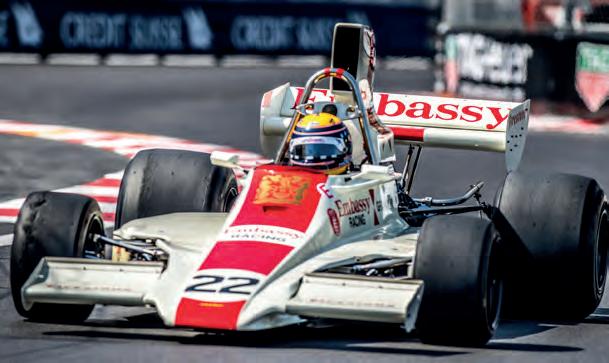
103 14e GRAND PRIX DE MONACO HISTORIQUE 10-12 MAI 2024
27
LOTUS 76
C’est l’un des échecs les plus retentissants de Colin Chapman. La Lotus 76 confiée à Ronnie Peterson et Jacky Ickx était la remplaçante de la 72 sacrée en 1970 et 1972, mais battue en 1973 par la Tyrrell de Jackie Stewart.
Production : 2 exemplaires en 1974 pour Ronnie Peterson (n°1) et Jacky Ickx (n°2)
This is one of Colin Chapman's most resounding failures. The Lotus 76 entrusted to Ronnie Peterson and Jacky Ickx took over from the 72, crowned champion in 1970 and 1972, but beaten in 1973 by Jackie Stewart's Tyrrell. Production: 2 cars in 1974 for Ronnie Peterson (n°1) and Jacky Ickx (n°2).
Marco WERNER
Cette voiture était prévue pour Ronnie Peterson en 1974 mais il l’a laissée de côté après quatre abandons sur les quatre premiers Grands Prix de la saison. La suite lui a donné raison puisque, sur une « vieille » 72, il a remporté les Grands Prix de Monaco (il y a tout juste 50 ans), de France et d’Italie.
This car was planned for Ronnie Peterson in 1974, but he abandoned it after four retirements in the first four races of the season. He made the correct decision and, with an “old” 72, he won in Monaco, France and Italy.
LOTUS 77

La 77 produite en 1976 marque le retour au premier plan du Team Lotus avec deux podiums de Gunnar Nilsson, en Espagne et en Autriche, suivis de deux autres en Hollande et au Canada réussis par Mario Andretti qui a clôturé la saison par une victoire au Japon. Production : 3 exemplaires en 1976 pour Ronnie Peterson, Bob Evans, Mario Andretti (n°5) et Gunnar Nilsson (n°6).
The 77 produced in 1976 marked the return of Team Lotus to the forefront with two podium finishes for Gunnar Nilsson, in Spain and Austria, followed by two more in Holland and Canada recorded by Mario Andretti, who rounded off the season with a win in Japan.
Production: 3 cars in 1976 for Ronnie Peterson, Bob Evans, Mario Andretti (n°5) and Gunnar Nilsson (n°6).
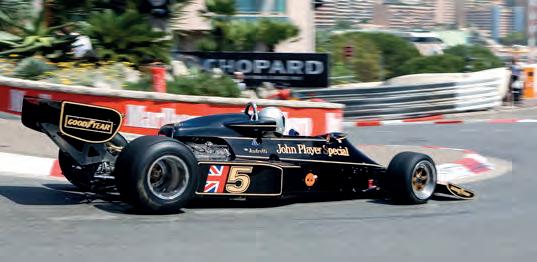

Cette 77 est la seule des trois à avoir disputé toutes les courses de la saison 1976 : Ronnie Peterson, Bob Evans et Gunnar Nilsson se sont succédé à son volant, avec à la clé deux podiums et un abandon pour Nilsson, à Monaco.
This 77 was the only one of three cars produced to take part in all the races of 1976: Ronnie Peterson, Bob Evans and Gunnar Nilsson took turns at its wheel, Nilsson claiming two podiums but having to retire in Monaco.
Christopher LOCKE
Troisième et dernière de la série, cette Lotus 77 a pris trois départs de Grands Prix comptant pour le Championnat du Monde aux mains de Mario Andretti, avec pour meilleur classement sa 3e place en Autriche.
Third and last in the series, this Lotus 77 took three starts in the World Championship in the hands of Mario Andretti, with 3rd place in Austria as its best result. 3 5
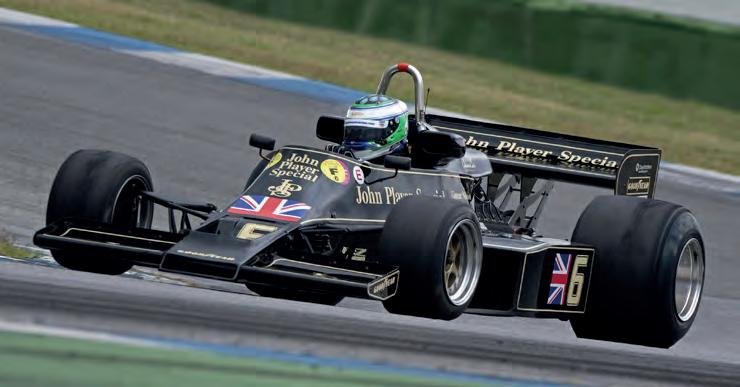
E 104
Nick PADMORE
6
McLAREN M23
Avec la M23, McLaren a remporté 16 victoires en Championnat du Monde et deux titres mondiaux : en 1974 avec Emerson Fittipaldi puis en 1976 avec James Hunt. Elle est aujourd’hui un mythe de la F1 au même titre que la Lotus 72 ou la Williams FW07.
Production : 13 voitures construites (4 en 1973, 4 en 1974, 2 en 1975, 3 en 1976) pour McLaren Racing, pilotées par Denny Hulme, Peter Revson et Jody Scheckter en 1973, Emerson Fittipaldi, Denny Hulme, Mike Hailwood, David Hobbs en 1974, Emerson Fittipaldi et Jochen Mass en 1975, James Hunt et Jochen Mass en 1976.
With the M23, McLaren won 16 World Championship races and two world titles in 1974 with Emerson Fittipaldi and 1976 with James Hunt. This car is part and parcel of the legend of F1, just like the Lotus 72 and the Williams FW07.
Production: 13 cars built (4 in 1973, 4 in 1974, 2 in 1975, 3 in 1976) for McLaren Racing, driven in 1973 by Denny Hulme, Peter Revson and Jody Scheckter, in 1974 by Emerson Fittipaldi, Denny Hulme, Mike Hailwood and David Hobbs, in 1975 by Emerson Fittipaldi and Jochen Mass, in 1976 by James Hunt and Jochen Mass.


Stuart HALL
Cette M23 sortie en 1973 a été, cette année-là, emmenée à la 3e place du Grand Prix d’Allemagne par Jacky Ickx lors de sa seule apparition pour la marque, puis elle a remporté le Grand Prix du Canada aux mains de Peter Revson. Elle a ensuite été pilotée aussi en Championnat du Monde par Denny Hulme, Emerson Fittipaldi, David Hobbs et Jochen Mass.
This M23, released in 1973, was driven to 3rd place at the German Grand Prix that year by Jacky Ickx, in his sole appearance for the brand. It then won the Canadian Grand Prix with Peter Revson at the wheel. It was also driven in the World Championship by Denny Hulme, Emerson Fittipaldi, David Hobbs and Jochen Mass.

Lukas HALUSA
Dernière M23 produite pour l’équipe d’usine en 1976, cette monoplace était confiée à Jochen Mass qui a pris avec elle six départs en Championnat du Monde, en début de saison. L’Allemand a pris deux fois la 4e place, en Espagne et à Monaco, et la 2e place en Suède avant de terminer l’année sur une M26.
This last M23 produced for the factory team in 1976 was entrusted to Jochen Mass who took six starts in the World Championship at the beginning of the season. He recorded two 4th places in Spain and Monaco and a 2nd place in Sweden before finishing the year on a new M26.
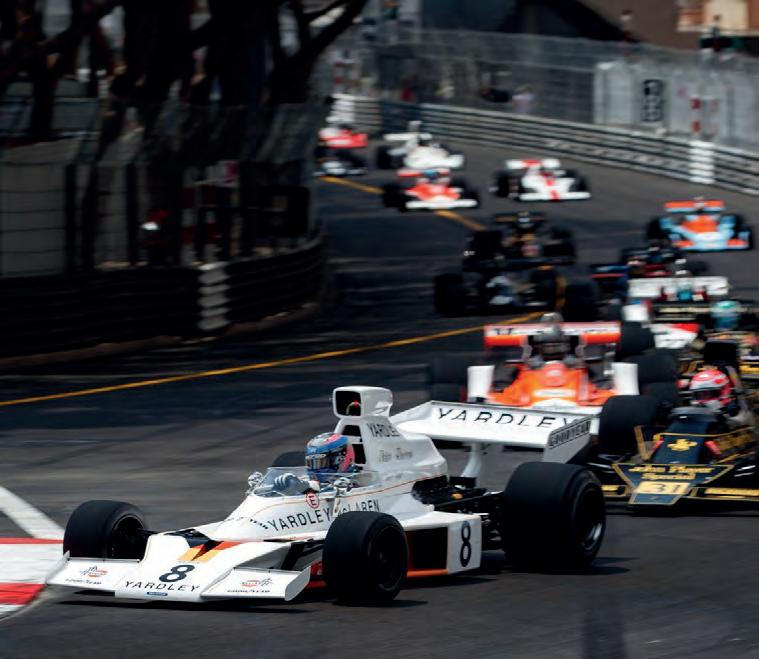
105 14e GRAND PRIX DE MONACO HISTORIQUE 10-12 MAI 2024
2 33 1
McLAREN M26
La M26, remplaçante de la M23, apparaît occasionnellement courant 1976 avant de prendre effectivement le relais à partir de 1977, remportant trois Grands Prix aux mains de James Hunt avant de sombrer en 1978.
Production : 7 voitures (1 en 1976, 2 en 1977, 4 en 1978) pour McLaren Racing, pilotées en 1976 par Jochen Mass (n°12), en 1977 par James Hunt (n°1) et Jochen Mass (n°2), en 1978 par James Hunt (n°7) et Patrick Tambay (n°8).
The M26 replaced the M23, first occasionally during the 1976 season and eventually full time in 1977 when it won three F1 races in the hands of James Hunt before becoming obsolete in 1978.
Production: 7 cars (1 in 1976, 2 in 1977, 4 in 1978) for McLaren Racing, driven in 1976 par Jochen Mass (n°12), in 1977 by James Hunt (n°1) and Jochen Mass (n°2), in 1978 by James Hunt (n°7) and Patrick Tambay (n°8).
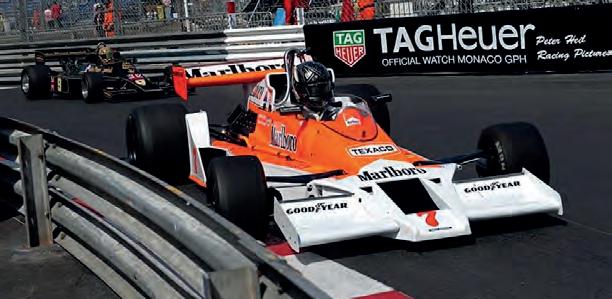
PENSKE PC3
Michael LYONS
Cette M26 est le prototype sorti en 1977. Elle a pris cinq départs en Championnat du Monde, aux mains de Jochen Mass et James Hunt.
This is the prototype of the M26, released in 1977. It took five starts in the World Championship with Jochen Mass and James Hunt at the wheel.
Copie de la March 751 essayée au cours de la saison 1975, la PC3 se montra un peu meilleure que la PC1 qui l’avait précédée. Elle permit même à John Watson de marquer deux points au Championnat du Monde grâce à sa 5e place au Grand Prix d’Afrique du Sud. Pas à la hauteur des ambitions de l’équipe américaine, elle fut remplacée en cours de saison par la PC4.
Production : 2 exemplaires (une fin 1975, une autre au début de 1976) pour John Watson (n°28)
The PC3 was a copy of the March 751 tried during the 1975 season and it proved a little better than the PC1 which had preceded it. It even allowed John Watson to score two World Championship points thanks to a 5th place in the South African Grand Prix. Not up to the ambitions of the American team, it was replaced during the season by the PC4.
Production: 2 cars (1 at the end of 1975, another one at the beginning of 1976 for John Watson (n°28).

Stanley FULTON
Cette PC3 est celle de 1975, mais elle a aussi participé à quatre Grands Prix en 1976 : 7e en Afrique du Sud et en Belgique, 10e à Monaco.
This PC3 was produced in 1975, but it took part in four more F1 races in 1976: 7th in South Africa and Belgium, 10th in Monaco.
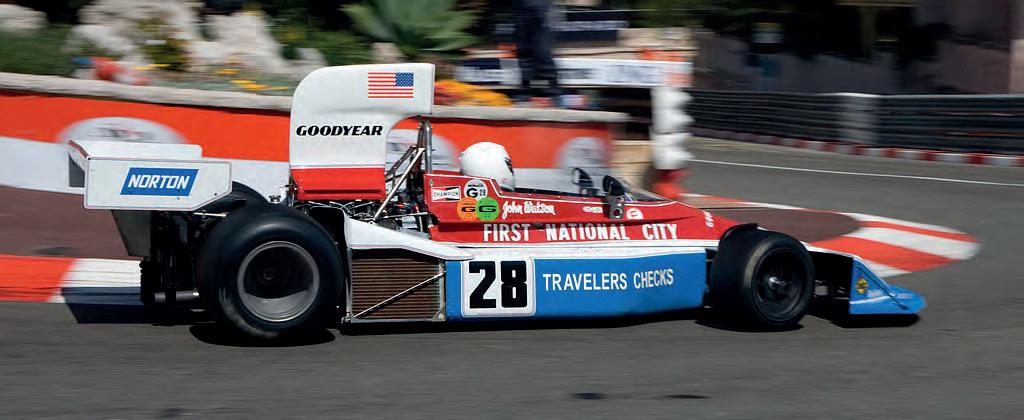


Matthew WRIGLEY
Les deux départs pris en Championnat du Monde par John Watson au volant de cette PC3 se sont soldés par autant d’abandons. Sur les autres Grand Prix du début de saison 1976, elle était voiture de réserve, notamment à Monaco.
Both starts taken in the World Championship by John Watson at the wheel of this car ended with a retirement. On the other races at the beginning of the 1976 season, it was only a reserve car, notably in Monaco.
1 29
28
E 10 6
PENSKE PC4
La PC4, dernière F1 de l’écurie américaine, s’avéra d’emblée une bonne monoplace. Après un abandon lors de ses débuts en Suède, elle permit à John Watson de terminer 3e des Grands Prix de France et de Grande-Bretagne, en 1976, et même de remporter le Grand Prix d’Autriche. Malgré ces bons résultat, Penske abandonna l’Europe et vendit tout le matériel à Gunther Schmidt qui rebaptisa l’écurie ATS. Production : 3 voitures, dont 2 en 1976 pour John Watson (n°28), puis une troisième en 1977 pour Jean-Pierre Jarier (n°34) et Hans Heyer, puis Hans Binder (n°35).
The PC4 was the last F1 car built by the American team and it proved to be a good single-seater, right from the start. After a retirement for its debut in Sweden, it allowed John Watson to finish 3rd at the French and British Grand Prix, before winning the Austrian Grand Prix. Despite these good results, Penske gave up Europe and sold all the equipment to Gunther Schmidt who renamed the team ATS.
Production: 3 cars, 2 of them in 1976 for John Watson (n°28) and a third one in 1977 for Jean-Pierre Jarier (n°34) and Hans Heyer, then Hans Binder (n°35).

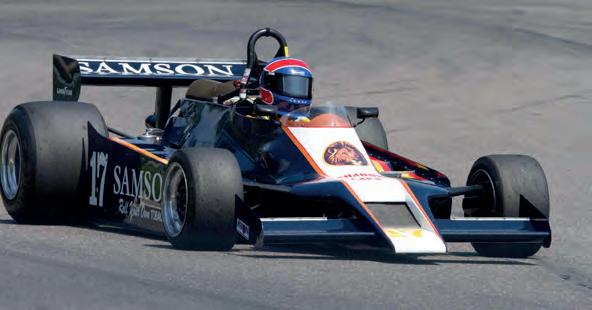
SHADOW DN1
Douglas MOCKETT
Cette PC4 a permis à John Watson de monter sur le podium (3e) en France et en Grande-Bretagne, avant de remporter le Grand Prix d’Autriche en 1976. Dans le cadre de l’équipe ATS, en 1977, elle a été pilotée par JeanPierre Jarier, notamment lors de sa 11e place à Monaco.
This car allowed John Watson to take 3rd place at the French and British Grand Prix, before winning the Austrian Grand Prix in 1976. In 1977, it was driven by Jean-Pierre Jarier in the ATS team, claming an 11th place in Monaco.
Production : 6 exemplaires en 1973, engagés par Nichols AVS pour George Folmer (n°16) et Jackie Oliver (n°17), et par Graham Hill à titre privé (n°12) / Production: 6 cars in 1973, entered by Nichols AVS for George Folmer (n°16) and Jackie Oliver (n°17), and by Graham Hill privately (n°12).
Fabrice NOTARI
C’est avec cette DN1 que Graham Hill (5 fois victorieux à Monaco) a lancé son équipe en F1. Il a participé à son volant à 12 des 14 manches du Championnat du Monde 1973, dont le Grand Prix de Monaco où il a été contraint à l’abandon.
With this DN1, Graham Hill (a 5-time winner in Monaco) launched his team in F1. He took part in 12 of the 14 rounds of the World Championship 1973, including Monaco Grand Prix where he was forced to retire.




Toni SEILER
Cette DN1 a souvent été utilisée par Jackie Oliver en 1973, 10e à Monaco cette année-là.
This DN1 was most often used by Jackie Oliver in 1973, 10th in Monaco that year.
107 14e GRAND PRIX DE MONACO HISTORIQUE 10-12 MAI 2024
34 14 15
1
SHADOW DN3
Production : 5 exemplaires construits en 1974, engagés par Nichols AVS pour Peter Revson, Brian Redman, Bertil Ross, Tom Pryce (n°16) et Jean-Pierre Jarier (n°17).
Production: 5 cars built in 1974 and entered by Nichols AVS for Peter Revson, Brian Redman, Bertil Ross, Tom Pryce (n°16) and Jean-Pierre Jarier (n°17).

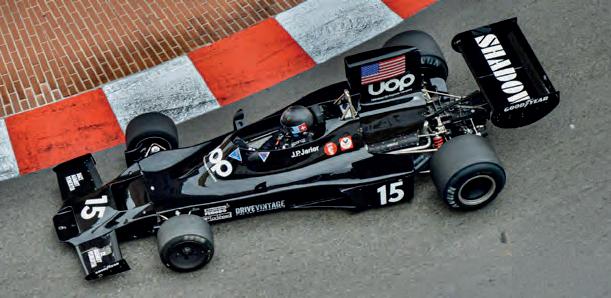
SHADOW DN5
Jean-Denis DELETRAZ
Cette DN3 a été pilotée par Jean-Pierre Jarier pendant la saison 1974 avec comme meilleur résultat sa 3e place dans les rues de la Principauté. This DN3 was driven by Jean-Pierre Jarier in 1974 with a 3rd place in the streets of the Principality as its best result.
Production : 6 exemplaires (5 en 1975, 1 en 1976) engagés par Nichols AVS en 1975 et 1976 pour Tom Pryce (n°16) et Jean-Pierre Jarier (n°17).
Production: 6 cars (5 in 1975, 1 in 1976) entered by Nichols AVS in 1975 and 1976 for Tom Pryce (n°16) and Jean-Pierre Jarier (n°17).

Marco BIANCHINI
En 1975 et 1976, cette DN5 a été exclusivement pilotée par Jean-Pierre Jarier qui a pris 23 départs étalés sur deux saisons de F1 (8e à Monaco en 1976).
In 1975 and 1976, this DN5 was exclusively driven by JeanPierre Jarier who took 23 starts spread over two F1 seasons (8th in Monaco in 1976).
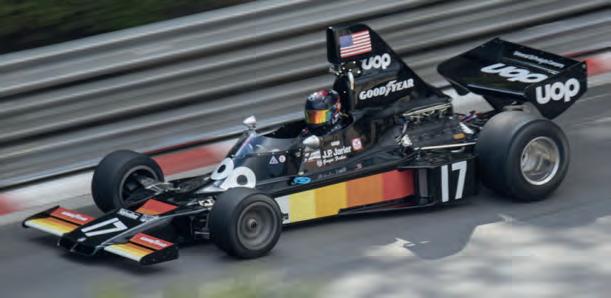
SURTEES TS16
Production : 5 exemplaires produits en 1974, engagés par Team Surtees pour Carlos Pace, Jochen Mass, Jean-Pierre Jabouille, José Dolhem, Dieter Quester et occasionnellement Léo Kinnunen en 1974, puis pour John Watson et occasionnellement David Morgan en 1975.
Production: 5 models produced in 1974, entered by Team Surtees for Carlos Pace, Jochen Mass, Jean-Pierre Jabouille, José Dolhem, Dieter Quester and occasionally Léo Kinnunen in 1974, then for John Watson and occasionally David Morgan in 1975.

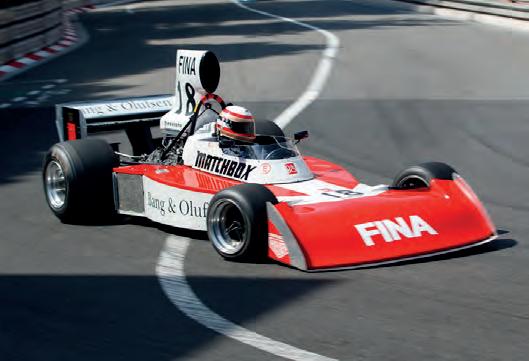
Marc DEVIS
Cette TS16 a été pilotée en 1974 par Carlos Pace (4e au Grand Prix du Brésil, abandon à Monaco), Jochen Mass lors de trois Grands Prix et Jean-Pierre Jabouille (non-qualifié en Autriche).
En 1975, alors qu’elle était le mulet de l’équipe, elle a pris deux départs : au Grand Prix de Monaco avec John Watson (abandon) et en Grande-Bretagne avec Dave Morgan (18e).
This TS16 was driven in 1974 by Carlos Pace (4th at the Brazilian Grand Prix, retirement in Monaco), Jochen Mass for three races and JeanPierre Jabouille (not-qualified in Austria). In 1975, designated as the team's mule, it took two starts: at Monaco Grand Prix with John Watson (retirement) and at the British Grand Prix with Dave Morgan (18th).
16 18 17 E 108
SURTEES TS19
Production : 7 exemplaires (4 en 1976, 3 en 1977) engagés par Team Surtees en 1976 pour Brett Lunger (n°18) et Alan Jones (n°19), en 1977 pour Hans Binder, Larry Perkins, Patrick Tambay, Lamberto Leoni (n°18) et Vittorio Brambilla (n°19), en 1978 pour Rupert Keegan (n°18) et Vittorio Brambilla (n°19).
Production: 7 cars (4 in 1976, 3 in 1977) entered by Team Surtees in 1976 for Brett Lunger (n°18) and Alan Jones (n°19), in 1977 for Hans Binder, Larry Perkins, Patrick Tambay, Lamberto Leoni (n°18) and Vittorio Brambilla (n°19), in 1978 for Rupert Keegan (n°18) and Vittorio Brambilla (n°19).
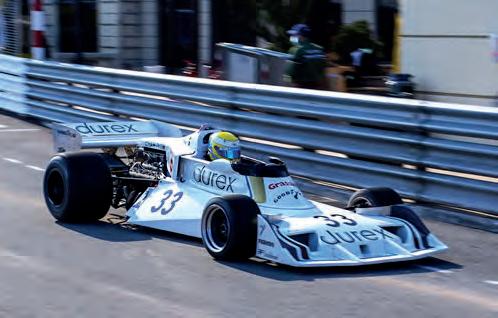
TROJAN T103
Fred LAJOUX
Cette TS19 a disputé quatre Grands Prix à la fin de la saison 1976 aux mains d’Alan Jones (4e au Japon), puis les deux premiers Grand Prix de la saison 1977 avec Vittorio Brambilla. Elle a poursuivi sa carrière aux mains de Divina Galica dans le Championnat Aurora de F1.
This TS19 took part in four F1 races at the end of the 1976 season, in the hands of Alan Jones (4th in Japan), then in the first two Grand Prix of 1977 with Vittorio Brambilla at the wheel. It continued its career in the hands of Divina Galica in the Aurora F1 Championship.
Associé dès l’origine en 1961 à Jack Brabham comme constructeur (il est notamment le T dans la désignation de tous les modèles de Brabham), l’ingénieur Ron Tauranac a ensuite, en 1974, dessiné pour la firme Trojan une F5000 type T102 déclinée en T103 pour la F1. Un exemplaire unique a été construit en 1974 et confié à Tim Schenken (n°23).
Associated from the beginning in 1961 with Jack Brabham as a manufacturer (his T appears in the designation of all Brabham models), engineer Ron Tauranac then decided, in 1974, to design for the Trojan firm a F5000 type T102 declined in T103 for F1. One unique model was built in 1974 and entrusted to Tim Schenken (n°23).
Philippe BONNY
Inscrite à 8 manches du Championnat du Monde, la Trojan T103 a abandonné à Monaco mais n’a raté que deux fois sa qualification, dans un contexte pourtant très relevé.
Entered for 8 rounds of the World Championship, the Trojan T103 retired in Monaco but only failed to qualify twice in a highly competitive field.

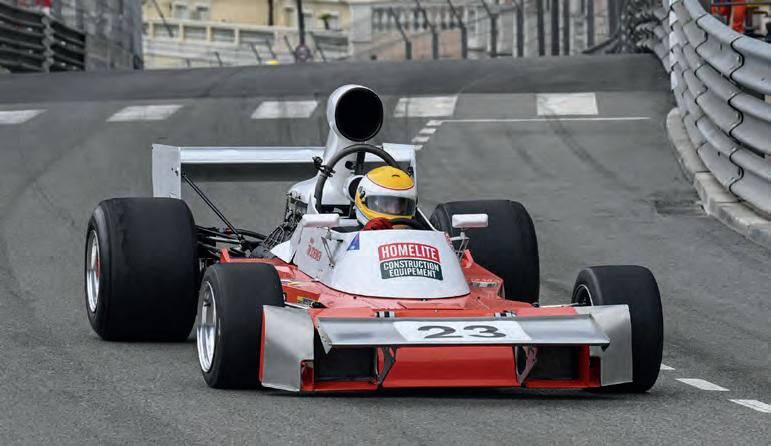
109 14e GRAND PRIX DE MONACO HISTORIQUE 10-12 MAI 2024
23
19
TYRRELL 007
La 007 est la première Tyrrell de l’ère post-Stewart. Véritable réussite, elle a permis à l’équipe d’Oncle Ken de surmonter avec succès la retraite de Jackie Stewart et le tragique accident de François Cevert fin 1973.
Production : 6 exemplaires (4 en 1974, 2 en 1975) engagés par Tyrrell Racing de 1974 à 1976 pour Jody Scheckter (2e à Monaco en 1974, 3 victoires), Patrick Depailler, Jean-Pierre Jabouille et Michel Leclère occasionnellement.
The 007 is the first Tyrrell of the post-Stewart era. A real success, it allowed Uncle Ken’s team to successfully overcome the end of Jackie Stewart’s F1 career and the tragic death of François Cevert at the end of 1973.
Production: 6 cars (4 in 1974, 2 in 1975) entered by Tyrrell Racing from 1974 to 1976 for Jody Scheckter (2nd in Monaco in 1974, 3 wins), Patrick Depailler, JeanPierre Jabouille and Michel Leclère occasionally.

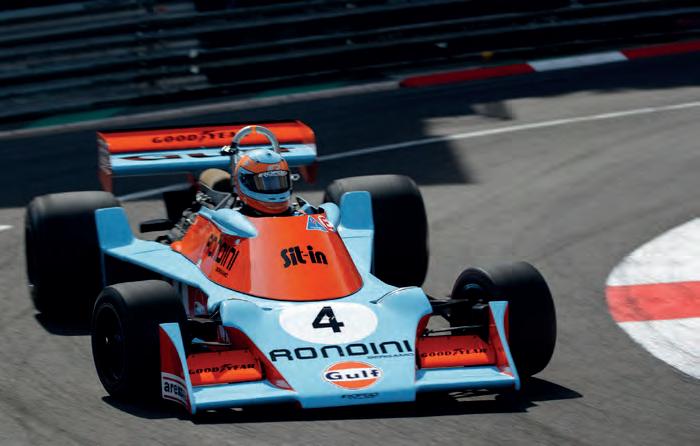
4
WILLIAMS FW05
Roald GOETHE
Cette 007 a été exclusivement utilisée dans le cadre du Team Tyrrell par Patrick Depailler (vainqueur à Monaco en 1978 sur un modèle 008). A son volant, le Français a pris 21 départs, dont 20 en Championnat du Monde, et il a fini 11 fois dans les points (5e à Monaco en 1975).
This 007 was only entered by Team Tyrrell for Patrick Depailler (Monaco winner in 1978 with the 008). Behind its wheel, the Frenchman started 21 races, 20 of them in the World Championship, and managed to finish 11 times in the points (5th in Monaco in 1975).
Construites sur des coques de Hesketh 308C, les Williams FW05, financées par le milliardaire canadien Walter Wolf, ont été engagées en 1976 par Frank Williams pour Jacky Ickx puis Arturo Merzario et Michel Leclère.
Production : 3 exemplaires
Built on hulls originally used for Hesketh 308Cs, the Williams FW05s, financed by Canadian billionaire Walter Wolf, were entered in 1976 by Frank Williams for Jacky Ickx, then Arturo Merzario and Michel Leclère.
Production : 3 cars
Toriba YUTAKA
Cette Williams FW05, pilotée par Jacky Ickx, a pris son premier départ en juillet 1976 au Grand Prix de France, puis Arturo Merzario a pris part à six Grands Prix en fin de saison.
This Williams FW05, driven by Jacky Ickx, took its first start in July 1976 at the French Grand Prix, then Arturo Merzario finished the season, taking part in six F1 races.
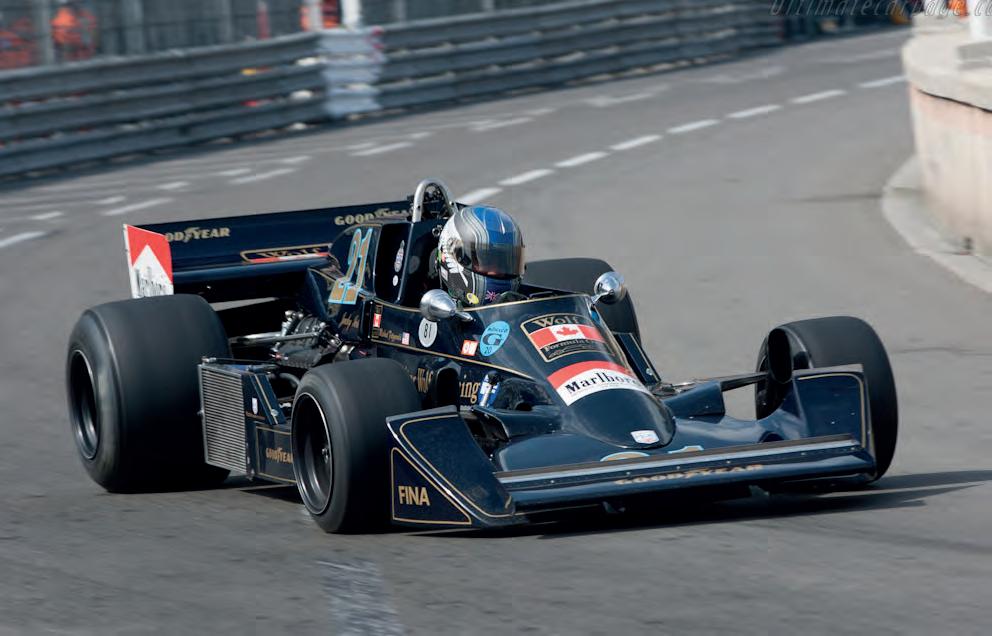
E 110
20
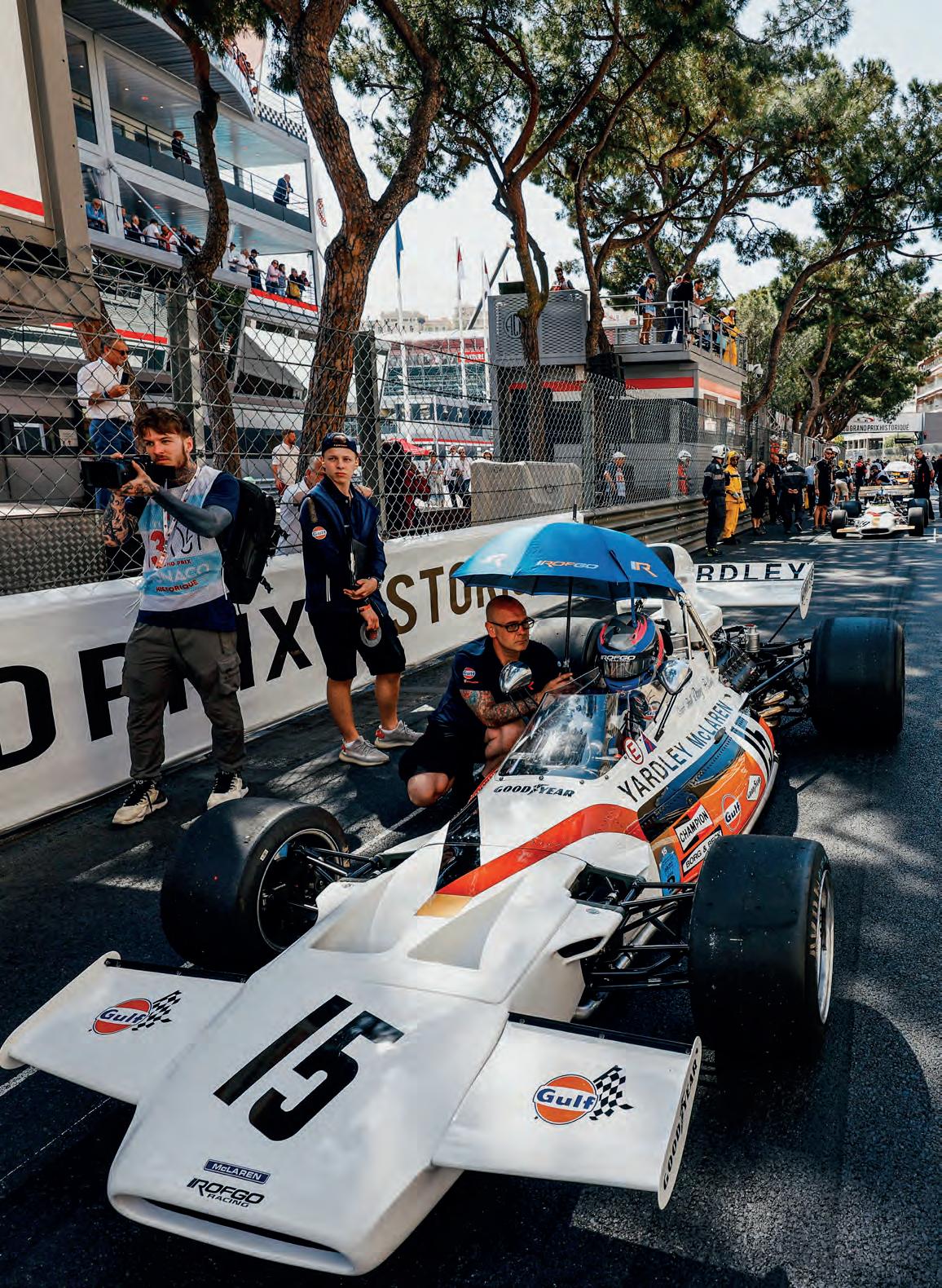
111 14e GRAND PRIX DE MONACO HISTORIQUE 10-12 MAI 2024 E

GILLES
VILLENEUVE
1977: Jody Scheckter / Wolf WR1
1978: Patrick Depailler / Tyrrell 008
1979: Jody Scheckter / Ferrari 312T4
1980: Carlos Reutemann / Williams FW07B
VOITURES DE GRAND PRIX À MOTEUR 3 LITRES DE 1977 À 1980
F1 GRAND PRIX CARS WITH A 3-LITER ENGINE FROM 1977 TO 1980
REGLEMENT (Extrait, Article 4) / RULE BOOK (Extract, Article 4)
Le 14 e Grand Prix de Monaco Historique est ouvert aux voitures définies par l’annexe K du Code Sportif International de la F.I.A. / The 14th Grand Prix de Monaco
Historique is open to cars defined by Appendix K of the FIA International Sporting Code.
Les voitures sont admises en 3 classes / The cars are admitted in 3 classes:
Classe 1 : Voitures conçues sans effet de sol / Cars designed not to exploit the ground effect.
Classe 2 : Voitures conçues avec effet de sol et équipées d’un moteur FordCosworth DFV / Cars designed to exploit ground effect, equipped with a Ford-Cosworth DFV engine.
Classe 3 : Voitures conçues avec effet de sol et équipées d’un autre moteur / Cars designed to exploit ground effect, equipped with other engines.
Avec l’apparition en 1977 de la Lotus 78 à effet de sol, la physionomie des monoplaces de F1 vont rapidement et durablement changer. Tous les constructeurs vont devoir adopter la structure de cette auto novatrice : coque étroite autour d’un pilote placé très en avant, afin de loger tout le carburant entre le cockpit et le moteur. Le but ? Libérer l’espace de part et d’autre de la coque pour produire de l’effet de sol sous les pontons, dans l’idée de se passer, à terme, des ailerons.
Les forces encaissées par les pilotes, et les vitesses de passage en courbe, vont atteindre et parfois dépasser les limites des hommes et des circuits. Pour tenter de limiter les performances, la FIA décide à partir de 1981 l’augmentation de la garde au sol minimum et la suppression des jupes. La mesure sera complétée par les fonds plats à partir de 1983.
La Série F retrace, au travers des monoplaces invitées, la naissance, le développement et l’apogée de cette technologie, jusqu’à sa limitation à partir de la saison 1981.
With the advent, in 1977, of the Lotus 78 with ground effect, the shape of F1 single-seaters rapidly and durably changes. Manufacturers adopted the structure of this innovative car: a narrow shell around the driver who is seated closer to the front of the car, so that all the fuel can be stored between the cockpit and the engine. The goal is to liberate extra space around the shell to produce a stronger ground effect under the pontoons, and eventually to get rid of wings and spoilers.
Due to this evolution, the G-forces on the drivers and the curve speeds reached, and sometimes exceeded, the limits of men and circuits. To limit performances, the FIA decided in 1981 to heighten the minimum ride height and to get rid of skirts. The measure was completed by the generalization of flat underbodies starting in 1981.
The F-Series retraces, through all the single-seaters invited, the birth, development and climax of this technology, until its limitation from 1981.
VAINQUEURS DU GRAND PRIX DE MONACO MONACO GRAND PRIX WINNERS 1981
F SÉRIE RACE
112

14e GRAND PRIX DE MONACO HISTORIQUE 10-12 MAI 2024 N° PILOTE / DRIVER NAT CONCURRENT VOITURE / CAR MODÈLE ANNÉE CL. 2 BODEN Juergen AUT BODEN Juergen FERRARI 312 T5 1980 1 3 CANTILLON Michael GBR CANTILLON Michael TYRRELL 010 1980 2 4 MONTAGNY Franck FRA AGS RACING TYRRELL 010 1980 2 5 DEVIS Marc BEL DEVIS Marc LOTUS 78 1977 2 6 MOWLE Lee GBR CLASSIC TEAM LOTUS LTD LOTUS 78 1977 2 7 DE QUESADA Carlos USA CHROMECARS RACING McLAREN M26 1977 1 9 MATILE Nicolas MCO MATILE Nicolas MARCH 771 1977 1 10 CANDIANI Gianluigi ITA BIAMINO Luciano ENSIGN N180 1980 2 11 BIAMINO Luciano ITA BIAMINO Luciano LOTUS 81 1980 2 12 BROOKS Steven GBR BROOKS Steven LOTUS 81 1980 2 14 GRIFFITHS Miles GBR GRIFFITHS Miles FITTIPALDI F5A 1977 1 15 SPENCER Robert GBR SPENCER Robert FITTIPALDI F5A 1977 1 16 CONSTABLE Jamie GBR CONSTABLE Jamie SHADOW DN8 1977 1 17 SERGISON Ewen GBR SERGISON Ewen SHADOW DN9 1978 1 18 HANCOCK Sam GBR HANCOCK Sam FITTIPALDI F8 1980 2 19 COCHET Jonathan FRA COCHET Jonathan FITTIPALDI F6A 1979 2 20 TAYLOR Wayne USA TAYLOR Wayne WOLF F1 WR4 1977 1 21 VAN EERD Frits NLD VAN EERD Frits FITTIPALDI F7 1980 2 22 TATTERSALL Paul GBR TATTERSALL Paul ENSIGN N179 1979 2 23 OVERINGTON Martin GBR OVERINGTON Martin HESKETH 308E 1977 2 24 LYONS Michael GBR LYONS Michael HESKETH 308E 1977 1 25 MISTER JOHN OF B FRA MISTER JOHN OF B LIGIER JS11/15 1979 2 26 HAZELL Mark GBR HAZELL Mark WILLIAMS FW07B 1980 2 27 BROWN Zak USA UNITED AUTOSPORTS WILLIAMS FW07B 1980 2 28 SHAW David GBR SHAW David WILLIAMS FW06 1979 1 29 COPPINI Marco ITA COPPINI Marco ARROWS A1B 1978 2 30 BECKER Harald DEU BECKER Harald ARROWS A3 1980 2 31 MAYDON Ronald GBR MAYDON Ronald LEC CRP1 1977 1 33 D'AUBREBY Patrick FRA D'AUBREBY Patrick MARCH 761 1977 1 1 Voiture victorieuse d’un ou plusieurs Grand Prix du Championnat du Monde Voiture présente en période au Grand Prix de Monaco
113
LISTE DES ENGAGÉS I ENTRY LIST
ARROWS A1
Dans l’urgence, suite au procès perdu interdisant sa première F1, Arrows a conçu l’A1 qui a débuté en Autriche, en deuxième partie de saison, avec deux voitures pour Riccardo Patrese et Rolf Stommelen. En attendant la sortie de l’A2, les A1 étaient à nouveau de sortie en 1979, rebaptisées A1B, pour Riccardo Patrese et Jochen Mass. Production : 6 voitures produites en 1978, dont 3 modifiées en A1B pour 1979.
Following the lost lawsuit prohibiting its first F1, Arrows designed the A1 which started the second half of the 1978 season in Austria, with two cars entered for Riccardo Patrese and Rolf Stommelen. While waiting for the A2 to be finished, the A1 was again entered in 1979 and labelled A1B, driven by Riccardo Patrese and Jochen Mass. Production: 6 cars produced in 1978 including 3 modified A1B for 1979.

ARROWS A3
Marco COPPINI
Cette A1 a été impliquée en 1978 dans l’accident mortel de Ronnie Peterson à Monza, ce qui a valu à son pilote Riccardo Patrese, injustement accusé, d’être suspendu pour le Grand Prix suivant disputé aux Etats-Unis. De retour au Canada, l’Italien a démontré ses qualités et celles de cette monoplace en terminant 4e. En 1979, Jochen Mass a débuté la saison à son volant avant qu’elle ne soit vendue pour participer au Championnat Aurora de F1.
Involved in 1978 with this A1 in Ronnie Peterson’s fatal crash in Monza, Riccardo Patrese was unfairly accused and suspended for the next Grand Prix in the United States. When he came back in Canada, he showed his talent and the qualities of this car by finishing 4th. In 1979, Jochen Mass started the season behind its wheel, before it was sold to take part in the Aurora F1 Championship.
Après la tentative audacieuse et avortée de la « révolutionnaire » A2 de 1979, Arrows est revenu à quelque chose de plus classique avec l’A3. En 1980, Riccardo Patrese et Jochen Mass étaient les pilotes titulaires, puis en 1981 Patrese a fait équipe avec Siegfried Stohr, occasionnellement remplacé par Jacques Villeneuve, frère de Gilles et oncle de Jacques, Champion du Monde chez Williams. Production : 6 voitures en 1980, dont 3 modifiées pour 1981.
After the audacious but failed attempt with the « revolutionary » A2 in 1979, Arrows returned to more classic ideas with the A3. In 1980, it was driven by Riccardo Patrese and Jochen Mass. In 1981 Patrese teamed up with Siegfried Stohr, occasionally replaced by Jacques Villeneuve, brother of Gilles and uncle of younger Jacques, a World Champion with Williams. Production: 6 cars in 1980, 3 of them modified for 1981.
Harald BECKER
Cette A3 a débuté à Monaco aux mains de Riccardo Patrese dont elle est devenue la voiture habituelle, y compris en 1981 quand il a terminé 2e du Grand Prix de Saint Marin.
This car made its debut in Monaco in the hands of Riccardo Patrese and then became his usual car, including in 1981 when he finished 2nd of the San Marino Grand Prix.

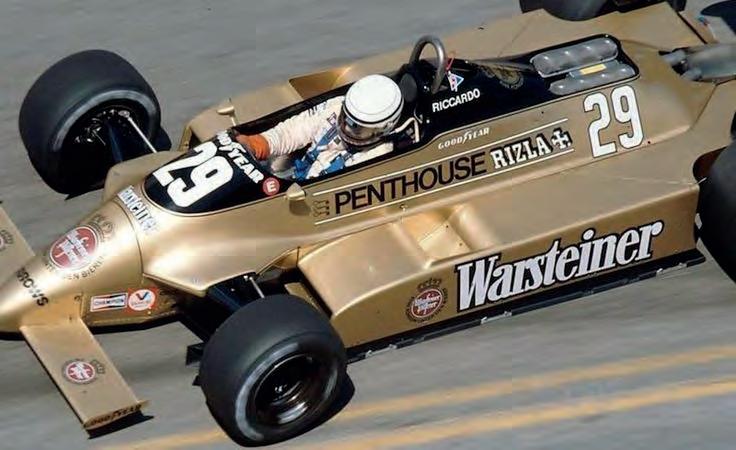
F 114
30
29
ENSIGN


Gianluigi CANDIANI
Cette N180 a été engagée lors de cinq Grands Prix en 1980, successivement pour Tiff Needell, Jan Lammers et Geoff Lees. A Monaco, elle était la voiture de réserve de Tiff Needell (nonqualifié).
Production : 4 voitures (3 en 1980, 1 en 1981)
This N180 was entered for five F1 races in 1980, successively for Tiff Needell, Jan Lammers and Geoff Lees. In Monaco, it was the reserve car for Tiff Needell (not qualified).
Production: 4 cars (3 in 1980, 1 in 1981)
FERRARI 312T5
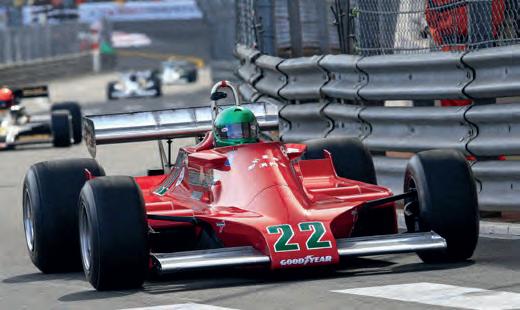
Paul TATTERSALL
La N179 marque le passage d’Ensign à l’effet de sol. Dans la monoplace numéro 22, trois pilotes se sont succédé : Derek Daly d’abord, puis Patrick Gaillard et enfin Marc Surer. Sur douze engagements, il y a eu sept non-qualifications, dont celle de Daly à Monaco.
Production : 1 voiture en 1979
The N179 marked Ensign's transition to the ground effect. In car number 22, three drivers alternated with various fortunes: Derek Daly first, then Patrick Gaillard and eventually Marc Surer. Out of twelve entries, the car failed to qualify seven times, including Daly in Monaco.
Production: 1 car in 1979
La Ferrari 312T5 fait suite à la 312T4 qui a permis à Jody Scheckter de remporter le titre de Champion du Monde en 1979 devant son coéquipier Gilles Villeneuve. Elle est la dernière monoplace à moteur 3L V12 (312) d’une série débutée en 1966 et ses performances décevantes en 1980 restent un mystère. Les Williams FW07, Brabham BT49 et Ligier JS11/15 se sont toutes montrées supérieures. Suivant la voie initiée par Renault en 1977, la Scuderia Ferrari est ensuite passée au turbo en 1981 et l’a conservé jusqu’en 1988. Production : 7 voitures, dont 3 à partir d’anciennes 312T4.
The Ferrari 312T5 took over from the 312T4 which enabled Jody Scheckter to win the 1979 World Championship ahead of team-mate Gilles Villeneuve. It was the last 3L V12 (312) single-seater in a series that began in 1966, and its disappointing level of performance in 1980 remains a mystery. The Williams FW07, Brabham BT49 and Ligier JS11/15 were all superior. Following in the footsteps of Renault in 1977, Ferrari switched to turbocharging in 1981 and continued to do so until 1988. Production: 7 cars, including 3 based on former 312T4s.
Juergen BODEN
Gilles Villeneuve a pris 15 départs de Grand Prix au volant d’une Ferrari 312T5, dont 4 sur celle-ci, la dernière produite. C’est avec le modèle 126CK, à moteur turbo, qu’il a remporté le Grand Prix de Monaco l’année suivante.
Gilles Villeneuve took 15 Grand Prix starts at the wheel of a Ferrari 312T5, including 4 in the one shown here, which was the last produced. With the 126CK, the first turbocharged F1 built by the Scuderia, the Canadian driver won the Monaco Grand Prix the following year.

115 14e GRAND PRIX DE MONACO HISTORIQUE 10-12 MAI 2024
2
10 22
FITTIPALDI F5A
La F5A a d’abord été une auto classique déguisée en voiture à effet de sol, sa coque large ancienne génération ne permettant pas d’installer des pontons contenant des passages d’air. Elle a évolué pour devenir une « semi wing-car », mais reste de loin la meilleure de toutes les Fittipaldi produites par l’écurie familiale brésilienne. Production : 3 exemplaires en 1978, 1 copie en 1979.
The F5A was at first a classic car disguised as a ground effect car, since its old generation wide hull did not allow the installation of pontoons for air flows. It evolved to become a semi-wing-car and remains, by far, the best of all the Fittipaldi F1 cars produced by the Brazilian family team.
Production: 3 cars produced in 1978, one copy in 1979

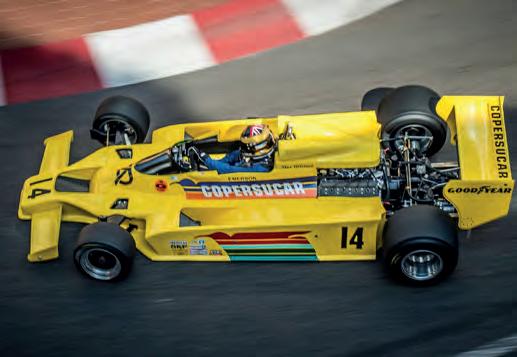
Robert SPENCER
Cette F5A a pris quatre départs en Grand Prix, en 1978, pilotée par Emerson Fittipaldi, avec pour meilleur classement une 6e place au Grand Prix de Suède. A Monaco, elle avait été déplacée comme voiture de réserve pour le double champion du monde brésilien. En 1979, elle a poursuivi sa carrière en Championnat Aurora, le plus souvent aux mains de Guy Edwards.
This F5A took four Grand Prix starts, driven by Emerson Fittipaldi, with 6th place at the Swedish Grand Prix as its best result. In Monaco, it was the reserve car for the Brazilian double world champion). In 1979, it continued its career in the Aurora F1 series, most often in the hands of Guy Edwards.
FITTIPALDI F6
Miles GRIFFITH
Cette F5A était en 1978 le mulet habituel d’Emerson Fittipaldi qui l’a pilotée lors de trois Grands Prix dont celui de Monaco (9e). En 1979, après la tournée rituelle de début de saison en Amérique du Sud, elle a été cédée à une écurie anglaise qui en a confié le volant à Bernard de Dryver dans le Championnat Aurora de F1.
This F5A was for the most part of 1978 the usual mule for Emerson Fittipaldi. He drove it however at three World Championship races, one of them being Monaco (9th). In 1979, after the South American tour ritually starting the season, the car was sold to a British team which entered it for Bernard de Dryver in the Aurora Championship.

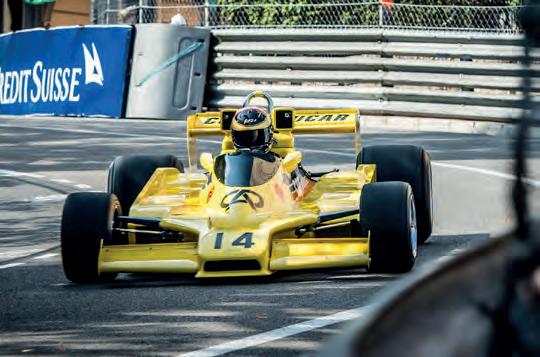
Le passage de Fittipaldi Automotive à l’effet de sol, avec cette voiture, a été un tel échec qu’elle a rapidement été laissée de côté au profit de la F5A de la saison précédente.
Production: 2 voitures en 1978.
Fittipaldi Automotive's move to the ground effect with this car was such a failure that it was quickly left aside in favor of the F5A of the previous season.
Production: 2 cars in 1978.

Jonathan COCHET
Aux mains d’Emerson Fittipaldi, cette F6 a pris sept départs de Grand Prix et a terminé quatre fois, mais toujours hors des points. A Monaco, elle était absente pour subir à l’usine des modifications la faisant passer de F6 à F6A.
In the hands of Emerson Fittipaldi, this F6 took seven Grand Prix starts and finished four times but always out of the points. In Monaco, it was absent to undergo modifications at the factory and be changed from F6 to F6A. 14
F 116
15
19
FITTIPALDI F7
L’échec de la F6 a amené l’écurie brésilienne à racheter les deux châssis Wolf, l’écurie canadienne devenue orpheline suite à la retraite inattendue de son pilote vedette, James Hunt. Les anciennes Wolf, une fois modifiées, sont devenues les deux premières Fittipaldi F7. C’est le dernier modèle de F1 piloté par Emerson Fittipaldi, Champion du Monde en 1972 et 1974. Production : 3 exemplaires en 1980.
The failure of the F6 led the Brazilian team to buy back the two Wolf chassis, the Canadian team being orphaned by the sudden retirement of its star driver James Hunt. So that the modified Wolf cars became the first two Fittipaldi F7. This was the last F1 driven by Emerson Fittipaldi, the 1972 and 1974 World Champion.
Production: 3 cars in 1980.

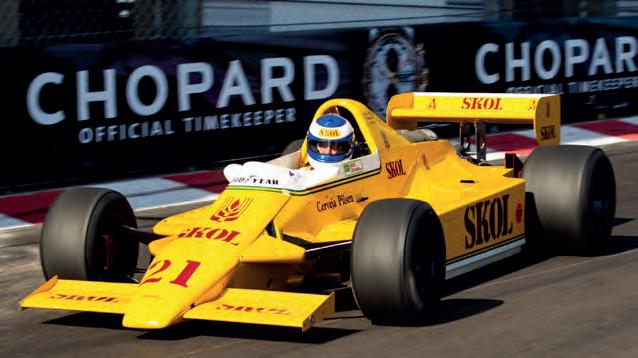
FITTIPALDI F8
Frits VAN EERD
Cette F7, la seule de la série à ne pas être née Wolf, a pris deux départs sans résultat aux mains de Keke Rosberg, le futur Champion du Monde (en 1982 chez Williams). A Monaco, elle était présente mais seulement comme voiture de réserve.
This is the only car of the F7 series which was not born as a Wolf. It started two races (with no significant result) in the hands of Keke Rosberg, the future World Champion (in 1982 with Williams). It was present in Monaco, but only as a reserve car.
Remplaçant en milieu de saison 1980 la F7 dont elle était une simple évolution, la F8 pilotée par Emerson Fittipaldi et Keke Rosberg (l’ancien et le futur champion du monde), s’est rapidement avérée déficiente. Malgré les modifications apportées pour la saison 1981, elle n’a pas permis à Rosberg et à Chico Serra, tout seul en 1982, de faire des merveilles.
Production : 5 exemplaires (2 F8 en 1980, 2 versions F8C en 1981, 1 version F8D en 1982).
Replacing the F7, of which it was a simple evolution, during the 1980 season, the F8 driven by Emerson Fittipaldi and Keke Rosberg (a former and future world champions) quickly proved to be deficient. Despite the modifications brought in for 1981, it did not allow Rosberg and Chico Serra, left alone in 1982, to achieve any significant result.
Production: 5 cars (2 F8s in 1980, 2 C-types in 1981, 1 D-type in 1982).


Sam HANCOCK
Cette F8C a été confiée à Chico Serra pendant la plus grande partie de la saison 1981. Sur ses 14 engagements, le jeune Brésilien n’a réussi à prendre que cinq fois le départ, avec pour meilleur résultat une 7e place lors de sa première sortie, à long Beach. A Monaco, comme lors de huit autres courses, il a fait partie des non-qualifiés.
This F8C was the car entrusted to Chico Serra for most of the 1981 season. Out of his 14 entries, the young Brazilian only managed to take five starts, his best result being a 7th place on his first outing at Long Beach. At Monaco, as in eight other races, he was one of the non-qualifiers.
117 14e GRAND PRIX DE MONACO HISTORIQUE 10-12 MAI 2024
21 18
HESKETH 308E
La 308E, sortie en 1977, est un essai tardif et infructueux de relance, par Hesketh, dans un contexte plus difficile. Production : 5 voitures (4 en 1977, 1 en 1978).
The 308E, launched in 1977, was a late and unsuccessful attempt, by Hesketh, to revive the English team in a more difficult context. Production: 5 cars (4 in 1977, 1 in 1978).

Martin OVERINGTON
Cette 308E a débuté au Grand Prix de Belgique (après Monaco) aux mains de Rupert Keegan. En 1978, Divina Galica (3e femme inscrite dans une manche du Championnat du Monde de F1) a vainement essayé de la qualifier pour les Grand Prix d’Argentine et du Brésil.
This 308 E made its debut at the Belgian Grand Prix (after Monaco) in the hands of Rupert Keegan. In 1978, Divina Galica (the 3rd woman ever entered for a round of the F1 World Championship) failed to qualify it for the Argentinian and Brazilian rounds.

Cette 308E, la première construite, était la voiture habituelle de Rupert Keegan qui, à son volant, a terminé 12e à Monaco et 10e au Grand Prix de France, avant d’être sérieusement accidenté au Grand Prix du Canada.
This 308 E, the first one built, was Rupert Keegan’s regular car, and behind its wheel the English driver finished 12th in Monaco and 10th at the French Grand Prix, before he suffered a heavy crash at the Canadian Grand Prix.
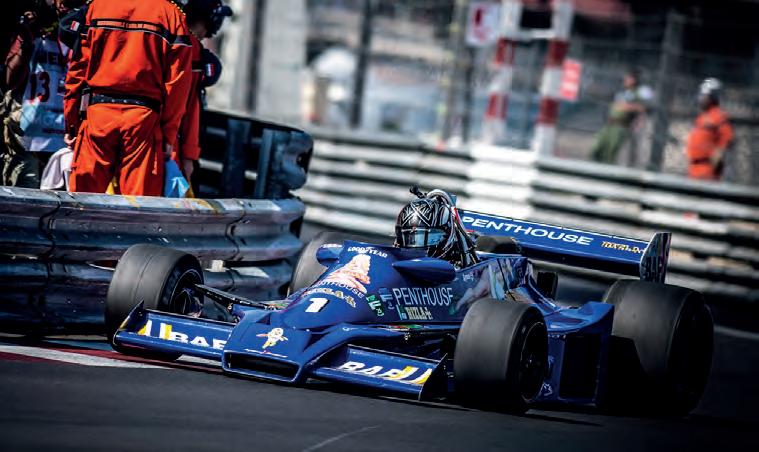
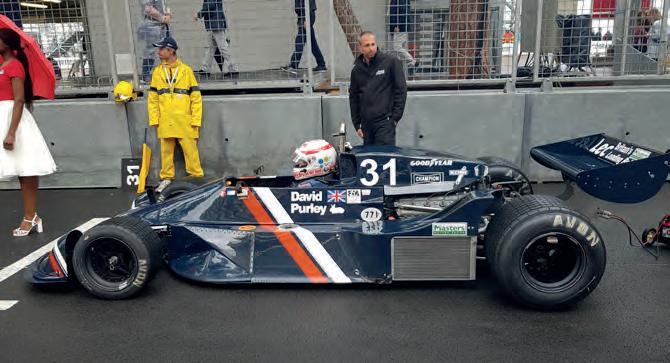
Ronald MAYDON
Cette LEC a été montée autour de la coque de réserve de l’équipe pour permettre à David Purley de reprendre la piste après une longue et pénible rééducation. A son volant, il a seulement disputé le championnat Aurora de F1 en 1979.
This Lec was built around the team’s reserve shell to allow David Purley to race again after a long and painful rehabilitation process. Behind its wheel, he only raced in the Aurora F1 Championship in 1979.
LEC F 118
23
Michael LYONS
24 31
LIGIER JS11
Ligier passe au Cosworth DFV en 1979 avec la JS11 développée en JS11/15 l’année suivante. Ligier en 1980 : N°25 Didier Pironi ; n°26 Jacques Laffite Production : 4 voitures produites en 1980.
Ligier moves to a Cosworth DFV in 1979 with the JS11 developed to the JS11/15 the next year. Ligier in 1980: N°25 Didier Pironi ; n°26 Jacques Laffite Production: 4 cars produced in 1980.

LOTUS 78
Mister “JOHN of B”
La voiture présentée a pris 5 départs aux mains de Laffite en 79 (Mulet à Monaco) dont trois arrivées consécutives à la 3e place. En 80, dans sa version 11/15, Pironi a pris 12 départs. A son volant il a gagné le Grand Prix de Belgique, connu l’abandon à Monaco après avoir réalisé la pole position et mené la moitié de la course, puis enregistré la 2e place au Grand Prix de France.
The car presented took 5 starts in the hands of Laffite in 79 (Mule at Monaco) including three consecutive 3rd place finishes. In 80, in its 11/15 version, Pironi took 12 starts. He won the Belgian Grand Prix, retired at Monaco after taking pole position and leading half the race, and finished 2nd in the French Grand Prix.
C’est au Grand Prix d’Argentine 1977 qu’apparaît la Lotus 78 « révolutionnaire » qui marque la naissance des autos à effet de sol. Avec cinq victoires obtenues par Mario Andretti et Gunnar Nilsson, le modèle et son concept établissent la preuve de l’efficacité d’une idée reprise ensuite par tous. Production : 5 voitures en 1977 pour Mario Andretti (n°5) et Gunnar Nilsson (n°6), puis Ronnie Peterson en 1978.
At the 1977 Argentinian Grand Prix, this “revolutionary” Lotus 78 made its first appearance, marking the official birth of a whole generation of ground effect cars. With five wins for Mario Andretti and Gunnar Nilson, this model proved the efficiency of the concept, which was then copied by all other teams. Production: 5 cars in 1977 for Mario Andretti (n°5) and Gunnar Nilsson (n°6), replaced by Ronnie Peterson in 1978

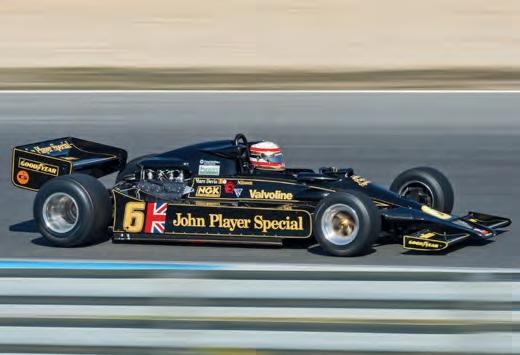
Cette Lotus 78 a pris cinq départs de Grand Prix avec Gunnar Nilsson (pour autant d’abandons) avant de passer entre les mains d’Hector Rebaque à partir du Grand Prix de Monaco 1978 (non-qualifié).
This Lotus 78 took five Grand Prix starts with Gunnar Nilsson (for as many retirements) before passing into the hands of Hector Rebaque from the 1978 Monaco Grand Prix (not qualified).


Pilotée en 1977 par Mario Andretti au Grand Prix d’Afrique du Sud, puis lors de neuf autres Grands Prix par Gunnar Nilsson (abandon à Monaco, victoire en Belgique 15 jours plus tard, 3e en Grande-Bretagne), elle est devenue la voiture régulière de Ronnie Peterson en 1978 (victoire en Afrique du Sud, abandon à Monaco, 2e en Belgique), en attendant qu’il dispose de sa 79.
Driven at the start of 1977 by Mario Andretti at the South African Grand Prix, it was then entrusted for nine other Grand Prix races to Gunnar Nilsson (retirement in Monaco, win in Belgium 15 days later, 3rd at the British Grand Prix). It became Ronnie Peterson's regular car in 1978 (win in South Africa, retirement in Monaco, 2nd in Belgium) while waiting for his Lotus 79.
119 14e GRAND PRIX DE MONACO HISTORIQUE 10-12 MAI 2024
25
Marc DEVIS
Lee MOWLE
5 6 2
LOTUS 81
La 81, sortie en 1980, est la dernière Lotus construite autour d’une coque en aluminium. Après l’échec de l’ambitieuse 80, prévue pour créer de l’effet de sol sur toute sa longueur et ainsi se passer, à terme, d’aileron, Colin Chapman est revenu à une wing-car classique, en reprenant les bases de la 79 victorieuse du Championnat du Monde 1978 aux mains de Mario Andretti. Les autres marques ayant adopté et maitrisé l’effet de sol, à leur tour, la 81 n’était qu’une F1 parmi d’autres et elle ne remporta pas de victoire.
Production : 3 ou 4 voitures construites en 1980, engagées d’abord pour Mario Andretti et Elio de Angelis, puis au début de la saison suivante pour de Angelis et Nigel Mansell.
The 81, launched in 1980, was the last Lotus built around an aluminum body. The failure of the ambitious 80, designed to create ground effect along its entire length, and thus eventually dispense with a wing, led Chapman to return to a classic wing car, picking up where he left off with Mario Andretti's 1978 World Championship-winning 79. However, since other teams had adopted and mastered the ground effect, the 81 was just another F1 car and encountered no success. Production: 3 or 4 cars built in 1980, entered for Mario Andretti and Elio de Angelis in 1980, then de Angelis and Nigel Mansell.
Luciano BIAMINO
Cette Lotus 81 a pris le départ de 11 Grands Prix du Championnat du Monde en 1980 et 1981 aux mains d’Elio de Angelis, Mario Andretti et Nigel Mansell. A Monaco, elle a terminé 7e en 1980 avec l’Américain au volant, mais elle n’était que voiture de réserve en 1981. De Angelis l’a amenée à la 4e place du Grand Prix des Etats Unis 1980, ce qui reste le meilleur résultat de cette voiture en F1.
This Lotus 81 took 11 starts in the World Championship in 1980 and 1981 in the hands of Elio de Angelis, Mario Andretti and Nigel Mansell. In Monaco, it finished 7th in 1980 with the American World Champion at the wheel, while it was only a reserve car in 1981. De Angelis took it to 4th place in the 1980 US Grand Prix, which remains this car's best result in F1.



 Steven BROOKS
Steven BROOKS
Cette Lotus 81 a disputé 11 Grands Prix du Championnat du Monde, pilotée en course par Mario Andretti, Elio de Angelis et Nigel Mansell. Elle a terminé deux fois sur le podium : l’Italien l’a amenée à la 2e place du Grand Prix du Brésil 1980 et l’Anglais à la 3e place du Grand Prix de Belgique 1981. Elle était voiture de réserve en 1980 à Monaco.
This Lotus 81 started in 11 World Championship races, with Mario Andretti, Elio de Angelis and Nigel Mansell at the wheel. It finished twice on the podium: the Italian driver brought it to a 2nd place at the 1980 Brazilian Grand Prix and the future British star to the 3rd place at the 1981 Belgian Grand Prix. In Monaco, in 1980, it was only a reserve car.
11 F 12 120


MARCH 761
Carlos de QUESADA
Cette McLaren M26 a débuté par une prometteuse 4e place au Grand Prix d’Argentine 1978 aux mains de James Hunt qui a été son unique pilote en Championnat du Monde. Les cinq Grands Prix suivant, dont celui de Monaco, se sont soldés par autant d’abandons.
This McLaren M26 started with a promising 4th place at the 1978 Argentinian Grand Prix in the hands of James Hunt, who was to be its only driver in the World Championship. Unfortunately, the five next races behind its wheel (including Monaco) ended with a retirement.
Production : 8 exemplaires (5 en 1976, 3 en 1977) engagés par March Enginering en 1976 pour Vittorio Brambilla (n°9), Lella Lombardi et Ronnie Peterson (n°10, victoire en Italie), Hans Stück (n°34) et Arturo Merzario (n°35, à titre privé).
Production: 8 cars (5 in 1976, 3 in 1977) entered in 1976 by March Enginering for Vittorio Brambilla (n°9), Lella Lombardi and Ronnie Peterson (n°10, win in Italy), Hans Stück (n°34) and Arturo Merzario (n°35, private entry).
Patrick d'AUBREBY
Cette March 761 a été terminée en 1977 pour le Finlandais Mikko Kozarowitsky, qui manqua sa qualification lors de ses deux apparitions en Championnat du Monde, tout comme Michael Bleekemolen qui a pris le relais en Hollande.
This March 761 was completed in 1977 for Finland’s Mikko Kozarowitsky, who failed to qualify on two Championship appearances, as did Michael Bleekemolen who took over in Holland.
MARCH 771
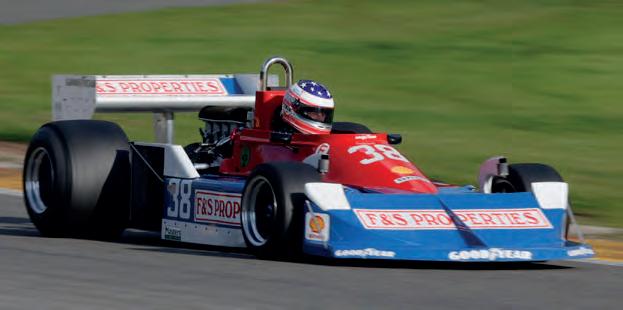
En 1977, March ne considérait plus la F1 comme un marché porteur et prioritaire. Le modèle 771, sorti tardivement, se différenciait par un radiateur d’eau frontal et un recentrage du carburant. A sa sortie, les pilotes de l’usine (Alex Ribeiro n°9 et Ian Scheckter n°10) n’ont pas considéré qu’elle représentait un progrès et ils ont préféré conserver leur 761B plutôt que se disperser à développer cette 771 mal-née. Production : 2 voitures en 1977 pour Alex Diaz-Ribeiro (n°9) et Ian Scheckter (n°10).
In 1977, March did not consider the F1 market as a priority any more. The 771 model, released late, had been made different from its predecessors by a front water radiator and a new central position for the fuel tank. When it came out, the factory drivers (Alex Ribeiro n°9 and Ian Scheckter in°10) did not consider that it represented a progress and preferred to stay with their 761B instead of trying to develop, in vain, the ill-born 771.
Production: 2 cars for Alex Diaz-Ribeiro (n°9) and Ian Scheckter (n°10).
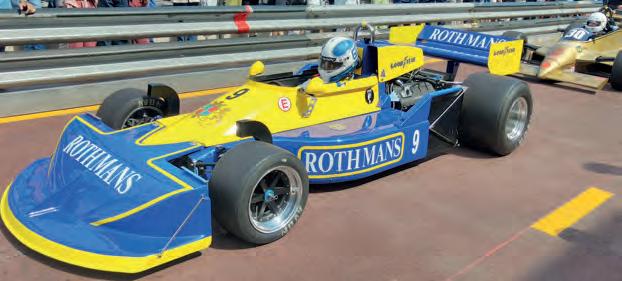
Nicolas MATILE
Cette March 771 a servi de mulet lors des Grands Prix de Belgique et du Japon.
This March 771 was a reserve car at the Belgian and Japanese Grand Prix.
121 14e GRAND PRIX DE MONACO HISTORIQUE 10-12 MAI 2024
McLAREN
33
7
9
SHADOW DN8
Shadow a fait ses débuts en F1 en 1973, marquant le retour des Etats-Unis en F1, cinq ans après le retrait d’Eagle, l’écurie de Dan Gurney, qui avait joué aux avant-postes de 1966 à 1968. Le premier exemplaire de la DN8 a participé, aux mains de Tom Pryce, aux cinq derniers Grands Prix de la saison 1976 avant de disputer l’intégralité de la saison 1977 et le début de la saison 1978. C’est le seul modèle de la marque à avoir remporté un Grand Prix du Championnat du Monde de F1. Production : 5 exemplaires (1 en 1976 et 4 en 1977).
Shadow made its debut in F1 in 1973, marking the comeback of the United States in F1, five years after the withdrawal of Dan Gurney’s Eagle team that played at the highest level from 1966 to 1968. The first DN8 took part in the last five races of 1976 in the hands of Tom Pryce, before being entered in the whole 1977 season and finishing its career at the beginning of the 1978 season. This is the only Shadow that won a F1 World Championship race. Production: 5 models (1 in 1976 and 4 in 1877).
Jamie CONSTABLE
Construite en 1977 et utilisée comme châssis de secours lors des premiers Grands Prix européens (dont Monaco), cette DN8 a participé à son premier Grand Prix en Autriche, permettant à Alan Jones, le futur champion du monde (chez Williams), de remporter là son premier Grand Prix de F1, seule victoire de l’écurie américaine en Championnat du Monde.
This DN8 was built in 1977 and used as a backup chassis during the first European races that year (including Monaco). It took part in its first ever Grand Prix in Austria, driven by Alan Jones, the future world champion (with Williams), who won there his first ever F1 Grand Prix. This remains the sole win achieved by the American team in the World Championship.

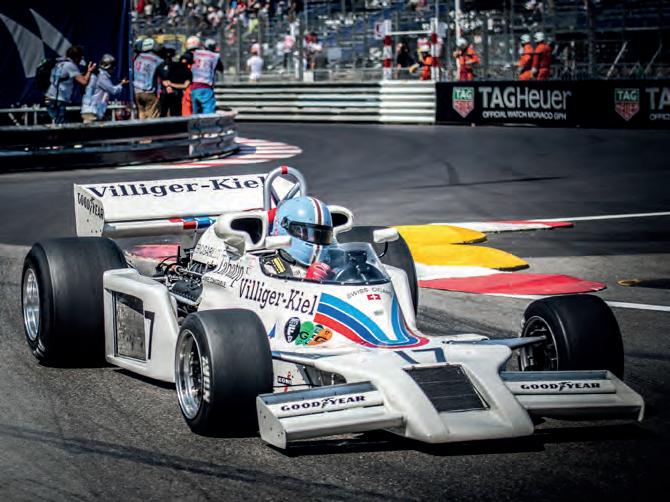
SHADOW DN9
La DN9, apparue en 1978, est la première Shadow à effet de sol. Du fait de la perte de vitesse de l’équipe américaine, elle a participé à deux saisons d’affilée. En 1978, Hans-Joachim Stück (n°16) et Clay Regazzoni (n°17) en étaient les titulaires, remplacés en 1979 par Jan Lammers (n°17) et de Elio de Angelis (n°18) qui débutait en F1.
Production: 5 exemplaires en 1978.
The DN9, which appeared in 1978, is the first Shadow with ground effect. Because of the team losing ground, it was used two seasons in a row. In 1978, HansJoachim Stück (n°16) and Clay Regazzoni (n°17) were the regular drivers, replaced in 1979 by Jan Lammers (n°17) and Elio de Angelis (n°18), then a F1 rookie. Production : 5 cars in 1978.


Ewen SERGISON
Cette DN9, arrivée neuve à Monaco en 1978, était la voiture habituelle de Clay Regazzoni. Sur les onze Grands Prix où il était inscrit à son volant, le Suisse a vécu pas moins de quatre non-qualifications, dont celle enregistrée à Monaco. En version B en 1979, elle était le plus souvent le mulet de l’équipe, partagé par les titulaires Elio de Angelis et Jan Lammers.
This DN9, delivered new for Monaco in 1978, was Clay Regazzoni’s regular car that year. Out of the eleven races where he was entered, the Swiss driver recorded no less than four non-qualifications, including a frustrating one in Monaco. In its B version for 1979, it was most often the mule of the team, shared by regular drivers Elio de Angelis and Jan Lammers.
16 1 F 122
17
TYRRELL 010
Suivant sa logique de 1979, Ken Tyrrell a copié la monoplace à effet de sol la plus efficace du moment. La 010 est donc une copie de la Williams FW07, comme la 009 était une copie de la Lotus 79. Production : 6 exemplaires en 1980 pour Jean-Pierre Jarier (n°3) et Derek Daly (n°4) en 1980, puis Eddie Cheever (n°3) et Kevin Cogan, Ricardo Zunino et Michele Alboreto (n°4) en 1981.
Following his logic in 1979, Ken Tyrrell decided to copy the most efficient ground effect car of the time. The 010 is then a copy of the Williams FW07, just as the 009 was a copy of the Lotus 79. Production: 6 cars in 1980 for Jean-Pierre Jarier (n°3) and Derek Daly (n°4) in 1980, then Eddie Cheever (n°3) and Kevin Cogan, Ricardo Zunino and Michele Alboreto (n°4) in 1981.

Michael CANTILLON
Cette Tyrrell 010 a été pilotée par Derek Daly en 1980, puis Eddie Cheever (4e en Grande-Bretagne) et Michele Alboreto (abandon à Monaco) en 1981, l’année de ses débuts en F1.
This Tyrrell 010 was used by Derek Daly in 1980, then Eddie Cheever (4th at the British Grand Prix) and Michele Alboreto (retirement in Monaco) in 1981, as a F1 rookie.
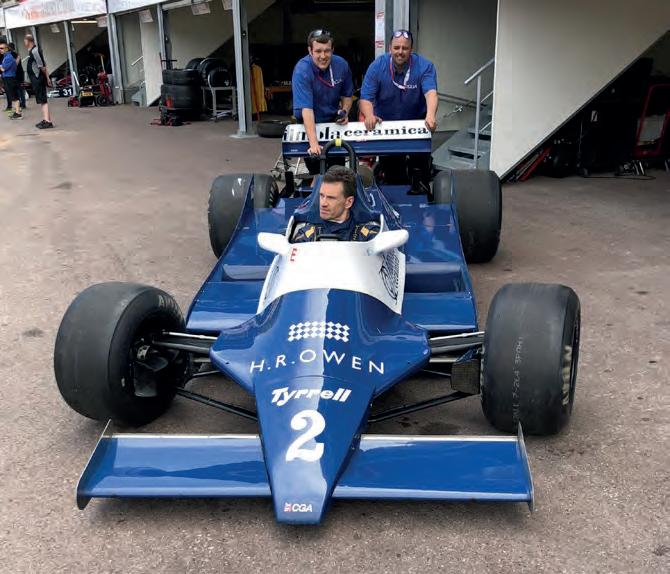


Frank MONTAGNY
Cette Tyrrell 010 pilotée en 1980 par Derek Daly et en fin de saison par Jean-Pierre Jarier a ensuite été pilotée en 1981 par Eddie Cheever puis Michele Alboreto. L’Américain a pris la 5e place à Monaco.
This Tyrrell 010, used in 1980 by Derek Daly and at the end of the season by Jean-Pierre Jarier, was driven in 1981 by Eddie Cheever and then Michele Alboreto. The American finished 5th in Monaco.
123 14e GRAND PRIX DE MONACO HISTORIQUE 10-12 MAI 2024
3 4
WILLIAMS FW06
Bien que ne suivant pas la voie ouverte en 1977 par la Lotus 78, la FW06, première Williams due à Patrick Head, a été une franche réussite, tout en montrant les limites de l’ancienne génération de monoplaces. Elle a été pratiquement la meilleure « non wing-car » de cette saison 1978 (abandon à Monaco mais 2e du Grand Prix des Etats-Unis aux mains d’Alan Jones). Elle a enfin mis Williams sur le chemin de la réussite, après quelques années difficiles, et a permis à l’écurie de Sir Frank de conquérir plusieurs titres mondiaux lors des saisons suivantes. Production : 4 voitures (2 en 1978, 2 en 1979) pour Alan Jones et Clay Regazzoni.
Although it did not follow the path opened up in 1977 by the Lotus 78, the FW06 was the first Williams designed by Patrick Head and brought some success to the team, while showing the limitations of the previous generation of single-seaters. It was practically the best non-wing car of that 1978 season (retirement in Monaco but 2nd in the US Grand Prix, in the hands of Alan Jones). This car put Williams on the road to success, after several years of hard work in F1, and several world crowns were to come in the next few years and decades. Production: 4 cars (2 in 1978, 2 in 1979 for Alan Jones and Clay Regazzoni.
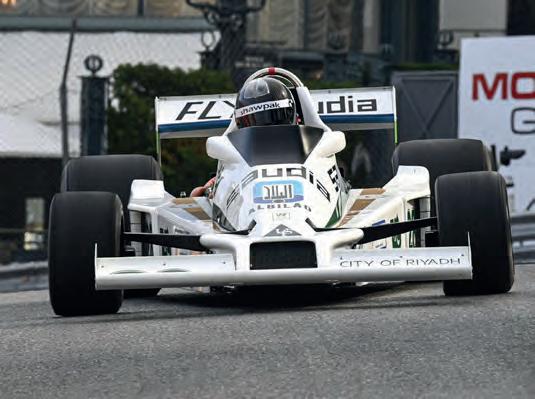
WILLIAMS FW07B
David SHAW
Cette FW06 a été la dernière construite. A son volant, Alan Jones n’a pris que deux départs au Brésil (abandon) et à Long Beach (3e). Aux essais de ce Grand Prix des USA, la FW07 à effet de sol fut présentée. Elle a pris le relais dès le Grand Prix suivant et a permis au pilote australien de remporter ses premiers Grands Prix, puis le titre de Champion du Monde en 1980.
This is the last FW06 built by Williams. At its wheel, Alan Jones took only two starts, in Brazil (retirement) and at Long Beach (3rd). During practice for this US Grand Prix, the FW07 with ground effect was revealed. It took over as soon as the next Grand Prix and then allowed the Australian driver to claim his first Grand Prix wins, followed by a world title in 1980.
La FW07 marque l’arrivée au plus haut niveau de Frank Williams, présent en F1 depuis 1969. Ce modèle est en effet celui de sa première victoire en Championnat du Monde (Grand Prix de Grande-Bretagne 1979, grâce à Clay Regazzoni), du sacre d’Alan Jones en 1980 (version B) et de la victoire à Monaco en 1981 (version C).
Production : 16 exemplaires en quatre déclinaisons de 1978 à 1981 (4 FW07 en 1979, 6 FW07B en 1980-81, 6 FW07C en 1981).
The FW07 marked the arrival of Frank Williams at the highest level, after ten rather painful years in F1, since 1969. This model brought Williams his first ever World Championship win (British Grand Prix 1979, thanks to Clay Regazzoni), a first world crown for Alan Jones in 1980 (version B) and a first Monaco win in 1981 (version C).
Production: 16 models in four different versions between 1978 and 1981 (4 FW07 in 1979, 6 FW07B in 1980-81, 6 FW07C in 1981).
Mark HAZELL
Sortie fin 1980, cette FW07 a débuté la saison suivante par une victoire en Afrique du Sud, pilotée par Carlos Reutemann. L’Argentin avait gagné à Monaco en 1980 sur une FW07.
Released at the end of 1980, this FW07 started its career with a win in South Africa, driven by Carlos Reutemann. The Argentinian had won in Monaco in 1980 with a car of the same type.
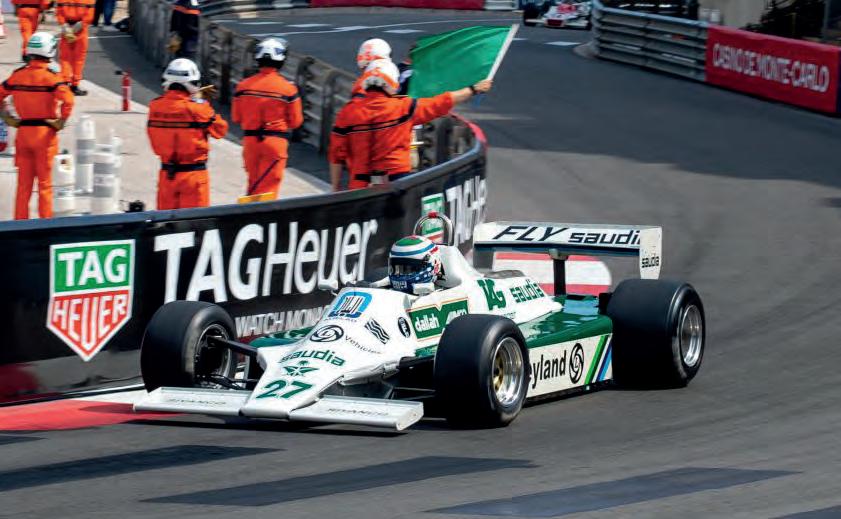
26
28 1 F 124

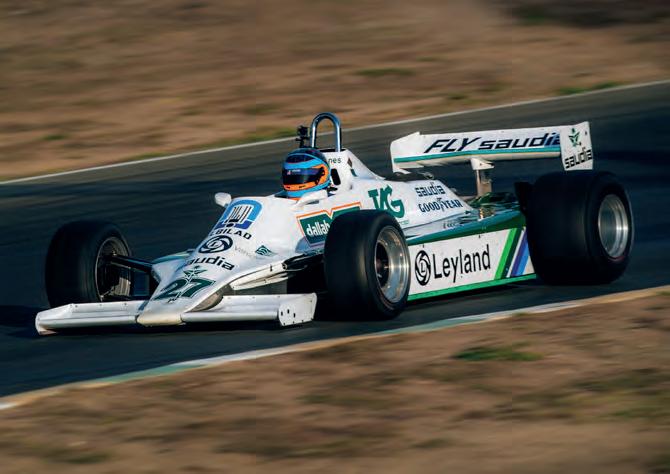
WOLF WR1
Zak BROWN
Produite en 1980, cette FW07 a un palmarès exceptionnel. Elle a en effet remporté trois des sept Grands Prix qu’elle a disputés avec Alan Jones au volant. L’Australien, sacré Champion du Monde en fin d’année, l’a aussi amenée à la 2e place du Grand Prix de Belgique. Son seul abandon a eu lieu à Monaco.
Produced in 1980, this FW07 has an exceptional track record. It won no fewer than three of the seven Grand Prix races in which it took part, in the hands of Alan Jones. The Australian driver, crowned World Champion at the end of the year, also took it to 2nd place in the Belgian Grand Prix. His only retirement came in Monaco.
La première Wolf de F1, dessinée par Harvey Postlethwaite, sans grande originalité, s’est avérée tout de suite très performante et très fiable. Propulsée par un Cosworth DFV accouplé à une boite Hewland FG400, elle a remporté trois Grands Prix dès sa première saison. Production : 5 voitures (4 en 1977, dont une voiture d’essai, 1 en 1978).
The first Wolf F1, designed by Harvey Postlethwaite without much originality, immediately proved to be very efficient and reliable. Powered by a Cosworth DFV mated to a Hewland FG400 gearbox, it won no less than three Grand Prix in its first season. Production: 5 cars (4 in 1977, including a test car, 1 in 1978).
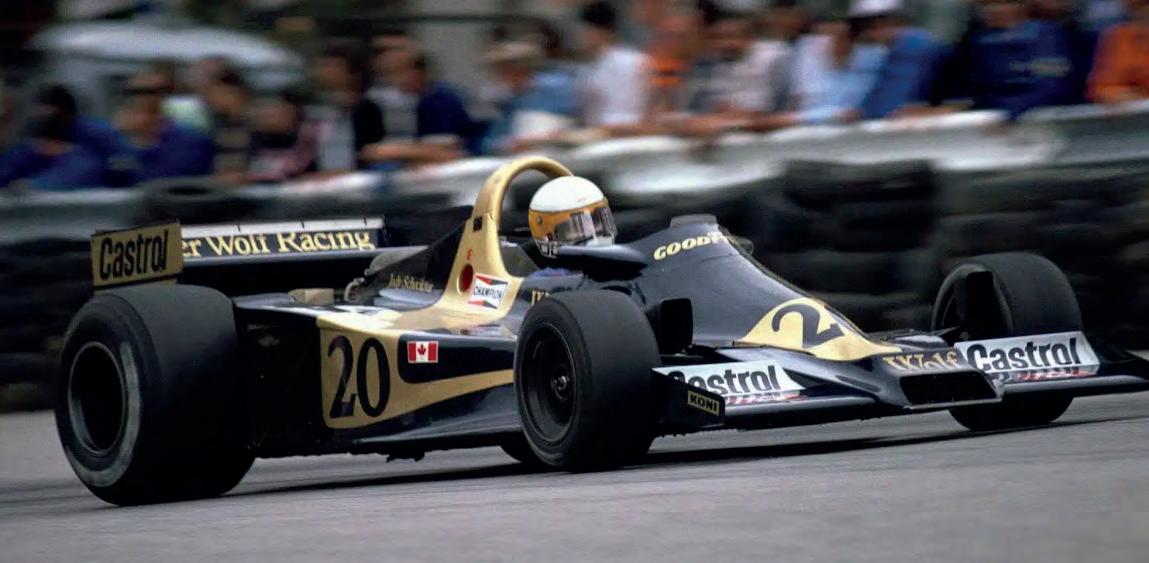
Wayne TAYLOR
Cette WR1 est la dernière produite, terminée juste à temps pour le début de la saison 1978. Elle a pris le départ du Grand Prix d’Argentine avec Jody Scheckter (10e), puis a été déplacée le plus souvent comme voiture de secours. L’arrivée d’une nouvelle voiture pour le Grand Prix de Monaco a abouti à sa vente à Teddy Yip, le propriétaire du Theodore Racing, qui a commencé à faire courir Keke Rosberg dans une Wolf du même type à partir du Grand Prix d’Allemagne.
This is the last WR1 built, completed just in time for the beginning of the 1978 season. It raced in the opening round, the Argentinian Grand Prix, with Jody Scheckter (10th) and was most often used later that year as a spare car. The arrival of a new car for the Monaco Grand Prix led to its sale to Teddy Yip, the owner of Theodore Racing, who started entering a Wolf same type for Keke Rosberg at the German Grand Prix.
125 14e GRAND PRIX DE MONACO HISTORIQUE 10-12 MAI 2024
27 20
3
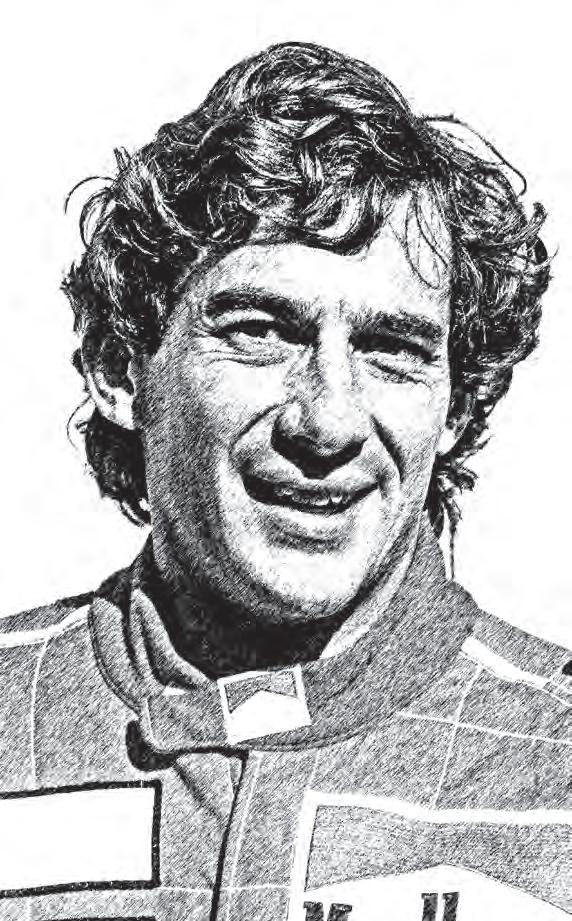
AYRTON SENNA G
F1 À MOTEUR 3L DE 1981 À 1985
F1 CARS WITH A 3-LITER ENGINE
FROM 1981 TO 1985
REGLEMENT (Extrait, Article 4) / RULE BOOK (Extract, Article 4)
Le 14e Grand Prix de Monaco Historique est ouvert aux voitures définies par l’annexe K du Code Sportif International de la F.I.A. / The 14th Grand Prix de Monaco Historique is open to cars defined by Appendix K of the FIA International Sporting Code.
Les voitures sont admises en 1 classe / The cars are admitted in 1 class:
Classe 1 : Voitures équipées d’un moteur atmosphérique / Cars equipped with an aspirated engine.
La Série G retrace au travers des monoplaces présentes la fin de l’ère du fameux moteur V8 3L débutée en 1967... Elle constitue une sorte d’hommage à ses 155 succès en Grand Prix. Le moteur turbo a fait son entrée en F1 au Grand Prix de Grande-Bretagne 1977 avec Renault.
En 1979, avec la victoire de Jean-Pierre Jabouille au Grand Prix de France, sur le circuit de Dijon-Prenois, la firme française a ouvert son palmarès qui s’est enrichi dès l’année suivante de trois autres victoires, en 1980. La révolution était en marche. Dès 1981, Ferrari a suivi l’exemple de Renault. Cette année-là, les victoires du moteur DFV étaient encore majoritaires mais en 1982 le déclin a commencé pour le DFV qui n’a remporté que la moitié des Grand Prix face aux moteurs turbo. En 1983, c’était la fin de la saga, avec trois victoires seulement : une pour la McLaren MP4 de John Watson à Long Beach, une autre pour la Williams FW08 de Keke Rosberg à Monaco, et la toute dernière pour la Tyrrell 011 de Michele Alboreto à Detroit. Cette saison 1983 a aussi été celle de l’ultime développement du moteur anglais, le DFY.
A partir de 1984, les moteurs turbo ont réussi un sans-faute, tout comme en 1985, année où la F2 a été remplacée par la F3000, créée à l’origine pour ouvrir un nouveau marché aux DFV complètement dépassés en F1. Cette période a aussi été marquée par le premier des quatre titres mondiaux d’Alain Prost, ses deux victoires d’affilée à Monaco (1984, 1985) et la révélation au grand public du talent d’Ayrton Senna.
Au volant de sa modeste Toleman, le jeune Brésilien a survolé le Grand Prix de Monaco 1984, arrêté par un drapeau rouge, alors qu’il remontait sur Prost, en raison d’une pluie torrentielle. Cet événement retentissant a tout juste 40 ans et le fait qu’il se soit produit dans les rues de la Principauté a incité l’ACM à rendre hommage aujourd’hui au grand pilote brésilien. C’est aussi, hélas, l’anniversaire de sa disparition tragique sur le circuit d’Imola, il y a 30 ans.
The G-Series retraces the end of the era of the famous 3L V8 engine, which began in 1967, through the single-seaters on show... It is a sort of tribute to its 155 Grand Prix successes. The turbo engine made its F1 debut at the 1977 British Grand Prix with Renault. In 1979, with JeanPierre Jabouille’s win at the French Grand Prix, the French firm opened its record book and added three more wins to its list of achievements in 1980. In 1981, Ferrari also adopted this approach. That year, DFV still took a majority of wins, but 1982 marked the start of the decline of the DFV, which only won half of the Grand Prix races that year, against the turbo engines. 1983 saw the end of the DFV, with just three wins altogether: one for John Watson’s McLaren MP4 at Long Beach, one for Keke Rosberg’s Williams FW08 at Monaco and, last but not least, one for Michele Alboreto’s Tyrrell 011 at Detroit. 1983 also saw the release of the DFY, its final development. From 1984 onwards, the turbo engines recorded a faultless performance, and in 1985 the F2 series was replaced by a F3000 Championship, originally created to open up a new market for the DFVs which had been rendered obsolete in F1. This period also marked the first of Alain Prost’s four world titles, as well as his first two wins in Monaco, and the revelation to the general public of Ayrton Senna’s talent. At the wheel of his modest Toleman, the young Brazilian dominated the Monaco Grand Prix in 1984 but finished 2nd, behind Prost, because the race was stopped by a red flag due to the dangerous conditions, under torrential rain. That momentous event is just 40 years old, and the fact that it happened on the streets of the Principality has prompted the ACM to celebrate the great Brazilian driver today. Sadly, this anniversary also coincides with his tragic death in Imola, 30 years ago.
SÉRIE RACE
126
LISTE DES ENGAGÉS I ENTRY LIST

14e GRAND PRIX DE MONACO HISTORIQUE 10-12 MAI 2024 N° PILOTE / DRIVER NAT CONCURRENT VOITURE / CAR MODÈLE ANNÉE CL. 1 D'ANSEMBOURG Christophe BEL D'ANSEMBOURG Christophe WILLIAMS FW07C 1981 1 2 D'ANSEMBOURG Werner BEL D'ANSEMBOURG Werner BRABHAM BT49D 1982 1 3 TYRRELL Ken USA TYRRELL Ken TYRRELL 011 1982 1 4 CONSTABLE Jamie GBR CONSTABLE Jamie TYRRELL 011 1983 1 5 STRETTON Martin GBR STRETTON Martin TYRRELL 012 1984 1 6 HALUSA Niklas AUT HALUSA Martin WILLIAMS FW08 1982 1 7 SIMMONDS Ian GBR SIMMONDS Ian TYRRELL 012 1983 1 8 HIGSON Mark GBR HIGSON Mark McLAREN MP4/1B 1982 1 9 FRANCHITTI Marino GBR WOLFE Andy TYRRELL 012 1985 1 10 PADMORE Nick GBR CHROMECARS RACING LOTUS 88B 1981 1 11 LYONS Michael GBR CHROMECARS RACING LOTUS92 1983 1 12 BROOKS Steven GBR BROOKS Steven LOTUS 91 1982 1 14 FORT Laurent FRA FORT Laurent ENSIGN MN180B 1980 1 15 WERNER Marco DEU CHROMECARS RACING LOTUS87B 1982 1 17 HARTLEY James Stephen GBR HARTLEY James Stephen ARROWS A6 1983 1 18 CHAHWAN Alejandro Walter ARG CHAHWAN Alejandro Walter MARCH 811 1981 1 19 HALL Stuart GBR GOETHE Roald MARCH 821 1982 1 22 HOPE Richard GBR HOPE Richard ALFA-ROMEO 182 1982 1 25 GIRARDO Massimilliano CHE GIRARDO Massimilliano MINARDI M185 1985 1 26 AYARI Soheil FRA AYARI Soheil LIGIER JS 21 1983 1 27TORIBA Yutaka JPN TORIBA Yutaka WILLIAMS FW07C 1981 1 28 CANTILLON Michael GBR CANTILLON Michael WILLIAMS FW07C 1982 1 29LEONE Valerio ITA LEONE Valerio ARROWS A6 1983 1 30 PINK Nicholas GBR PINK Nicholas ARROWS A5 1981 1 31 LOTTINI Piero ITA LOTTINI Piero OSELLA FA1B/81 1981 1 32 DWYER Mark GBR DWYER Mark OSELLA FA1D 1983 1 33 GREENSALL Nigel GBR GREENSALL Nigel THEODORE TY01 1981 1 34 HAZELL Mark GBR HAZELL Mark WILLIAMS FW08C 1983 1 35 VAN EERD Frits NLD VAN EERD Frits WILLIAMS FW08C 1983 1 1981 : Gilles Villeneuve / Ferrari 126C 1982 : Carlos Reutemann / Brabham BT49D 1983 : Keke Rosberg / Williams FW08C 1984 : Alain Prost / McLaren MP4/2 1985 : Alain Prost / McLaren MP4/2B 1 Voiture victorieuse d’un ou plusieurs Grand Prix du Championnat du Monde Voiture présente en période au Grand Prix de Monaco VAINQUEURS DU GRAND PRIX DE MONACO MONACO GRAND PRIX WINNERS
127
ALFA-ROMEO 182
Dernière Alfa-Romeo F1 à moteur atmosphérique, la 182 a été pilotée par Bruno Giacomelli et Andrea de Cesaris. Elle était construite autour d’une coque carbone produite en Angleterre, ce qui était une nouveauté à l’époque. Elle a été remplacée dès 1983 par la 183T dotée d’un moteurs turbo.
Production: 7 voitures
The 182 was the last Alfa-Romeo F1 powered by an atmospheric engine, driven by Bruno Giacomelli and Andrea de Cesaris. It was built around a carbon hull produced in England, which was a novelty at that time. It was replaced in 1983 by a 183T with a turbo engine.
Production: 7 cars

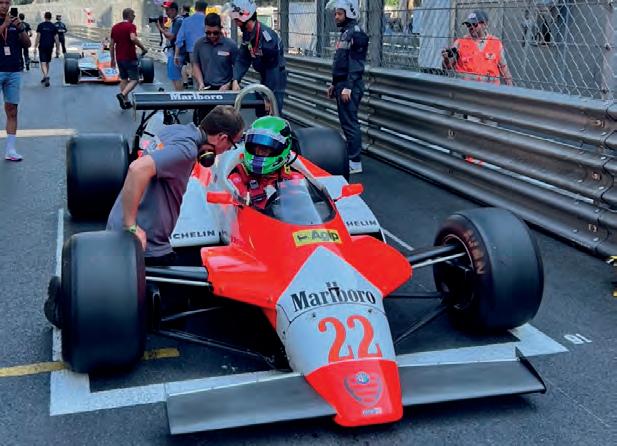
ARROWS A5
Richard HOPE
Cette Alfa Romeo 182 a participé à quatre Grands Prix en 1982 aux mains d’Andrea de Cesaris, avec comme résultats trois abandons mais aussi un podium (3e) à Monaco.
This Alfa Romeo took part in four Grand Prix in 1982 in the hands of Andrea de Cesaris, with a contrasted outcome: three retirements and one podium (3rd) in Monaco.
Très inspirée de la Williams FW08 qui allait devenir Championne du Monde en fin de saison 1982 avec Keke Rosberg, l’Arrows A5 a débuté à la fin de l’été, pilotée par Mauro Baldi et Marc Surer. Prévue au départ comme voiture de développement, elle a laissé sa place début 1983 à l’A6 qui reprenait sa coque.
Production : une seule voiture en 1982 (adaptée avec fond plat et devenue A6 début 1983).
Inspired by the Williams FW08 which was crowned World Champion at the end of the 1982 season with Keke Rosberg, the Arrows A5 started its career at the end of summer, driven by Mauro Baldi and Marc Surer. Initially planned as a development car, it left its place at the beginning of 1983 to the A6 built around its hull. Production: only one car in 1982 (adapted with a flat bottom to become the A6 at the beginning of 1983).
Nicholas PINK
Marc Surer a débuté en F1 au volant de cette A5 au Grand Prix de Suisse (15e), puis Mauro Baldi a pris la 12e place en Italie et Surer la 7e au Grand Prix des Etats-Unis, fin 1982. En 1983, devenue A6 en adoptant le fond plat réglementaire, elle était disponible comme mulet en début de saison, notamment à Monaco. Elle a encore été pilotée en course par Chico Serra au Grand Prix de France (abandon) et par Surer au Grand Prix de Belgique (10e).
Marc Surer made his F1 debut at the Swiss Grand Prix with this A5 and finished 15th. Then Mauro Baldi took 12th place in Italy and Surer finished 7th at the U.S. Grand Prix at the end of 1982. In 1983, it became an A6 after adopting a compulsory flat-bottom and was used as a mule at the start of the season, notably in Monaco. It was driven again later, by Chico Serra at the French Grand Prix (retirement) and by Surer in Belgium (10th).

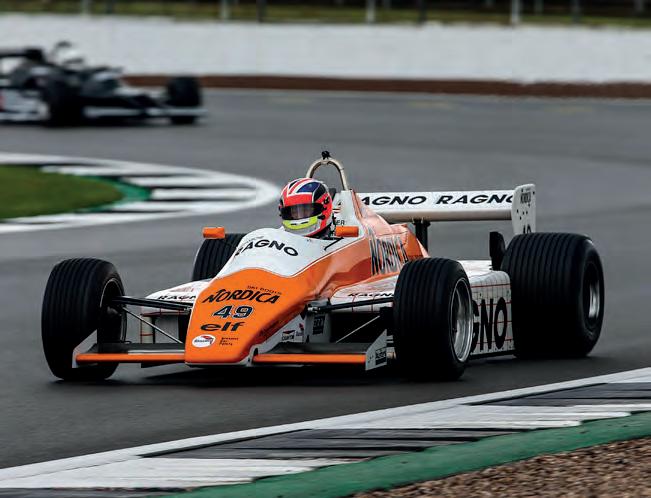
G 128
30
22
ARROWS A6
Très inspirée de la Williams FW 08 qui allait devenir Championne du Monde en fin de saison 1982 avec Keke Rosberg, l’Arrows A5 a débuté à la fin de l’été, pilotée par Mauro Baldi et Marc Surer. Prévue au départ comme voiture de développement, elle a laissé sa place début 1983 à l’A6 qui reprenait sa coque. Production : une seule voiture en 1982 (adaptée avec fond plat et devenue A6 début 1983).
Inspired by the Williams FW 08 which was crowned World Champion at the end of the 1982 season with Keke Rosberg, the Arrows A5 started its career at the end of summer, driven by Mauro Baldi and Marc Surer. Initially planned as a development car, it left its place at the beginning of 1983 to the A6 built around its hull. Production: only one car in 1982 (adapted with a flat bottom to become the A6 at the beginning of 1983).
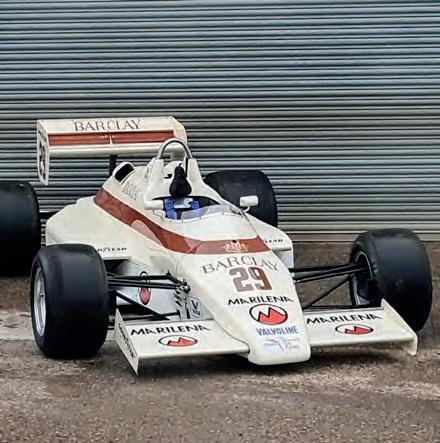
Valerio LEONE
Cette A6 a pris six départs en 1983, pilotée par Marc Surer qui a marqué des points une fois sur deux avec cette voiture mais a été contraint d’abandonner à Monaco.
This A6 took six starts in 1983, driven by Marc Surer who scored points in three of these races but was forced to retire in Monaco.
BRABHAM BT49
James Stephen HARTLEY
Arrivée neuve au Grand Prix de Belgique 1983 (15 jours après Monaco), cette A6 est devenue la voiture habituelle de Marc Surer, lors de huit Grands Prix, avec comme meilleur résultat une 7e place en Autriche. En 1984, en attendant l’A7 à moteur BMW turbo, elle a encore été utilisée jusqu’en juin, prenant trois départs avec Surer, à chaque fois hors des points, et deux départs avec Thierry Boutsen, au Grand Prix de Saint Marin (5e) et à celui de Belgique (abandon). A partir de 1985, elle a poursuivi sa carrière en F3000 aux mains de Slim Borgudd, le deuxième batteur du groupe pop Abba.
Delivered new at the 1983 Belgian Grand Prix (15 days after Monaco), this A6 became Marc Surer’s regular car, the Swiss driver taking eight starts with it, and claiming a 7th place in Austria. In 1984, while waiting for the BMW turbo-powered A7, it continued to be used until June, taking three starts with Marc Surer, who finished out of the points every time, and two starts with Thierry Boutsen, in San Marino (5th) and at the Belgian Grand Prix (retirement). From 1985 onwards, it continued its career in F3000, in the hands of Slim Borgudd, the second drummer of famous pop group Abba.

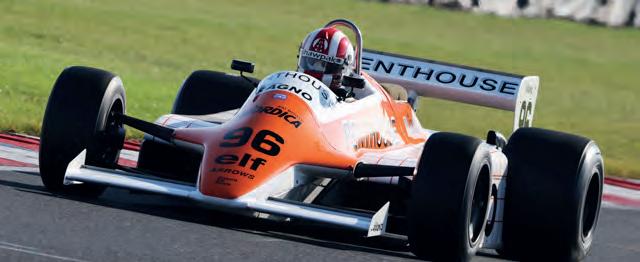
Werner d’ANSEMBOURG
Après quatre saisons décevantes avec le moteur V12 Alfa Romeo, l’écurie Brabham est revenue au bon vieux moteur V8 Cosworth en utilisant la nouvelle BT49 lors des deux derniers Grand Prix de 1979. Sous différentes déclinaisons, cette monoplace va remporter pas moins de sept Grands Prix (dont celui de Monaco en 1982 avec Riccardo Patrese sur une BT49D) et permettre à Nelson Piquet d’être sacré Champion du Monde en 1981 (BT49C). Production : 17 voitures en 4 déclinaisons. Pilotes Brabham en 1979 et 1980 : Nelson Piquet (n°5), Riccardo Zunino puis Hector Rebaque (n°6).
After four disappointing seasons with the V12 Alfa Romeo engine, Brabham returned to the good old V8 Cosworth engine, using the new BT49 at the last two races of 1979. In its various versions, this car won no less than seven F1 races (including Monaco in 1982 with Riccardo Patrese in a BT49D) and enabled Nelson Piquet to be crowned World Champion in 1981 (BT49C). Production : 17 cars in 4 versions. Brabham drivers in 1979 and 1980: Nelson Piquet (n°5), Riccardo Zunino and Hector Rebaque (n°6).
Cette BT49D, la toute dernière du type, a été engagée au Grand Prix du Canada 1982 pour Riccardo Patrese, vainqueur à Monaco la même année avec une monoplace similaire.
This BT49D, the very last of its type, was entered at the 1982 Canadian Grand Prix for Riccardo Patrese, who had won in Monaco the same year with a similar car.
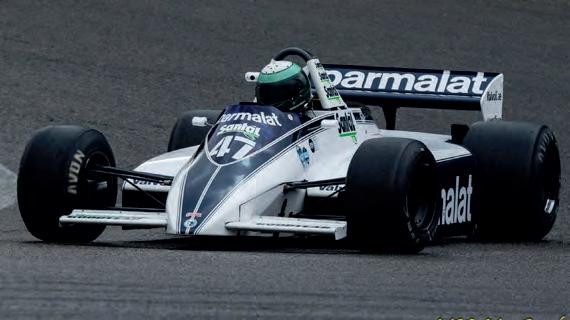
129 14e GRAND PRIX DE MONACO HISTORIQUE 10-12 MAI 2024
2
17 29
ENSIGN N180B
La N180 a été la première Ensign respectant les meilleurs standards imposés par le courant des « wing cars » (voitures à effet de sol). Avec l’arrivée de Clay Regazzoni en provenance de Williams, et d’un sponsor généreux, Mo Nunn envisageait avec optimisme l’année 1980. Hélas, à Long Beach, la sortie de route dramatique du pilote suisse, et ses conséquences, ont durablement ébranlé la petite équipe. Production : 4 voitures (3 en 1980, 1 en 1981)
The N180 was the first Ensign to truly meet the highest standards imposed by the wing car movement. With the arrival of Clay Regazzoni from Williams and a generous sponsor, Mo Nunn was looking forward to 1980. Alas, in Long Beach, the Swiss driver's dramatic accident, and its consequences, shook the team for a long time. Production: 4 cars (3 in 1980, 1 in 1981)

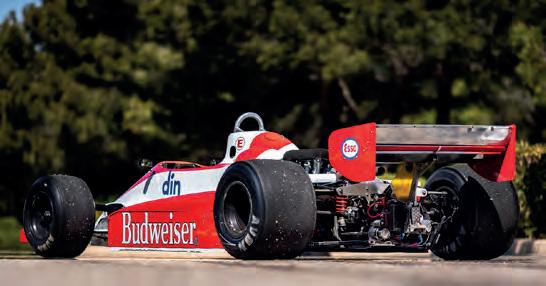
LIGIER JS21
L’arrêt du programme Matra en F1 a obligé Ligier à revenir pour la saison 1983 au moteur V8 DFV qu’elle utilisait avec succès en 1979 et 1980 sur les JS11 et JS11/15. La JS21, produite avec les coques des JS19 retouchées et une suspension hydraulique développée en collaboration avec Citroën, présentait des solutions aérodynamiques originales.
Production : 4 voitures en 1983. Pilotes Ligier en 1983 : JeanPierre Jarier (n°25) et Raul Boesel (n°26)
The end of the Matra F1 program forced Ligier to return, for the 1983 season, to the V8 DFV engine which it used with success in 1979 and 1980 on the JS11 and JS11/15. The JS21, built around modified JS19 hulls and a hydraulic suspension developed in collaboration with Citroën, adopted original aerodynamic solutions.
Production: 4 cars in 1983. Ligier drivers in 1983 : Jean-Pierre Jarier (n°25) and Raul Boesel (n°26)


Cette JS21 a été régulièrement pilotée par Raul Boesel en 1983. Le Brésilien a pris douze départs en Championnat du Monde, il a abandonné à Monaco mais terminé 7e à Long Beach.
This JS21 was the regular car for Raoul Boesel in 1983. The Brazilian driver took twelve World Championship starts, he had to retire in Monaco but finished 7th in Long Beach.
Laurent FORT
Cette N180 a été produite en 1981. Elle a pris le départ de toutes les courses (16) inscrites au calendrier du Championnat du Monde. Marc Surer, 4e au Brésil et 6e à Monaco, a ensuite cédé sa place à Eliseo Salazar, 6e en Hollande.
This N180 was built in 1981. It took the start of all 16 races registered on the calendar of the World Championship. Marc Surer, 4th in Brazil and 6th in Monaco, then passed his seat to Eliseo Salazar, 6th in Holland.
14 26 15
LOTUS 87
La Lotus 87 n’est autre que la réponse trouvée dans l’urgence par Colin Chapman afin de continuer la saison 1981 après le rejet par les autorités de la type 88 à double châssis. Cette mise en conformité des Lotus 87, en partant de l’existant, a consisté à adapter une carrosserie classique sur les coques des 88 jugées illégales.
Production : 5 voitures en 1981 pour Elio de Angelis (n°11) et Nigel Mansell (n°12)
The Lotus 87 was Colin Chapman's emergency answer to continue the 1981 season after the rejection by the authorities of the double-chassis 88 type. Starting with what already existed, the Lotus F1 cars were brought into conformity by adapting a classic body on the hulls of the 88s, which were deemed illegal.
Production: 5 cars built in 1981 for Elio de Angelis (n°11) and Nigel Mansell (n°12)

Marco WERNER
Cette Lotus 87 a pris le départ de quatre Grands Prix aux mains de Nigel Mansell, qui se sont soldés par autant d’abandons.
This Lotus 87 started four Grand Prix races with Nigel Mansell at the wheel, all of them ending with a retirement.
G 1 30
Soheil AYARI
LOTUS 88B
LA REVOLUTION AVORTEE
L’effet de sol augmentant sans cesse, cela a provoqué un durcissement considérable des suspensions qui, à leur tour, amenaient les pilotes aux limites de leur résistance. Pour remédier au phénomène, Colin Chapman pensa à dissocier la cellule principale -comprenant moteur, boîte de vitesses et cellule du pilote- de celle assurant l’aérodynamique et donc l’effet de sol. Cette sorte de double châssis étant jugé illégal, la voiture n’a pas été autorisée à prendre un départ, y compris sous sa version remaniée 88B présentée dans le cadre du Grand Prix de Grande-Bretagne. Production : 3 voitures en 1981 pour Elio de Angelis (n°11) et Nigel Mansell (n°12).
THE ABORTED REVOLUTION
The ever-increasing ground effect led to a considerable hardening of the suspensions, which in turn brought the pilots to the limits of their resistance. To remedy this situation, Colin Chapman thought of separating the main cell, comprising engine, gearbox and driver's cell, from the cell responsible for the aerodynamics and therefore the ground effect. This kind of double chassis, deemed illegal, prevented the car from starting a race, even in its reworked 88B version presented at the British Grand Prix. Production: 3 cars built in 1981 for Elio de Angelis (n°11) and Nigel Mansell (n°12)

LOTUS 91
Nick PADMORE
Cette 88B se présente dans sa configuration des essais du Grand Prix de GrandeBretagne, lors de sa seule apparition dans le cadre du Championnat du Monde.
This 88B appears in its configuration for practice at the British Grand Prix, which was its only appearance in the World Championship.
La Lotus 91 n’est qu’un développement de la 87B dont elle reprend la coque. C’est la dernière Lotus à moteur DFV victorieuse en Grand Prix et aussi la dernière Lotus de Colin Chapman.
Production : 5 exemplaires utilisés par Elio de Angelis (n°11) et Nigel Mansell (n°12), avec aussi une « pige » d’une course pour Geoff Lees et Roberto Moreno en remplacement de Mansell.
The Lotus 91 was a further development of the 87B, from which it took the hull. It was the last DFV-powered Lotus to win a Grand Prix, as well as Colin Chapman's last Lotus.
Production: 5 cars used by Elio de Angelis (n°11) and Nigel Mansell (n°12), with a one-race "freelance" appearance for Geoff Lees and Roberto Moreno to replace Mansell.
Steven BROOKS
Cette Lotus 91 a débuté fin 1982 aux mains de Nigel Mansell, en version 91, avant de devenir une 92 par l’adaptation d’un fond plat pour le début de la saison 1983. Sous cette forme, elle est restée en activité jusqu’au Grand Prix de Detroit en juin (6e). A Monaco, Mansell a été pris dans un accident au départ et a dû abandonner.
This Lotus 91 started its career at the end of 1982 in Nigel Mansell’s hands, as a 91 version, before becoming a 92 by adapting a flat-bottom for the opening of the 1983 season. In this form, it remained in operation until the Detroit Grand Prix in June, where it finished in 6th place. At Monaco, Mansell was caught in an accident at the start and was forced to retire.


1 31 14e GRAND PRIX DE MONACO HISTORIQUE 10-12 MAI 2024
12 10 FORFAIT
LOTUS 92
Pour la saison 1983, Lotus avait déjà tourné la page du DFV et créé la 93T à moteur Renault 1500 turbo, mais il n’en existait pas suffisamment en début de saison pour assurer dans de bonnes conditions la participation des deux pilotes. Deux Lotus 92, voitures intérimaires entre la 91 et la nouvelle 93 turbo, ont alors été créées en adaptant deux Lotus 91 de 1982 au nouveau règlement imposant un fond plat. Production : 2 exemplaires pour Nigel Mansell (n°12)
For the 1983 season, Lotus had already turned the page on the DFV and created the 93T with a 1500 Renault turbo engine, but there were not enough cars available at the start of the season to ensure the participation of both drivers in good conditions. So that a couple of Lotus 92, an interim car between the 91 and the new 93 turbo, were created by adapting a couple of 1982 Lotus 91 to the new flat-bottom regulations. Production: 2 cars for Nigel Mansell (n°12)


MARCH 811
Michael LYONS
C’est l’une des deux Lotus 91 adaptées pour devenir des Lotus 92. Elle a souvent été déplacée comme mulet pour Nigel Mansell (notamment au Grand Prix de Monaco 1983), désigné pour piloter les 92 en attendant de disposer d’une 93 turbo comme Elio de Angelis.
This is one of two Lotus 91s adapted to become a Lotus 92. This car was regularly used as a mule for Nigel Mansell (notably at Monaco Grand Prix 1983), since he was designated to drive the 92 until he could drive a 93 turbo, just like his team-mate Elio de Angelis.
La March 811 n’est pas une réalisation décidée par l’usine mais un projet mené à l’extérieur par une société satellite dirigée par Robin Herd, l’un des fondateurs de March, à la demande de John Mac Donald. Celui-ci a simplement commandé une copie de la Williams FW07 que son écurie Ram utilisait en 1980. Réalisée avec une économie de moyens, la 811 manquait de rigidité et donc de performance. Derek Daly et Eliseo Salazar, ses pilotes, avaient bien peu de chances de briller. Production : 6 voitures pour la saison 1981.
The March 811 was not a factory-designed project, but an external one carried out by a satellite company headed by Robin Herd, one of the founders of March, at the request of John Mac Donald. The latter simply ordered a copy of the Williams FW07 used by his Ram team in 1980. Built with an economy of means, the 811 lacked rigidity and therefore performance. Derek Daly and Eliseo Salazar, its drivers, were unlikely to shine. Production: 6 cars for the 1981 season.
Alejandro Walter CHAHWAN
Aux mains de Derek Daly, cette March 811 a manqué sa qualification lors de ses débuts aux Grands Prix de Belgique et de Monaco. Elle a ensuite servi de mulet sur neuf autres courses.
In the hands of Derek Daly, this March 811 failed to qualify when making its debut at the Belgian and Monaco Grand Prix. It then served as a mule at nine other F1 races.


G 1 32
11 18
MARCH 821
La March 821 conçue par Adrian Reynard a gardé le nom de March mais n’avait plus rien à voir avec l’entité d’origine. Toujours calquée sur la Williams FW07 sortie trois ans plus tôt, mais sans innovation, elle a été dépassée d’emblée et des problèmes récurrents avec ses fournisseurs de pneus ont accentué son manque de compétitivité. La non-qualification des deux voitures au Grand Prix de Monaco a précipité l’éclipse de March en F1, en décourageant les commanditaires de poursuivre l’aventure.
The March 821 designed by Adrian Reynard kept the March name, but in fact had nothing to do with the original entity. Still modelled on the Williams FW07 released three years earlier, and without any innovative feature, it proved to be outdated from the outset, and recurring problems with its tire suppliers accentuated its lack of competitiveness. The failure of both cars to qualify for the Monaco Grand Prix precipitated March's eclipse in F1, discouraging sponsors from continuing the adventure.

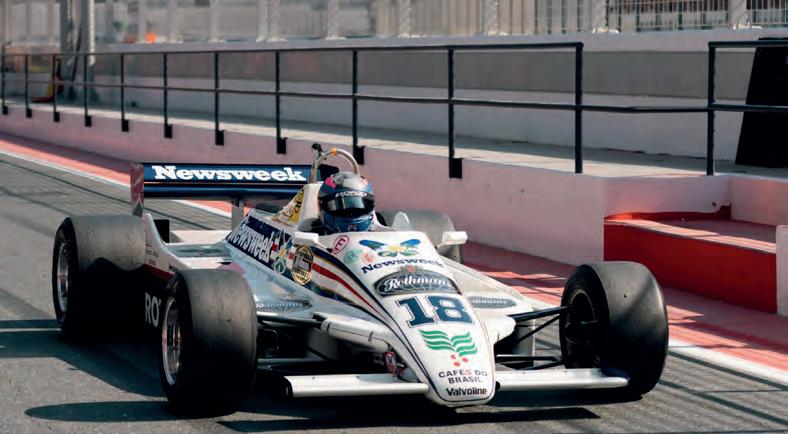
McLAREN MP4-1B
Stuart HALL
Raul Boesel (non-qualifié à Monaco) a été le pilote titulaire de cette March 821 jusqu’à son accident au départ du Grand Prix du Canada, qui a coûté la vie à Riccardo Paletti.
Raul Boesel (not qualified in Monaco) was the regular driver of this March 821 until his accident at the start of the Canadian Grand Prix, which claimed the life of Riccardo Paletti.
La MP4 conçue par l’ingénieur John Barnard a été la première F1 à coque carbone, un concept adopté ensuite par tous les constructeurs. Son appellation MP4 correspondait à Marlboro Project Four (4) Racing, soit le sponsor principal et le nom de l’écurie créée par Ron Dennis en prenant le contrôle de McLaren.
The MP4, designed by engineer John Barnard wa the first F1 with a carbon hull, a concept which was then adopted by all manufacturers. Its name, MP4, stood for Marlboro Project Four (4) Racing, the sponsor and the name of the team created by Ron Dennis when he took control of McLaren.

Cette MP4 a été pilotée par Niki Lauda lors de sept Grands Prix de 1982. A son volant, l’Autrichien a remporté le Grand Prix de Grande-Bretagne, il a aussi pris la 4e place en Hollande et la 5e en Autriche, mais il a abandonné à Monaco. Cette voiture a ensuite disputé quatre Grands Prix début 1983 avec John Watson qui a remporté, à son volant, le Grand Prix des Etats-Unis à Long Beach, soit l’avant-dernier succès du moteur DFV en Championnat du Monde.
This MP4 was driven by Niki Lauda at seven Grand Prix races in 1982. The Austrian driver won the British Grand Prix, took 4th place in Holland and 5th in Austria, but he was forced to retire in Monaco. This car then competed in four other Grand Prix races at the start of 1983, with John Walson at the wheel, winning the U.S. Grand Prix at Long Beach, which was the penultimate World Championship win for a DFV engine.

1 33 14e GRAND PRIX DE MONACO HISTORIQUE 10-12 MAI 2024
Mark HIGSON
8 19 2
MINARDI M185
Présentée en cours de saison 1984, la M185 due à l’ingénieur Caliri (un temps chez Ferrari) devait être dotée d’un tout nouveau moteur turbo Motori Moderni conçu par l’équipe de Carlo Chiti (lui aussi un temps responsable chez Ferrari, puis Alfa). Le retard dans la fabrication de ce nouveau moteur amena l’équipe à débuter la saison avec un Cosworth DFY.
Production : 4 châssis en 1985.
Introduced in the middle of the 1984 season, the M185 designed by engineer Caliri (formerly with Ferrari) was to be equipped with a new Motori Moderni turbo engine designed by Carlo Chiti's team (also formerly in charge of engines for Ferrari and then Alfa). The delay in manufacturing the new engine led the team to start the season with a Cosworth DFY. Production: 4 chassis in 1985.
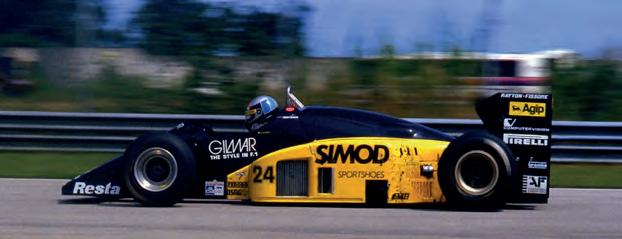
OSELLA FA1B
Massimilliano GIRARDO
Cette Minardi M185 a servi de voiture de réserve lors de huit Grands Prix de la saison 1985 disputés par le seul Pierluigi Martini.
This Minardi was used as a back-up car at eight Grand Prix races in 1985, contested only by Pierluigi Martini.
Le deuxième modèle de F1 produit par Osella est apparu fin 1980 lors du Grand Prix d’Italie où Eddie Cheever a terminé 12e. Pour 1981, trois châssis de plus ont été produits. La petite firme italienne a engagé régulièrement deux voitures, très souvent non-qualifiées.
Production : 4 châssis (1 en 1980, 3 en 1981)
The second F1 produced by Osella appeared at the end of 1980 at the Italian Grand Prix, where Eddie Cheever finished 12th. For 1981, three more chassis were produced. The small Italian firm regularly entered two cars, which often failed to qualify. Production: 4 chassis (1 in 1980, 3 in 1981).
Piero LOTTINI
Jean Pierre Jarier, Beppe Gabbiani et Piercarlo Ghinzani (non-qualifié à Monaco) se sont partagé le volant de cette Osella en 1981. Le Français est le seul à avoir réussi à rejoindre l’arrivée une fois (8e au Grand Prix de Grande-Bretagne).
Jean Pierre Jarier, Beppe Gabbiani and Piercarlo Ghinzani (not qualified for Monaco) shared the wheel of this car in 1981. The Frenchman was the only driver to reach the finish once (8th at the British Grand Prix).
OSELLA FA1D
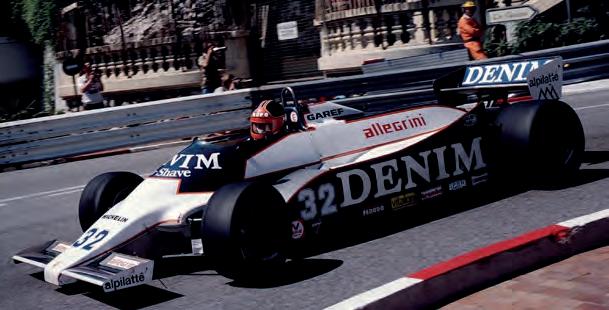
La FA1D, évolution de la FA1C, est une adaptation au fond plat devenu obligatoire, en attendant que le nouveau modèle à moteur Alfa soit opérationnel à partir du Grand Prix de Saint Marin disputé 15 jours avant celui de Monaco. Production : 2 châssis en 1983.
The FA1D, an evolution of the FA1C, is a flat-bottomed adaptation that became compulsory, until the new Alfa-powered model was operational from the San Marino Grand Prix, held 15 days before Monaco Grand Prix. Production: 2 chassis in 1983.
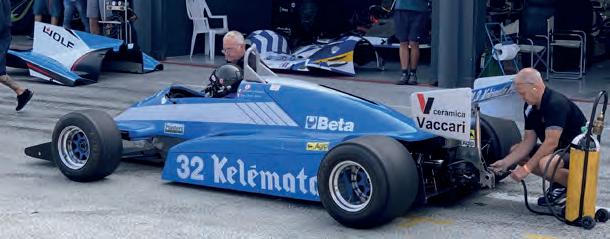
Mark DWYER
Cette Osella FA1D a été pilotée sans résultat par Corrado Fabi au début de la saison 1983.
This Osella FA1D was used without any result by Corrado Fabi at the start of 1983.
G 1 34
25 31 32
THEODORE TY01
Après l’échec de la Theodore TR1 de 1978, la petite écurie de Teddy Yip avait disparu de la F1 au meilleur niveau. En 1981, la marque est revenue avec cette TY01 à effet de sol, dessinée par Tony Southgate et utilisée durant toute la saison 1981, ainsi qu’au début de 1982.
Production : 3 voitures pour la saison 1981.
After the failure of the 1978 Theodore TR1, Theodore had disappeared from F1 at the highest level. In 1981, the brand returned with this ground-effect TY01, designed by Tony Southgate and used throughout the 1981 season, as well as in early 1982. Production: 3 cars for the 1981 season.

TYRRELL 011
Nigel GREENSALL
Patrick Tambay (7e à Monaco), intégré ensuite chez Ligier à partir du Grand Prix de France, ainsi que Marc Surer et Derek Daly se sont succédé au volant de cette monoplace en 1981.
Patrick Tambay (7th in Monaco), until he joined Ligier at the French Grand Prix, as well as Marc Surer and Derek Daly, all of them drove this TY01 in 1981.
La Tyrrell 011 a pris le relais de la 010 en août 1981, Eddie Cheever et Michele Alboreto n’obtenant pas de résultat significatif. Et la 011 a obtenu, à Las Vegas et à Detroit, deux des quatre dernières victoires du moteur V8 Cosworth en Championnat du Monde.
Production : 6 voitures construites en 1981 et 1982, engagées par Team Tyrrell pour Eddie Cheever (n°3) et Michele Alboreto (n°4) en 1981, puis Alboreto (n°3), Slim Borgudd et Brian Henton (n°4) en 1982, puis Alboreto (n°3) et Danny Sullivan (n°4) en 1983.
The 011 took over from the 010 in August 1981, since Eddie Cheever and Michele Alboreto could not obtain any significant result. This car recorded two of the last four wins for a V8 Cosworth in the World Championship. Production: 6 cars built in 1981 and 1982, entered for Eddie Cheever (n°3) and Michele Alboreto (n°4) in 1981, then Alboreto (n°3), Slim Borgudd and Brian Henton (n°4) in 1982, then Alboreto (n°3) and Danny Sullivan (n°4) in 1983.
Ken TYRRELL
Cette 011 a été pilotée par Michele Alboreto en fin de saison 1981, marquée par sa 4e place en Italie et surtout sa victoire sur le parking du Caesar’s Palace à Las Vegas. C’était l’une des quatre dernières victoires du moteur DFV en Championnat du Monde. Elle est la propriété d’un homonyme du constructeur anglais, qui lui a directement acheté la voiture.
This is the 011 driven by Michele Alboreto at the end of the 1981 season, marked by his 4th place in Italy and especially his win on the parking lot of the Caesar’s Palace in Las Vegas. This was one of the last four wins for a DFV engine in the World Championship. This 011 is the property of a homonym of the English manufacturer who bought the car directly from him.

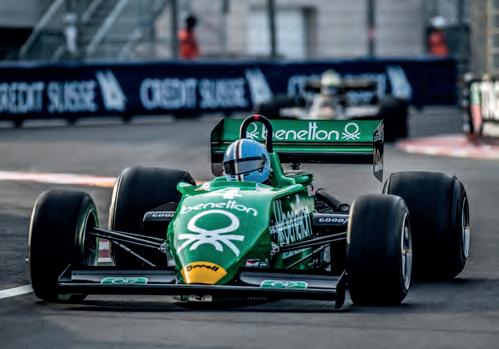
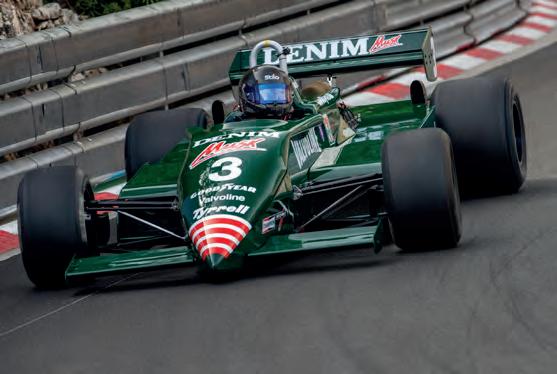
Jamie CONSTABLE
Cette 011 a été attribuée à Michele Alboreto en 1982 à partir du Grand Prix de Saint Marin qu’il a terminé sur le podium, et jusqu’au Grand Prix d’Allemagne. L’Italien a abandonné au Grand Prix de Monaco. En 1984, elle a été pilotée par l’Américain Danny Sullivan lors de neuf Grands Prix, avec pour meilleur résultat une 5e place au Grand Prix de Monaco.
This 011 was entrusted to Michele Alboreto in 1982, from the San Marino Grand Prix, where he finished on the podium, to the German Grand Prix. The Italian driver retired at Monaco Grand Prix. In 1984, this car was driven by American Danny Sullivan at nine Grand Prix races, with 5th place in Monaco as a best result.
1 35 14e GRAND PRIX DE MONACO HISTORIQUE 10-12 MAI 2024
3 4 33 1
TYRRELL 012
Apparue dans la deuxième moitié de la saison 1983, la 012 était une évolution logique de la 011 dotée d’un châssis mixte carbonealu-nid d’abeille et du dernier développement du V8 Cosworth désormais baptisé DFY. C’est précisément ce dernier élément, irrémédiablement dépassé par les moteurs turbo, qui la condamnait aux seconds rôles.
Production : 7 exemplaires entre 1983 et 1985, engagés par Team Tyrrell pour Michele Alboreto (n°3) et Danny Sullivan en 1983, Martin Brundle (n°3) et Stefan Bellof (n°4) en 1984 et 1985.
Introduced in the second half of the 1983 season, the 012 was a logical evolution of the 011, featuring a carbon-aluminum-honeycomb chassis and the latest development of the Cosworth V8, now christened DFY. It was precisely this last element, irrevocably outdated by the turbochargers, that condemned it to second-class status.
Production: 7 cars between 1983 and 1985, entered by Team Tyrrell for Michele Alboreto (n°3) and Danny Sullivan in 1983, Martin Brundle (n°3) and Stefan Bellof (n°4) in 1984 and 1985.

Ian SIMMONDS
Cette Tyrrell 012 a débuté par une 6e place de Michele Alboreto au Grand Prix de Hollande en 1983. Il l’a encore pilotée en Italie avant de la passer à son coéquipier Danny Sullivan qui a disputé avec elle les deux derniers Grands Prix de la saison (7e en Afrique du Sud). En 1984, elle a pris trois départs avec Stefan Bellof et elle était encore active en 1985, en F3000.
This Tyrrell 012 started its career with Michele Alboreto's 6th place finish at the 1983 Dutch Grand Prix. He drove it again in Italy before passing it to team-mate Danny Sullivan who raced it in the last two races of the season (7th in South Africa). In 1984, it took three starts with Stefan Bellof and was still active in 1985, in the F3000 Championship.
Martin STRETTON
Cette Tyrrell 012 a pris cinq départs en Grand Prix aux mains de Stefan Bellof, dont trois en 1984 et deux en 1985 avec pour meilleur résultat une 7e place au Grand Prix d’Autriche.
This Tyrrell 012 took five Grand Prix starts in the hands of Stefan Bellof: three in 1984 and two in 1985, with a 7th place at the Austrian Grand Prix as a best result.
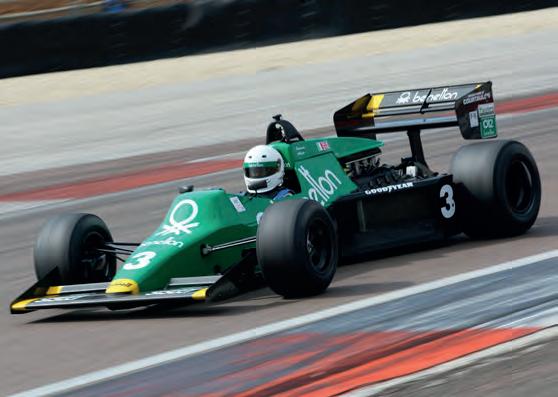

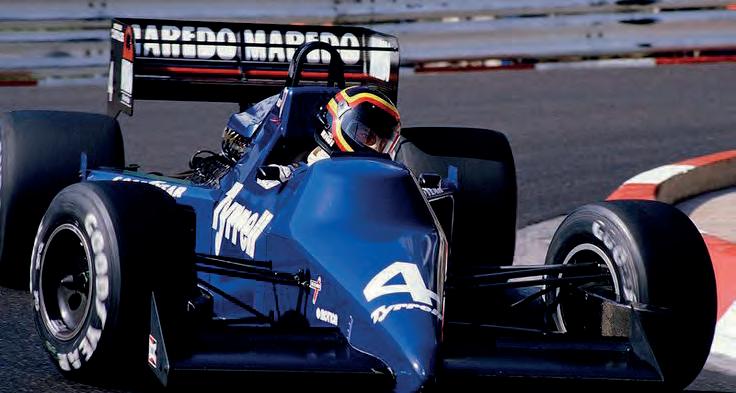
Marino FRANCHITTI
Dernière Tyrrell 012 produite, elle a été la voiture exclusive de Stefan Bellof lors de huit manches du Championnat du Monde (non-qualifiée à Monaco, 4e à Detroit).
The last Tyrrell 012 produced, it was Stefan Bellof's exclusive car for eight rounds of the World Championship (not qualified in Monaco, 4th in Detroit).
G 1 36
5 9
7
WILLIAMS FW07C
La FW07 marque l’arrivée au plus haut niveau de Frank Williams, présent en F1 depuis 1969. Ce modèle est en effet celui de la première victoire d’une Williams en Championnat du Monde (Grand Prix de Grande-Bretagne 1979, Clay Regazzoni), du premier sacre mondial d’un pilote Williams, Alan Jones en 1980 (version B), et de la première victoire d’une Williams à Monaco, en 1981 (version C).
Production : 16 exemplaires en 4 déclinaisons de 1978 à 1981 (4 FW07 en 1979, 6 FW07B en 1980, 6 FW7C en 1981 et 1982.).
The FW07 marked the arrival of Frank Williams at the highest level, after ten rather painful years in F1, since 1969. This model brought Sir Frank his first ever World Championship win (British Grand Prix 1979, thanks to Clay Regazzoni), a first world crown for Alan Jones in 1980 (version B) and a first Monaco win in 1981 (version C).
Production: 16 models in four different versions between 1978 and 1981 (4 FW07 in 1979, 6 FW07B in 1980-81, 6 FW07C in 1981).
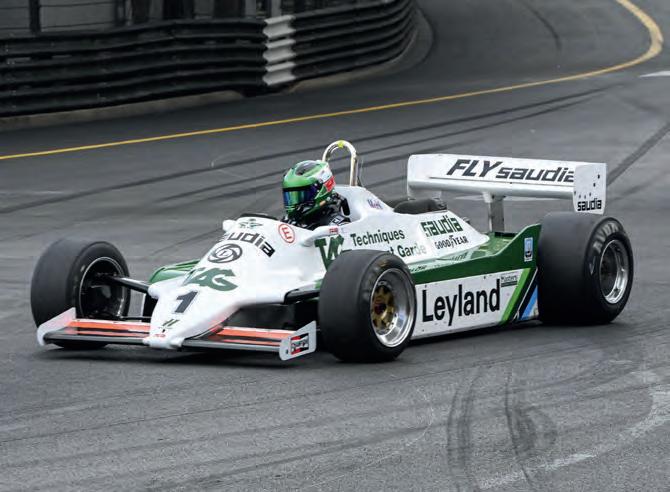
Yutaka TORIBA
Cette FW07C n’a pris que cinq départs en Championnat du Monde. Trois en 1981 aux mains d’Alan Jones et Carlos Reutemann, et deux en 1982, pilotée par Keke Rosberg. La 5e place du Finlandais en Afrique du Sud et sa 2e place à Long Beach lui ont permis de récolter des points précieux, parmi beaucoup d’autres, et il a été sacré Champion du Monde.
This FW07C took five World Championship starts. Three in 1981, in the hands of Alan Jones and Carlos Reutemann, two in 1982, driven by Keke Rosberg. His 5th place in South Africa and his 2nd place at Long Beach enabled the Finnish driver to take several precious points which contributed to his World Champion crown at the end of the year.
Christophe d'ANSEMBOURG
Premier exemplaire de la version C de la FW07, dotée d’une coque différente, cette voiture a été pilotée par Alan Jones, Champion du Monde en titre, lors de sept Grands Prix de la saison 1981, avec pour meilleurs résultats une victoire à Long Beach, une 2e place au Brésil et une 4e place en Argentine. Il terminera 3e du Championnat du Monde cette année-là.
This first car in C configuration produced by Williams, around a different hull, this FW07 was driven by Alan Jones, then world title holder, at seven Grand Prix races of the 1981 season. Its best results were a win in Long Beach, a 2nd place in Brazil and a 4th place in Argentina. All these points contributed to a 3rd place finish in the World Championship.
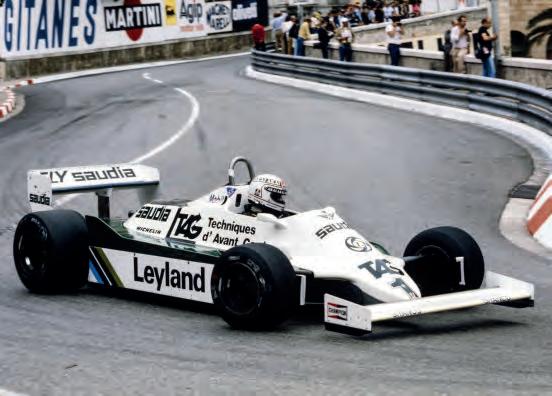

Michael CANTILLON
Dernière FW07C produite, cette monoplace a pris quatre départs en 1981, pilotée par Carlos Reutemann, avec pour meilleur résultat la 3e place de l’Argentin au Grand Prix d’Italie.
This was the last FW07C of a long series, it took four Grand Prix starts in 1981, driven by Carlos Reutemann, with a 3rd place at the Italian Grand Prix as its best result that year.
1 37 14e GRAND PRIX DE MONACO HISTORIQUE 10-12 MAI 2024
1 28
27 1
WILLIAMS FW08
La Williams FW08 a été construite en trois versions : celle des débuts qui donna le titre de Champion du Monde à Keke Rosberg en 1982, la six roues expérimentale FW08B de l’intersaison et la FW08C de 1983, à fond plat et pontons courts, qui a remporté le Grand Prix de Monaco 1983 avec Rosberg au volant.
Production : 11 voitures entre 1982 et 1985 (6 en 1982, 5 en 1983) dont deux n’ont été utilisés qu’en F3000 à partir de 1985. Elles ont été engagées pour Derek Daly (n°5) et Keke Rosberg (n°6) en 1982, puis Rosberg (n°1) et Jacques Lafitte (n°2) en 1983. Deux exemplaires n’ont été utilisés qu’en F3000, en 1985, par Thierry Tassin et Lamberto Leoni.
The Williams FW08 was built in three versions: the one of the beginnings, with which Keke Rosberg took a world crown in 1982, the experimental six-wheel FW08B during the off-season and the FW08C of 1983, with a flat bottom and short pontoons, which won the Monaco Grand Prix in 1983 with Rosberg at the wheel. Production: 11 cars between 1982 and 1985 (6 in 1982, 5 in 1983), entered for Derek Daly (n°5) and Keke Rosberg (n°6) in 1982, then Rosberg (n°1) and Jacques Lafitte (n°2) in 1983. Two cars were only raced in F3000, in 1985, by Thierry Tassin and Lamberto Leoni.

Mark HAZELL
Cette FW08 n’a jamais été utilisée dans des Grands Prix de F1. Elle a disputé ses premières courses en 1985, dans le Championnat de F3000, aux mains du Belge Thierry Tassin.
This FW08 never took part in a F1 Grand Prix. It made its first appearances in 1985, in the International F3000 Championship, with Belgian Thierry Tassin at the wheel.
Niklas HALUSA
Cette FW08 a disputé six Grands Prix de Championnat du Monde 1982 aux mains de Keke Rosberg. La 3e place en Hollande, la 5e à Las Vegas et surtout la victoire au Grand Prix de Suisse, sur le circuit de Dijon-Prenois, ont largement contribué à son sacre en fin d’année.
This FW08 took part in six World Championship races in the hands of Keke Rosberg. His 3rd place in Holland, his 5th place in Las Vegas and, above all, his win at the Swiss Grand Prix, in Dijon-Prenois, played a key role in conquering his one and only world crown.
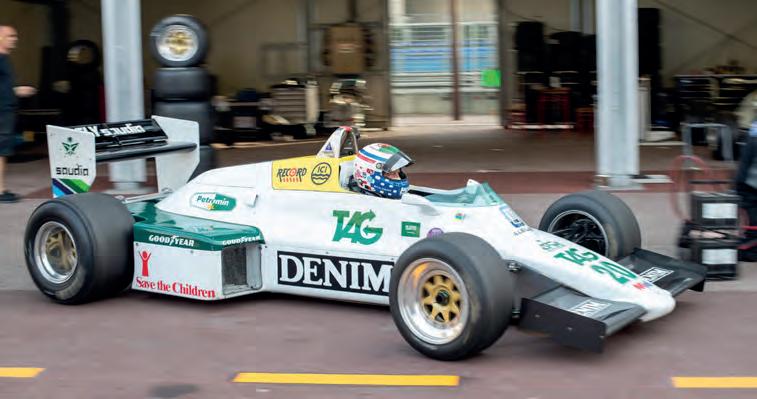
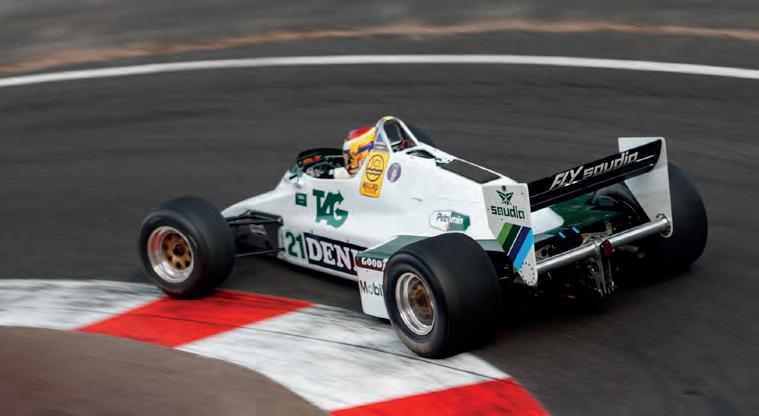
Frits VAN EERD
Dernière FW08 construite, elle n’a jamais participé à un Grand Prix de F1 et a fait toute sa carrière en 1985, dans le Championnat de F3000, aux mains de l’Italien Lamberto Leoni.
This was the last FW08 built. It was never entered for a F1 Grand Prix and its career started in 1985, in the International F3000 Championship, driven by Italian Lamberto Leoni.
G 1 38
6 35
34 1
Association Monégasque créée par des jeunes pour lutter contre l’Alcool au volant.
www.besafemonaco.mc
Suivez nous @besafemonaco


MONACO
UN DERNIER POUR LA ROUTE
PALMARÈS HONOURS
1er Grand Prix de Monaco Historique • 3-4 mai

2e Grand Prix de Monaco Historique • 27-28 mai
3e Grand Prix de Monaco Historique • 18-19 mai
140 VAINQUEUR VOITURE ANNÉE TEMPS KM/H MEILLEUR TOUR TEMPS KM/H VOITURES DE GRAND PRIX BIPLACES CONSTRUITES AVANT 1934 Charles DEAN (GB) Bugatti 51 1932 24’00.504 84.146 Charles Dean (6) 2’12.239 91.661 VOITURES DE GRAND PRIX CONSTRUITES AVANT 1952 Julian BRONSON (GB) Era Type B 1937 21’44.015 92.953 Irvine Laidlaw (1) 2’08.124 94.605 VOITURES DE SPORT CONSTRUITES AVANT 1959 David FRANKLIN (GB) Ferrari 750 Monza 1955 22’21.60490.349 Irvine Laidlaw (21) 2’09.026 93.943 VOITURES DE GRAND PRIX CONSTRUITES AVANT 1961 Martin STRETTON (GB) Connaught C 1956 21’22.114 94.451 Duncan Dayton (3) 2’00.511 100.581 VOITURES DE FORMULE JUNIOR À MOTEUR ARRIÈRE Denis WELCH (GB) Merlyn 1963 20’51.771 96.832 Denis Welch (29) 1’56.997 103.602 VOITURES DE GRAND PRIX CONSTRUITES AVANT 1966 Frank SYTNER (GB) Brabham BT4 1962 20’43.132 97.505 Frank Sytner (11) 1’56.103 104.400 VOITURES DE FORMULE 1 CONSTRUITES AVANT 1979 Martin STRETTON (GB) Tyrrell P34 1977 21’20.68694.686 Trevor Reeves (4) 1’44.182 116.346 VAINQUEUR VOITURE ANNÉE TEMPS KM/H MEILLEUR TOUR TEMPS KM/H VOITURES DE GRAND PRIX BIPLACES CONSTRUITES AVANT 1934 Julian MAJZUB (GB) Bugatti Type 35B 1927 22’17.332 90.637 Julian Majzub (1) 2’11.89991.897 VOITURES DE GRAND PRIX CONSTRUITES AVANT 1952 John URE (GB) Era Type B 1936 21’58.935 91.901 Williams Barrie (25) 2’08.250 94.512 VOITURES DE SPORT CONSTRUITES AVANT 1959 Claudia HUERTGEN (D) Maserati 300S 1955 21’48.102 92.662 Claudia Huertgen (35) 2’08.509 94.321 VOITURES DE GRAND PRIX CONSTRUITES AVANT 1961 Martin STRETTON (GB) Ferrari 555 1955 14’15.604 99.167 Nigel Corner (32) 1’59.722 101.244 VOITURES DE FORMULE JUNIOR 1958-1963 Denis WELCH (GB) Merlyn 1963 20’06.791 100.411 Denis Welch (33) 1’58.237 102.516 VOITURES DE GRAND PRIX CONSTRUITES AVANT 1966 Duncan DAYTON (USA)Brabham BT11 1964 19’32.705 103.361 Duncan Dayton (16) 1’55.478 104.965
VOITURE ANNÉE TEMPS KM/H MEILLEUR TOUR TEMPS KM/H VOITURES DE GRAND PRIX BIPLACES CONSTRUITES AVANT 1934 Jean-Louis DURET (F) Bugatti 35B 1926 24’23.995 82.795 Werner Klaus (31) 2’21.192 85.849 VOITURES DE GRAND PRIX CONSTRUITES AVANT 1952 Martin STRETTON (GB) Maserati 4CM 1932 21’11.119 95.358 Martin Stretton (17) 2’02.796 98.710 VOITURES DE SPORT DE LA MARQUE FERRARI Franck SYTNER (GB) Ferrari 250TR 1958 22’21.689 90.343 Peter Hannen (17) 2’07.180 98.307 VOITURES DE GRAND
Rod JOLLEY (GB) Cooper T51 1959 20’06.565 100.460 Richard Attwood (25) 1’57.948 102.767
DE SPORT
AVANT 1960 Lindsay OWEN-JONES (GB)Maserati Tipo 64 1959 20’45.312 97.335 L. Owen-Jones (30) 2’02.703 98.785 VOITURES DE GRAND PRIX CONSTRUITES AVANT 1968 Joaquim FOLCH-R (E) Lotus 49 1967 19’34.712 103.184 Joaquim Folch-R (26) 1’55.169 105.247 VOITURES DE FORMULE
Duncan DAYTON (USA) Cooper T67 1963 21’11.410 95.337 Tony Thompson (31) 2’01.693 99.605
VAINQUEUR
PRIX CONSTRUITES AVANT 1960
VOITURES
CONSTRUITES
JUNIOR
1997 2000 2002
4e Grand Prix de Monaco Historique • 15-16 mai
VOITURES DE GRAND PRIX CONSTRUITES AVANT 1947
John URE (GB) Era Type B
VOITURES DE GRAND PRIX À MOTEUR AVANT (1947-1960)
Duncan DAYTON (USA) Lotus 16
SPORT CONSTRUITES AVANT 1953
Flavien MARCAIS (F) Jaguar C
VOITURES DE FORMULE JUNIOR À MOTEUR AVANT
(USA) Stanguellini
VOITURES DE GRAND PRIX À MOTEUR ARRIÈRE (1954-1965)
Duncan

(USA)Brabham BT11
VOITURES DE GRAND PRIX DE FORMULE 1 (1966-1976)
(GB) Tyrrell P34
5e Grand Prix de Monaco Historique • 20-21 mai
VOITURE
VOITURES DE GRAND PRIX CONSTRUITES AVANT 1947 Stefan
DE GRAND PRIX À MOTEUR AVANT (1947-1960)
VOITURES DE SPORT ET SPORT PROTOTYPES CONSTRUITES AVANT 1953
VOITURES DE FORMULE JUNIOR À MOTEUR ARRIÈRE
VOITURES DE GRAND PRIX F1 À MOTEUR ARRIÈRE CONSTRUITES AVANT 1966
VOITURES DE GRAND PRIX F1, 3 LITRES CONSTRUITES AVANT 1975
VOITURES DE GRAND PRIX F1, 3 LITRES (1975-1978)
6e Grand Prix de Monaco Historique • 10-11 mai
141 14e GRAND PRIX DE MONACO HISTORIQUE 10-12 MAI 2024
KM/H MEILLEUR TOUR TEMPS KM/H
VAINQUEUR
ANNÉE TEMPS
SCHOLLWOECK
6CM 1937 21’17.651 94.110 S. Schollwoeck (24) 2’05.432 95.860
Duncan DAYTON (USA) Lotus 16 1959 20’07.936 99.541 Duncan Dayton (1) 1’58.984 101.055
(D) Maserati
VOITURES
1952 23’03.744 86.894 Albert Otten (22) 2’13.793 89.870
John URE (GB) Frazer Nash Le Mans Mk2
Denis WELCH (GB) Merlyn MK 5/7 1963 19’35.470 102.296 Denis Welch (3) 1’54.730 104.802
Nick WIGLEY (GB) Cooper T51 1959 21’14.798 94.320 James King (2) 1’54.827 104.714
Duncan DAYTON (USA)Brabham BT33 1970 29’23.076 102.298 Duncan Dayton (8) 1’37.128 123.795
Martin STRETTON (GB) Tyrrell P34 1977 30’22.440 98.966 Paul Edwards (28) 1’36.006 125.242 VAINQUEUR VOITURE ANNÉE TEMPS KM/H MEILLEUR TOUR TEMPS KM/H
Julian BRONSON (GB) Era Type D 1935 23’06.785 96.79 Julian Bronson (14) 2’04.225 96.79
Duncan DAYTON (USA) Lotus 16 1959 19’46.060 103.07 Duncan Dayton (22) 1’56.658 103.07 VOITURES
VOITURES DE GRAND PRIX CONSTRUITES AVANT 1947
VOITURES DE GRAND PRIX CONSTRUITES AVANT 1961
DE GRAND PRIX CONSTRUITES AVANT 1953
Nash Le Mans Mk2 1952 22’18.033 92.57 John Ure (28) 2’09.88592.57
1960 21’50.150 96.60 John Monson (24) 2’04.466 96.60 VOITURES DE GRAND PRIX F1 À MOTEUR ARRIÈRE CONSTRUITES AVANT 1966 Simon HADFIELD (GB)Lotus 21 1961 19’19.463104.98 James Hanson (15) 1’54.193 105.29 VOITURES DE GRAND
1975 Duncan DAYTON (USA)Brabham BT33 1970 26’23.840 125.54 Joaquin Folch-R (3) 1’35.658 125.69 VOITURES DE GRAND
Paul EDWARDS (USA) Penske PC3 1975 24’31.285 127.88 Paul Edwards (28) 1’34.019 127.88 VAINQUEUR VOITURE ANNÉE TEMPS KM/H MEILLEUR TOUR TEMPS KM/H
John URE (GB) Frazer
VOITURES DE FORMULE JUNIOR John MONSON (GB) BMC Mk1
PRIX F1, 3 LITRES CONSTRUITES AVANT
PRIX F1, 3 LITRES (1975-1978)
1936 20’57.916 95.586 Irvine Laidlaw (2) 2’03.140 97.644
1959 19’56.618 100.483 Duncan Dayton (9) 1’55.880 103.762 VOITURES
DE
1952 22’09.830 90.417 Flavien Marcais (7) 2’07.599 94.232
Type
1959 21’28.739 93.300 Robin Longdon (1) 2’02.808 97.908
Joseph COLASACCO
DAYTON
1964 19’41.982 101.727 Duncan Dayton (16) 1’55.806 103.828
Martin STRETTON
1976 25’37.376 117.316 Danny Baker (16) 1’40.137 120.075
2004 2006 2008
2012 2014

PALMARÈS HONOURS
7e Grand Prix de Monaco Historique • 1-2 mai
VAINQUEUR
VOITURES DE GRAND PRIX CONSTRUITES AVANT 1947
Julian BRONSON (GB) Era Type D
DE GRAND PRIX À MOTEUR AVANT (1947-1960)
Duncan DAYTON (USA) Lotus 16 1959
VOITURES DE SPORT CONSTRUITES AVANT 1953 Carlos MONTEVERDE (GB) Jaguar C Type
VOITURES DE FORMULE 3, 1000 CM 3 (1964-1970)
DE GRAND PRIX F1 À MOTEUR ARRIÈRE (1954-1965)
GRAND PRIX F1 (1966-1974)
PRIX F1 (1975-1978)
FORMULE 3, 1600 CM 3 (1971-1973) / 2000 CM 3 (1974-1984)
8e Grand Prix de Monaco Historique • 11-12 mai
SÉRIE A - VOITURES DE GRAND PRIX CONSTRUITES AVANT 1952
Julian
SÉRIE B - VOITURES DE GRAND PRIX ET F2 AVANT 1961
SÉRIE C - VOITURES DE SPORT ET SPORT PROTOTYPES AVANT 1953 Alex
SÉRIE D - VOITURES DE GRAND PRIX À MOTEUR ARRIÈRE (1961-1965)
SÉRIE E - VOITURES DE GRAND PRIX F1, 3 LITRES (1966-1972)
SÉRIE F - VOITURES DE GRAND PRIX F1, 3 LITRES (1973-1978)
SÉRIE G - VOITURES DE GRAND PRIX F3, 2 LITRES AVANT 1985
9e Grand Prix de Monaco Historique • 10-11 mai
SÉRIE B - VOITURES DE GRAND PRIX ET F2 AVANT 1961
WILLS (GB) Cooper T51 Climax
SÉRIE C - VOITURES
SPORT AYANT COURU DE 1952 À 1955 Alex BUNCOMBE (GB)Jaguar C Type
SÉRIE D - VOITURES DE GRAND PRIX F1, 1500 CM 3 (1961-1965) Andy MIDDLEHURST (GB) Lotus 25 Climax
SÉRIE E - VOITURES DE GRAND PRIX F1 (1966-1972)
Katsuaki KUBOTA (JPN) Lotus 72 1971
SÉRIE F - VOITURES DE GRAND PRIX F1, SANS EFFET DE SOL (1973-1978)
SÉRIE G - VOITURES DE GRAND PRIX F3, 2 LITRES (1974-1978)
142
VAINQUEUR VOITURE ANNÉE TEMPS KM/H MEILLEUR TOUR TEMPS KM/H
1938 20’17.794 98,73 Julian Bronson (36) 2’00.002 100,19
BRONSON (GB) Era D
Roger WILLS (GB) Cooper T51 Climax 1959 19’14.304 104,16 Duncan Dayton (42) 1’53.113106,30
BUNCOMBE
C Type 1952 20’59.385 95,47 Alex Buncombe (66) 2’03.291 97,52
(GB) Jaguar
Andy MIDDLEHURST
Lotus 25 Climax 1962 23’42.253 101,45 Andy Middlehurst (9) 1’55.616 103,99
(GB)
Dayton DUNCAN (USA) Brabham BT33 1970 32’06.566 112,34 Andrew Smith (21) 1’37.450 123,38
Michael LYONS (GB) Hesketh 308E 1977 28’33.034 98,26 Michael Lyons (31) 1’59.140 100,92
Ben BARKER
1978 12’01.922 après 7 tours Ben Barker (10) 1’41.784 118,13 VAINQUEUR VOITURE ANNÉE TEMPS KM/H MEILLEUR TOUR TEMPS KM/H SÉRIE A - VOITURES DE GRAND PRIX ET VOITURETTES D’AVANT-GUERRE Matthew GRIST
Alfa-Romeo
B 1934 20’15.898 98,88 Matthew Grist (16) 1’59.058 100,99
(GB) Lola T670
(GB)
Tipo
Roger
15’44.878 101,80 Robert Hall (6) 1’55.216104,36
1959
20’23.912 98,24 Alex Buncombe (70) 1’59.920 100,26
DE
1952
23’12.977 103,58 Andy Middlehurst (11) 1’53.641105,80
1962
122,29 Katsuaki Kubota (6) 1’35.980 125,27
26’13.176
Michael
308E 1977 31’25.990 114,75 Michael Lyons (25) 1’33.904 128,04
Paolo BARILLA (ITA) Chevron B34 1976 32’35.182 110,69 Paolo Barilla (6) 1’40.900 119,16
LYONS (GB) Hesketh
VOITURE ANNÉE TEMPS KM/H MEILLEUR TOUR TEMPS KM/H
1935 21’09.375 94.72 Julian Bronson (50) 2’04.148 96.85
VOITURES
19’46.944 101.30 Duncan Dayton (42) 1’56.573103.14
21’46.894 92.00 Carlos Monteverde (52) 2’07.653 94.19
Christian TRABER (CH) Brabham
1967 18’09.823 99.29 François Derossi (22) 1’57.181 102.61
James KING (USA) Brabham BT7 1963 21’02.718 95.22 James King (4) 1’54.588 104.93 VOITURES
Duncan DAYTON
1970 26’28.898 113.51 Duncan Dayton (8) 1’34.966 126.61
DE GRAND
Bobby VERDON-ROE (GB) McLaren M26 1977 22’15.689 126.02 Bobby Verdon-Roe (8) 1’32.989 129.30 VOITURES DE
Emanuele PIRRO (ITA) Martini Mk34 1981 19’26.448 103.08 Emanuele PIRRO (1) 1’42.376 117.44 2010
1952
BT21
VOITURES
DE
(USA)Brabham BT33
VOITURES

10e Grand Prix de Monaco Historique • 13-15 mai
SÉRIE A - VOITURES DE COURSE D’AVANT-GUERRE
Parade non chronometrée
SÉRIE B - VOITURES DE GRAND PRIX ET F2 AVANT 1961
Tony WOOD (GB) Tec-Mec F415
SÉRIE C - VOITURES DE SPORT AYANT COURU DE 1952 À 1955
Chris WARD (GB) Jaguar C Type
SÉRIE D - VOITURES FORMULE JUNIOR, MOTEUR AVANT (1958-1960)
Jonathon HUGHES (GB) Lola Mk2
SÉRIE E - VOITURES DE GRAND PRIX F1, 1500 CM 3 (1961-1965) Andy MIDDLEHURST (GB)
SÉRIE F - VOITURES DE GRAND PRIX F1 (1966-1972)
Stuart HALL (GB) McLaren M19A
SÉRIE G - VOITURES DE GRAND PRIX F1 (1973-1976)
CAFFI (MCO) Ensign N176
11e Grand Prix de Monaco Historique • 8-10 mai
SÉRIE A - VOITURES DE GRAND PRIX D’AVANT-GUERRE
SÉRIE B - VOITURES DE GRAND PRIX ET F2 AVANT 1961
SÉRIE C - VOITURES DE SPORT AYANT COURU DE 1952 À 1957
Chris WARD (GB) Coope-Jaguar T33 Mk1
SÉRIE D - VOITURES DE GRAND PRIX F1, 1500 CM 3 (1961-1965)
MIDDLEHURST
SÉRIE E - VOITURES DE GRAND PRIX F1 (1966-1972)
WIRDHEIM (SWE)March 711
SÉRIE F - VOITURES DE GRAND PRIX F1 (1973-1976)
SÉRIE G - VOITURES DE GRAND PRIX F1 (1977-1980)
O’CONNELL (GB) ATS D4
12e Grand Prix de Monaco Historique • 23-25 Avril
SÉRIE A - VOITURES DE GRAND PRIX D’AVANT-GUERRE
SÉRIE B - VOITURES DE GRAND PRIX ET F2 AVANT 1961 Guillermo FIERRO-ELETA
SÉRIE C - VOITURES DE SPORT AYANT COURU DE 1952 À 1957
Guillermo FIERRO-ELETA
SÉRIE D - VOITURES DE GRAND PRIX F1, 1500 CM 3 (1961-1965)
Mark SHAW (GB) Lotus 21 Climax 1961
SÉRIE E - VOITURES DE GRAND PRIX F1 (1966-1972) Michael LYONS (GB) Surtees TS9 1971 19:11.747
SÉRIE F - VOITURES DE GRAND PRIX F1 (1973-1976)
Michael
SÉRIE G - VOITURES DE GRAND PRIX F1 (1977-1980)
Michael LYONS (GB) Hesketh 308E
143 14e GRAND PRIX DE MONACO HISTORIQUE 10-12 MAI 2024 VAINQUEUR VOITURE ANNÉE TEMPS KM/H MEILLEUR TOUR TEMPS KM/H
1959 20’34.124 97,34 Tony Wood (36) 1’55.205104,27
1952 21’37.748 92,56 Chris Ward (64) 2’02.097 98,39
1960 21’43.471 92,16 Jonathon Hughes (23) 1’57.197 102,50
Lotus 25 Climax 1962 22’24.838 107,19 Andy Middlehurst (9) 1’49.994 109,21
1971 28’44.528 125,38 Stuart Hall (15) 1’34.107 127,65
Alessandro
1976 28’52.334 117,88 Alessandro Caffi (22) 1’34.282 127,41 VAINQUEUR VOITURE ANNÉE TEMPS KM/H MEILLEUR TOUR TEMPS KM/H
Padding DOWLING Era R5B 1936 20:51.995 95,95 Paddins Dowling 2:01.641 98,75
Tony WOOD (GB) Tec-Mec
1959 17:39.995 101,99 Nick Padmore 1:53.633 105,71
F415
1954 23:32.080 85,07 Chris Ward 2:18.797 86,55
Andy
Lotus 25 Climax 1962 18:20.139 109,19 Joseph Colasacco 1:48.873 110,34
(GB)
Bjorn
1971 20:09.785 119,16 Stuart Hall 1:34.295 127,40
Michael
1976 34:38.567 104,03 Alessandro Caffi 1:50.266 108,94
LYONS (GB) McLaren M26
Martin
1980 32:03.138 112,43 Jordan Grogor 1:42.041 117,72 VAINQUEUR VOITURE ANNÉE TEMPS KM/H MEILLEUR TOUR TEMPS KM/H
Christian
1939 22:38.823 97,24 P. Blakeney-Edwards 2:11.679 91,23
TRABER (CH) Talbot-Lago
(ESP)
250F 1954 20:42.041 106,39 G. Fierro-Eleta 1:57.109 102,58
Maserati
(ESP)
300S 1957 20:48.586 105,83 G. Fierro-Eleta 2:02.190 98,31
Maserati
19:23.946 113,53 Mark Shaw 1:54.902 104,55
Stuart
127,16
135,59
Hall 1:34.468
1976 26:48.342 134,44 Jean Alesi 1:32.122 130,40
LYONS (GB) McLaren M26
1977 28:29.081 133,55 Mike Cantillon 1:31.806 130,85
2016 2018 2021

PALMARÈS HONOURS
13e Grand Prix de Monaco Historique • 13-15 mai 2022
SÉRIE A1 - VOITURES DE GRAND PRIX D’AVANT-GUERRE ET VOITURETTES
Mark GILLIES (USA) Era R3A 1934
SÉRIE A2 - VOITURES DE GRAND PRIX À MOTEUR AVANT, CONSTRUITES AVANT 1961
Claudia HURTGEN (GER) Ferrari 246 Dino 196013:33.196
SÉRIE B - VOITURES DE GRAND PRIX À MOTEUR ARRIÈRE, 1500 CM 3 (1961-1965) ET F2 (1956-1960)
Joseph COLASACCO (USA) Ferrai 1512 1964
SÉRIE C - VOITURES DE SPORT AYANT COURU DE 1952 À 1957
Frédéric WAKEMAN Cooper-Jaguar T38 (Mk2) 1955
SÉRIE D - VOITURES DE GRAND PRIX F1, 1500 CM 3 (1961-1972)
Stuart HALL (GB) McLaren M19A 197119:38.832
SÉRIE E - VOITURES DE GRAND PRIX F1 (1973-1976)
Stuart HALL (GB) McLaren M23 1973
SÉRIE F - VOITURES DE GRAND PRIX F1 (1977-1980)
Michael LYONS (GB) Hesketh 308E 1977
SÉRIE G - VOITURES DE GRAND PRIX F1 (1981-1985)
(GER)
VAINQUEUR VOITURE ANNÉE TEMPS KM/H MEILLEUR TOUR TEMPS KM/H
20:34.478 97,31 M. Gillies 2:00.103 100,02
103,40 C. Hurtgen 1:53.966 105,41
18:41.899 107,07 M. Shaw 1:48.908 110,30
20:38.719 96,98 F. Wakeman 2:00.286 99,87
122,28 S. Hall 1:32.345 130,09
26:14.912 129,67 S. Hall 1:30.946 132,09
116,96 M. Lyons
130,13
30:49.063
1:32.311
1982 29:46.832 121,01 M. Hazell 1:33.081 129,06
Marco WERNER
Lotus 87B
www.acm.mc 144
Vivez les essais et les courses en direct ! Résultats, commentaires, actualités... et retrouvez l’histoire de l’ACM et des Grands Prix automobiles The practices and the races live! Results, comments, news... and the history of ACM and the Grands Prix automobiles
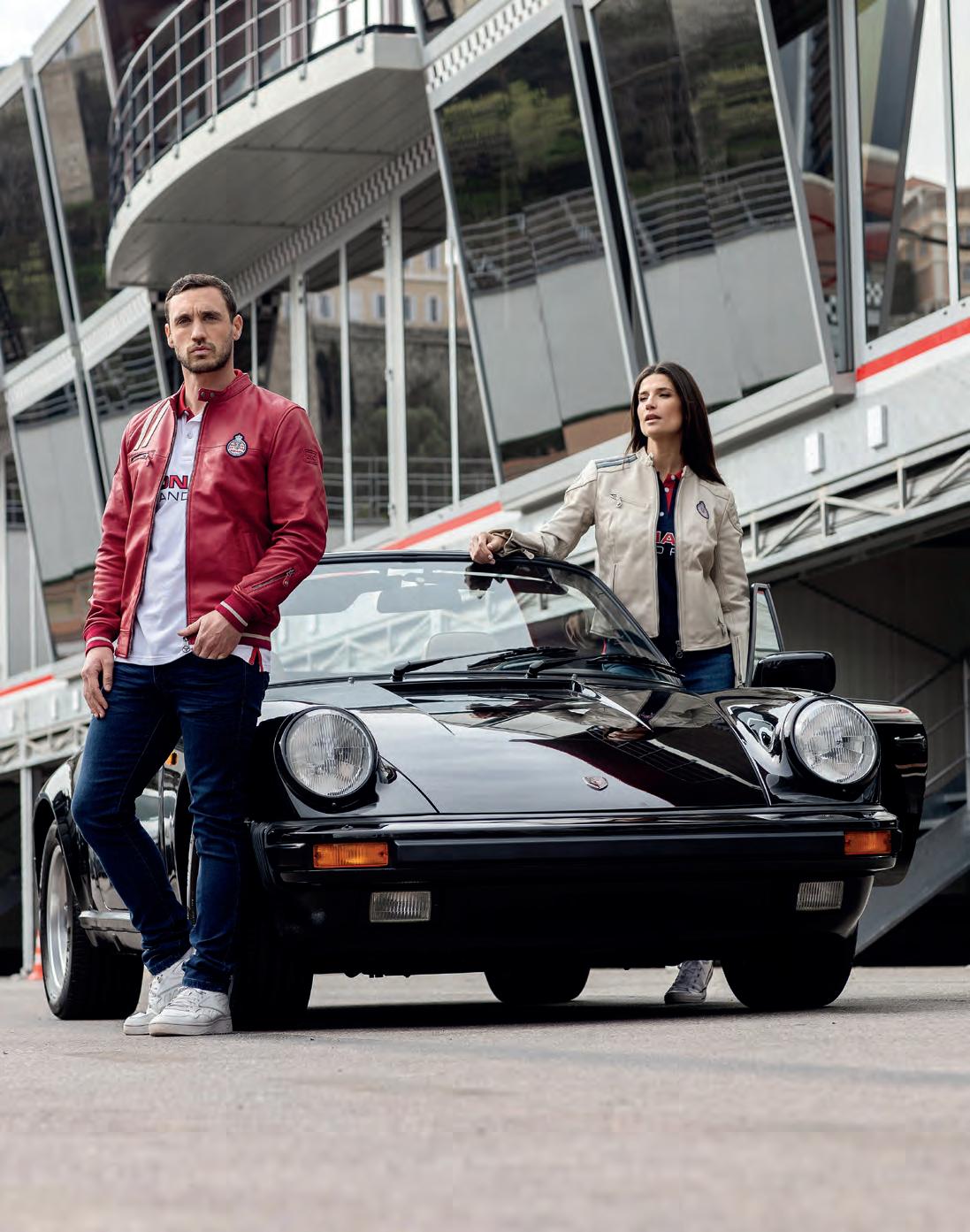




AUTOMOBILE CLUB DE MONACO 46 rue Grimaldi - 98000 MONACO T. +377 97 70 45 35 laboutique@acm.mc boutiqueacm.com @automobileclubmonaco www.acm.mc

PLACE DU PALAIS RAMPE MAJOR PLACE D'ARMES R U E D E LA TURBIE R UE GRIMALDI RUE L O U I S A U REG LIA B R E T E L L E A U R E G L I A R U E G R I M A L D I B O U L E V A R D R A I N I E R III RUEPsse ANTOINETTE RUESUFFREN REYMOND RUEDESPRINCESRUEIMBERTY RUE PRINCESSE FLORESTINE RUE PRINCESSE CAROLINE RBARONSteSUZANNE RUE LOUIS NOTARI RUE DE MILLO RUELANGLE B O ULEVARD DE SUISSE AVENUE AV E N U E D E LA COSTA QUAI ANTOINE 1ER AVENUE DE LA QUARANTAINE AVENUE DE LA PORTE NEUVE AV E N U E D U P O R T AV E N U E S t M A R T I N RUE DES R E M P A R T S PRESS Vers FONTVIEILLE Vers NICE 1 18 19 15 12 16 17 13 T1 T 3 T2 P O N V K6 à K1 A L Z CLASS I C CLUB BELVÉDÈRE P P P P Bienvenue à Welcome to MONACO Absence de consigne au Grand Prix de Monaco. Nous vous conseillons de prendre vos propres dispositions. No luggage keeping at the Grand Prix de Monaco. We advise you to make your own arrangements.
TRIBUNES / GRANDSTANDS
A Avenue J-F. Kennedy
B Casino
K Quai Albert Ier
L Piscine Rainier III
N Piscine Panne Nord
O Piscine Plongeur
P Piscine Panne Sud
T Cale de Halage
V Virage Antony Noghès
Accès handicapés
TRANSPORT
Gare SNCF
Tél. +377 93 10 60 05
Héliport
Tél. +377 92 05 00 50
SERVICES
WC public
Buvette / Snack
Poste de Police
Objets trouvés / Lost & found
Poste de Secours / First Aid
Ecran géant / Giant Screen
Parking public
Informations Tourisme
Passerelle / Footbridge
Points de vente / Sale Tickets
Merchandising
Boutique Officielle ACM
Tél. +377 97 70 45 35 boutiqueacm.com
Ticketing
Billetterie officielle
Tél. +377 93 15 26 24 monaco-grandprix.com
HOSPITALITÉ / HOSPITALITY
Classic Club
BELVEDERE Belvédère (Tribune L)
Entrée des stands / Pit entrance
ZONES / AREAS
Stands / Pits
Ligne de Départ / Start
Centre Media
Paddock
Direction de course
Virages / Turns
1 : Saint-Dévote, 2 : Beau Rivage, 3 : Massenet, 4 : Casino, 5 : Mirabeau Haut, 6 : Fairmont, 7 : Mirabeau Bas, 8 : Portier, 9 : Tunnel, 10-11 : Chicane, 12 : Tabac, 13-14 : Louis Chiron, 15-16 : Piscine, 17-18 : Rascasse, 19 : Antony Noghès
E SUISSE BOULEVARD D E S UISSE AVENUE D E L A C O S T A COSTA AVEN UE DE L' HERMITAGE AVENUE HENRY DUNANT AVEN U E P R I N C E SSE A L I C E B O U L E VA R D P R I N C E S S E CHAR L O T T E B O U L EVARD DES MOU L I N S A V E N U E D E L A M ADON E I MPASSE DE LAFONTAINE A VEN UE DE G R A N DE BRETAGNE AVENUEDESCITRONNIERS RUE DU BOULEVARD PLACE DU CASINO ANSE DU PORTIER ROND POINT DU PORTIER Vers MENTON 3 6 11 9 8 7 5 4 2 B P P P P P P
Novotel
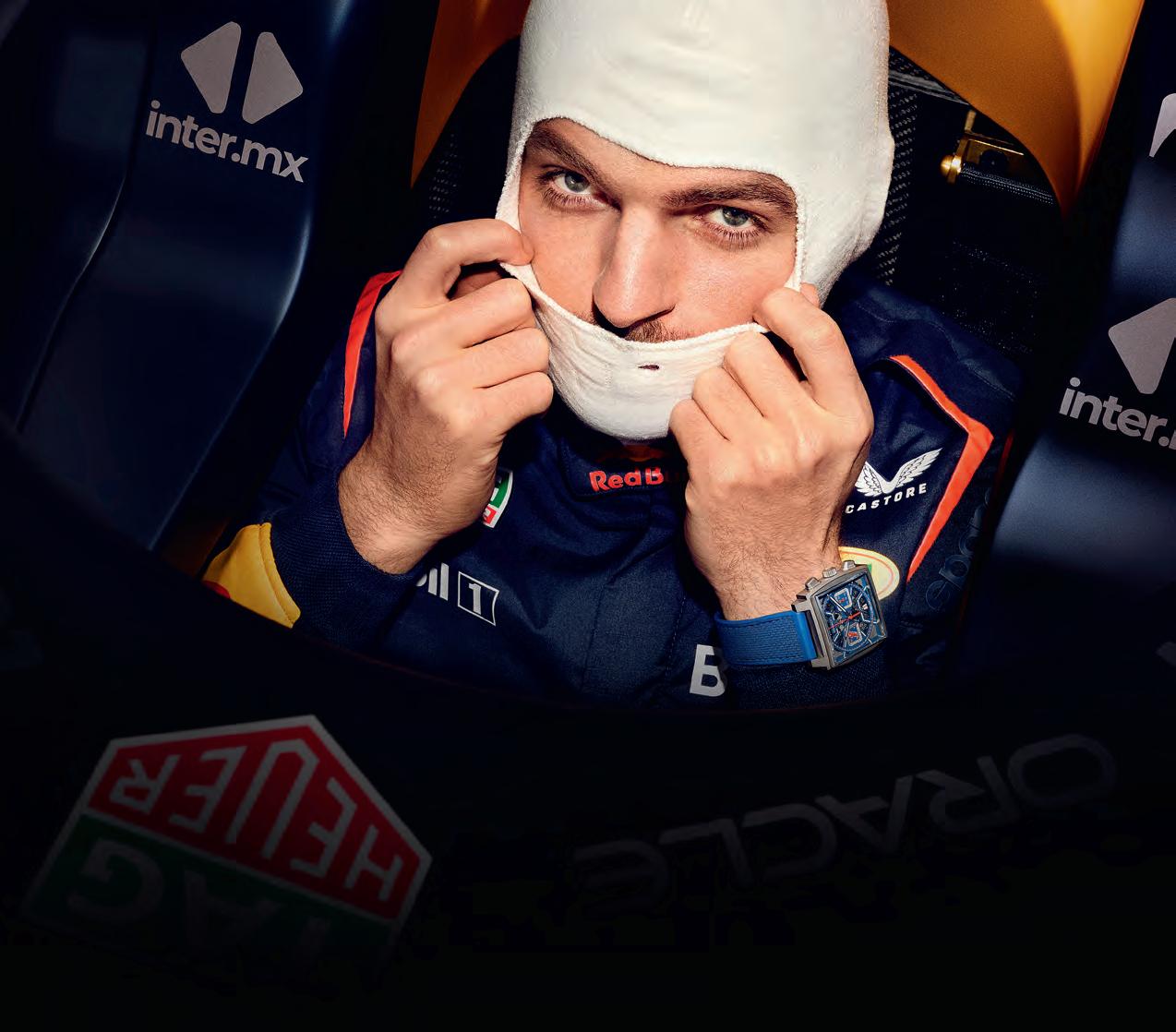























 LL.AA.SS. le Prince Albert II, la Princesse Charlène, le Prince Héréditaire Jacques et la Princesse Gabriella
© Eric Mathon
/ Palais
Princier
LL.AA.SS. le Prince Albert II, la Princesse Charlène, le Prince Héréditaire Jacques et la Princesse Gabriella
© Eric Mathon
/ Palais
Princier















































































 Stefano ROSINA
Stefano ROSINA


 Brad BAKER
Brad BAKER












 Paul GRANT
Paul GRANT




















 Tony WOOD
Tony WOOD


































































































 Michael LYONS
Michael LYONS















































 Steven BROOKS
Steven BROOKS



















































